THE OLDER STUFF
-- March 27, 2023 --
Tales From Two Koreas
I've always had
an interest in Korea, both North and South. When film buffs were telling me
to check out Japanese films, I was always pointing out that South Korean ones
were better. I've posted a number of interesting Korean stories here, such as
the infamous "axe murder" incident of 1976 that almost sparked a war,
and the North Korean film Dear Leader kidnapped a couple for, Pulgasari,
so here's another two entries that are just as bizarre.
It's said that in North Korea, citizens are ruled with an iron fist, so they
know not to step out of line. You'd think that those who are held in high esteem
by the ruling class would be able to get away with more, but not so.
Woo In-hee
was a North Korean actress, who reached stardom in the late 1960s, and was renowned
for her beauty, once called "the most beautiful woman in North Korea".
Woo earned dozens
of awards, as well as being given the title of "ko", or People's Actress,
which allowed extraordinary freedoms, such as permission to travel to Czechoslovakia
to study acting. In the late 70s, she began a secret affair with the country's
leader, Kim Jong-il. Upon the death of another lover, she was interrogated,
and let it slip of her affair with Kim. The dictator had her arrested, and immediately
taken to the Kang Kon Military Academy shooting grounds, where she was tied
to a post, and shot in front of 6,000 people - including her husband. Woo's
name, and image were purged from magazines, and was even edited out of films
she had performed in, rendering the movie plots impossible to understand.
Just like that tragedy,
you hear a lot of wild ones about what goes on in North Korea, but things can
get just as crazy down South. In January of 1968, North Korea launched a daring
raid in an attempt to assassinate the President of South Korea, Park Chung-hee,
at his compound in Seoul. It failed, and it's known as the Blue House raid.
In response, South Korea attempted to counter with a top-secret assassination
squad of 31 men, called Unit 684 stationed on Silmido Island, tasked with attacking
the residence of North Korea's then-leader Kim Il-sung. It turned out to be
a disaster, and it never even left South Korea.
According to the
Defense Ministry, from 1968 to 1971, two men were executed for desertion, another
was executed for threatening an officer, and three more were executed after
they escaped the island, and raped a local woman. In 1971, things got much worse
when the trainees turned on their commanders, killing 18 of them. Then the squad
made their way to the mainland, and hijacked a bus to Seoul. There, they clashed
with police, where dozens of security forces, and civilians were killed, or
wounded. It took the military to end it by bombing the bus, killing 20 of the
mutineers, leaving only four alive, but badly hurt. It didn't matter, as those
four were later executed for treason.
I know that the Koreas are really no different than any other country. They
all have their trials, tales, and tribulations. With that, there'll probably
never be an end to the number of interesting anecdotes, hilarious history, and
odd drama I can post about. Here's to humanity's never-ending deviancy, I guess.
-- March 13, 2023 --
This Post Has Gone Nuclear
I understand that
-in many ways- when it comes to emissions, nuclear power is a better option
than fossil fuels. Still, there have been a number of issues having to do with
the cleanup, and disposal of radioactive material since the splitting of the
atom. From long-lasting damage due to nuclear weapons testing, to nuclear reactor
meltdowns, there are areas of our planet that are a testament to our hubris
when it comes to atomic power. Of course, everyone is familiar with the infamous
Chernobyl Incident, when in 1986 the meltdown of the Chernobyl Nuclear Power
Plant's reactor core destroyed the plant, and caused a massive evacuation that
the city has yet to fully recover from. There are a few others that are less
known, one of which is right in many of our own backyards.
Red Gate Woods in Willow Springs is the burial site for the world's first nuclear
reactor, Chicago Pile-1, which ceased operation on the 28th of February, 1943.
The area also became
the site of Argonne National Laboratory in 1946, with Chicago Pile-2, and Chicago
Pile-3 (which once went critical on May 15, 1944) operating there for ten years
before they outlived their usefulness, and shut down in May of 1954. After the
nuclear waste (including the graphite fuel bars, and heavy water) were shipped
to Tennessee for disposal. The rest was encased in concrete, and buried in a
40 ft (12 m) deep trench in what is now known as the Site A/Plot M Disposal
Site, marked by a commemorative monument seen here. Surveys conducted in the
1980s found strontium-90 in the soil, plus trace amounts of tritium, plutonium,
technetium, caesium, and uranium in the area. In 1994, the United States Department
of Energy earmarked $29 million to rehabilitate the site. As part of the cleanup,
500 cubic yards (380 m³) of radioactive waste was removed, and sent for
"proper" disposal. By 2002, the Illinois Department of Public Health
had determined that the remaining materials posed no danger to public health,
but that has yet to be proven right.
When one thinks of Pacific islands, they tend to imagine tropical beaches, and
lush jungles, but there's more there than you can imagine, such as the Runit
Dome (aka the Cactus Dome).
It's a 337 ft (115
m) diameter concrete sarcophagus, containing 95,000 cubic yards (73,000 m²)
of radioactive debris - including plutonium-239, from nuclear tests conducted
by the United States between 1946 and 1958. The dome is 18" (46 cm) thick,
and holds loose waste, and topsoil debris scraped off from six different islands
of the Enewetak Atoll tests. From 1977 to 1980, 4,000 U.S. servicemen were involved
in this cleanup. Sadly, many involved have died of cancer, while others have
become sick. The U.S. government denies there is any connection between the
clean up work, and the health problems, while refusing to offer compensation
for illnesses associated with the construction of Runit Dome. In 2013, a report
by the U.S. Department of Energy found that the concrete dome had weathered,
and there was minor cracking in the structure, with the soil around the dome
actually being found to be more contaminated than its contents.
As if climate change wasn't bad enough, here are two more reasons to look into,
and fund the changeover to renewable energy sources. Though it may look like
it (especially by my wardrobe), I'm not all gloom-and-doom, and am certain humanity
will do the right thing. I just hope it's in time.
-- February 28, 2023 --
Does Size Matter?
Sometimes, bigger
is better. Other times, it really is best to be small, and -though rarely- it's
even better to be the smallest.
This is a microscopic polymer statue by South African sculptor, Jonty Hurwitz,
titled "Trust". It measures 1/100th of a centimeter, and is considered
the "smallest sculpture ever made".
Engineers at Northwestern University have created micro-robots on an almost unbelievably small scale. The half-millimeter crab-like machines are now the world’s smallest remote-control robots. Smaller than a flea, they are able to walk along the edge of a penny (as in the image below). Bioelectronics engineer John A. Rogers was quoted in the journal Science Robotics, "You might imagine micro-robots as agents to repair, or assemble small structures, or machines in industry, or as surgical assistants to clear clogged arteries, to stop internal bleeding, or to eliminate cancerous tumors - all in minimally invasive procedures."
Travis Casagrande, an electron microscopy researcher in Canada, created the world's smallest winter home. The structure was carved out of silicon, using a beam microscope with charged gallium ions. The result was 10x smaller than the width of a human hair.
Since I mentioned ionic beams, this award-winning photo was taken in 2019, by Nick Moser and Chris Bakal, who shot an ion beam into a metastatic melanoma (cancer) cell in a patient's brain. Known as ion-beam milling, the process cuts through the silica substrate, and since melanoma attaches itself using structures called focal adhesions, this lets scientists, and doctors see how they form.
Simone Biles once said, "For me, I don't think about size. I focus more on being powerful and confident," and many of these artists, and scientists thought the same. Size only matters in the context of the goal striven for, so don't be a such a Size Queen.
-- February 14, 2023 --
How Statuesque
There are some
odd monuments around the globe, and -since one of my favorites is no more (the
Georgia Guidestones)- I thought I'd cover some of the other ones I find delightfully
weird, before they're destroyed as well.
In 1988, citizens of Rio de Janeiro were so fed up with their local politicians,
that when newspapers Casseta Popular and Planeta Diário
ran a zoo chimpanzee for mayor, it received 400,000 votes. The ape, known as
Macaco Tião (meaning "Tião the Monkey"), was infamous
for his constant bad mood, and the habit of throwing mud and feces at zoo visitors.
Tião (which is the nickname for Sebastião, Rio de Janeiro's patron
saint, Saint Sebastian) died of diabetes at the age of 33, in 1996. When he
died the city of Rio de Janeiro declared an official mourning of three days.
The main avenue to the zoo not only carries his name, but a statue marks the
start of the pathway.
In Spain's capital of Madrid, located in the gardens of Parque del Buen Retiro, is a statue that is 666 meters above sea level. Why there, because it is a dedication to Lucifer. Titled "Ángel Caído" ("The Fallen Angel"), it was created by sculptor Ricardo Bellver, and cast in bronze for the third World's Fair in Paris. Once the event ended, the piece was acquired by Madrid's Museo del Prado, and later donated to the city itself, where it -in 1885- inaugurated the work to its current location.
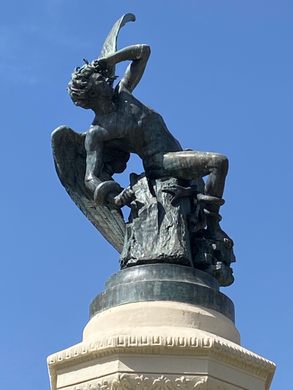
Kyoto, Japan's Mimizuka (meaning "Ear Mound") is an alteration of a 16th Century monument called a Hanazuka (meaning "Nose Mound", which were found throughout Japan), originally dedicated to the sliced-off noses of murdered Korean soldiers and civilians, as well as Ming Chinese troops, taken as war trophies during the Japanese invasions of Korea (1592 - 1598). It is believed the Mimizuka (which was constructed in 1597) enshrines the noses of at least 38,000 victims -mostly Koreans- killed during Toyotomi Hideyoshi's invasions. In the 1970s, the South Korean government asked Japan to level it, but many South Koreans requested that the mound should stay, as a reminder of past savagery. September 28, 1997 was the 400th anniversary of the Mimizuka, and Japan held a ceremony to respect those killed.
This last one isn't so much about the monument, as it's about what happens to it. The Duke of Wellington statue in Glasgow, Scotland always has a cone on its head, because -for the last 30 years- someone has been putting one there, and every time it's removed, a new one appears within days. The local government decided to leave it, seeing as it saves them the equivalent of $10,000 a year in labor to remove it.
Well, there's a few more, but I'll leave those for another post, as I don't want to give it all away in one shot. If there's one you know of, that you think I may find of interest -by all means- let me know.
-- February 02, 2023 --
Those Freaking Animals
As an animal lover,
I enjoy posting stories about them, but I normally post tales about weird instances
that happen to, or involve, domesticated animals; such as Lampo, the train-traveling
dog, or the knighted penguin Sir Nils Olav. I don't think I've posted anything
covering animals that are weird unto themselves. Well, let's change that...
One such animal is the Nycteribiidae, aka the Parasitic Bat Fly, which are flattened,
spider-like flies without eyes, or wings. These flies are seldom encountered
outside the bodies of their hosts (bats), which they co-evolved with for millions
of years, feeding off their blood.
In the central African nation of Gabon, rivers are becoming overcrowded, so crocodiles are starting to go into water-filled caves. They are sustaining themselves on dead bats, but also on small amounts of bat guana, which is turning them orange, as well as stunting their growth. Also, with no light, they are losing their eyes. These crocodiles are in the process of becoming a completely new species.
When most look at an image of the Barreleye fish (Macropinna microstoma), they think the the two spots above its mouth are its eyes, but they are actually olfactory organs called "nares", similar to human nostrils. The fish's extremely light-sensitive eyes are within its transparent, fluid-filled forehead, and are capped by bright green lenses, that normally point upward, and only point forward when the fish is feeding.
The Mexican Mole Lizard, or Worm Lizard (Bipes biporus), is a species of amphisbaenian (meaning "legless reptile"), yet it is one of four species of amphisbaenians that have legs. Its forelegs are short, and paddle-like for digging, while its hind legs have disappeared, leaving behind vestigial bones only visible in X-rays. To permit it to dig more efficiently, the Mexican mole lizard evolved to lose open ears, in favor of having its skin transmit vibrations to the cochlea. It's only found in the Mexican states of Baja California, Guerrero, and Chiapas.
Osmia calaminthae, commonly known as the Blue Calamintha Bee, is a rare species of mason bee native to only two small areas of Florida (Lake Wales Ridge in Highlands County, and Ocala National Forest in Marion County). Its scientific name is derived from its favored host plant, Calamintha ashei. First discovered in 2011, attempts to study it were attempted in 2016, but it was not rediscovered until March of 2020.
I enjoyed making this list, and should probably do a lot more of these. Seeing as (with as many projects as I juggle) I have limited time, and there are literally thousands upon thousands of strange animals to write of, I may stick to this style of blogging, but -knowing me- if I come across a bigger story worthy enough to share, you know I will.
-- January 16, 2023 --
Dig This!
I'm back to blogging,
and I thought I'd share some interesting (and recent) archeological discoveries.
First, we'll head to what is now Poland, where flint artifacts found in the
Tunel Wielki cave are now thought to be the work of an extinct hominid species
called Homo heidelbergensis (the last common ancestor of Neanderthals,
and modern humans). The cave, along with the artifacts, were discovered in the
1960s, and the tools were thought to be around 40,000 years old. Recent aging
of animal remains from the cave dated them far greater, so researchers took
another look at everything in 2018. Digging deeper into the soil than previous
excavations, they found layers of sediment that contained the bones of animals
that lived between 450,000 and 550,000 years ago, including Lycaon lycaonoides,
and Ursus deningeri - both extinct. More importantly, researchers uncovered
40 flint artifacts in the same layers of sediment, meaning the tools were produced
during the same period. Neither Homo sapien, nor Homo neanderthalensis,
lived in what is now Europe, at that time, therefore evidence suggests that
the tools were made by Homo heidelbergensis.
Next, researchers believe they have deciphered markings as old as 20,000 years,
as a type of "proto-writing". More than 600 images on cave walls,
and objects across Europe, have dots, and lines on animals, which are now thought
to be numerically recorded information, referencing some type of calendar.
The study, published
in Cambridge Archaeological Journal, was led by independent researcher
Ben Bacon, and involved senior academics from Durham University, and University
College London. Archaeologists have always known the sequences of marks were
storing some kind of information about different species, such as wild horses,
deer, cattle, and mammoths, but they didn't know their specific meaning. Using
the birth cycles of equivalent animals today as a reference point, the researchers
were able to work out that the number of marks associated with the animals were
a record, by lunar month, of when they were mating. The work shows that the
sequences record mating, and birthing seasons, finding a correlation between
the numbers of marks, and the lunar cycles in which modern animals mate, and
birth.
Lastly, archeologists at Oregon State University have uncovered projectile points
in Idaho, which are thousands of years older than any previously found in the
Americas. The 13 projectile points, both full and fragmentary, range from about
0.5 - 2 inches (1.4 - 5 cm) long, and roughly date to 15,700 years ago, according
to carbon-14 tests. That makes them about 3,000 years older than the Clovis
fluted points found throughout North America, and 2,300 years older than the
points previously found at the same Cooper's Ferry site along the Salmon River
in present-day Idaho.
Well, I'm glad to be back, and hope to uncover more interesting stories throughout
the year. At least, until my next break.
-- November 29, 2022 --
See You All in 2023
Today is my birthday, and I'm giving myself the gift of a month off from this blog, but it isn't without focusing on other work, as I'm wrapping up the Know-It-All Asshole Jerk book, Encyclopedia Obscurum. If you're a fan of this insanity, but are tired of reading it all online, then keep an eye out for the upcoming book. Over 250 pages, with almost 400 entries of bizarre true stories covering music, literature, lifestyles, and random weirdoes. With a cover designed by Iron Forge Press' Chuck Loose!
See you all back here in January! Oh, but until I'll still be posting shorter stories on the Know-It-All Asshole Jerk Instagram. I post there daily, so check out @knowitallaholejerk.
-- November 13, 2022 --
Crazy Boys and Their Big Toys
I believe the state
of the world isn't all that much different than any other time - if anything
it's all changed for the better. A 2020 study by the University of York says
the world has become more peaceful in the last 30 years. The New Yorker
wrote in 2018 how violent crime rates have fallen by over 50% in most major
U.S. cities. Yet, since the late-80s, the constantly growing forms of mass media
(social and other), as well as the 24-hour news cycle, has made many feel they're
under serious pressure. This has led some people to commit acts of intense rage.
Sadly, a number of those have ended in a high body count, while a few -though
the perpetrator was killed in their commission- just left a whole lot of property
damage. While I don't take pleasure in either, the latter has interested me
because of the whole "fuck it" and "fuck shit up" attitude
behind it.
Back in the early 90s, Shawn Timothy Nelson filed an unsuccessful lawsuit against
Sharp Memorial Hospital for his mother's death, then a $2,000,000 damage claim
against San Diego for police negligence, and false arrest. After that, the theft
of plumbing equipment from his truck wrecked his business, and with no income,
his utilities were cut off, and his house went into foreclosure.
Fed up, Nelson
drove to the California Army National Guard Armory in San Diego, around 6pm
on May 17, 1995. The gate to the vehicle yard was unmanned, and left open, so
he just drove on in. He jumped into an unarmed 57-ton M60A3 Patton tank, and
cranked it up. Guardsman noticed, and approached him, but with little chance
of stopping a tank, they called police. For 23 minutes, he led the San Diego
police, the San Diego County Sheriff's Department, and the California Highway
Patrol on a televised chase throughout the streets of Clairemont. The tank easily
tore through about 40 parked vehicles (including an RV), all the while toppling
fire hydrants, traffic lights, road signs, and utility poles which knocked out
power to around 5,100 San Diego Gas & Electric customers. Nelson drove the
tank onto Interstate 805, and attempted to knock down a pedestrian bridge. Failing,
he exited onto State Route 163, and while trying to cross from the southbound
to northbound lanes, the tank became stuck on the concrete median. As he tried
to rock the tank back-and-forth to free himself, policemen climbed onto it,
and opened the hatch with bolt cutters. They ordered Nelson to surrender, but
he ignored them, so one of the cops shot him through his neck. He was rushed
to the same hospital his mom died at, and perished there as well. California
had to dish out $149,200 (about $300,00 today) to cover the damage along Nelson's
path of destruction.
Another similar, yet much more infamous rampage, was that of Marvin John Heemeyer,
and his "Killdozer".

In 1992, Heemeyer
purchased 2 acres (0.8 ha) of land from the federal agency Resolution Trust
Corporation, for $42,000 to build a muffler shop in Grandy, Colorado. He then
agreed to sell a portion of the land to builders of a concrete plant, but changed
his mind on the selling price a number of times, even after it was zoned for
the sale. This led to a number of disputes, and the city's zoning commission
approved the construction of the concrete plant in 2001. Heemeyer appealed the
decision, and lost. Whether out of spite, or not, the zoning board then fined
him $2,500 for not having a septic tank on his muffler shop property. In a definite
act of revenge, he modified a Komatsu D355A bulldozer with sheets of bulletproof
metal. On June 4, 2004, Heemeyer drove his armored-vehicle through the wall
of his muffler shop (which he sold off two months prior), the concrete plant,
the office of the local newspaper that ran an editorial against him, the town
hall, the home of a former mayor, and eight other local buildings. This lasted
for two hours, with damage amounting to around $7 million, as police (including
a SWAT team) followed him, occasionally firing with no effect. The authorities
were about to call in the National Guard to use an Apache attack helicopter
equipped with a Hellfire missile, but found they didn't need it when the homemade-tank
became stuck in the debris of a hardware store. The tractor's radiator had been
damaged, and was leaking various fluids, causing the engine to shut down. This
was when Heemeyer took his own life with a handgun. In 2005, the town announced
plans to send individual pieces of the machine to separate scrapyards in an
attempt to prevent souvenir-taking.
Like I mentioned, I don't take pleasure in anything these two have done, but
when you feel your back is up against a wall, I can kind of understand their
methods of expression.
-- October 31, 2022 --
Off With Its Head!
The United States has a few things Canada does not, such as warm beaches, desert canyons, and 2nd Amendment rights. Still, Canada has a number of things Americans don't, like the metric system, socialized medicine, a day off for voting, and legalized marijuana. Oh, yeah! They also had hitchBOT.

hitchBOT was a
Canadian learning-machine built in 2013 by McMaster University professor David
Harris Smith, and professor Frauke Zeller of Ryerson University. The two had
designed it to study how people interact with technology, as well as highlight
the anthropomorphism of robotics, and the ethics involved in the treatment of
automatons. Smith (who had hitchhiked across Canada multiple times) and Zeller
made it so hitchBOT could not move on its own, and had to "ask" to
be taken from city to city. From July through August of 2014, the machine made
it across the entire country of Canada - from the Institute for Applied Creativity
in Halifax, Nova Scotia, all the way to Victoria, British Columbia. It even
had a stop at a First Nations' powwow, where it was given a name translating
to "Iron Woman". It proved to be so popular, its publicly available
GPS position was turned off, since crowds would gather to either see it, or
bother those lucky enough to host it for an evening. After its success, a second
model was made, and they took that hitchBOT to Germany in 2015, where it traveled
for ten days, then it was off to the Netherlands, were it spent a whole three
weeks crisscrossing the land.
That's when it hit the creators to have it visit the United States. They were
hoping hitchBOT would make it from Boston, MA to San Francisco, CA. On July
17, 2015, hitchBOT left the Boston area, but -a little over two weeks later-
on August 1st, the system went dead, and a photo of the robot was posted on
Twitter. It had been dismantled, and beheaded in Philadelphia, PA. Its head
has never been found.

Though Zeller also created other bots to research interactions with humans (including art critic robot, kulturBOT, and another hitchhiking robot, called TweenBOT), hitchBOT has become just another example of why we Americans can't have nice things. Oh, and if you're interested in seeing it for yourself, the original hitchBOT is on permanent display at the Canada Science and Technology Museum in Ottawa. While you're there, enjoy the recreation weed without consequence, and know that -if you get hurt- you're covered there too. O Canada, indeed.
-- October 16, 2022 --
Space Racists
I posted a shorter
version of this story on the KIAAJ
Instagram. It got me quite a bit of hate mail from cult members, and I thought
I'd share it here as well, while going a bit deeper into this subject, so let's
start at the beginning.
William S. Sadler (1875 - 1969) was born in Spencer, Indiana, but moved to Battle
Creek, Michigan in 1889. As a teenager there, he began to work at the Battle
Creek Sanitarium, where he met physician John Harvey Kellogg, co-inventor of
Corn Flakes cereal. Kellogg became Sadler's mentor, even marrying his
niece, Lena Celestia Kellogg, and joining the Seventh-Day Adventist Church,
which the Kellogg family were a part of.
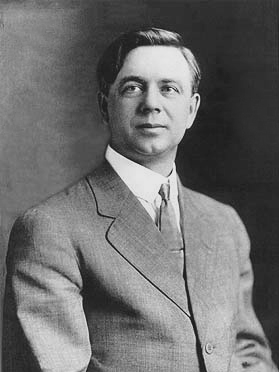
He, and his wife,
became public speakers in 1907, and -ten years later- the Sadlers became infatuated
with the 1916, pseudoscientific book, The Passing of the Great Race by
Madison Grant, which was based around the theory of Nordic superiority, soon
making many of their speeches based around eugenics. In 1910, he moved to Europe,
and studied psychiatry for a year under Sigmund Freud. Sadler glorified the
value of prayer, and religion, but was highly skeptical of mediums, channeling,
yet - in 1911- while Sadler treated a patient for his sleep condition, Sadler
said the man spoke to him, claiming to be an extraterrestrial with messages
for humanity. In 1925, Sadler "discovered" handwritten documents from
this channeled being, and only showed them to those he trusted. In 1924, Sadler
formed a private group to study these papers, as well as channeled messages,
which were being called the Urantia writings. It wasn't until 1955 that The
Urantia Foundation was formed to publish all the writings as the 2,000-page
The Urantia Book. The book is filled with sci-fi religion, bad science,
and a whole lot of racist eugenics. To note, from 1906 to 1952, Sadler wrote
over forty books on a variety of topics, such as psychiatry, sex, love, and
faith, but he also wrote several on race, such as 1922's Race Decadence,
and Long Heads and Round Heads; What's the Matter with Germany from 1918.
Many of Sadler's detractors point out that the "channeled" writings
in The Urantia Book are straight up word-for-word plagiarisms from many
of Sadler's earlier books. Also, some of The Urantia Book was lifted
from other authors, as researchers have shown its section titled "Paper
85" is mostly the first eight chapters of Origin and Evolution of Religion
by Edward Washburn Hopkins, which was published by Yale University Press in
1923, and a bunch of the book's material on the evolution of humankind seems
to have directly ripped off Henry Fairfield Osborn's Man Rises to Parnassus:
Critical Epochs in the Prehistory of Man, released on Princeton University
Press in 1928.
Flash forward to
the late 1960s, where hippie Mo Siegel was looking to find his way spiritually,
and came across The Urantia Book. While the book covers a lot of topics,
one was natural diets, which -in 1969- influenced Siegel (along with fellow
Urantia believers John Hay, and Peggy Clute) to start gathering herbs, and flowers
around Boulder, Colorado, and selling them to local health food stores. Soon
they established their company, Celestial Seasonings, which has since become
the world's highest selling herbal tea, with annual sales of $100,000,000. Though
Siegel retired from the company in 2002, he was still a big part of The Urantia
Foundation, which helps spread the book's message (including its beliefs in
eugenics). Mo Siegel is now the owner of Capital Peaks Investment, and throughout
his life has served on five public company boards, and 17 private corporate
Board of Directors, such as Whole Foods, Annie's, Chocolove, and the Colorado
Impact Fund.
I get that the racist cult origins of the world's best selling tea might be
pretty shocking, but there are a number of followers of Urantia that are just
as surprising, such as Australian polar explorer, and photographer, Sir George
Hubert Wilkins, or Kermit Anderson, who -for 30 years- worked in the fields
of medical genetics, and genetic screening with Kaiser Permanente, which is
one of the largest nonprofit healthcare plans in the U.S., operating around
40 hospitals, and over 700 medical offices. Actually, some notable musicians
loved the book, basing some of their music, and lyrics around it, including
Stevie Ray Vaughan, Jimi Hendrix, Jerry Garcia, Karlheinz Stockhausen, Jaco
Pastorius, and Pato Banton. Well, you never truly know who's been inspired by
some wacky stuff, until they admit so themselves.
-- October 08, 2022 --
It's the End of the World, As We Know It (And I Feel Fine)
Artist and musician Jonathan Canady has released his latest artists' book The Day Man Lost.
It’s an exploration of the apocalypse, with a limited run of 50 hand-numbered copies. The booklet contains Jonathan's art, along with a conversation between him and I about the End Times, as well as a story by musician Scott Candey. You can order it by contacting him at his website. Also, check out his newest music release, Empty Box, here.
-- October 01, 2022 --
Resuscitating Jane Doe
My last post was about a man with no name that few knew about, and this one's going to be about a woman with no name that many once knew about, but few do today. While much of it is legend -as there are no records of the actual event- an unidentified young woman's body was pulled from the Seine River near the Quai du Louvre in Paris, sometime in the late 1880s, thought to have passed by suicide. It's said that a pathologist at the Paris Morgue was so taken by her beauty that he felt compelled to make a death mask of her face, and she became known as L'Inconnue de la Seine (translated as "the Unknown Woman of the Seine").

In the following
years, a number of plaster casts of her death mask were produced, and became
a fashionable fixture in the French art underground. She soon found her way
into literature, with the earliest mention being in Richard Le Gallienne's 1900
novella The Worshipper of the Image, where a poet falls in love with
the mask. Albert Camus compared her smile to the Mona Lisa. The protagonist
of Rainer Maria Rilke's only novel, Die Aufzeichnungen des Malte Laurids
Brigge (1910), mentions the mask, and critic
Al Alvarez later wrote in his 1972 book, The Savage God, "I am told
that a whole generation of German girls modeled their looks on her." The
1926 Ernst Benkard book on death masks, Das ewige Antlitz, includes her.
Czech poet Vítezslav Nezval wrote a poem in 1929 inspired by her, titled
"Neznámá ze Seiny". She is referenced in the 1955 William
Gaddis novel The Recognitions, 1942's My Heart for Hostage by
Robert Hillyer, and by Chuck Palahniuk in his story "Exodus", from
Haunted (2005). In 1963, Bentley Stone choreographed a ballet around
her story, with music by Francis Poulenc. Artist Man Ray made a series of surrealist
mises-en-scène pictures of her in 1966. Documentaries have been
made on this maiden, and L'Inconnue is sung about on a 2018 track by
Beach House, as well as on Frank Turner's 2019 album No Man's Land. Most
Americans may not know her story, but they may be familiar with her face -especially
if they've taken a CPR class- as she has been the face of the first-aid mannequin
Resusci Anne (aka Resuscitan Anne) since 1958.
Yet, her origin story may turn out to be all wrong. According to one version,
the draughtsman Georges Villa was told by the painter Jules Joseph Lefebvre
that her impression was taken from the face of a young model who died of tuberculosis
around 1875. Another account says the mask was taken from the 16-year-old daughter
of a mask manufacturer in Germany. Truth is, it's been questioned for some time
whether the expression of her face could belong to a drowned person.
Her life, and her death, may remain a mystery, but her face lives on. Had her
story been better known, I'm sure it would be an inspiration to many a social
media influencer today.
-- September 23, 2022 --
Hear Me Roar
The new season of the Lux Occult podcast (@luxoccultpod) has begun, and I'm honored to be their first guest. Hear me go on about using human bones as instruments, writing poetry, finding art in discarded trash, intense rituals, and the positive aspects of therapy.
Listen wherever you get your podcasts; iTunes, Stitcher, Spotify, Audible, or magic portal.
-- September 16, 2022 --
A Real Loss
I'm sorry if I
offend anyone here, but I don't understand the outpouring of grief for Queen
Elizabeth II. Never mind that she cost British taxpayers about $368 million
in expenses each year, how first cousins Katherine, and Nerissa Bowes-Lyon,
were locked away in institutions because of learning disabilities, or the fact
that she's actually German with the family name Saxe-Coburg-Gotha (changed to
Windsor during the First World War). There's the 1948 Batang Kali massacre in
Malaysia; the Kenyan Chuka massacre in 1953, and later Hola massacre in '59;
taking advantage of a military coup in Indonesia to call for violence against
the Communist Party of Indonesia in 1965; and the rest of British colonial history
under her rule.
Now, I'm not heartless. I do bemoan the death of those who have died - just
not monarchs. I can even say my heart aches for some who have passed that I've
never met, and didn't know at all, with the most recent death I felt sorrow
for was a nameless Amazonian who was only known as The Man of the Hole.

The Man of the
Hole was an indigenous person who was the sole inhabitant of the Tanaru Indigenous
Territory, a protected area of the Amazon rainforest in the Brazilian state
of Rondônia.
In 1996, word reached the Brazilian Fundação Nacional do Índio
(a governmental protection agency for Amerindian interests) that a massacre
had been committed against an uncontacted tribe by illegal miners the previous
year. Their research proved horrifying.
It turns out that most of The Man in the Hole's tribe was slaughtered by cattle
ranchers sometime in the 1970s, but he and a few others survived well into the
1990s. It was in 1995, that illegal miners put out poisoned sugar for the remaining
members of the tribe, and all died but him. After the miners bulldozed the tribe's
village, Fundação Nacional do Índio stepped in, and officially
declared 31 square miles (8,000 ha) of his land as a protected indigenous territory.
They had learned of the tribe, but it wasn't until they did some observations
that they discovered he was all alone. No matter their research, it's not known
what his tribe was called, what language they spoke, or what the Man of the
Hole's real name was. Still, they kept their distance, and checked in every
so often. In that time, they found that he built straw huts for shelter, but
periodically moved, with over 50 huts since identified. His "Man of the
Hole" nickname came from inspections of his abandoned huts, where a deep
hole was found in each. It was thought the holes were used to hide in, or trap
animals, but some speculate they might have spiritual significance. Despite
protections, and observations, he was shot by a rancher in November of 2009,
but survived.
Sadly, on August 24th of this year -after not being seen for some time- Fundação
Nacional do Índio agent Altair José Algayer found The Man of the
Hole had died in his most recent hut. It was reported he was found "lying
down in the hammock, and ornamented [with macaw feathers] as if waiting for
death". His body was taken to the state capital of Porto Velho for autopsy
to establish cause of death - thankfully, there were no signs of violence. It's
estimated he had died in July, at around 60 years old. Marcelo dos Santos, an
indigenous peoples expert, said The Man of the Hole should be buried in the
same place he had lived.
Rest in peace, warrior. Damn it! Who's cutting up onions in here?
-- September 04, 2022 --
Trust No One (Especially Anyone In Government)
In case you haven't
noticed yet, I'm a bit of a conspiracy theorist. Not your newfangled flat-Earth,
adrenochrome, anti-vaxx kind. I'd say I'm the more sensible, realist type. Well,
at least all the conspiracies I've ever believed in turned out to be real: MK-Ultra,
Project Paperclip, the fake Gulf of Tonkin incident, misinformation on weapons
of mass destruction in Iraq, Project Sunshine baby corpse thefts, and so on.
I'm not sure about chemtrails, but there are plenty of experiments the U.S.
government performed over cities from planes. In 1950, the U.S. Navy sprayed
large amounts of Serratia marcescens bacteria over the city of San Francisco
in Operation Sea-Spray; Operation Big Buzz had the U.S. military drop 300,000
mosquitoes (Aedes aegypti) in 1955, over parts of the state of Georgia
to determine if they could survive to take meals from humans; twice in 1956,
Operation Drop Kick had the Army Chemical Corps drop mosquitos over Savannah,
GA, and a third time over Avon Park, FL in 1958; in 1949, the U.S. government
released radioactive fission products (iodine-131, and xenon-133) over three
small towns in Washington state for Operation Green Run. Then there's also "cloud
seeding", a type of weather modification to change the amount of rainfall
by dispersing substances into clouds (something almost every major country on
Earth has performed several times), but also "solar geoengineering",
which involves spraying particles into the stratosphere to help cool the planet,
sometimes known as "stratospheric injection", or "stratospheric
aerosol scattering" (Russia performed these experiments from a helicopter
in 2009). Combine these two facts, and I can partly understand why some people
believe nefarious groups are filling the skies with poison.
Chemtrails aside, true or not, there are literally hundreds of instances of
governments doing bizarre tests on their unsuspecting citizenry. While many
are familiar with the United States' Tuskegee syphilis experiments on black
Americans (conducted by the United States Public Health Service, and the Centers
for Disease Control, between 1932 and 1972), there are so many more folks are
unaware of.
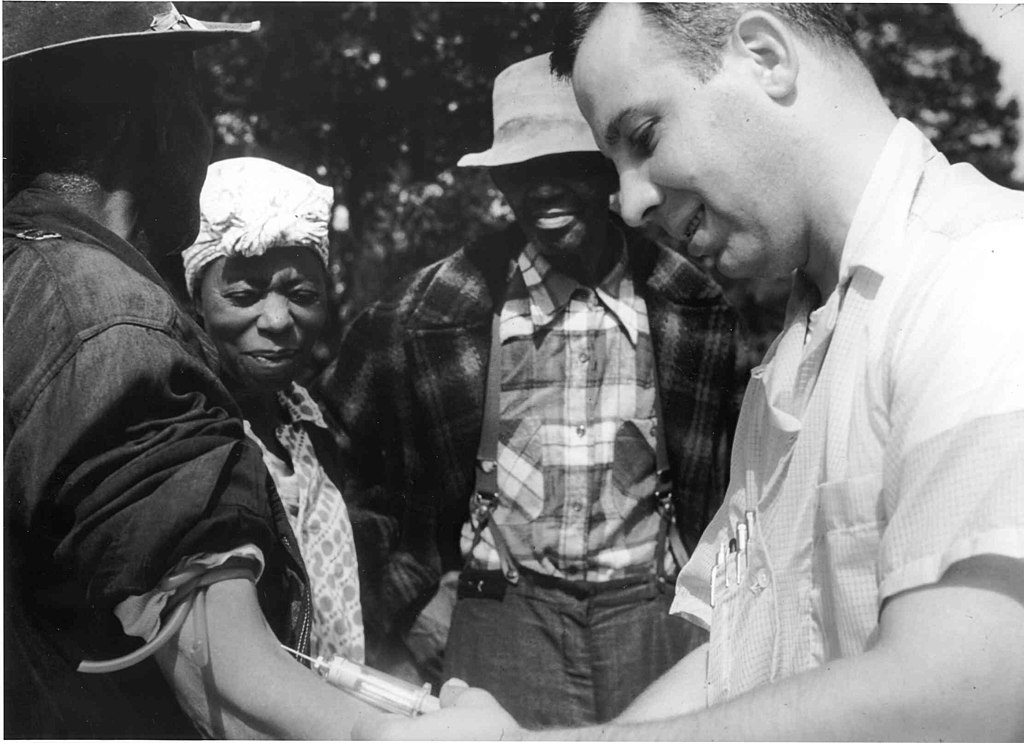
In the 1940s, prisoners
of Stateville Penitentiary in Illinois were infected with malaria by the University
of Chicago's Department of Medicine (now the Pritzker School of Medicine), in
conjunction with the U. S. Army, and the U.S. State Department. This experiment
was so egregious, the Nazis used it as a defense of their actions during the
Nuremberg Trials.
From 1946 to 1948, U.S. researchers in Guatemala used prostitutes to infect
prisoners, patients of mental health wards, and Guatemalan soldiers with syphilis,
so as to test the effectiveness of penicillin. About 700 people were infected
as part of this study - including orphan children!
From 1963 to 1969, the United States ran Project Shipboard Hazard and Defense,
which involved spraying several U.S. ships with different biological, and chemical
warfare agents, without telling any of the military personnel aboard the crafts.
In 1966, the U.S. Army released Bacillus atrophaeus bacteria
into the subway tunnel systems of New York City, as part of a field experiment
called A Study of the Vulnerability of Subway Passengers in New York City
to Covert Attack with Biological Agents, and then tried it again in the
Chicago subway system.
The U.S. Atomic Energy Commission ran a study at the University of Nebraska
College of Medicine where they fed radioactive iodine-131 to healthy infants
in 1953, then again at Detroit's Harper Hospital to premature, and full-term
infants.
From 1946 to 1953, at the Walter E. Fernald State School in Massachusetts, the
U.S. Atomic Energy Commission, along with the Quaker Oats corporation, fed oatmeal
containing radioactive calcium, and other radioisotopes, to track "how
nutrients were digested".
From 1960 to 1971, the Defense Atomic Support Agency performed whole-body radiation
experiments on black cancer patients at the University of Cincinnati Medical
Center, where they forged consent forms.
From 1950 through 1953, the U.S. Army conducted Operation Large Area Coverage,
spraying chemicals over six cities in the United States, and Canada, testing
the dispersal patterns of chemical weapons, including zinc cadmium sulfide.
From 1951 to 1974 extensive dermatological research operations by the University
of Pennsylvania, on behalf of Dow Chemical Company, the U.S. Army, and Johnson
& Johnson, studied the health effects of dioxin, and other herbicides, on
prisoners at the Holmesburg Prison in Pennsylvania (from 1964 to 1968, the U.S.
Army paid almost $400,000 to perform experiments with mind-altering drugs there
as well).
In 1950, the C.I.A. initiated Project Bluebird (later renamed Project Artichoke),
to develop "the means to control individuals through special interrogation
techniques", dosing over 7,000 U.S. military personnel with L.S.D., without
their knowledge, or consent.
In the late 40s, Harvard University researchers performed experiments testing
diethylstilbestrol (a synthetic estrogen) on unsuspecting pregnant women at
the Lying-In Hospital of the University of Chicago, which soon experienced an
abnormally high number of miscarriages.
In 1939, the Iowa Soldiers' Orphans' Home ran an experiment where they used
psychological torture to induce stuttering in 22 kids who had no speech impediments.
Now, I listed quite a lot, but it isn't even close to the full scope of (known)
research, and studies, done on the innocently unwitting in the United States
- many of which were only learned of after investigations, or the release of
documents under the Freedom of Information Act. Who knows how many are unheard
of, as well as the thousands of others done in other countries? Though there
are documented accounts of disgusting Nazi operations, and knowledge of the
infamous Unit 731, which Japan ran in China, it's not fully known what went
(or is currently going) on in Russia, or China.
At least with those in power becoming more open to scrutiny, we can hopefully
prevent things like this happening in the future. I'd love to say that I know
mankind can do better, but if we could, we probably wouldn't of had a need for
government in the first place.
-- August 29, 2022 --
Hush Now
My sold-out book, The Least Silent of Men, is being released in a second edition on the Fall Equinox. For those that missed out on the original, it's a chapbook on the subject of silence, and a detail of experiences during a 30-day vow of silence while living in New York City. Originally limited to 333 paperback copies, and 25 hardcovers, this edition will only be available in a run of 100 paperbacks, signed and numbered.
The work contains
a foreword by artist George
Petros, a lengthy article on my experience, as well as a transcript of the
communication book carried for that month.
It's $15 with postage paid in the U.S. (with an additional $10 outside the United
States), and you can purchase it at my
Etsy.
-- August 23, 2022 --
A Story About Kid(ding) Rock
There's a lot of
forgotten bands out there from the 1960s and 70s. Some never recorded, but had
such amazing live sets, that they're still talked about 'til this day. Others
-like the Detroit rock band Death- did record, but their labels shelved the
albums, which hadn't seen the light of day until more recently. Yet, there are
a few that get a bit of press years later, but never actually existed. Wait.
What?
Yeah. In 2005, Dave Stewart of Eurythmics fame, was being interviewed in an
issue of Rolling Stone, when he mentioned a project he was involved with
in 1974, called Platinum Weird. As the story went: he, and an unknown singer
named Erin Grace recorded a five-song EP, later titled Will You Be Around.
Erin impressed a number of musicians, including a young Stevie Nicks, who liked
her so much, she copied her style. After a few live shows, and the EP complete,
Erin became distraught over the death of Nick Drake, and ran off with Elton
John's boyfriend. She later turned up in L.A., and Don Henley introduced her
to Lindsey Buckingham, which spawned a relationship that would be the inspiration
for Fleetwood Mac's Rumours. In July of 2006, VH1 ran the documentary
Rock Legends - Platinum Weird, which told the story of the short-lived
act by host Dan Aykroyd, featuring clips of the band in 1974, as well as Mick
Jagger, Ringo Starr, and Stevie Nicks recalling memories of the band.
The thing was,
it was all a hoax. The songs were recorded in 2005, and released as digital
downloads eight days before the fake VH1 documentary. Now, many might think
this was all a moneymaking scam, but everyone involved admitted to the prank
immediately after the show's premier in a Los Angeles Times interview
- though Stewart claims the band actually did exist at one time, saying the
doc was about 80% true. Still, they did keep up the facade, and whether that
was to pull the wool over the eyes (or ears) of unsuspecting music nerds, or
just thought it was fun to keep the gag going, is unknown, but they did release
the five tracks with other "previously unreleased" songs as a full
album, Make Believe, in October of that year. The electronic store Best
Buy even got in on it, exclusively carrying a special two-disc edition, which
had the standard "1974" album, plus a bonus disc of twelve "new"
recordings.
With shades of The Masked Marauders band hoax pulled by Rolling Stone
in 1969, it's still a wonderful slice of blurring the lines between fiction,
and reality. Sure, it's fake news, but it's one of the more fun examples of
it, I guess.
-- August 08, 2022 --
Man's Inhumanity to Man
John Steinbeck
said people should really get to know one another, adding, "If you understand
each other you will be kind to each other. Knowing a man well never leads to
hate, and almost always leads to love." I believe he made a great point.
I mean, Daryl Davis has befriended Ku Klux Klan members for over 30 years, and
-in getting to know one another- convinced 200 of them to quit the organization.
We are all aware of the divides among race, or religion, and what some will
do to any on "the other side" of their group. We even know about the
cruelties of war, and what one human being can do to another in those circumstances,
but what about hatred for another class of people that very few understand,
and -in some cases- don't even know why a hatred exists.
There's the well-documented caste system of India, where for the last 3,000
years they've had a segmentation of society into groups whose membership was
determined by birth - the Brahmins (priestly class), the Kshatriyas
(rulers or warriors), the Vaishyas (artisans, and merchants), Shudras
(laborers), and Varna (untouchables). Much of this stems from a Vedic
society (circa 1500 - 500 BCE), having parallels with other Indo-European societies
of the time, yet there is no mention of the "untouchables" in any
Vedic literature. It's thought that the practice of shunning that class came
from the Manusmriti, or "Laws of Manu", which is dated sometime
between the 2nd Century BCE to 3rd Century CE, stating outcastes should be ostracised.
So, just because of this text, an entire group of people are forced to spend
their lives doing degrading work (such as, literally, toiling in human feces),
or starve. Still, there are other countries that practice this system, which
few are aware of. The Baekjeong were an untouchable caste in Korea, who
originated from an unknown minority nomadic group, whose specific ethnicity
is disputed. During the Goryeo period (918 - 1392 CE), this group settled in
small communities, and were primarily butchers, tanners, or executioners - jobs
no one else wanted. Soon, the term baekjeong meant "lowly person",
and their communites weren't even recorded in censuses, or the national register,
as many of them were seen as criminals. In the 19th and 20th Century, the baekjeong
began to resist social discrimination that existed against them, starting with
petitioning to be allowed something so simple as to wear the same clothes, and
hats as other people, in 1900. Today, there is little prejudice against baekjeong,
but it still exists in more rural areas. Other such discriminated groups include
the Burakumin of Japan, and even the Melungeons of America's central
Appalachia.
Strangely enough, India doesn't hold a candle to my ancestral home of Spain,
which has six groups of hated peoples, some of which no one has a clue as to
why. These groups include the ethnic minorities, Gitanos, and Maragato;
a discriminated group of cowherders in northern Spain, called Vaqueiros de
alzada; the Mallorca Spanish island's Xueta; with the most well known
being the Cagots.
click on image for larger view
Some time around
1000 CE, this group of people show up in the Pyrenese Mountains between France,
and Spain. The Cagots mostly live in Spain's Basque provinces, and Aragón,
while in France they settle in Béarn, Aragón, Gascony and Brittany.
It isn't even known where the word cagot comes from. Some scholars think
it's because they might be descendants of Visigoths, with the name deriving
from caas ("dog"), and the Old Occitan for Goth gòt.
On the other hand, some think the word means "hunters of the Goths",
and that the Cagots were descendants of the Saracens, and Moors, or possibly
even Basque country Roma (aka Gypsies). The uneducated belived worse,
such as that they were descendants of the carpenters who made the cross that
Jesus was crucified on, or that they were all originally lepers known as pauperes
Christi. Either
way, this group was tremendously hated, being forced to live in completely seprate
towns, and excluded from having political, and social rights. Cagots
were not allowed to marry non-Cagots; were not allowed to enter taverns,
or use public fountains; their baptisms could be held only at night; they were
buried in separate cemeteries, with reports of riots occurring if bishops tried
to have the bodies moved to non-Cagot cemeteries; Cagots were
not given a last names in registries, and records; they had to enter churches
by a special door, and a rail separated them from the other worshippers; Cagots
were forced to wear a distinctive dress to which was attached the foot of a
dead goose, or duck, while others had to wear cloaks with a yellow trim to identify
them; they were prohibited from selling food, or wine, touching food in the
market, or working with livestock, while often restricted to craft trades including
those of carpenters, woodcutters, coopers, or rope-makers. Though the government
tried to end Cagot discrinmination in the early 1800s, many small villages
didn't care, and still ostrasized these people. By the 20th Century, very little
of their culture exists, because most of their descendants preferred not to
be known as being Cagot. Only a small handful of artists today express
the struggle of being Cagot, such Iñaki Elizalde's 2012 film Baztan
(were a young man fights the discrimination his family has suffered for centuries),
or sculptor Xabier Santxotena, whose work explores Cagot histroy.
A lot of folks may just brush this off with a sarcastic, "Sucks to be you,"
but I prefer -if I can end this on another quote- to think like Martin Luther
King Jr., and "Let no man pull you so low as to hate him." So, please,
be good to each other.
-- July 25, 2022 --
Viewers Beware
I love mockumentaries,
especially when a lot of people fall for 'em. I admit to having been duped by
one, or two, myself (such as Joaquin Phoenix's I'm Still Here, 2010).
There's nothing like approaching the end of what you think is a real documentary,
and thinking, "Wait a second! This can't be real." There are a number
of them that have people reeling a bit after they're done, but once the dust
settles -and the hoax is exposed- everyone has a good laugh. Yet, there are
a number of mockumentaries where some never catch on, and folks will swear it's
the truth years later.
One in the first category is Ghostwatch.

Broadcast on BBC1,
Halloween night of 1992 -as part of BBC Drama's Screen One series- the
show was recorded weeks earlier, but presented as live television. The show
was about poltergeist activity, and hosted by actual reporters, Michael Parkinson
and Sarah Greene, who started off as if they were not taking the subject seriously.
Soon they are joined by a "Dr. Lin Pascoe", supposed paranormal expert,
who talks about a malevolent ghost nicknamed "Pipes" haunting a house
in Northolt, London. The audience is asked to call into the show with ghost
stories, and many callers claim that "Pipes" is manifesting in their
homes, as they watch. Strange things start happening in the studio (like a crew
member being injured by a falling mirror), and soon the Doctor believes the
tv show is acting as a nationwide séance. The spirit of "Pipes"
takes over the studio, and -after dragging Greene offstage- he takes control
of the studio, as lights explode, leaving everyone in the dark. Parkinson stumbles
around, asking if the cameras are still on. He begins to recite a nursery rhyme,
and then starts speaking in the voice of "Pipes", as everything cuts
to black, and it ends. The BBC was swamped with over 30,000 phone calls from
a pissed-off, as well as frightened audience, including Parkinson's own mother.
The British papers scorned the BBC for the disturbing nature of some of the
scenes, especially Parkinson's possession scene. Ghostwatch was never
again rebroadcast in the U.K, though there have been two UK home releases (British
Film Institute's 10th Anniversary edition on VHS and DVD, and 101 Films' 2011
DVD release). Internationally, Canadian digital channel Scream ran it on Halloween
in 2004, and the Belgium's Canvas Channel did the same in 2008. For a while,
Ghostwatch was available on streaming services, but it's now available
on the Internet Archive for free.
Now, for the second category of mockumentaries, in which (literally) thousands
of people believe it's real, is Alternative 3.
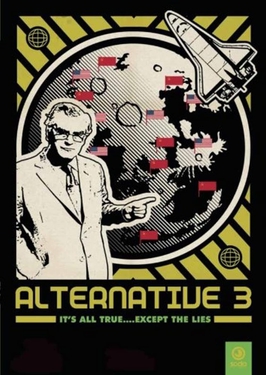
Airing only once
in the U.K. in 1977, Alternative 3 was originally meant to be shown on
April Fools' Day, but was delayed, and broadcast on June 20th. Basically, the
fictional story in this mock documentary is that reporters had uncovered a number
of mysterious disappearances, and "deaths" of physicists, engineers,
and astronomers, being due to a conspiracy to make the Moon, and Mars, habitable
(in the event of climate change) by kidnapping said scientists, and secretly
moving them to a base on the dark side of the moon. To this very day, many conspiracy
theorists claim it was a real exposé, and the reason it's not rebroadcast
is due to the U.S. government's anger that their dirty laundry was aired. Even
UFOologist Jim Keith wrote a book on it (Casebook on Alternative 3: UFOs,
Secret Societies and World Control, 1994) claiming that much of it was based
in fact, and Bill Cooper would often say it was true on his The Hour of the
Time radio show, though he made no mention of it in his infamous 1991 book,
Behold A Pale Horse. Though there was a DVD release of the movie in 2007,
it's currently out-of-print, and goes for $25 to $100 around the web.
None of this is a surprise, as the internet is filled with a handful of satire
sites many take seriously, and even more social media misinformation memes that
get passed around like candy at a child's birthday party. It's no wonder these
well-produced pieces were taken to be real, when an image that takes less than
five minutes to create will find its way around the world within seconds. I
won't say, "Humanity is doomed," but a lot of it sure is fucked.
-- July 12, 2022 --
It's the New Zoo Revue, Comin' Right At You
The disgusting acts of imperialism never cease to appall me. Man's inhumanity to man is mind-boggling, and -though difficult to fully understand- I can see how strong feelings against atrocities are stifled by categorizing a group as having conditions and qualities of Otherness. This has led to unimaginable horrors, such as the Nazi concentration camps, and the Belgian Congo genocide, but also acts of cruelty that are on such a small scale they often go undocumented in history books. One good example are human zoos.
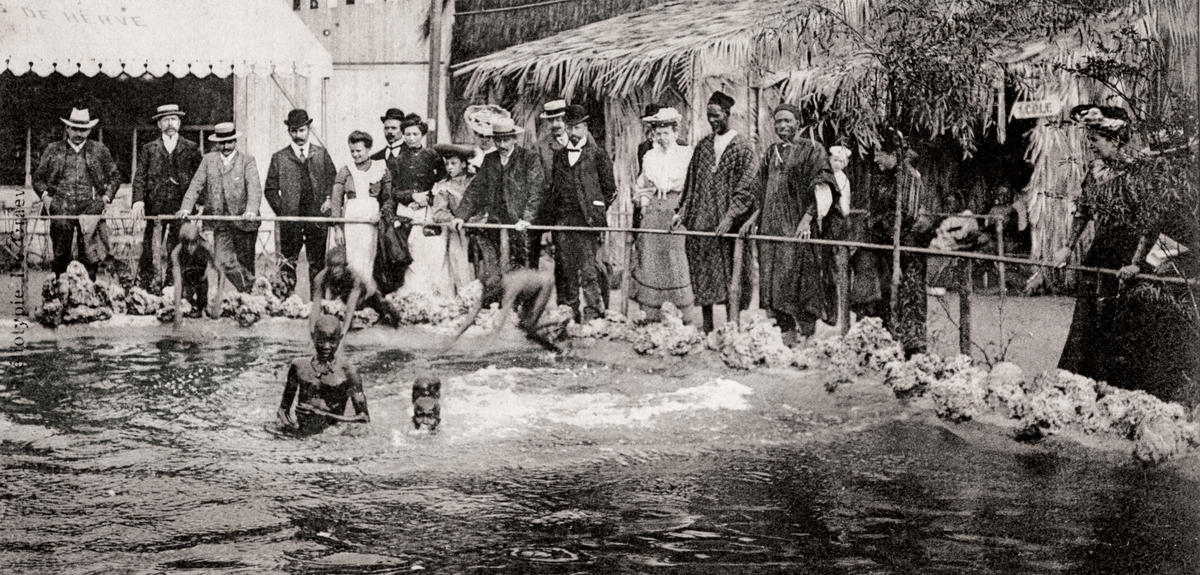
Beginning sometime
in the late-1800s, it became rather fashionable for zoos to have a pen holding
a family -though occasionally just a single person- from what was considered
an "exotic population", with a lean towards stereotypes, and asserting
Western superiority, though lauded as "educational". Cities such as
London, Paris, Milan, Hamburg, Madrid, Chicago, and New York City all had them,
and while they fell from popularity in the 1930s, some of them ran as late as
the 1950s.
It is thought to have started in 1874 by Heinrich Leutemann, and Carl Hagenbeck,
who decided to exhibit Sámi people (a Finno-Ugric group inhabiting the
northern parts of Norway, Sweden, Finland, and Russia) with the "Laplander
Exhibition" in Germany. Its success had Hagenbeck go on to launch a "Nubian
Exhibit" in 1876, and an "Inuit Exhibit" in 1880. These types
of expositions became so popular, that the 1878 World's Fair in Paris presented
a "Negro Village", which was visited by 28 million people, and the
1889 Parisian World's Fair expanded to display 400 indigenous people.
To increase the number of visitors, the Cincinnati Zoo invited one hundred Sioux
Native Americans to establish a village at the site in 1896, and they wound
up living there for three months.
In 1906, Ota Benga, a 23-year-old Mbuti (aka Pygmy) was a human exhibit showcased
every afternoon, during September, at the Bronx Zoo's Monkey House. First being
exhibited at the Louisiana Purchase Exposition in St. Louis, MO, throughout
1904, Benga was "purchased" from slave traders by explorer Samuel
Phillips Verner, who was purposefully searching for African people to display.
The Scottish National Exhibition, opened by Prince Arthur of Connaught in 1909,
held two human attractions. One was a Senegal village with the Senegalese living
in beehive huts, and a group of Somali living in thatched huts.
The list of these are pretty long, and include the 1904 St. Louis World's Fair
holding a large group of Filipinos; the 1906 and 1922 Colonial Exhibitions in
Marseilles, France, both displayed nude human beings in cages; a display at
Manchester, England's Belle Vue Zoo featuring an unknown company of Africans
labeled "cannibals" in 1925; and the Portuguese World Exhibition of
1940 included a tribe from the Bissagos Islands of Guinea-Bissau, who were presented
on an lake island in the Lisbon Tropical Botanical Garden.
While these barbarous shows are now illegal, they still go on in some form known
as "human safaris", where tourists are taken to see groups of rarely
contacted, isolated indigenous people. In 2012, a safari trip to the Bay of
Bengal deliberately stopped to visit the Jarawa tribe of the Andaman Islands,
who were asked to perform dances for the rubberneckers, and -though they were
asked to not to "feed" the tribespeople- many sightseers brought food
in attempts to get closer contact. This was all caught on video, upsetting the
Indian government, and they banned these trips the following year.
With the current political climate, as well as heightening racial divide, one
has to wonder what heinous acts our future brothers will arrange. I, for one,
have hope, but we all know that hope springs eternal -not always, but normally-
so let's see what tomorrow brings.
-- July 01, 2022 --
Frat House Blues
I'm pretty sure
most of my readers hate frat boys. Their depiction in movies like Revenge
of the Nerds, and Animal House aren't really that far off from reality.
Fraternity houses across the United States are filled with well-to-do Caucasians
whose parents helped them get to where they are, often leading to a mentality
where they believe themselves to be better than everyone else. That's why in
the previously mentioned movies the protagonists create confraternities - basically,
establishing an anti-frat house. Yet, in real life, those confraternities rarely
turn out so wholesome as they do in Hollywood. In Nigeria, they actually turned
out to be pretty deadly.
In 1953, author, and future Nobel Prize winner, Wole Soyinka noticed his fellow
University of Ibadan alumni were mostly wealthy students associated with the
colonial government. Seeing that the few poor students who attended the college
would often submit to them, he and six friends (calling themselves "the
Magnificent Seven" or "G7") formed the Pyrate Confraternity in
response, which is also known as the National Association of Seadogs.

The organization's
motto was "Against all conventions", and they began using the skull
and crossbones for a logo, as members adopted pirate-themed club names, like
"Long John Silver" or "Cap'n Blood". Membership was open
to all male students no matter their tribe or race, but most applicants were
denied, as they were rather stringent in choosing new recruits. In 1972, accusations
of illegal activities were leveled against the group, and it was discovered
a smaller group within (called the Super Pyrates) were responsible for acts
of violence against, and intimidation of, other students. This made local headlines,
and students in other universities throughout the country picked up on the idea.
By the 1980s, confraternities had formed in over 300 educational institutions,
including the Neo-Black Movement of Africa (also called Black Axe) at the University
of Benin, the University of Calabar's Eternal Fraternal Order of the Legion
Consortium (the Klan Konfraternity), and then there was the Supreme Vikings
Confraternity (the Adventurers), the Brotherhood of the Blood (aka Two-Two,
or Black Beret), and the Family Confraternity (the Campus Mafia), which modeled
itself after the Italian Mafia. Around this time, most confraternities turned
away from colonial Christianity, and began practicing traditional religious
practices, including Vodun, with some of the groups turning into full-blown
cults, some of them Satanic in nature. Around the early 90s -due to the drug
trade many members were involved in- these anti-frats began having turf wars
against one another. This didn't stop them from setting their sights on other
students in their own campuses either. The most infamous case of a confraternity
attacking nonmembers happened in 1999, at the Obafemi Awolowo University in
Ife. Confraternities were banned there, but a student-led search discovered
eight secret Black Axe members stockpiling assault rifles in a dorm room. This
enraged the confraternity leader, who organized a machete-carrying murder squad,
which hacked the student union Secretary General, and a few other students,
to death as they slept.
Today, the situation isn't much better. Some of the groups intimidate professors
into giving them higher grades by setting their cars alight, or temporarily
snatching their kids. They'll murder other students they believe have stolen
a member's girlfriend. Some of the confraternities specialize in cybercrime,
money laundering, pay-for-release kidnappings, and some are even hired by politicians
to harass rival government officials. A few of the cults actually offer opportunities
to members after graduation, seeing as they have connections with political,
and military figures - giving many of their alumni future networking opportunities
becomes quite an incentive drive for new applicants.
This is all pretty harrowing stuff, and things aren't as bad in Western countries,
but still: the next time you see an American frat bro, don't take them so lightly.
They may not be directly involved in crime, but you can bet they're doing nefarious
things in government. Just look at the U.S. Supreme Court.
-- June 21, 2022 --
Artsy Fartsy Phony Baloney
I enjoy a good hoax, especially in the literary, music or art worlds. One prankster I've recently discovered is Jamie Shovlin, a British conceptual artist whose artworks are hoaxes, and hoaxes are artworks.

In 2004, he held
his first exhibition, Naomi V Jelish, which debuted at the Riflemaker
Gallery in London. The exhibit contained the work of a schoolgirl named Naomi
V. Jelish. As the story went, which came from the show's included newspaper
clippings, Naomi won "the prestigious North Kent Student Art Prize"
in 1990, but -after her father drowned the following year- the artist, her mother,
and four siblings simply vanished. Though there was a police investigation,
no one had seen the family since. The girl's drawings were recovered from the
family's abandoned home by the late John Ivesmail, a science teacher at Naomi's
school. Before his death in 1999, Ivesmail put up the artwork in a small gallery,
which is where Shovlin discovered them. In attendance at this new show was Iraqi
art collector, and businessman, Charles Saatchi. Saatchi bought the entire collection
for £25,000, but halfway through the affair realized, both, Naomi V. Jelish,
and John Ivesmail's names were anagrams for Jamie Shovlin. Instead of being
upset, Saatchi realized its place in the art world, and moved the exhibit to
his gallery, as well as released an accompanying catalog of the work.
In 2006, Shovlin opened his newest exhibit Lustfaust: A Folk Anthology 1976
- 1981, which consisted of memorabilia from a German glam rock outfit called
Lustfaust, supposedly curated from the archives of Mike Harte (a Shovlin collaborator),
and Murray Ward. The show's history, and backstory, was supported by a network
of websites (created by Shovlin, of course), and fooled art critic Waldemar
Januszczak into telling his readers the band had "cocked a notorious snook
at the music industry in the late 1970s by giving away their music on blank
cassettes, and getting their fans to design their own covers." Shovlin
said this hoax (as well as his previous) wasn't made just to fool an audience,
but to let them gradually come to the realization they were being hoodwinked,
encouraging them to question preconceived opinions. Admittedly, he had included
clues that it was all a joke, like the description of Lustfaust moving in a
direction "dangerously close to Spinal Tap-isms". Later that year,
Beck's beer Futures prize had this exhibit winning runner-up, and in
September of 2007, Shovlin put together musicians to perform under the name
Lustfaust, for the opening of the new Haunch of Venison Gallery in Berlin.
Much of these hoaxes-as-art posits a fiction as a way to develop conversation
on authenticity, but I'm not sure if they work as intended. After the prank
is exposed, many an art lover often just roll their eyes, while a handful actually
get angry. Something tells me that a lot of what's intended gets missed by the
crowd it's intended for, though folks like me love it, and laugh. Then again,
maybe that's the bigger purpose: for all of us to laugh at the art world. If
so, consider me giggling.
-- June 13, 2022 --
A Zine's End
Issue 9, The Secret Knowledge (with collage work, and paintings by Chilean artist Leonardo Casas), and Issue 10, Guaranteed Healers (featuring tattoo flash by artist Tim McGrath), of the Anima Animus Art Series Zine will mark the end of this two-year project on a nice round number, and they are out now.
If you want to
pick up any others, Issues 1, 2, 6 and 7 are sold out, while there are less
than four of Issue 8 (Dan Gorostiaga), with a little over five copies left of
Issues 3 (Chuck Loose), 4 (Liorcifer), and 5 (Thaniel Ion Lee).
Visit my Etsy
page for ordering info.
-- June 06, 2022 --
It's A Bird! It's A Plane! It's A Satellite!
I've written of
a few broadcast panics here. Of course, most people are aware of Orson Well's
1938 War of the Worlds fiasco, but few of my readers knew about the episode
I wrote of in June 2019, which happened in Ecuador, back in 1949, and led to
the deaths of a number of people. Well, here's another only a handful have read
about.
Since 1955, Associated Rediffusion's ITV Television Playhouse produced hundreds
of popular teleplays in the United Kingdom. On February 20, 1959, they presented
Wesbrook Fuller's play, Before the Sun Goes Down. The television broadcast
was directed by Robert Tronson, and starred Eddie Byrne, Moultrie Kelsall, and
Anthony Nicholls, but -with such notable, and known, talent- one wouldn't think
there could be a problem. However, the flick began with an extremely convincing
news bulletin, reading, "We are interrupting the program for an urgent
announcement. Tonight a new, and terrifying, satellite has been launched into
outer space. Defying all previously held scientific theory, it hangs stationary
over London." As the satellite is pictured on the screen, the announcer
continues, "Here it is, seen from a camera on the roof of Television House.
The question is, 'Is this an enemy space platform armed with H-bombs aimed at
the heart of the City?' Before we know the answer, remember: there is no need
for panic. There has been no ultimatum from any other Power. The Prime Minister
has called an emergency Defense Council meeting. He has asked us to broadcast
the following message: 'Fear is our greatest enemy, not bombs. Carry on as usual,
but stay in your homes with your families. Our trust is in God'. In compliance
with the Prime Minister's request, the Civil Defense has ordered all traffic,
and pedestrians, off the streets at once." The Independent Television Authority
had warned the producers that the broadcast might start a panic, and -boy- were
they right.
Hundreds of people thought the melodrama was breaking news, and took shelter
before the rest of the play could begin, bringing with them only a portable
radio for updates from the outside world. Though none ran off screaming into
streets, or rioted, many a household barricaded themselves indoors for safety's
sake. A whole lot of them waited all night with no word on what was going on,
riddled with anxiety throughout the evening. It wasn't until the next morning
that those suffering a bout of fright discovered it was only an intro to a televised
play. This led to thousands of complaints against the BBC, and the Independent
Television Authority.
It was so bad that the March 16th sitting of the House of Commons that year
had Labor Party politician Maurice Edelman gave a rousing condemnation of the
broadcast, and believed the producers (ITV Television Playhouse and Associated
Rediffusion) had abused the Television Act of 1954. While Edelman may have spewed
a bit of hyperbole in his speech, he did pretty much hit it on the nose, when
he stated, "...the purpose of commercial television is to make an immediate
assault on the viewer's emotions, and it does so in the most direct way that
an assault can be effected: by presenting violence as a means of holding the
viewer's attention."
It's sad when you think about how such a large group of the public can be so
easily mislead, but -then again- even more are duped by simple social media
posts these days. The future looks dim, as the sun sets on our society.
-- May 23, 2022 --
Dog Gone It
Alright, this is
a tough one to write about, but it's such a bizarre story, so... content warning!
The following describes a despicable act committed on a innocent dog. Read at
your own discretion.
Tom Otterness (1952 - ) is an American sculptor, and is one of the United States'
most displayed public artists.

His work can be
found in hundreds of libraries, parks, subway stations, plazas, museums, and
even courthouses, around the world, but most are found throughout New York City,
including Rockefeller Park, and the 14th St / 8th Avenue New York Subway station.
He had an upside-down Humpty Dumpty balloon entered in the 2004 Macy's Thanksgiving
Day Parade, and was made a member of the National Academy Museum in 1994. I'm
not sure how he became so accepted after his abominable 1978 short "art"
film.
In 1977, Otterness adopted a dog from a shelter in Golden, Colorado, and chained
the dog to a stake out in the mountains. He then proceeded to film himself shooting
the dog dead. Titled Shot Dog Film, it premiered -running as a loop-
at a Times Square screening room in early '78, and as disgusted viewers left
the theater they were flash-photographed. Though the work was not accepted in
Washington Project for the Arts' Punk Art Catalog exhibition of that
year (due to its offensive nature), Tom was still interviewed for their magazine.
In it, he stated, "[the Times Square screening] as best as I could do it,
was the most aggressive way I could think of to show a film, the most damaging
thing that I could do to the audience by showing a film. I hired a photographer
with a camera so when people were leaving the theater, they were assaulted by
a flash, attacked."
Many artists turned their back on Otterness, but the episode was forgotten rather
quickly. Some time after, he began to get notoriety for his sculptures, but
in 2004, artist and art critic Gary Indiana, brought it up in an interview with
New York Magazine. Otterness received tons of backlash, and in a 2008
interview with Brooklyn Daily Eagle said, "Thirty years ago when
I was 25 years old, I made a film in which I shot a dog. It was an indefensible
act that I am deeply sorry for. Many of us have experienced profound emotional
turmoil and despair. Few have made the mistake I made. I hope people can find
it in their hearts to forgive me." While much of his old work remained
where it already was, Tom -rightfully so- lost a hell of a lot of new work,
including a few that were under contract with the New York City Library, and
San Francisco Arts Commission.
I used to say that I would defend an artist's right to express himself any way
they saw fit, but after discovering this insane act of elicitation, I realized
even I have my limits. While I understand that Otterness was young, and dumb,
at the time, I will fully forgive him only once it's revealed how much Tom has
donated to animal causes since his act of cruelty. Until then, fuck you, Tom
Otterness!
-- May 13, 2022 --
I've Returned, And This Sucks
My move to Detroit
is complete, so I'm back to posting at my regular schedule, and since the Philippine
election is currently in the news (with ex-dictator Ferdinand Marcos' son, Ferdinand
Marcos Jr., winning), I thought I'd give you some CIA shenanigans from the Philippines.
After World War II, the Filipino's People Army had become rather marginalized,
despite helping U.S. forces in the fight against Japanese occupation. Therefore,
they began a peasant revolt, called the Hukbalahap (aka Huks) Rebellion. Inspired
by Communist ideas, and the Philippines being a U.S. asset, the CIA wouldn't
stand for it, so they recruited Air Force officer, and psychological warfare
expert, Major General Edward Lansdale, to break up the party.
The country folk -who made up much of the Huks- believed in what is called an
aswang, a type of shape-shifting, blood-sucking monster, which had a
long straw-like forked tongue that sucked out a victim's liver, heart, or even
a fetus.
The Spanish colonizers
noted the aswang was the country's most feared mythical creature as far
back as the late-1500s, and the CIA used that to their advantage. First, they
began to spread rumors of aswang sightings. Then, as Hukbalahap units
went on night patrols, Lansdale ordered his men to try to grab the last man
in the group, puncture his neck in two places, hang him upside-down (so as to
drain his blood), and place his body somewhere back on the trail. Of course,
once the rebels returned, and found the body of the desanguinated corpse of
their missing comrade, they would assume he was the victim of an aswang
attack. It worked wonders, as frightened Huks would abandon the region, and
the position would be taken over by pro-U.S. Manilan forces. In May of 1954,
the Hukbalahap surrendered, and the rebellion ended, with Edward Lansdale credited
as helping put an end to it.
While the CIA used a number of other tactics in the Philippines, this weird
one is said to have been the most dynamic, which proves the power of psychological
warfare, as well as highlights the deceptive influence it can have on unwitting
minds. Luckily, none of that happens today, in our society. Right? I mean, we're
all smart enough to know when we are being manipulated. RIGHT!?
-- February 14, 2022 --
Movin' On Up
Well, I've packed
up my belongings, and I'm off to Detroit, so -until I get most of my life out
of boxes- I won't be posting for a bit (possibly until early May).
Until I return, here's some fun reads on Wikipedia:
Anatoly Moskvin: A Russian grave robber who stole bodies to turn into dolls.
Underwater formation near Cuba: Could there be a sunken city off the coast of Cuba?
Catullus 16: Written around 50 BCE, it considered the world's filthiest poem.
Human mail:A list of people who have mail themselves, or been mailed by others.
Mellified man: A magical medicine made from a mummy and honey, said to cure almost anything.
Spite houses: A list of homes built to irritate neighbors.
See you all back here in May! Oh, but until then, check out the Know-It-All Asshole Jerk Instagram...
Since I have my phone on me all the time, I post there daily, so check out @knowitallaholejerk.
-- February 02, 2022 --
Turning Over An Old Leaf
A few folks who
visit this (or my old This Hidden City) blog, know I not only have a
thing for tree -yes I'm a literal "tree hugger"- but really enjoy
checking out some of the oldest trees wherever I stay. When I lived in Brooklyn,
I even posted about visiting New York state's oldest tree, an over-400-year-old
Tulip Poplar (Liriodendron tulipifera), known as Queens
Giant. I hope to one day come across Methuselah, which -at 4850-years-old-
is currently the oldest living tree, and I say "come across", because
the location is a secret to keep as many people away as possible. Why? Well,
let's look into that.
The oldest known tree to have existed was called Prometheus, a 5000-year-old
Great Basin bristlecone pine (Pinus longaeva), which was located in Wheeler
Park, Nevada. In 1963, a graduate student at the University of North Carolina
Chapel Hill, Donald R. Currey, was studying the bristlecone populations in the
Snake Range mountains in NV. Basing a theory on the trees' size, he was convinced
they were extremely old, and cored some of them. In doing so, he discovered
trees exceeding an age of 3,000 years. Sadly (for the tree), Currey was not
able to obtain a continuous series of cores from a tree he labeled WPN-114,
which the locals dubbed Prometheus. In August of 1964, the student grabbed a
chainsaw, and cut the tree down. Currey, who died in 2004, became a professor
of geography, and while he became well known in academic circles for his extensive
exploration of the Great Basin's Lake Bonneville, he never shook off the controversial
felling of what was then the world's oldest tree.
While that's a pretty enraging story, I'm about to share one that's utterly
infuriating, and that's the tale of The Senator.

In 1993, a Bald
cypress (Taxodium distichum) tree was studied in Longwood, Florida's Big Tree
Park, that was found to be 3500-years-old, making it the 5th oldest tree in
the world. Given the name of "The Senator", it was not only the largest
cypress ever found, it was the largest of any tree east of the Mississippi (even
though -in 1925- a hurricane ripped off 47' [14m] of the tree top). Locals knew
the tree was ancient, because tales of the area's Native tribes included it,
so it had always held prominence, and a walkway was built for visitors as far
back as the late-1800s. President Calvin Coolidge checked it out in 1929, and
dedicated the site with a bronze plaque. Sadly (again for the tree) on January
16, 2012, a woman named Sara Barnes crawled into a hole in the tree, and lit
a small fire, so she could examine a bag of crystal meth she had just bought.
The fire got out of hand, and even though fire fighters tried their best, the
tree collapsed. The 26-year-old druggie was sentenced to a measly thirty months,
but nature lovers suffered more so, as the park closed for two years because
of the vandalism. The oldest tree in the park is now a 2000-year-old cypress,
known as Lady Liberty.
If you're interested in knowing some of the other oldest trees still around,
read up on Chile's 3650-year-old Gran Abuelo, a Patagonian cypress (Fitzroya
cupressoides), CB-90-11, a 2464-year-old Rocky Mountain bristlecone pine (Pinus
aristata) in central Colorado, or Bennett Juniper, a Californian Sierra juniper
(Juniperus grandis) that's 2200-years-old. One with a very interesting history
is Jaya Sri Maha Bodhi, a 2308-year-old Sacred fig (Ficus religiosa) in Sri
Lanka, which is the oldest living human-planted tree in the world with a known
planting date. Turns out, a sapling from the historical Bodhi tree under which
Gautama Buddha was said to have became enlightened, was brought to its current
location, and planted around 288 BCE by daughter of Emperor Ashoka, Sanghamitra.
Why most people couldn't care about trees, let alone what we're doing to the
environment, and man-made climate change is beyond me. And, no, I wouldn't have
preferred to say, "I'm stumped."
-- January 17, 2022 --
Riddle Me This
For someone who
loves a good mystery, I'm not much for solving puzzles. Still, there were two
that had always fascinated me, both of which revolve around literature: Cain's
Jawbone, and Fenn's treasure.
The first I mentioned was a hundred-page, loose-leaf book, released in 1934,
and written by Edward Powys Mathers, under the pseudonym Torquemada. While Cain's
Jawbone is a narrative story, it's also a puzzle - which the Laurence Sterne
Trust called "one of the hardest and most beguiling word puzzles ever published."
To solve it, the reader has to put the pages in proper order, and figure out
which characters are the murderers, and which are the victims. The text includes
a bunch of uncredited quotes, puns, references, and word games. The pages can
actually be arranged in a number of orders, to produce a few intelligible stories,
but only one is correct. The puzzle's solution (both the original print's, and
its later, more-recent repress) have never been made public, and anyone who
answers it is sworn to secrecy. Both, the 1934, and the 2019 editions had cash
prizes for whomever was able to solve it. When the original book was released,
the company Victor Gollancz Ltd. announced it would give £15 (which is
about £1000, today) to anyone who could solve it. During it's original
run, only two people had been able to collect the prize - a Mr. S. Sydney-Turner,
and Mr. W. S. Kennedy, in 1935.

After its 2019
re-release, by United Authors Publishing Ltd. (aka Unbound), they offered £1000,
and it was won by only one person in November of 2020 - comedian, and crossword
compiler, John Finnemore, who worked on it over six months during his COVID
lockdown. He told The Guardian, "The only way I'd even have a shot
at it was if I were for some bizarre reason trapped in my own home for months
on end, with nowhere to go and no-one to see. Unfortunately, the universe heard
me."
The second puzzle, known as Fenn's treasure, was a bronze box filled with gold
and jewels (said to be worth $2,000,000) hidden by Santa Fe, New Mexico, art
dealer, and author, Forrest Fenn, somewhere in the U.S. section of the Rocky
Mountains. After a diagnosis of terminal cancer in 1988, Fenn had the idea to
hide the cache, and later self-published the book The Thrill of the Chase:
A Memoir, which, while a collection of short stories from his life, also
told of the treasure, as well as gave hints as to where it was. The chapter
titled "Gold and More", contained a poem that held as many as nine
clues to where the stash was buried.

Since the release
of the book, as well as news stories covering it, there have been close to a
dozen arrests of idiots digging up national parks such as Yellowstone, or running
around with metal detectors through sacred Native American land. Worse, five
deaths have been attributed to the search for it (Jeff Murphy in WY, Michael
W. Sexson in UT, Pastor Paris Wallace, Eric Ashby, and Randy Bilyeu, all in
different parts of CO). For years, many people believed the deaths were all
for nothing, because they were certain the hidden trove was a hoax, but in June
of 2020, Michigan student Jack Stuef discovered the box in Wyoming. Strangely
enough, Fenn survived his cancer diagnosis for over thirty years, but died just
a few months after the fortune was found. Before it was finally discovered,
Fenn and his treasure were the topic of many a mystery tv episode, including
Discovery Channel's Expedition Unknown, and Unsolved on Buzzfeed.
Author Douglas Preston knew Forrest, and had seen the valuable box, crediting
him as being the inspiration for his 2003 novel The Codex.
Well, writing about all of this makes me curious to see if I can figure out
such a puzzling mystery, but I really don't know of any other infamous enigmatic
games. I guess the best I can do is try my hand at an escape room, or something.
Wish me luck, because I'm sure I'll be trapped for some time.
-- January 08, 2022 --
Choice Cuts
My industrial music outfit, 156, has a new release, Humanize / Dehumanize, and it's a 5" and 4" picture disc, plexi-glass lathe combo.
The records (as
well as the digital download) come with the track "Humanize", which
is meant to also be played backwards, as the track "Dehumanize", and
are brief meditations on sickening tortures carried out by authoritarian regimes
-and even supposed "democratic countries"- the world over. The set
is limited to only 25 copies, and they all come with a signed, and hand-numbered
photographic art pieces of dehumanizing cuts on skin, along with the (sealed)
razor blade that made one specific cut.
The record set is $25 (or just $1 for the download), and can be ordered via
the 156
Bandcamp page.
UPDATE: Physical copies are sold out.
-- January 03, 2022 --
This Info Is Arresting
When one thinks
of California gangs, the images that come to mind are swathed in blue and red;
Crips and Bloods. A few might think of Sureños (Mexican mafia), or even
Hells Angels, but not many think of police officers. Well, a lot of my readers
might refer to the cops as their own gang, but hardly any know there are actually
real gangs within law enforcement. The Los Angeles County Sheriff's Department
alone has about twenty, though they prefer the term "cliques" when
referring to them. That's right, complete with matching tattoos, secret hand
signs, and at least one murder under each member's belt, the first-known L.A.S.D.
gang was The Little Devils, who were founded at the East L.A. Station in 1971,
consisting of mostly white deputies who patrolled Latino and black communities.
Currently, The Regulators at Century Station, and the Lennox Station's Grim
Reapers are more recent gangs the FBI has been made aware of. While The Cavemen,
3000 Boys, The Posse, The Jump Out Boys, and Wayside Whites are just a few of
the other cataloged police gangs, two of the most well-documented groups would
be the Lynwood Vikings, and the Compton Executioners.
The first was based at the now-defunct Lynwood Station, and members included
Paul Tanaka (also a Gardena city council member), and Lee Baca (30th Sheriff
of Los Angeles County) -both of which are convicted criminals- plus Robert Norris
(who later became 13th Sheriff of Kootenai County, Idaho). The clique's tattoo
is the number "998" (which stands for "officer-involved shooting")
on their ankle, meaning the cop has put a bullet in someone, with L.A.S.D. under-sheriff
Jerry Harper calling it "a mark of pride".

In 1996, Deputy
Mike Osborne was interviewed by Los Angeles Times, where he stated an
invitation to join the Vikings was impressive among the ranks, but "you
keep your mouth shut, and obey the code of silence" about illegal activity
by others involved. It almost goes without saying, that after testifying against
the Vikings, Osborne, his wife (Deputy Aurora Mellado), and their children were
shot at in their home by what's believed to be disgruntled sheriff's deputies.
Federal judge
Terry Hatter called the group a "neo-Nazi, white supremacist gang",
after litigating over several wrongful death suits.
The other infamous L.A.-based officer gang was, as their name implies, founded
at the Compton Station. Formed in the 1990s by Deputy Andy Toone, after leaving
another deputy gang, The 2000 Boys, they are considered one of the largest with
over eighty members. Recruits are chosen based on past acts of violence against
Compton neighborhood citizens, and cannot be women, nor of African descent.
The gang's tattoo (which only members who have killed a civilian can get) is
of a skeleton with "CPT" on a military helmet, and the Roman numerals
for "28" on the magazine of an AK-47 - the letters stand for "Compton",
and the number is for Compton being the 28th substation.

Last year, the
gang came to the media's attention when Deputy Miguel Vega was said to have
killed 18-year-old Andres Guardado, to impress the group in hopes of being initiated.
It's no secret that this isn't just an isolated phenomenon to the Los Angeles
area, as retired Louisiana Chief of Detectives, Godfrey "Doc" Buquet,
was once quoted as saying, "I was in a gang. It's called the police."
Once you know, and investigate this situation, it's much easier to understand
the calls to defund the police. In all honesty, as a complete Anarchist, I wouldn't
mind doing away with law enforcement altogether. I understand having a justice
system, but I'm fine with having no cops around. ACAB!
-- December 21, 2021 --
Cartoonishly Late
Most every
year, around this time, I tend to post a seasonal story of high weirdness, but
I think I've run out of Xmas tales to tell you. With a move from FL to MI coming
up, I may also run out of time to post more often, until (at least) April. The
idea of running out of time does bring up another interesting item I'd like
to share. Imagine becoming so involved in a project that forty years of dedication
doesn't even bring you to a third of the way to finishing it; a painstakingly
tedious creative endeavor that you know you may not get to complete in your
lifetime, but you trudge on anyway. That's the case of Yuri Norstein and Franchesca
Yarbusova's animated film, The Overcoat, or -as it's known in Russian-
Shinyel.
Based on a 1842 short story by Nikolai Gogol, the feature-length film began
production in 1981, making it the longest running production time so far for
any animated film. The project began as the work of only three people, Yuri
Norstein as director and animator, his wife Franchesca Yarbusova as artist,
and family friend Aleksandr Zhukovskiy as cinematographer. By 1975, the trio
had gained fame for their animated short Hedgehog in the Fog. Each panel
of that film was shot on three different planes, giving it an almost three-dimensional
look, and the art was heavily detailed making every frame an art piece unto
itself. By 1979, they had completed Tale of Tales, in the same style,
and that animated film gained them, not only several awards (Jury Grand Prize
at France's International Festival of Films, and winning the Best Film Longer
Than Three Minutes Award at the International
Animation Festival in Canada, both in 1980), it was deemed by an international
jury to be the greatest animated film of all time, twice (Los Angeles Olympic
Arts Festival [1984], and Zagreb World Festival of Animated Films [2002]).
In 1981, Yuri had the idea to tackle -though it had been made into a feature film several times- Gogol's The Overcoat. Taking on the same style, and aesthetics, as their previous animated shorts, they knew it would take time, but not this long. Work began at Soyuzmultfilm (the main Soviet animation studio), where the trio had worked most of their careers. Around 1986, with only ten minutes complete, Norstein was fired due to his works not having enough of a Socialist message. Setting up an animation studio in their home, the husband and wife duo continued on. Though offered funding by many sources, such as from Sberbank (Savings Bank of Russia), the Soros Fund, and TNK Oil, they took very little, and only when they felt it completely necessary. While this delayed production more so, things were made worse in 1999 when the couple's longtime collaborator Aleksandr Zhukovskiy died. In 2003, one of AZ's students, Maksim Granik, took on the task of helping finish the enterprise. All along, Yuri took other jobs filming shorts, as well as commercials, which also stalled work on The Overcoat. It is said that, by 2010, only a little under thirty minutes of it had been done, with about five minutes of different segments surfacing. Have a look...
In 2007, the studio
stopped again, so Norstein could finish a two-volume book, Snow on the Grass
(Sneg na Trave), which consists of lectures on the art of animation.
The last most have heard of the work on the movie is an interview in 2015, where
Yuri has claimed they are moving along, gaining him the nickname "The Golden
Snail". At this rate, many believe there will never be a finished product.
Next time you're being hard on yourself over finishing a huge venture: remember
this story, and keep up your efforts. If it's worth it, you'll finish. Hopefully
it won't take you over forty years to wrap it up, but -if it does take you that
long- maybe I'll write a post about it, so lumber on.
-- December 08, 2021 --
Mating Song and Dance
I have no issues saying, "I hate musicals." While there are a small handful I kind of don't mind, there is one I actually would like to see: Let My People Come. Known as the world's first, and possibly only, "sexual musical", Let My People Come was originally written in 1973, by Earl Wilson Jr., with lyrical (and production) help from Phil Oesterman.

The show ran in New York City's Greenwich Village at The Village Gate Theater, from January of 1974, until July of 1976, with songs such as "Everybody Likes To Screw", "I'm Gay", and "Come In My Mouth". It proved to be such a hit that the pair released a twelve-track original cast album, on 12" vinyl via Libra Records, the year it opened, and it was actually nominated for a Grammy in 1975.

The performance
was moved
to Broadway at the Morosco Theater on July 7, 1976, running for 108 shows, until
it closed on October 2nd, and featured E.R. and Orange Is the New
Black cast member Yvette Freeman. Strangely enough, Wilson decided to separate
himself from the production when it hit Broadway, saying to The New York
Times, "I feel that the show has become vulgar." The reason it
stopped running altogether was due to a lawsuit by MCA Music. The label took
the duo to court because their number "The Cunnilingus Champion of Company
C" was a play on Don Raye and Hughie Prince's "Boogie Woogie Bugle
Boy". The court deemed it "could not be construed as a burlesque of
plaintiff's work per se", finding it to be a "commentary on an era,"
and not protected by fair use. The defendants were found liable for copyright
infringement, with the show being halted, and the record no longer available
for sale.
In 1985, producer Bernard Jay bought the rights (minus the sued song), and reran
the show in NYC. Producer John Forslund then ran it in New York again in 2013,
but revamped many of the numbers, and even wrote new ones. While the original
cast also had runs in Chicago (1974), and London (1974), a different cast also
ran at Grendel's Lair Cabaret Theatre in Philadelphia (for ten years), and at
the Basin Street Cabaret Theater in Toronto (for eight years).
As much as I'd like to check it out, I wouldn't go see a remake of Let My
People Come. Screw that! So unless an old video of the original book comes
up on YouTube someday, I guess I'll just have to settle to listening to one
of the deeply discounted 12"es one can currently find on Discogs. It may
not be as sexy, but it'll have to do.
-- November 29, 2021 --
This Guy's Got A Lot of Balls
I was recently reading a piece on the world's most powerful radio station, Powel Crosley Jr's WLW, which began broadcasting in 1922. Though I laughed about how neighbors of the tower could hear the signal in their bed springs, pots, pans, and barbed-wire fences, it also brought to mind another hilarious story: that of John Romulus Brinkley. You'll have to follow a long path of weirdness to get to his transmission depot, but what a path it'll be.
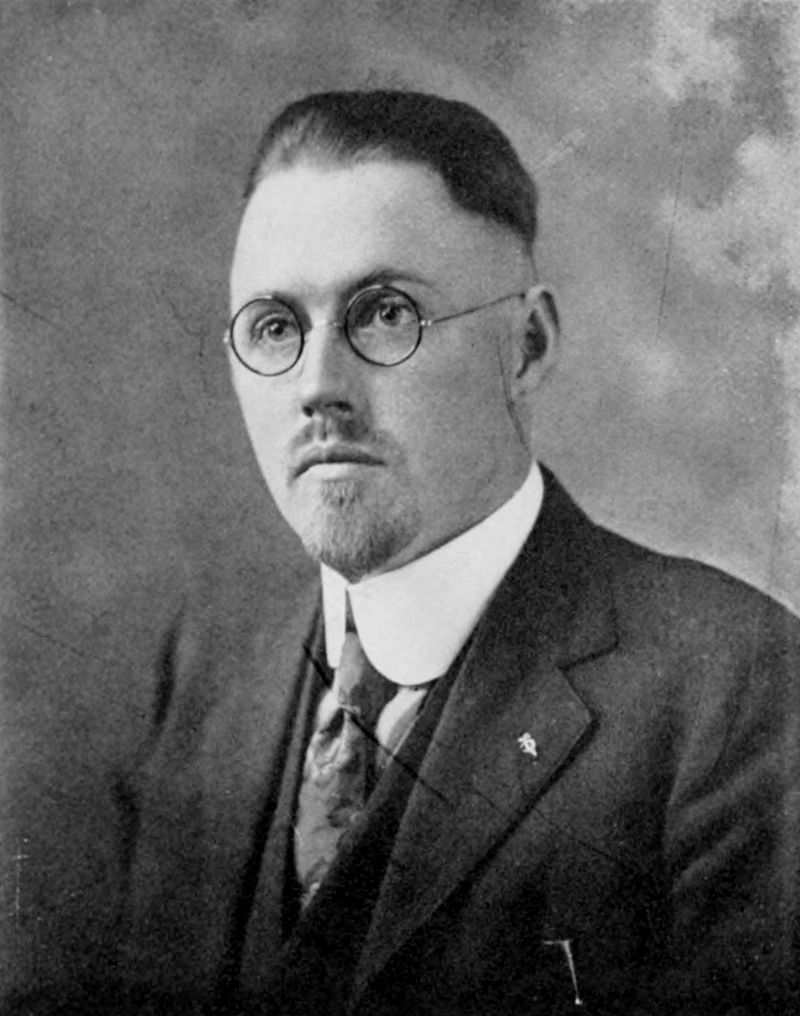
J.R. was born on
July 8, 1885, in Beta, North Carolina, to Confederate States Army medic John
Richard Brinkley, and Sarah Burnett, though they never married. His mom died
when he was five, then his dad passed when he was ten, and John wound up living
with Sarah's aunt, Sarah T. Mingus. As a telegrapher, he moved to New York City
to work for Western Union, but returned when Mingus got sick, and died. Brinkley
was comforted by Sally Wike, with whom he fell in love with, and married. Together,
they moved to Chicago, and after having a daughter, he enrolled at Bennett Medical
College. After bearing an infant son that hardly survived birth, and mounting
debts, Wike took their girl, and split. Two months later, John kidnapped his
daughter, and hightailed it to Canada. Sally forgave him, and they reconciled,
so he returned to Chicago. After another two years, she bore him another daughter,
but left again. JRB returned to NC in 1911 to escape mounting school bills.
Deciding to go back in 1913, no school would take him, due to owing money to
his previous college, so he opted to buy a certificate from a diploma mill called
Kansas City Eclectic Medical University. He and his partner, James E. Crawford,
set up a storefront medical business in Greenville, South Carolina. Naming it
the "Greenville Electro Medic Doctors", they would inject colored
water into their patients for $25 a pop (about $700 today), saying it was "Salvarsan:
electric medicine from Germany." The duo packed up, and split to Memphis
, TN after the local paper wrote they had almost 40 unpaid bills with area merchants.
In Tennessee, John took over the office of a doctor who was moving out of state,
and made enough to pay back his first college. In 1917, he was conscripted as
an Army Reservist, but didn't fight in the First World War, as he had a nervous
breakdown, and was quickly kicked out of the military. The following year, his
family moved to Milford, Kansas, where he opened a multi-room clinic, building
a good name for himself by paying decent wages, propping up the local economy,
and making house calls to patients hit by the deadly 1918 flu pandemic. It was
around this time that he got the idea he is now known best for: transplanting
goat testicles into impotent men's sacks. Yep! For only $750 (that's about $10,000
today), Brinkley would remove a man's testes, and put in some fresh goat gonads.
He claimed it restored sperm count, and even cure almost thirty other ailments,
including dementia, emphysema, and even farting. Now, mind you, animal nut transplants
weren't really new, and another doctor, Serge Voronoff, had become well known
at the same time for grafting monkey testicles into men. Still, with John's
crappy medical training, many of his patients got infections after surgery,
a number of patients died, and the doc was sued a dozen times for wrongful death.
This didn't stop him, and he was one of the first to start massive mailing campaigns,
sending junk mail to almost a million homes, with ads that told men they could
become "the ram that am with every lamb". This quickly attracted the
attention of the American Medical Association, and they began looking into his
practice. That didn't even come close to stopping him, as he soon set up a radio
station, and started peddling his own brands of fake medicines. That scheme
brought in what would now amount to $10 million dollars! The U.S. government
got tired of his shenanigans, and revoked, both, his broadcasting, and medical
licenses. What's a doctor to do in this situation? Well, he ran for Governor
of Kansas (a few times), hoping to appoint his own members to the medical board,
which would help him regain his right to practice at least in that state. By
1931, his political bids all failed, so he went back into broadcasting. Without
a license to do so in the U.S., he opted to get what was known as a "border
blaster" in Mexico, calling his station XER. At 50,000 watts, it could
be heard as far away as Kansas, so he tried running for political office there
again. After his loss, the Mexican government allowed him to increase his signal
to 150,000 watts, and then to one million, which could make the radio station
heard even in Canada. Though Brinkley went back to selling snake oil (and even
sold airtime to other peddlers of medical quackery), his station became known
as "Hillbilly Hollywood" for helping promote the careers of musicians
such as Gene Autry, Red Foley, Patsy Montana, and the Carter Family. Anyhow,
Congress grew tired of his shtick, and passed the Brinkley Act, which banned
broadcasters in the U.S. from being connected via telephone line to transmitters
in Mexico. Also, under pressure from the U.S. government, the Mexican government
revoked JRB's broadcasting license. Using a different diploma mill in Italy,
he got another medical degree, and started up business again in Texas. Though
still performing the occasional goat ball transplants, he mostly did vasectomies.
By 1936, he had put away enough money to afford a mansion (complete with greenhouse,
pool, and a fountain), a stable of Cadillacs, as well as exotic animal imports
from Central and South America. In 1938, a whopping number of lawsuits were
laid against him, the IRS began looking into his taxes, and the U.S. Postal
Service investigated him for mail fraud. Brinkley filed for bankruptcy, then
due to all the stress had three heart attacks, had his leg amputated due to
poor circulation, and finally died in May of 1942 of heart failure, completely
penniless.
Even with the downer ending, John Romulus Brinkley certainly had a wild ride
through life, but I'm sure he enjoyed much of it. His story has been written
of in close to a dozen books, documentaries have been made on him, and there's
also an upcoming movie in the works, said to be written by director Richard
Linklater, and starring Robert Downey Jr. His old mansion still stands at 512
Qualia Drive in Del Rio, TX, and was designated a Texas Landmark, so it all
goes to show that sometimes you gotta be a little more nuts than the rest of
them to leave a lasting legacy.
-- November 17, 2021 --
I Did Nazi This Coming
My last post sent me to one of my favorite places (down a rabbit hole), when I mentioned author Laurel Rose Willson, who wrote under the pen name Lauren Stratford. Willson wrote three books, all spinning tales of being a baby breeder for a satanic cult's sacrifices, with the most famous being 1988's Satan's Underground. In 1989, she even appeared on The Oprah Winfrey Show, where her story was presented as being true. Not long after, the Christian newspaper, Cornerstone, proved she fabricated the whole thing. She legally changed her name to Lauren Stratford, but the damage was done, and she fell out of favor with the evangelicals. Did this stop her from trying to get attention? Nope. Willson/Stratford then changed her name to Laura Grabowski, and claimed to be a Jewish survivor of Auschwitz-Birkenau. Wait! It gets wilder. Willson/Stratford/Grabowski then hooked up with Holocaust survivor, Binjamin Wilkomirski, claiming to have remembered him from the camps. At the time, Wilkomirski was riding high due to the popularity of his 1995 book, Fragments: Memories of a Wartime Childhood, which was an autobiography about his life as a child in a concentration camp.

The book won a
number of awards, including the Jewish Quarterly literary prize in Britain,
the Prix Memoire de la Shoah in France, and the National Jewish Book
Award in the U. S. Around 1997, the two began collecting donations intended
for Holocaust survivors, but during investigations into Willson, it was discovered
that Wilkomirski may also be a fraud. In August of 1998, Swiss journalist Daniel
Ganzfried, writing for the weekly paper Weltwoche, exposed him as not
being a Latvian Jew who was detained in Nazi camps, but Bruno Grosjean, the
bastard son of a single mother from Beil, Switzerland, who grew up in an orphanage,
until he was adopted by a wealthy couple in Zurich.
Turns out, he wasn't the first, nor the last, either. The year before that exposé,
Misha Defonseca released her book, Misha: A Mémoire of the Holocaust
Years, which told the story of her search through war-torn Europe, looking
for her deported Jewish parents, and being adopted by a pack of wolves. In reality,
she was Monique de Wael, a Belgian-born Catholic bullshitter, but the truth
wasn't uncovered in time to stop production of the French film based on her
life, Survivre avec les loups (Surviving with Wolves). Recently
a documentary has been released on her, titled Misha and the Wolves.
Another is Martin Grey, who authored eleven books, two of which -Au nom de
tous les miens (For Those I Loved) and La vie renaitra de la nuit
(Life Arises Out of Darkness)- were autobiographical accounts of his
family being killed by Nazis (mother and two brothers in Treblinka, and his
father during the Warsaw Ghetto Uprising of 1943). He also wrote that he escaped
from Treblinka, and became a soldier in the Soviet Red Army. In a 1979 New
Statesman article, Holocaust historian Gitta Sereny uncovered that those
chapters in Grey's books were the fictitious work of ghostwriter Max Gallo,
written to help sell the publications.
In 1978, the Spaniard Enric Marco released Memorias del infierno (Memories
of Hell), about his time as a prisoner in the German concentration camps
at Mauthausen and Flossenbürg. He was awarded the Creu de Sant Jordi
by the Catalan government in 2001, but gave it back in 2005, when university
researcher Benito Bermejo proved he was making it all up.
Oy vey, it just keeps going! Polish-born American author Herman A. Rosenblat
wrote a "memoir", titled Angel at the Fence, about a girl who
passed him apples and bread over the barbed-wire fence at the Schlieben section
of Buchenwald, and how he later married her. Oprah called it "the single
greatest love story" in 1996, and that got Herman a $25 million picture
deal through Atlantic Overseas Pictures, until he came clean about his deceit.
Donald Joseph Watt is an Australian Army soldier who authored another fictitious
Holocaust memoir entitled Stoker: The Story of an Australian Soldier who
Survived Auschwitz-Birkenau. Published in 1995, by Simon & Schuster,
the book was praised by various Jewish organizations as the most important work
written in Australia, but was later proven to be a hoax by historical experts
from the U.S. Holocaust Memorial Museum, the Auschwitz Museum, and Professor
Konrad Kwiet, chief historian of the Australian War Crimes Commission. Some
are now saying that Denis Avey, who with Rob Broomby, who wrote the memoir The
Man who Broke into Auschwitz, is faking a bit of it because there's a few
things that don't add up. Though Avey was a British prisoner of war at subcamp
E715, he claims to have constantly snuck into Auschwitz, after trading uniforms
with a Jewish prisoner.
While I'm certain many commit these falsehoods just for the attention, there
are certainly others who only want the money. One would think there has to be
better ways to get it, but I guess some people tend to figure the best way to
get into a bank must be to crawl as low as one can go. Whatever. Gut glik mit
ale di meshugas.
-- November 10, 2021 --
Give You Something To Dance To
My new record label, Tequesta Records, which plans to showcase some of the best music acts from south Florida, is now up and running with its first release, the Vultures 10" EP from goth-punk / death rock outfit Obsidian!

Out now on 110-gram,
blood-red vinyl, this record features five tracks of dark goth-punk, and death
rock from the Land of the Sun, as well as hand-screen covers by Iron Forge Press.
You can now order it directly from the band, at their
Bandcamp page.
The label name comes from the indigenous Native American tribe of the eastern
south Florida, who inhabited the area from 3rd century BCE to mid-18th Century,
and the logo I created uses the famous Miami
Circle, which was unearthed in 1998, during construction of a high-rise
tower in Miami's downtown.

-- November 02, 2021 --
The Fathers (and Mothers) of Deception
In 1987, my astronomy
teacher at Hialeah-Miami Lakes Sr. High was a preacher. Seeing me wearing all
black, and sporting a pentagram daily, he offered me a copy of Mike Warnke's
1972 book, The Satan Seller, at the end of the school year. I gleefully
took it, and dove head first. In it, Mikey claims to have become a Satanic high
priest, summoning demons, as well as committing acts of kidnapping and rape.
Of course, it became a big seller in the Christian community, but was proven
to be a load of bullshit after being exposed in 1991. It's no wonder he later
became a Christian comedian.
If you're old enough, you just might recall the "Satanic panic" of
the 1980s, which had over 12,000 cases of supposed Satanic ritual abuse in the
United States in less than a decade. It was, and is, very similar to other moral
panics, and conspiracy theories, such as the blood libel against Jews by Apion
in 30 CE, the McCarthy "Red Scare" of the 1950s, and the current QAnon
phenom. And, just like those, nothing has ever been proven to be real. Even
with thousands of accusations of child sacrifice, torture, cannibalism, and
incestuous orgies, no actual evidence was produced. The fever pitch culminated
in 1988, when the awesomely hilarious two-hour documentary by Geraldo Rivera,
Devil Worship: Exposing Satan's Underground, aired on primetime NBC.
Making matters worse was that after Americans settled down about it in the early
90s, the panic picked up everywhere else around the world. While books like
The Satan Seller helped start the rise of this shared mania, the insanity
didn't really begin until the release of one book, Michelle Remembers.

Published in 1980,
and co-written by Canadian shrink Lawrence Pazder, and his patient Michelle
Smith (whom he later married). The now-discredited tome chronicled Michelle's
ritualistic abuse by a cult her parents had joined, revealed to her through
the practice of recovered-memory therapy. The recollection ended in an 81-day
ritual to summon the devil, when none other than Jesus, Archangel Michael, and
the Virgin Mary barged in, and put a stop to the shenanigans. The authors claimed
the group carrying out these pornographic acts of torture was the Church of
Satan, but they backpedaled on that assertion when Anton LaVey threatened to
sue them. Smith's father, Jack Proby, denied the allegations, but was haunted
by religious lunatics disbelieving him until he died. Though debunking began
as far back as a few months after publication (starting with an article in Maclean's
magazine, by Paul Grescoe, October 27, 1980), Pazder was deemed an expert on
the subject by many. He appeared on a May, 1985, broadcast of ABC’s 20/20
concerning Satanism, lectured to hundreds of police agencies about Satanic ritual
abuse, became a head member of the Cult Crime Impact Network, and was even a
consultant in the infamous McMartin preschool trial. In 1989, not to let Geraldo
outshine her, Oprah Winfrey invited Michelle on as a guest -along with Laurel
Rose Willson (aka Lauren Stratford), who authored the equally fictitious ritual
abuse memoir Satan’s Underground- presenting those stories as incontestable
fact.
Mike Warnke, Lawrence Pazder, Lauren Stratford, John Todd, Walter Martin; all
of them Christian authors and preachers, who lied to sell dramas to their flock
of sheep. Dolefully, none of that matters, because -not only has the damage
been done- millions still believe their tales to be true. I would ask them all
to stop accepting falsehoods, but that's a useless endeavor, so to all of them
I say, "I am your adversary, and stand against you." Hail Satan!
-- October 18, 2021 --
Wild in the Streets
Woods
As a few of my
blog readers know, I planned on hiking all 2200 miles (3500 km) of the Appalachian
Trail in 2020, but COVID-19 had it shut down. I threw the $2000 worth of supplies
I bought into my closet, and rescheduled. I thought to go this year, but decided
the bottleneck of hikers would be a nightmare, so I opted for 2022. Now that
I'm moving to Detroit early next year, I've postponed yet again for 2023.
Anyhow, my girlfriend mentioned this to her dad, and he brought up a tv show
he recently saw, the Discovery Channel's Expedition X (season 4, episode
1, titled "Terror In Appalachia"). In it, they cover sightings of
feral people (which date back to 1896), and point to them as the possible cause
of a number of missing hikers throughout the years. While this show is rather
sensational, makes far-reaching claims, and doesn't really provide much in the
way of proof, feral people really do exist. At least, there have been a number
of documented cases of feral children: kids who have been raised by animals,
including wolves, bears, and monkeys.
In 1982, three-year-old Robert Mayanja lost his parents in the Ugandan Civil
War, surviving in the jungle with the help of vervet monkeys for three years
until he was discovered by National Resistance Army soldiers, and reintroduced
into society. From 1650 to 1700, there were three written cases of children
found who were raised by Eurasian brown bears, but research showed that only
one may have truly existed. From age seven, Marcos Rodríguez Pantoja
lived with wolves in the mountains of southern Spain, until discovered at age
nineteen. His life was made into the movie Entrelobos, which garnered
Manuel Camacho a "Best New Actor" nomination at the 2011 Goya Awards.
The best known case of a feral child is that of Dina Sanichar.

The then-six-year-old
boy was discovered, among a pack of wolves, by a group of hunters exploring
a cave in Bulandshahr, India, in February of 1867. He could not speak (but would
growl), walked on all fours, and only enjoyed eating raw meat. He was brought
to the local Sikandra Mission Orphanage, and named Sanichar (meaning "Saturday",
the day he was found). Though Dina lived with people for almost thirty years,
he never learned to speak, but did pick up a nasty smoking habit that complicated
his tuberculosis, causing his death in 1895. After hearing of his story, Rudyard
Kipling was inspired to write a story based on Sanichar, and he became the basis
for Mowgli in his short story, "In the Rukh", which later became The
Jungle Book.
Not to end on a sour note, but many of the documented cases of feral children
actually stem from parental neglect. Eight-year-old Oxana Malaya was a Ukrainian
girl raised by dogs in a kennel. Entered in his 1672 book, Observationes
Medicae, Nicolaes Tulp wrote of an unnamed Irish boy who was brought up
by sheep, when his parents left him out in a field to starve. In 1990, a boy
simply called Daniel, became known as the "Andes Goat Boy" because
he was raised by goats in the mountains of Peru for eight years, after his family
left him. It's sad to know there are about two dozen similar stories, which
help drive home the fact that not only is abortion a worldwide necessity, but
most people should have to apply for a license to raise a child. Luckily, I'll
never register for one, as the world is better off without my wild child.
-- October 09, 2021 --
In Support of Protests (Well, Not All of Them)
I'm a little shocked
that, over the last two years, some of the biggest protests around the world
were held by selfish idiots feeling their rights were being trampled, over having
to wear masks, and stay home for a bit. Sure, we had some Black Lives Matter
groups stand up to police brutality in the U.S., which flashed a much needed
light upon law enforcement reform, but almost as many were held by Proud Boys
weeping over the loss of a fair election. Back in 2011, I supported the Occupy
Wall Street movement, but was upset when they failed to produce clear goals,
and suffered conveying their message. Still, it started out with positive intentions,
even though -seeing how the rich got so much richer during the 2020 - 2021 pandemic-
their objectives weren't met. Actually, many protest goals aren't fulfilled
in the earlier stages of demonstration, but most of them do begin with Panglossian
design.
However, there is one movement that is believed by many to have started with
idealistic and affirmative ambitions, though that couldn't be further from the
truth: the 1989 Tiananmen Square protests, or, as it's referred to in China,
the June Fourth Incident. During mid-April in Beijing, Westerners saw students
calling for democracy, due process, governmental accountability, freedom of
speech, and a free press. While up to one million attended the rallies, they
were met with violence by the People's Liberation Army using tanks and rifles,
after the government declared martial law. What many in the United States, and
Europe, didn't know was that the demonstrations stemmed from a much uglier protest
movement a few months before, known as the Nanjing anti-African protests.
In December of 1988, two male African students, of Hohai University in Nanjing,
entered an Xmas party with two Chinese women. A campus security guard found
this offensive, and got into a heated argument with one of the black men. This
erupted into a full scale brawl between African and Asian students, where thirteen
Chinese men were injured. The next day, spurred on by rumors that several native
men were killed in the incident, city residents set upon the African dormitories,
lighting fires. As Africans began to flee to embassies, over 3000 students from
several colleges began to riot, shouting slogans against race mixing. By New
Year's Eve, anti-African demonstrations spread to other cities, including Shanghai,
and Beijing. Many of these revolts were dispersed by city government, and local
law enforcement. This enraged many students, who felt they had the right to
dissent, and object to Africans, not only dating Asians, but enrolling in Chinese
schools. This "groundbreaking dissidence" in China drove the ambition
for freedom of speech, press, and assembly, which spawned the "democracy
rallies" four months later. In fact, elements of the original demonstrations
were evident during Tiananmen Square protests, and knowing this helps clear
up for Westerners why there were banners reading statements such as "Stop
Taking Advantage of Chinese Women".

Mind you, I'm not trying to put down the later students desire for a freer China, but I am trying to point out how little other countries know what's truly going on outside their own borders, how the media manipulates people's outlook on situations in other parts of the world, and how racism is prevalent in all countries around the globe. Either way, the outcome of it all was horrifying, as the Chinese Communist Party admitted to 300 deaths, while the Red Cross puts the number around 2600. Also, I hope none of this dissuades anyone from standing up to despotism and oppression. As Thomas Jefferson wrote in a 1787 letter to William Stephens Smith, "The tree of liberty must be refreshed from time to time with the blood of patriots and tyrants." Then again, he owned slaves, so maybe that's not the best example.
-- October 01, 2021 --
Let's Take A Ride
A new photo zine out later this month to celebrate the upcoming release of the Forgotten Rides photo book in 2023.

Forgotten Rides:
the Fanzine is a full-color, glossy, 8.5" x 5.5" (21 x 14 cm)
zine, limited to only 50 copies,containing 42 photos not found in the book.
All copies will be hand signed, plus numbered, and will be available for only
$8, with postage paid - add another $6 outside of North America. If you prefer
a purchase link via Etsy, that's here.
UPDATE: All copies are now sold out.
-- September 29, 2021 --
Video Nasties
Since the dawn of game arcades, there has been with it a history of bad games. Once we traded going out to drop quarters into machines, for sitting on our own couches to play on our own tvs, we brought a bunch of those crappy games in with us. A lot of older folks remember the '82 home version of Pac-Man for the Atari 2600. The simplified graphics, modified layout, and overall poor quality of the game were due to the limitations of the 2600 system. Even worse was another game of the same year, E.T. the Extra-Terrestrial. Though the game sold 1.5 million copies, Atari's expectations was to sell five million units, but word got out how terrible it was, and the company threw hundreds of thousands of them into a landfill. The game was so bad, it was thought to have caused the home video game market to crash the following year, as well as the bankruptcy of Atari. Much of this was covered in great detail in the excellent 2014 documentary Atari: Game Over. However, none compare to yet another release from 1982, Custer's Revenge, which was an adult video game.

The game was released
by a company simply know as Mystique, who produced several unlicensed pornographic
video games for the Atari 2600. Some of their other, more forgettable titles
include Beat 'Em & Eat 'Em (where the player is a woman catching
falling semen from a masturbating man), and Bachelor Party (a pornofied
version of Breakout). Though the company had the games programmed in
the United States, and manufactured in Hong Kong, they were marketed under the
infamous "Swedish Erotica" banner, which was a high staple in the
porn industry throughout the early 1980s. Custer's Revenge was universally
panned by gaming critics, and it's considered one of the worst games of all
time, due to the gameplay; consisting of a nude male player (General Custer),
who crosses the screen while avoiding a hail of arrows, to rape his Native-American
slave tied to a cactus. Had the plot caliber not been so deplorable, it wouldn't
have helped matters much, as the game had low quality graphics, but it sold
for $49.95 (about $130 today), and the negative attention helped it sell up
to 80,000 units. Gaming magazine Ahoy! called it "an affront to
common decency," and in a 2008 article about video game violence, University
of Calgary professor Tom Keenan looked back on the game, labeling it "hideous".
Australia's PC Magazine called it one of the worst games ever made, and
Unified Gamers Online included it on their list of the most racist video games.
Mystique sought to set the record straight soon after, by releasing General
Re-Treat the following year, where the sex roles were reversed, but interest
in home gaming had waned, and didn't pick back up until Nintendo released their
entertainment system in North America in 1985.
Just as gaming picked up again, shitty games came around once more, and have
stuck around ever since. There's been 1991's Action 52, Shaq Fu
(1994), and Nintendo's infamous Superman 64 in '99. As a trucker, I had
to try out Big Rigs: Over the Road Racing back in 2013, and see why it's
considered one of the biggest programming failures in video game history. Though
many have been entered on several "worst game" lists, not one of them
has been considered as disgustingly low class as Custer's Revenge. Hell,
if you know of any that can top it, hit me up, and let's play!
-- September 17, 2021 --
There's No Vaccine for These Viruses
I know we're currently
in the Age of COVID, but we still need to talk about the health of your computer,
too. Even though most of us are protected by strong cyber-security software,
malware and viruses are still a thing. Hell, they still cause billions of dollars
in damage every year.
The first-known computer virus is thought to be Elk Cloner, which was written
onto one game floppy by a then-15-year-old programmer Rich Skrenta, as a joke
in 1982. When bootleg copies of the floppy went around, so did the virus, and
history was made. The first for personal computers was Brian (aka Pakistani
Flu), which began its reign of terror way back in January of 1986, and originally
passed around (unknowingly) via floppy disk. Originally written by two Pakistani
brothers, it was meant to target copyright infringement of their medical software,
but the program would save itself onto other non-related floppies, spreading
it worldwide until 2001.
The worst computer virus outbreak so far has been the Mydoom worm (aka Novarg),
which caused $38 billion in damage in 2004 alone (that's $52 billion today).
The malware spread through mass emails, and was responsible for up to 25% of
all emails sent that year. Seventeen years after its creation, it's still making
over a billion copies of itself every year.
Now, while all computer viruses are malicious, it takes a certain type of dickwad
to hit below the belt with them. One such case is that of the Pikachu virus
(or Poké virus), a computer worm believed to be the first aimed at children,
because it incorporated Pikachu from Pokémon. Released June 28,
2000, it spread through emails sent to kids, titled "Pikachu Pokemon",
with the body of the e-mail containing the text "Pikachu is your friend."
Luckily, it wasn't too bad, as it asked whether the user wanted to delete the
two critical Windows folders it was supposed to attack. If the child wasn't
stupid, and hit "cancel", the computer would be alright.
One that is often filed in the Annals of Scumbaggery would be the AIDS Trojan
virus (otherwise known as the PC Cyborg virus), the world's first known randsomeware.
But, it's actually a big misunderstanding, and the product of a misguided attempt
to showcase the spread of AIDS, mixed in with a little user error - sorta. You
see, the virus was created by evolutionary biologist Joseph L. Popp, who handed
out 20,000 of the original infected disks (labeled: AIDS Information - Introductory
Diskettes) to attendants of the World Health Organization’s AIDS Conference
of 1989. The disks came with a pamphlet that warned one the software would "adversely
affect other program applications..." as well as telling the user they
"will owe compensation, and possible damages to PC Cyborg Corporation,
and your microcomputer will stop functioning normally." Sadly, most people
lost the leaflet, didn't understand it, or thought it was a joke, and ran the
disk without realizing what they had done. Upon insertion, the screen would
turn red, and read:

After the 90th
time the computer was rebooted, the machine would lock up the directories, and
encrypt files on the C drive. To regain access, one would have to send $189
to PC Cyborg Corp's PO box in Panama. Though upon arrest Popp claimed the money
went to AIDS research, the Harvard-trained doctor was charged with eleven counts
of blackmail by Scotland Yard. He was soon released, as he was declared mentally
unfit to stand trial, and was deported back to the U.S. Before his death in
2007, the good doctor settled in upstate New York, and opened the Joseph Popp
Butterfly Conservatory, as well as published a book, titled Popular Evolution:
Life-Lessons from Anthropology in 2000.
Computers have become so much for us today. It's how many of us get our news,
watch movies and series, connect through social media, as well as get creative,
or even work. These machines need to be as healthy as we are, so we have to
take into account the disruptive potential of viruses, alongside the stakes
for effective cyber-security, whether desktop, laptop or phone. Just as people
need to be vaxxed, computers need a bit of help staying fit, so contact a nerd
today, and have them take a look at that hard drive - it could have cooties.
-- September 10, 2021 --
I'm No Leader, But Feel Free to Follow Me
Quick note just to say I have rejoined Instagram...
...so if you'd like to check out my travels, see more of my photos, or stalk me on the only social media I allow the public to view, feel free to visit @adelsouto.
-- September 06, 2021 --
Not the Best of Friends
Israel has been
in the news lately, over all the shitty things they're doing to Palestinians.
Many a United States citizen are asking why we're giving $3 billion a year (the
largest recipient of American aid from 1976 - 2004, and the largest cumulative
aid [$146 billion] since World War II) to a country that commits such atrocities.
Well, while I don't agree with it, I do know why. They're our biggest ally in
the region (GOP senator Jesse Helms once referred to Israel as "America's
aircraft carrier in the Middle East"), they spend the most on U.S. goods
(much of that $3 billion comes back in the form of weapons purchases, which
helps Israel keep their -according to U.S. foreign policy- "qualitative
military edge"), and lastly many politicians are religious idiots who think
helping out "God's chosen" slice of desert will secure them a seat
in Heaven. The craziest part of this is that the view of allyship differs on
the other side. It is a well-known fact, even within our government, that Israel
will do whatever it takes to achieve the security of the Israeli state. For
instance, in May of 2014, a National Security Agency document obtained by journalist
Edward Snowden, and published by journalist Glenn Greenwald, revealed the CIA
had concerns Israel set up an extensive spy network within the U.S. government.
A 2019 report even stated that the FBI concluded it "was pretty clear that
the Israelis were responsible" for cellphone surveillance devices discovered
near the White House. However, it goes further than spying. If someone gets
in the way of Israel throwing a punch at an enemy, they're fine with striking
whoever happens to be in that path. The thing is that the United States has
been punched by Israel a few times, and very few people know about it. Take,
for example, the USS Liberty incident.
The USS Liberty was originally the light civilian cargo vessel Simmons
Victory (what was known as a Victory Ship - a copy of Liberty Ships that
supplied Allied forces with cargo during World War II). It was acquired by the
U.S. Navy, and was converted to an ACTR (auxiliary technical research ship),
which is a now-admitted cover for NSA spy ships performing intelligence missions.
During the Six-Day War of 1967, between Israel and several Arab nations (Egypt,
Jordan and Syria), the USS Liberty was ordered to the Mediterranean area
to perform a signals intelligence collection. It is claimed that Israeli Central
Coastal Command had information the U.S. ship was shelling the coast of Israeli-occupied
Arish, Egypt - even though the ship only had a few .50 caliber machine guns
on deck. Chief of Staff Yitzhak Rabin ordered the sinking of any unidentified
vessels in the area, but advised caution seeing as Soviet ships were being reported
as operating nearby. Israel sent torpedo boats, as well as air force planes
to inspect. Even though the Liberty hoisted a U.S. flag, sent out a distress
call identifying themselves, and a cease-fire was given, Israeli Air Force planes
attacked, using rockets, and 30-mm cannons, killing eight U.S. military men,
and wounding seventy-five. Then the torpedo boats launched five torpedoes, killing
another twenty-five U.S. servicemen. The USS Liberty was almost torn
in two, but was able to stay afloat.

Around 4 pm, two
hours after the attack started, Israel informed the U.S. embassy in Tel Aviv
that they had "mistakenly" attacked a U.S. Navy ship. Most didn't
believe it, but a few took Israel's word for it. Then-Secretary of State David
Dean Rusk sent a communication to Israeli ambassadors chastising Israel for
knowingly attacking a U.S. ship, but President Lyndon Johnson accepted Israel's
version of events. Several investigations were launched, including ones by the
U.S. Navy, the Joint Chiefs of Staff, the House and Senate, CIA, NSA, and the
Israeli government. All investigations blamed lack of communications, and found
no one should face criminal charges. Even so, retired naval Lieutenant Commander
James Ennes, a junior officer present at the time of the attack, says it was
deliberate, as does survivor Joe Meadors (who runs an evidence-based website
about the incident - visit here),
and Captain Ward Boston of the U.S. Navy, and senior counsel for the Court of
Inquiry, claims the Court's findings were intended to cover up a deliberate
attack on a ship known to be an ally.
This all proves that you never really know who your friends are, especially
when it comes to politics. Then again, hold back that annual $3 billion, and
we'll see how long these two stay buddies.
-- August 25, 2021 --
Money-Making Brain Games
There's a whole
slew of psychological tricks corporations use to trick you into buying unwanted
stuff. There's even a jokey phrase people use to describe it, the "Target
effect", which supposedly stems from running into the store to buy one
simple item, and leaving with a half-dozen unnecessary ones. Places like Target,
Walmart, and others of their ilk, have actually hired shrinks to peep into your
brain, and let them in on how to make us pry open our wallets.
There's the ones we're all familiar with: placing cheap items by the register
(lint rollers, lighters, etc), or marking items one cent below the whole number
($4.99, or $9.99), but there are quite a bunch many don't know about. One such
is "anchoring", where a store will advertise that a product is originally,
say $300, but they're going to sell it for $150. The store had never previously
sold the item for, or was not going to price the item at, the listed $300, but
it makes shoppers think they're getting 50% off. Another tactict is meeting
your gaze. Not only do most stores place expensive items at eye level, cereal
companies purposely create cartoon characters in a way that has them look as
if they're making eye contact with children. Superstores have learned that playing
music at the right volume suits sales, and that placing fast food vendors near
the entrance produces smells that encourage shopping. More and more stores are
keeping their isles a mess, because Proctor & Gamble learned of what they
call the "endowment effect", where people are willing to pay more
for items they had to touch. This has a two-pronged trapping: first, when we
touch something, there's a subconscious sense of ownership, which promotes purchasing
it, and secondly, it makes a shopper feel they may be holding quality, therefore
they are saving money in buying it. Sometimes,
the mess doesn't even need to be touched, as Lauren Collins related in The
New Yorker how IKEA has a technique called "bulla bulla", where
they chaotically pile merchandise into a din, creating the effect of volume,
which in turn gives the impression of inexpensiveness. There is also the psychology
of "guilt-free consumption", where companies help sales by reducing
the sense of guilt a consumer might feel. British cosmetics store The Body Shop
was one of the first companies to join environmental, and human rights campaigns,
and that not only increased sales, but gave them lots of free advertising.
Guilt actually plays a huge factor in purchasing decisions. In 1956, General
Mills launched their line of Betty Crocker cake mixes. The mix included all
the ingredients, even powdered milk and eggs. All one needed to do was add water,
stir it up, and put it in the oven. Even though it saved someone time and money,
it sold poorly, so the corp asked a bunch of psychologists to find out why.
Turns out the average U.S. housewife felt guilty using the mix despite convenience,
feeling they were being deceptive. The company weighed its options, and rather
than running expensive ads promoting the timesaving results, they opted to curb
the guilt by removing the dehydrated egg, and adding the words "add an
egg" to the box. Sales skyrocketed, because buyers felt doing a little
more work made them feel less guilt, and that they had invested effort, which
created a sense of ownership, giving the result more meaning, and the maker
a sense of fulfillment.
Well, dear reader, keep all of this in mind the next time you go shopping, and
with lots of will power, and perseverance, you may walk out of there with less
items in your cart, and more money in your pocket. Good luck with that!
-- August 13, 2021 --
No Man's Land
Imagine being stuck
in a foreign land, with little, or no way back to your native country. There
are literally millions of people with that story, as the United Nations Refugee
Agency sets the number of people currently forced to flee their homeland as
high as 84-million. There are exiles from countries such as Syria, Palestine,
China, Somalia, the former Yugoslavia, and even Venezuela. Hell, I'm one from
Cuba. Still, though many of those seeking refuge have tales of terror, some
asylum seeker's predicaments are just downright weird.
One such person was Iranian national Mehran Karimi Nasseri, who preferred to
be called Sir Alfred Mehran, as one of his parents was British.

From August of
1988 to July of 2006, Mehran lived in Terminal One of France's Charles de Gaulle
Airport. While there is no consensus on the truth, Mehran claimed to not be
allowed back into Iran since 1977, due to his criticisms of the Shah, Mohammad
Reza Pahlavi. In 1986, he tried to enter the U.K. from France, and was denied
entry due to his passport being either stolen, lost or misplaced (stories vary
on which), and was promptly returned. He decided to shack up in the terminal
where his plane landed, and stayed there eighteen years. Having little money,
and no way to work, MKN was fed by sympathetic airport employees, and visiting
journalists in return for his story. Both Belgium and France offered Nasseri
residency, but he refused, as the paperwork had him listed as being Iranian,
and didn't use the name "Sir Alfred Mehran". In 2006, Mehran was hospitalized,
and -in his absence- the airport tore down his makeshift quarters. Since 2008,
he has been living in a Paris shelter. Don't feel too bad for him though. He
released an autobiography, The Terminal Man (on Transworld Publishing),
in 2004, and Steven Spielberg's production company paid him $250,000 for the
rights to his story the previous year. His woes have been made a movie (Flight,
2006), a documentary (Sir Alfred of Charles De Gaulle Airport, 2001),
a mockumentary (Here to Where, 2001), and was the inspiration for the
previously mentioned 2003 Dreamworks' feature The Terminal, starring
Tom Hanks.
Another, more recent case, is that of Chief Officer Mohammed Aisha, who was
stuck on the abandoned cargo ship, the Motor Vessel Aman, from May of
2017, until April, 2021.

The boat was held
by Egyptian authorities in the Suez Canal's port of Adabiya for lack of safety
equipment, as well as missing shipping certificates. The captain -being from
Egypt- left, and put the Syrian-born Aisha in charge, making him the legal guardian
of the ship. While other crew members split, he had to take care of the vessel.
Aisha watched as his brother, who inspired him to take the job, sailed by on
another boat. In 2018, he learned his mother died. He ran out of food, and would
illegally swim to shore for supplies. By 2019, he was alone, and the following
year, a storm blew the ship eight miles from its anchored point, but luckily
ran aground closer to shore. The ship's owners, Tylos Shipping and Marine Services,
couldn't find a judge that would relieve the Chief Officer as legal guardian
of the boat. Just as Mohammed was thinking of ending his life, the International
Transportation Workers' Federation stepped in, and got him legal help to exit
what he called a "floating coffin", and return to Syria.
These two were lucky, as they suffered, but had their issues (at least somewhat)
resolved. Their stories are pretty strange, but there are many others whose
accounts of being stuck outside their homeland are peppered with horror, so
-if you can- help out groups, like World Vision, who give to those in crisis
due to war, and natural disasters. It may help you feel a bit better in the
luxury of knowing you're safe in your own home.
-- August 02, 2021 --
This Music Is Boomin'
Lucas John Helder, born the 5th of March in 1981, liked to be called Luke. He was a kid like most any other in Minnesota, growing up in a stable household; his mom working in the healthcare field, and his dad was an army higher-up. He did well in school, and was accepted into the University of Wisconsin-Stout in 2000, with his professors saying that -while he wasn't in the top of his class- he was quiet and polite. Later that year, he formed a grunge band with his friends, bassist Eric Hielscher and drummer Mike Stanton. They called the band Apathy, and Luke played guitar, as well as sang, and wrote the lyrics. In 2001, the band released a two-song CD, titled Sacks of People, which included the tracks "Black and Back" and "Conformist". They handed the discs out at shows, and the band started getting a bit of notice from the local music scene.
Around this time,
Helder began to smoke a lot of pot, and trying his hand at astral projection.
He told his friends of his new religious views, with beliefs that no one actually
dies, and that the government was trying to repress people's spiritual growth.
He soon left the University to go on a 3000-mile tour, but the 2002 road trip
wasn't with the band, and it left quite a trail of debris.
Without anyone knowing, LJH made a butt-load of pipe bombs, and began placing
them in people's mailboxes, along with anti-government propaganda. He packed
the explosives with BBs and nails, and rigged them to go off when the mailboxes
were opened. The bombs, eighteen in all, were found in Texas, Nebraska, Colorado,
Iowa, and Illinois - some went off, others were discovered, and dismantled safely.
While no one was killed, a number of people lost their hands, or were maimed.
In Iowa alone, six people, including four postal employees, were injured. An
all points bulletin was released, asking law enforcement to be on the lookout
for a black Honda Accord, driven by a guy in a Kurt Cobain shirt. He was pulled
over, and arrested in Nevada.
After the release of his name, his college newspaper, The Badger Herald,
realized he had sent them a manifesto, Life on Earth, before the bombing
spree (read
that here). After his arrest, he admitted that he was planting the bombs
in a smiley face pattern, but was caught before he could finish the smile. Once
the media found out Luke was a musician, folks scattered to find the Sacks
of People CD, and they started selling on eBay for as much as $200 a piece.
In 2004, a judge declared Helder to be incompetent to stand trial, as he was
diagnosed with schizophrenia. In 2014, he was reevaluated, but there's been
no change in status, and he is still locked up at Rochester, Minnesota's Federal
Medical Center, with no plans on releasing further material - musically, or
explosively.
-- July 20, 2021 --
We Are No Longer the Music Makers
In most respects,
there's nothing new to music being made by machines. I mean, it goes back a
thousand years, with the first-known being made in Baghdad, Iraq. During the
9th Century, a familial trio of Persian inventors, called the Banu Musa brothers,
created a mechanical musical instrument using a hydropowered organ that played
interchangeable cylinders automatically. Being authors as well, they described
it in their tome, The Book of Ingenious Devices. Sometime in the 13th
Century, and unknown Belgian bell-maker creates a cylinder with pins that strike
bells. Taking that idea, the music box is just a few centuries away when the
Flemish clock-maker, Nicholas Vallin, builds a wall-mounted clock with a similar
cylinder in 1598. In 1796, a Swiss clock-maker, Antoine Favre-Salomon, replaces
the bells with a metal comb that has different sized teeth which produce several
notes, creating the music box as we know it now. Today, one can see one of the
first boxes created by AFS at the Shanghai Gallery of Antique Music Boxes and
Automata in Pudong, China's Oriental Art Center. In 1870, an unknown German
inventor creates a music box with a disc plate that helped produce greater sounds,
and this spurred American inventors to create the self-playing piano just a
few years later. Sadly, much of the progress halted when, not long after 1877,
folks decided to stop innovating these devices since Thomas Edison began to
mass-produce the phonograph.
Though your Average Joe would just go out, and buy a record, the rich (who could
strangely enough afford orchestras) thought it cool to show off the latest orchestral
gadgetry, such as the Phonoliszt-Violina (1900 - 1930), an automatic music machine
containing piano, violin and banjo; Engelhardt Banjorchestra, a 1915 coin-operated
mechanical orchestra made by Engelhardt Piano Company; and the J. W. Whitlock
Automatic Harp (1900 - 1910), popularized by the Wurlitzer Company. The early
1900s were a time when musical robots seemed an idea not too far off, but, alas,
they failed to materialize, and the automatic music-makers died out. By the
the 1950s, interest in them reignited when avant-garde musicians began tinkering
with electronics.
(to continue reading the full article, click
here)
-- July 15, 2021 --
Music, Music, and More Music
Razorcake
magazine's blog has recently posted my newest podcast, Episode
#741, where I showcase all Spanish-language hardcore, punk, and indie bands.
Also, don't forget my earlier Razorcake podcasts, such as Episode
#726, which had all punk and hardcore with female-lead singers, Episode
#688, featuring rare Cuban punk, hardcore and metal, and Episode
#626, which was strictly bands from south Florida.
Speaking of music, 10 years ago, my industrial-noise outfit, 156, released their
self-titled debut EP, in an edition of 156 copies on CD. To celebrate, I have
released a cassette re-press, with all the original music, plus one extra track.
The tape is limited to 50 professionally-made copies, and I'm selling them at mere cost ($5 + $2 postage) because that's how I celebrate. They are now available, so drop by the 156 Bandcamp page to order.
-- July 09, 2021 --
Fifty Cent Words
There are two types
of languages: those which have developed naturally (say, all the branches of
Indo-European), and those engineered (such as Esperanto, which was created to
"foster harmony between people from different countries" through an
international language). Engineered languages themselves are split into three
categories: philosophical (meant to reflect the potential of any given language,
usually with compound words), logical (created to enforce unambiguous statements),
and experimental (normally constructed to explore theories of linguistics).
While the words we speak seem natural to us, there are many problems with language.
First, according to the Sapir-Whorf hypothesis, structures of language affect
a speakers' cognition, and therefore that person's perceptions become relative
to their spoken language. In short, linguistic categories influence decisions.
Next is ambiguity of concept. Think of the word "blue". Now, try to
explain to someone what it is, besides it simply being a color. Lastly is the
wordy verbosity of periphrasis in circumlocution. Um, I mean: using too many
words. Anyhow, imagine saying something as complex as, "On the contrary,
I think it may turn out that this rugged mountain range trails off at some point,"
with only two words.
In an attempt to fix these issues, up steps John Quijada, an ex-employee of
Los Angeles' Department of Motor Vehicles. After forty-five years of studying
words, he developed Ithkuil, a language meant to be maximally precise, while
also being maximally concise. In 2004, Quijada created a website to publish
his thesis, Ithkuil: A Philosophical Design for a Hypothetical Language.
The site, had it been a linguistic textbook, would have run about four-hundred
pages, so he's definitely put some thought into this. When describing Ithkuil,
John states its design captures the "morphophonology of Abkhaz verb complexes,
the moods of verbs of certain American Indian languages, the aspectual system
of Niger–Kordofanian languages, the nominal case systems of Basque and
Dagestanian languages, the enclitic system of the Wakashan languages, the positional
orientation systems of Tzeltal and Guugu Yimithirr, the Semitic triliteral root
morphology, and the hearsay and possessive categories of Suzette Elgin's Láadan
language."
After several complaints that much of it was hard to pronounce, JQ revamped
it in 2007, calling the language Ilaksh. He shaved down the 65 consonants, and
17 vowels, to 30 consonants, and 10 vowels (though adding "tones").
In 2011, he changed things up again, and went back to using the original name,
while transforming the script to morphophonemic principles, which allowed sentences
of grammatical categories to be pronounced in a multitude of ways. On October
30th of 2017, he published that learners' desires for a more "agglutinative
morphophonology" had convinced him to extended the use of adjuncts for
shortened expression to further create phonaesthetics, calling it "Ithkuil
IV".
Does all this translate well to music? Well, since 2015, Quijada has been producing
prog-rock jams sung in Ithkuil, with his band Kaduatán (which means "renegades")
as a way to promote the language.
The language's writing system is just as hard to learn, as it's a complex mix of principles from Ethiopian and Brahmin scripts, yet it employs some Hebrew, and various Klingon fonts. If you're still interested in translating that sentence above (about the mountain range) into two words, in Ithkuil it's "Tram-mlöi hhâsmarptuktôx," and it looks like this...

Sadly, John didn't create this language to be used in everyday conversations. Since it was meant to convey the most information in the most brief ways, it was designed for more profound fields, such as when discussing philosophy, science, politics and art. So, if you use it during tea time, make sure to extend your pinkie. It doesn't really matter anyway, I guess, because there is no known speaker of Ithkuil, including Quijada himself. Besides, due to its design to be so precise, it is almost impossible to be humorous in Ithkuil, so you know I'm out.
-- June 28, 2021 --
I'm So Tired of Pollution
I find it extremely
odd that I grew up in south Florida, yet had never heard of this insanity until
just a few months ago. Anyhow, let me share with you a rarity on this blog:
a local tale.
In 1972, a group of private fishermen wanted to lure more game fish to the waters
just off the coast of Ft. Lauderdale, and learning of artificial reefs constructed
in the Gulf of Mexico, northeastern United States, Australia, Indonesia, and
Africa, formed a group called the Broward Artificial Reef Inc. (or BARINC for
short). Not wanting to spend a huge sum, and having a growing need to dispose
of old used tires, they presented their idea to kill two fish with one stone
to the US Army Corps of Engineers in 1974, and the ACoE endorsed it. The project
was soon approved by the Broward County government, and the project got the
green light.
In the spring of 1975, hundreds of privately owned boats, headed by the the
US Navy's minesweeper USS Thrush, sailed out to dump bundles of tires
into the ocean. Even the Goodyear Tire and Rubber Company supported the project,
now called the Osborne Reef, not only providing equipment, but also flying their
Goodyear Blimp, and dropping a gold-painted tire into the sea at the opening
ceremony. In all, these idiots dumped around two million used tires, in waters
65 feet (20 m) deep, about 7,000 feet (2,100 m) off the tourist-packed shores.
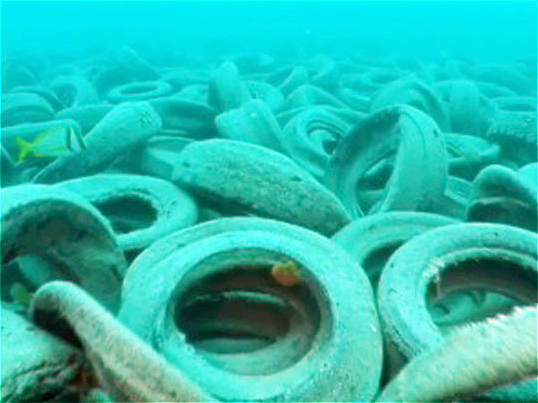
Though many of
the tires were bundled together using nylon and steel bands, no one took into
account the corrosive nature of salt water, and the tires were soon loose. With
constant movement, wildlife never really had a chance to settle in the man-made
reef, and the mess began to expand as the tires migrated. This movement actually
caused damage to other nearby natural reefs, making an already bad situation
much worse. By 1995, Hurricane Opal managed to spread over one-thousand tires
all the way up to the Florida Panhandle, near Pensacola, then, in 1998, Hurricane
Bonnie deposited several thousand of them as far up the U.S. coast as North
Carolina.
Saying, "Enough's enough," several groups decided to clean it up -
or, at least, try. In 2001, Nova Southeastern University filed for a grant of
$30,000 for the National Oceanic and Atmospheric Administration (NOAA) to begin
a tire removal program. Dr. Robin Sherman spearheaded the project, and was able
to remove only 1,600, at an estimated cost of $17 per tire. In 2007, the U.S.
Navy, Army and Coast Guard divers began Operation DiveExEast 07, and only got
about 10,000, spending about $2,000,000. US Army Captain Russell Destremps,
and his 86th Engineer Dive Team, tried again in 2008, and retrieved another
43,000 in just one month. On July 24th of 2009, thirty Army and Navy divers
took on the task of trying to remove what scientists estimated to be 300,000
tires caught against the Hugh Taylor Birch State Park natural reef. They got
a total of 1,400. Finally, in 2015, the state of Florida contracted Industrial
Divers Corporation for $4.3 million, and - by 2019 - had removed an extra 250,000.
Still, it is believed over two-thirds of the destructive trash is still under
the Florida ocean.
Sadly, this is not the only man-made tire reef that failed. Two huge ones were
in Malaysia and Indonesia, which also caused natural reef destruction, as well
as beach pollution. Jack Sobel, the Director of Strategic Conservation at Ocean
Conservancy said in a 2002 interview, "I don't know of any cases where
there's been a success with tire reefs," after their International Coastal
Cleanup removed close to 12,000 tires from beaches all over the globe.
Normally, I'd try to end these pieces on a high note, or even a joke, but this
subject is dead serious. When it comes to fixing the messes we've made, we're
really sinking.
-- June 16, 2021 --
A Story That'll Grow On You
As readers of this
blog may have already noticed, I've posted a number of articles having to do
with plants - from herbage that's nearly extinct, to trees that gave drunks
a hard time. This is kind of a given for me, because I love greenery. I not
only grew up in a home that respected a good garden, I worked in landscaping
for several years. Many a friend has pointed out that I have quite the Green
Thumb, so why not have that spill over onto this blog? Now, since I once wrote
about a tree that was arrested, I should cover the other side of the leaf, and
tell you about two trees that are totally autonomous, each one called "The
Tree That Owns Itself".
The first is a White oak (Quercus alba), known as the Jackson Tree, and
is found at the corner of South Finley, and Dearing Streets, in Athens, Georgia,
USA.

click on image for
larger view
Originally seeded
sometime between 1500 and 1700, the tree grew on the property of Colonel William
Henry Jackson, who was the son of James Jackson (a Congressman, U.S. Senator,
and Governor of Georgia), as well as the father of another James Jackson (a
Congressman, and Chief Justice of the Supreme Court of GA). It is believed Jackson
had such fond memories of being a child playing under the tree, that he decided
to deed an eight-foot squared plot of land the tree grew on to the tree itself.
As the area expanded, properties were bought, and sold, but the section the
oak lived on could not be put up for sale, so no mater the construction, the
tree stayed. Funny thing is, no one knows if any of this is real, or not. Though
the story appeared in a front-page article, titled "Deeded to Itself",
in the Athens Weekly Banner on August 12th, 1890, there is no proof of
the deed - besides local folklore. Still, the municipal government holds to
it, and the tree is respected as being deeded to itself. On October 9 of 1942,
following a lengthy period of decline, the tree fell, but the locals took an
acorn, and grew a new tree. Therefore, the tree that grows there now is actually
"The Son of the Tree That Owns Itself, Which Also Owns Itself". If
you visit the area nowadays, you can spot the tree easily, as it has two stone
tablets at its base, paraphrasing the "original deed".
The other self-governing tree, a Post oak (Quercus stellata) known as
the Walker Oak, is in the next state over to the west, in Eufaula, Alabama.

click on image for
larger view
This sprout's history
is more fact, than legend though. In 1935, the town's mayor himself, E. H. Graves,
gave the tree its own deed. In 1961, that poor sap was hit by a tornado, and
fell. It was replaced by a new one, which also fell two decades later, but another
was planted soon enough, and they too all have deeds to the land. If you ever
find yourself in Eufaula, go to the corner of Highland and Cotton Aves, and
you'll spot the plaque on an iron fence letting you know you're in a real shady
place.
In 1972, biocentrist Christopher D. Stone (son of journalist I. F. Stone), wrote
the paper "Should Trees Have Standing?", which stated that if corporations
are assigned rights, natural objects such as trees should too. I'm glad folks
in Athens and Eufaula seem to agree.
-- June 10, 2021 --
Even More of My New Series of Art Zines
I've been releasing a new line of art zines under my publishing arm of Anima Animus. While Issue 1 was my own work, and Issue 2 was the work of NYC artist Robet L. Pepper, I am now releasing the next three, this July. Issues 3 (Chuck Loose, graphic art), Issue 4 (Liorcifer, tattoo work), and Issue 5 (Thaniel Ion Lee, digital art) will be available soon.



As before, each zine is 5.5" x 8.5" (14 x 20cm), on glossy color pages, with heavy cardstock cover, and will is limited to only 50 copies. They are $10 (postage paid), and are available now for pre-order, with copies shipping in mid-July. You can contact me directly to pre-order, or visit my Etsy shop to see when they're available.
-- June 04, 2021 --
Sham Shaman
I've written about
a few impostors before, such as Grey Owl (Archibald Belaney), but there are
just so many more to cover. Mary Baker was an Englishwoman pretending to be
royalty from an imaginary island, calling herself Princess Caraboo. Iron Eyes
Cody claimed to be of Cherokee-Cree ancestry, and stared in the "Keep America
Beautiful" PSAs of the 70s, but was actually Espera Oscar de Corti, an
Italian American actor. Former Fox News military analyst, Joseph Cafasso, claimed
to have been a highly decorated Special Forces soldier, and Vietnam veteran,
but served in the U.S. Army for only 44 days in 1976.
One of the more interesting impostors was Baltimore, Maryland's Joseph Howard
Lee (1877 - 1947). Not much is known about his early life, other than he grew
up poor as the son of former slaves, and had a number of arrests for homosexual
acts with minors. In 1910, he began dressing only in a sheepskin skirt, with
a large brass ring through his nose, and started going by the name Bata Kindai
Amgoza ibn LoBagola, claiming to be a black Jew from Dahomey (which is now Benin
in West Africa).

In 1911, Lee (as
LoBagola) had been invited by Frank G. Speck, Assistant Curator of General Ethnology
at the Philadelphia Museum (and later founder of the University of Pennsylvania's
Anthropology Department), to perform dances, and other African rituals for Museum
visitors. Speck even interviewed LoBagola, and recorded him singing "African"
songs on wax cylinders, some of which was transcribed, and published, in the
museum's Museum Journal (Vol. II, Iss. 2). During this time, Lee had
some articles published in Scribner's Magazine, where he would tell stories
of his life in Africa. In 1929, still under his pseudonym, Lee produced an autobiography,
LoBagola: An African Savage’s Own Story (released by New York publishing
house A. A. Knopf), and was sold in Europe as The Folk Tales of a Savage.
In it, he confusingly told stories about his life in Africa, yet apologized
for misleading the museum's staff, and admitting he was merely an entertainer.
After he was exposed, just like his early life, not much is known what he did,
or where he went, except that he died of a pulmonary edema in Attica Prison,
while serving eighteen months for petty theft, and is buried on the prison grounds.
I understand that some people have very few avenues to better themselves in
life, and pretending to be someone of higher social standing can lead one to
a better place, but in our current age, there are fewer, more popular phrases
than "fake it, 'til you make it." Still, there's no reason to become
a total phony.
-- May 23, 2021 --
Dig This
There are a number
of archeological discoveries that have stumped scientists throughout the years.
They mostly concern stone sites that don't have any obvious significance, such
as the Diquis Delta spheres of southern Costa Rica, which date to around 600
CE, and are known locally as Las Bolas (translation: "The Balls"),
or the 2000-year-old Nazca Lines of Peru, which were laid out by a pre-Inca
civilization. In Jordan, there is also Khatt Shebib, a 93-mile-long (150 km),
one-meter-high stone wall, and the equally confusing stone enclosures, known
simply as "the Big Circles", which are 400 meters in diameter, date
to 100 CE, and have no gates or openings - with eleven of these cataloged. What
the purpose was for any of these constructs is a guess to any archeologist,
but these are locations that leave a lot to the imagination. The people who
built them are no longer with us, and left no written records of what they stood,
or were built, for.
Now, imagine a culture that is still around in some form, where we have a huge
library of available research material from their past, yet has left behind,
not layouts in stone, but mechanical devices that baffle scientists to this
day. You may think I'm talking about the ancient Greek gadget known as the Antikythera
Mechanism. Though the apparatus was discovered in 1901, and has astounded those
who have studied it since, it was actually scanned with Microfocus X-ray Computed
Tomography (X-ray CT) in 2005, which has recently led to a new model of it,
satisfyingly explaining the contraption (see
that here). Even so, finding only one of these, scientists kind of always
figured it was some sort of astronomical clock; they just didn't have enough
evidence to say with confidence that it was so.
The doohickey I'm going to share here today, not a single person is sure what
the whatchamacallit could have been used for, and over one hundred have been
discovered. Let me introduce you to what are known as the Gallo-Roman dodecahedrons.

These thingamabobs
were first found in 1739, numbering 116 so far, and have been dug up in England,
Spain, Hungary, Germany, France, and - of course - Italy. They are hollow, twelve-sided
(though one twenty-sided icosahedron has been found in Germany), and range in
size from 1.5 to 4.5 inches (4 to 11 centimeters). Not a single word has been
written giving account to what they are for, nor has any drawing of one been
traced. Speculation as to what they are includes: dice; religious artifacts;
survey instruments to estimate distance to (or sizes of) distant objects; fortune-telling
device; coin measure to detect counterfeits; water pipe gauges; and (because
wax was found in two units) a simple candlestick holder. Several dodecahedron
have been found in coin hoards, which lends evidence that the original owners
considered them valuable objects. While the oldest examples of the dodecahedrons
are Roman, a few smaller, gold ones have been discovered in Óc Eo, Vietnam,
and the Pyu city-states of Myanmar.
Though the idea is not popular with archeologists of the day, in 2014, history
enthusiast Martin Hallett speculated that they were actually knitting frames
for creating gloves. He pointed out the knobs could be used to catch wool in
the same as a Knitting Nancy. Still, because of this hypothesis, knitting enthusiasts
have taken to 3D-printing Gallo-Roman dodecahedrons as a way to help them make
gloves.
If you have any guesses as to what these appliances might be, contact your local
museum. Otherwise, keep digging.
-- May 10, 2021 --
Kabloowie!
Nuclear arms are
the most dangerous weapons on Earth, so you'd think nothing in the world would
have more precautions than them. If you think that though, you'd be wrong. There
are numerous safety measures to make sure armaments don't fall into the wrong
hands, as well as hiring leading scientists for when they want to perform tests
with the explosive power of atoms, but even those two dimensions have innumerable
breaches of protocol - whether unforeseen, or from outright absent-mindedness.
As many people know, U.S. Presidents carry a card with warhead launch codes,
known as "the biscuit", and a Presidential aide, who is always by
their side, has (normally handcuffed to them) a briefcase, known as "the
football", to which the codes can be entered to begin a "party at
ground zero". Well, both have been lost several times. Jimmy Carter once
left the codes in a jacket pocket sent to the dry cleaners. Gerald Ford’s
aide once left the football at a Paris peace summit. Bill Clinton once left
his football-carrying aide at a 1999 conference, and then lost the biscuit for
months without telling anyone until he rediscovered it.
The U.S. military doesn't fare that much better when working with bombs, and
we have dropped two nuclear devices on our own country. The first was on March
11th, of 1958, when an 8,000-lbs (3630-kg) atom bomb called Mark 6 was being
transported by Captain Bruce Kulka on a B-47 bomber. When checking the payload,
the Captain accidentally pulled the wrong lever, and the bomb landed in Mars
Bluff, SC. Luckily, the fission core wasn't armed, so - while it exploded, destroying
seven buildings - the damage was nowhere what it could have been. The second
time this happened was January 24, 1961, when a B-52G Stratofortress was carrying
two Mark 39 thermonuclear bombs. The plane lost all of its fuel, and the entire
crew ejected, sending the plane crashing down on Fargo, NC. Both bombs, which
were released from the plane, were armed. Though one deployed an emergency parachute
to land without incident (getting caught in a tree), the other did not, and
plopped onto a mud field. All praise due to the Atomic Gods, an electric switch
had a fault, causing the high voltage charge (needed to ignite the nuclear blast)
to fizzle out.
So... Presidents = forgetful idiots. Military men = bumbling oafs. Then, atomic
scientists = big brains, right? Nope. There have been a number of test failures,
including Operation Plowshare, where the U.S. proposed using nuclear bombs to
widen the Panama Canal, clear a path for a highway through the Rocky Mountains,
and build a harbor in Alaska. Only after detonating over thirty warheads, did
the government realize that, between the amount of radioactive fallout, and
plutonium contamination of drinking water, it wasn't worth it. Even so, that
didn't stop Russia from stealing the idea, and they undertook the Chagan Project,
at the Semipalatinsk Test Site in January of 1965, where they set off 124 bombs
for the Nuclear Explosions for the National Economy Program - all just to build
a huge lake. Sadly, the water is still radioactive to this day, and is called
"Atomic Lake" by the locals.
Computers aren't much help sometimes either, especially when you add in a human
touch. On the 9th of November, in 1979, warnings erupted at the North American
Aerospace Defense Command (NORAD), and the U.S. Pentagon, shouting that the
country was under attack. Data indicated that a whopping one-thousand Soviet
missiles were flying towards major cities in the United States. Pilots scrambled
to intercept, and the President was readied to retaliate. Six minutes later,
reports came in that nothing was being detected on radar or satellite. Turns
out, it was a false alarm, because a low level cadet accidentally uploaded a
training simulation to the wrong computer.

click on image for
larger view
I hope this read hasn't been too scary, but do know that there are currently 13,000~ nuclear warheads, managed by only nine countries - some of which don't get along. Though it's only been three-quarters of a century since there have been atomic weapons, these instances (plus the ones I haven't gone into) are actually a bit frightening. Still, I'll give a god damn atomic wedgie to the first person that says, "You can't hug a child with nuclear arms!"
-- April 28, 2021 --
When Publicity Stunts Your Growth
There's an old
adage that "All press is good press," but that's not even close to
being true. Sometimes, press gimmicks can go horribly wrong, and some even wind
up costing a company way more than they bargained for.
There have been some great ones, like when Red Bull sponsored (and broadcast)
Felix Baumgartner breaking the sound barrier by free-falling twenty-three miles
from the stratosphere, in 2012; when Eichborn Publishers attracted visitors
at the Frankfurt Book Fair to their stand by attaching tags on houseflies listing
its name and booth number; or the April Fools' Day prank by Taco Bell buying
the U.S. Liberty Bell, and renaming it "Taco Liberty Bell".
Still, for every dozen wild PR campaigns that work, there's one or two that
not only fall flat, but get nothing but trouble in return.
In 2006, LifeLock CEO Todd Davis, was so confident that his company could protect
a paying customer's identity, they posted his social security number in tv commercials,
and on billboards, to prove how good their service worked. While there were
87 failed attempts, thirteen were successful, with one opening an AT&T Wireless
account (racking up $2400 in charges), and another getting a $500 loan at a
check cashing place. Those antics forced the Federal Trade Commission to fine
the company $12 million, in 2010, for deceptive advertising.
It's not always a corporate fail either, as the U.S. Department of Defense thought
it would be a great idea to fly a Boeing 747, flanked by two F-16 fighters,
really low around Manhattan eight years after 9/11, all for a photo shoot. Another,
was when Taylor Swift held an online competition in 2012 to which she would
perform a free show at whatever school got the most votes. 4chan and Reddit
users skewed the results to where the winner turned out to be Boston's Horace
Mann School for the Deaf.
Since I just mentioned Boston, one grand fiasco - now known as the "2007
Boston Mooninite panic" - was on account of Cartoon Network. As part of
a nationwide guerrilla marketing campaign for the Adult Swim movie Aqua Teen
Hunger Force Colon Movie Film for Theaters, artist Peter Berdovsky (aka
Zebbler) and marketing firm Interference, Inc., placed LED displays of an Aqua
Teen Hunger Force character called a Mooninite, all around Boston, Cambridge,
and Somerville.
These displays
were mistaken by local idiots as possible improvised explosive devices. Both,
the Boston Police Department, and Fire Department, were called to remove several
of the displays, two people were arrested (though charges were later dropped),
and CN's parent company, Turner Broadcasting, was fined two million dollars.
And, now
that I'm on the subject of bombs, let's get into one of the worst promotional
ideas ever. While the pervious one was a mistake, this publicity stunt was quite
intentional. In 2012, filmmaker Nathan Todd thought the best way to promote
his movie, A Belfast Story, which was set in an Ireland still marred
by terrorist violence, was to send promo packs to movie reviewers containing
bomb making materials, including a bag of nails, duct tape, and even a balaclava.
Chris Hewitt,
of Empire Magazine, called the press kit "the most distasteful freebie
ever." The gimmick failed so badly, many writers refused to see, or review
the film.
Well, you win some, and you lose some. Hopefully, none of your ideas are as
bad, or at least don't cause as much damage as these. Promote yourself, just
run it by others first. If jaws drop, you may want to rethink things. If you
decide to still go through with it anyway, make sure you document it, so we
can all get a good laugh out of you later.
-- April 16, 2021 --
Suckers, They Come A Dime A Dozen
We are living in
an age of crisis, inequality, and absurdity, and many are pointing the finger
for these injustices at late-stage Capitalism. There may be no greater proof
of this than the commodification of status, best expressed by the rise of social
media influencers, and YouTube stars, where every living moment is a gimmicky
ploy to sell something. Here, the wertausdruck is related to your clicks
and views, and it doesn't matter if it's an Instagram model holding a bottle
of the newest volcanic-gas-infused water in her latest pic, someone calling
themselves an indie blogger suddenly promoting the newest Hollywood blockbuster,
or a leftist YouTube theorist interrupting their video on the Marxist critique
of societal norms with a paid promotion for the newest earbuds.
Well, we've all become familiar with the online prankster getting interrupted
by the law, during one of their malicious performances, and hearing them utter
the excuse, "It was just a social experiment," but there are times
when the script is flipped, and they become the unwitting dupe themselves.
In one case, YouTuber Josh Pieters, and magician Archie Manners, felt reality
tv stars want to be on tv so bad, and that they would say anything if paid to
do so. So, they hired Yazmin Oukhellou, and Bobby Norris, from The Only Way
is Essex, Alfie Best from Absolutely Ascot, and Hayley Hughes from
Love Island, to appear on a fake tv show, titled Technology from the
Future. The stars were asked to read fake news stories stories, including
one about leaving fridge doors open to combat climate change, a charity that
taught African children how to ski called AfroSki, and the invention of time
travel. Pieters told Insider that they tried to drop hints of their intentions
to the players, saying, "You can't be complete fraudsters, and there has
to be breadcrumbs along the way that give them a fair chance, but that makes
it all the more thrilling when we pull it off." He claims not even their
agents questioned the producers' motives.
Another great case was when the shoestore Payless, opened a fake boutique, calling
it Palessi. The chain hired the promotional company DCX Growth Accelerator to
invite hundreds of influencers to the store's opening. Stocking the shelves
with their standard fare of $20 shoes, and $40 boots, they asked those who showed
up how much they would pay for this new designer brand. Many partygoers praised
the footwear's style, material, and craftsmanship, admitting they would pay
hundreds of dollars for them, with one guessing the shoes had to cost close
to $700. Chief creative officer of DCX GA, Doug Cameron, said, "Payless
wanted to push the social experiment genre to new extremes, while simultaneously
using it to make a cultural statement," and I think they succeeded.

The last example
I'll give is the scariest of them, and it was when the BBC did an expose, for
their show Blindboy Undestroys the World, on how influencers would promote
anything, so long as they were compensated. The investigation focused on three
British social media hacks, Lauren Goodger, Mike Hassini, and Zara Holland,
who have a combined fanbase of 1.3 million followers. They were asked to help
spread the word about a new diet drink, Cyanora, which was "a classy new
weight-loss drink that contains everything you need to shed those horrible,
ugly pounds," including the poison hydrogen cyanide, and no one batted
an eye. When told they would have to promote it before actually trying it, they
all agreed to. At the auditions, all three were given a script that clearly
mentioned cyanide a number of times, including the line, "If you want to
boost your weight-loss, try Cyanora, which contains all-natural extracts: calamine,
magnesium, lemon balm, red clover, and hydrogen cyanide." Hassini
even commented, "From what I know, that all looks pretty natural."
I'm not one to promote suicide, but if you base your life around what social
media influencers tell you, maybe you should chug a bottle or two of Cyanora.
-- April 01, 2021 --
You're Nobody's Fool
Can you tell today's
a special day for me? To regular readers of this blog, it might be obvious.
I enjoy posting entries about hoaxes, as well as a number of April Fools' Day
pranks. I also like posting a bit of history before diving into the main subject,
and many might think that today's lesson is a bunch of bullshit, given my April
1st track record, but - I assure you - this is no joke. Well, not yet, anyway.
April Fools' Day started in France in 1582. Though the Council of Trent decided
to switch Europe over from the Julian calendar, to the Gregorian calendar, in
1563, the French didn't get around to it until almost twenty years later. Like
the Hindu calendar, the Julian method of counting down the days had the New
Year ringing in on the Spring Equinox, which many just placed on April 1st.
The "fools" who didn't know this, had paper fish taped to their unsuspecting
backsides, and were called "poisson d’Avril" (or "April
fish"). It is thought by some scholars that this new tradition was incorporated
into European culture to sort of wash away the Roman celebration of Hilaria,
which is Latin for "the cheerful ones", and was an equinox festival
to honor Cybele, where participants would mourn, whip themselves, and perform
not-very-cheerful rituals of castration. By the 18th Century, the practices
surrounding what we now know as April Fools' Day, spread to the U.K. where it
took a real hold. So much so, that authors (such as Jonathan Swift), and newspapers
would get in on it. By the time television came around, they joined in with
glee, and the first known broadcasted prank was pulled by the BBC, in 1957.
Known as the "spaghetti-tree
hoax", The British Broadcasting Corporation ran a three-minute fake report
on their current-affairs program Panorama, on April 1st. The segment
showed a family in Switzerland harvesting strands of the pasta from a "spaghetti
tree" farm. The idea came from cameraman Charles de Jaeger, who remembered
how the teachers from his youth in Austria would tell kids that they were so
dumb, they'd believe spaghetti would grow on trees, if told so. Panorama
editor, Michael Peacock, loved the it, and gave Charles a £100 budget
to produce the skit. They then hired respected broadcaster Richard Dimbleby
(who also loved the idea), which gave the piece believability. An estimated
eight-million people tuned in, with hundreds of idiots phoning in the next day
to ask if the story was real, or for more info on how they could cultivate spaghetti.
Operators at the BBC were told to reply with: "Place a sprig of spaghetti
in a tin of tomato sauce, and hope for the best."
Well, I made it through a whole April Fools' Day post on April Fools' day, without
fooling anyone. Like Abraham Lincoln once said, "You can fool all the people
some of the time, and some of the people all the time, but you cannot fool all
the people all the time." Except he never actually said that, so as weak
as it was, "April Fools!"
-- March 21, 2021 --
A Salute To Animals
It's not odd for
an army to have animals trained for use in warfare. It may be cruel on many
levels, but not odd. Greek and Romans had Molossian Mastiffs as fighting companions,
elephants used in combat are mentioned in Sanskrit hymns dating to 1,100 BCE,
pigeons were valued for communication in 20th Century wars, and horses have
been tasked with mounted combat, and pulling chariots, as far back as written
records go. What might be considered a little odd are animals receiving rank.
It could be weird for a lowly Private to have to answer to Sergeant Fido, but
that is the case for some military personnel. There are animals who hold (or
have held) the position of an officer.
First, I'll start with the obvious ones: canines. Dogs have the highest number
of ranked animals, and why not? They are truly mankind's best friend. Pups have
done everything from fight in battles, to serve as mascots. Sergeant Major Jiggs
was one of the first dogs to receive rank, and was the original Marine Corps
bulldog mascot, as his owner was Major General Smedley Butler. Jiggs began his
career in 1922 as a private, and advanced to the rank of E-9.

There's also Sergeant
Major Fosco, who was one of the first military dogs to complete an airborne
jump; Chief Dog Sinbad, an enlisted member of the U.S. Coast Guard for 11 years
(and saw combat during World War II); and Sergeant 1st Class Boe, Sergeant 1st
Class Budge, and Master Sergeant Maverick, who were all trained therapy dogs
for veterans. Interestingly enough, when a canine receives a rank, they are
always given one rank above their handler as a reminder that they are to be
respected.
Next up are equine, such as Staff Sergeant Reckless, who was a Marine pack horse
in the Korean conflict. She carried supplies and ammunition for the Marines
of 5/1 Recoilless Rifle Platoon, and once made fifty-one, unguided solo trips
for supplies, as well as bringing wounded men to safety. The horse has received
two Purple Hearts, and a Good Conduct Medal. Plus, there's a long line of Master
Sergeant mules named Big Deuce, the Army's official donkey mascot for the 2nd
FA Battalion "Mule Soldiers" out of Fort Sill, OK. On a rather strange
side note, Master Sergeant Big Deuce VI got demoted twice for attempting an
AWOL, and assaulting the officer in his command.
A funny addition to this list are goats. Sergeant Short Round is the Army's
goat mascot, who accompanies Big Deuce. The most recent being Short Round VI,
who had her enlistment ceremony at Fort Sill, in 2018. There is also Lance Corporal
Billy Windsor, a member of the British Army in the Royal Welsh Regiment, who
must be saluted by subordinates. Like Big Deuce VI, he was demoted in 2006 after
head-butting the drummer of the 1st Battalion.
Lastly are my two favorites, Nils Olav, and Wojtek.
Nils Olav is a badass King Penguin, who is Visekorporal (Lance Corporal), as
well as official mascot of Norway's Royal Guard. On August 15, 2008, that beautiful
bird was knighted by the Norwegian King's Guard, and was so approved by King
Harald V.
Wojtek was a Syrian brown bear, adopted by Polish II Corps soldiers during a
stop in Iran. The Polish army had him retrieving ammunition, during the 1944
Battle of Monte Cassino, in Italy. For his bravery, and loyalty, he was given
the rank of Private, but greater rewards lay ahead, as he was was given to Scotland's
Edinburgh Zoo, and not only lived lavishly, has five bronze statues made of
him (three in Poland, and two in Scotland), plus a memorial plaque in Britain's
Imperial War Museum.
This goes to show that animals not only play an important part in the natural
environment, but in human history, so please be kind to our furry fellows.
-- March 16, 2021 --
New Series of Art Zines
This Spring Equinox, March 20th, I'm releasing a new line of art zines under my publishing arm of Anima Animus. Each zine will feature a new artist, with Issue 1 and 2 being released together (though sold separately).


Issue 1 is my own
work, and is a mailart collection I did in 2012, titled Special Delivery.
Issue 2 is the work of Robert L. Pepper, and compiles two separate art series
he's done, titled Cotton Fetish.
Each zine is 5.5" x 8.5" (14 x 20cm), on glossy color pages, with
heavy cardstock cover, and will be limited to 50 copies. They
are $5 for Issue 1 (postage paid) / $10 (postage paid) for Issue 2 and beyond,
and are available now for pre-order, with copies shipping on the Equinox. Issues
3 and 4, featuring the work of artists Chuck Loose, and Thaniel Ion Lee, respectively,
will be available on the Summer Solstice.
You can contact me directly to
pre-order, or visit my Etsy
shop to order
on, or after March 20th.
-- March 08, 2021 --
Leaf Them Alone
A lot of people,
myself included, were pretty freakin' sad when the last male white rhinoceros
(Ceratotherium simum cottoni), who was named Sudan, died in 2018, at
the Ol Pejeta Conservancy in Laikipia, Kenya. Though survived by his daughter,
Najin, and his granddaughter, Fatu, once they're gone, mankind will witness
the complete extinction of a species. It's not the first we've committed, and
it probably won't be the last. Many other animals may soon follow, such as the
North Atlantic right whale (~400 left), Tooth-billed pigeon (~300), Gharial
crocodile (~200), Kakapo ground-dwelling parrot (~150), Amur Leopard (~60),
and the Vaquita dolphin (less than 20).
While that's depressing enough, there's one lifeform on Earth that has some
species facing annihilation, with few people talking about it, though we can't
live without them: plants. Whether it's deforestation for construction, over-logging,
over-expanding farmland, or the introduction of invasive animal species that
wound up over-grazing, we have laid waste to certain areas of the world. With
that, we have killed off a number of plant species that many not come back from
the brink of elimination.
One such plant is Bois Dentelle aka Wood Lace (Elaeocarpus bojeri). It
grows on the tiny island nation of Mauritius, just east of Madagascar, and there
are only two known specimens left. Since the plant has no economic value, its
environment has been overrun through the farming of commercially-attractive
nonnative species, like the Guava tree.
There's also New Zealand's Three Kings Kaikomako (Pennantia baylisiana).
Discovered in 1945, by Professor Geoff Baylis of the University of Otago, the
plant grows only on the north face of Great Island, in the Three Kings group,
off Cape Reinga. There is only one known plant in the wild. Efforts to save
the plant's seeds have been successful, and a few have been propagated within
nursery conditions.
Lastly, we have Wood's Cycad (Encephalartos woodii), which has no known
specimens in the wild. The last known survivor of this plant species was a male
plant found in the oNgoye Forest of KwaZulu-Natal, South Africa, in 1895, by
John Medley Wood, who was the curator of the Durban Botanic Garden, and the
director of the Natal Government Herbarium of South Africa.
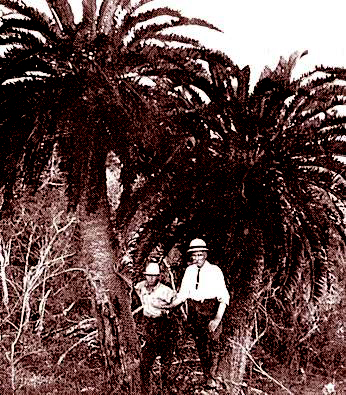
The plant (which
was a cluster of four stems), was uprooted, and replanted in Kew Gardens in
1899. Three of the stems were then removed in 1903, and planted in Wood's Durban
Botanic Gardens. One of those three stems was later transplanted at the National
Botanic Gardens of Ireland in 1905. Since the original was a male plant, all
plants in botanical gardens today are clones of the original Cycad, as no seeds
can be produced by the male. If you want one, you will have to obtain the required
permits from South Africa's Nature Conservation to either move, buy, sell, donate,
receive, or cultivate it.
Other known plant species which are now endangered are Yemen's beautiful Dragon's
Blood Tree (Dracaena cinnabari), the Choje Tree (Aloe dichotoma)
from South Africa, Brazil's Candelabra Tree aka Parana Pine (Araucaria angustifolia),
and the amazing-looking Monkey Puzzle Pine, which is Chile's national tree,
and has been found in the fossil record dating back to 200-million years.
I know many folks today see conservation efforts to be fruitless, as well as
a little fruity by burly, manly men who'd rather fight you than try to understand
you, but - still - please do whatever's best for our planet. You may not realize
it, but you will be helping generations-upon-generations to come.
-- February 26, 2021 --
Me Right Good Enough, Write?
I always wonder
if my poetry, and prose, is up to par. I'd hate to be fooling myself, and find
that - in actuality - I'm seen as a joke among my literary compatriots. Worse,
I'd hate to think that a hundred years from now, libraries collect my work simply
because it's so god awful. If you can't tell: I'm not of the school of thought
that believes it's better to be remembered for the wrong reasons, than to be
forgotten entirely.
I would rather burn everything I've ever set to paper (or hard drive), than
be seen as a modern-day Anna Margaret Ross. Better known by her pen-name, Amanda
McKittrick Ros, she is considered by a number of critics to have written some
of the worst novels, and poetry, ever.

McKittrick was
born in Drumaness, Ireland, on December 8, 1860, as the fourth child of the
Principal of Drumaness High School, Edward Amlave McKittrick. She enrolled in
Dublin's Marlborough Teacher Training College in the 1880s, and was appointed
Monitor at Millbrook National School, later becoming a qualified teacher there.
Anna married a 35-year-old widower, Andrew Ross in 1887, and he financed her
first novel, Irene Iddesleigh, as a ten-year anniversary present. She
continued writing, and published two more novels (Delina Delaney in 1898,
and Helen Huddleson, released posthumously in 1969), and two pamphlets
of poetry (Poems of Puncture in 1912, and Fumes of Formation in
1933). Her work was ironically enjoyed by Mark Twain, Aldous Huxley, and C.
S. Lewis. Twain said Irene Iddesleigh was "one of the greatest unintentionally
humorous novels of all time", and humorist Barry Pain called it "the
book of the century", while at the same time writing that he "shrank
before it in tears, and terror." This didn't matter to Ross, as she thought
her critics were too unsophisticated to appreciate her work. She believed that
a "million and one who thirst for aught that drops from my pen", and
predicted she would "be talked about at the end of a thousand years."
If you are curious as to how bad her writing is, but don't want to read an entire
novel, this is a line from her last book: "She had a swell staff of sweet-faced
helpers swathed in stratagem, whose members and garments glowed with the lust
of the loose, sparkled with the tears of the tortured, shone with the sunlight
of bribery, dangled with the diamonds of distrust, and slashed with sapphires
of scandals." Never mind that everyone in that volume had a fruity surname;
Lord Raspberry, Cherry Raspberry, Sir Peter Plum, Christopher Currant, the Earl
of Grape, Madame Pear, and so on. Want more? This is the opening line from her
first novel: "Have you ever visited that portion of Erin's plot that offers
its sympathetic soil for the minute survey and scrutinous examination of those
in political power, whose decision has wisely been the means before now of converting
the stern and prejudiced, and reaching the hand of slight aid to share its strength
in augmenting its agricultural richness?" Boy, oh boy.
Luckily for AMR, she died in 1939, and didn't live to see The Oxford Companion
to Irish Literature described her labor as "uniquely dreadful".
Still, the Belfast Public Library holds a collection of her manuscripts, and
first editions; Irish playwright, Denis Johnston, wrote a BBC radio play about
her, which aired in July of 1943; a biography was published in 1954, titled
O Rare Amanda!; a collection of her most memorable passages was published
in 1988, as Thine in Storm and Calm; in 2007, her life was honored at
the Belfast Literary Festival; and, in 2013, Irene Iddesleigh became
available in a modern edition.
Well, maybe it's not so bad to be remembered as bad writer, and I may just begin
to set my keyboard afloat on that whimsy tide of perpetual remembrance, after
I sway into the ether at such time of my passing, unto the great beyond, so
emboldened by the heavy fingers that hit keys, setting down my thoughts, as
I delight at visions of a future I will not get to see, but can imagine with
great jubilation within a mind exhilarated by frivolity.
Scratch that! I'm good.
-- February 19, 2021 --
An Uncanny Valley
I am extremely proud to announce that my newest book, This Hidden City, will be available for purchase next month.

Are you visiting
New York City any time soon? If so, you will certainly want to carry this book
with you. Sixty-three entries, covering all five boroughs (plus two islands),
mentioning over 200 sights and sites you have to see in the city that never
sleeps - complete with photos, and maps. Weird art, odd locations, bizarre history,
and morbid landmarks very few visit, or even know about. This is a must for
anyone who loves the extraordinary, and New York City.
The book will be $25 with postage paid. You can contact
me directly to pre-order, or visit my Etsy
shop to order when released.
-- February 13, 2021 --
Do the Hustle
Back in 2013, I
got an email from a Nigerian scammer. I wrote back that I knew what he was up
to, and asked a few questions that peaked my interest. I was surprised that
they wrote back, answering my questions pretty honestly, and we exchanged emails
for about a week. I've have always been fascinated by the subject, but more
about the scammed side, rather than the scammer. I've always understood the
scammer, whether it's because I grew up around a criminal element, or was so
poor that I sympathize with anyone trying to better their life, no matter how
they go about it.
Now, in 2021, the Nigerian scammer seems to most people to be more myth, than
reality. Well, I have news for a lot of folks. Not only do they exist, the heights
they often strived for were lofty, and sometimes they reached them. In one case,
they sold an entire airport for millions.
Emmanuel Nwude was once the Director of Union Bank of Nigeria, until he decided
he didn't make enough in that position. In 1995, Nwude impersonated Paul Ogwuma,
who was the Governor of the Central Bank of Nigeria at the time.

He reached out
to a number of investors for the construction of a new airport in Nigeria's
capitol city of Abuja. Nelson Sakaguchi, a Director at Brazil's Banco Noroeste,
took the bait. Emmanuel hired five accomplices (four men, and one woman) to
act out different players in this game for a whole year. They finally convinced
Sakaguchi to invest $242 million dollars of his bank's assets ($191 million
in cash, and the rest in outstanding interest), which the scammers placed in
a Cayman Islands bank account. Knowing such a huge sum might attract prying
eyes, they wanted to let it sit for some time, and live off a smaller amount,
so they asked Nelson for $10 million as a commission fee for the transaction,
which he paid. Though the funds were granted, one of the co-conspirators grew
paranoid, and began to talk, so he was executed. Still, life was good for the
crew after their heist, until December of 1997, when the São Paulo bank
was taken over by Madrid, Spain's Banco Santander. During audit, the new owners
found that two-fifths of Banco Noroeste's total value, and half of its capital,
was sitting in an unmonitored Caribbean bank account. Further investigations
discovered Sakaguchi didn't even ask to see blueprints for the supposed airport.
It took a whopping three years to uncover everything, and charges could be filed.
By 2002, former Nigerian President Olusegun Obasanjo requested the Nigerian
Parliament to set up the Economic and Financial Crimes Commission to prosecute
such offenses. Emmanuel Nwude, plus the four remaining collaborators, were all
arrested in February of 2004, and charged with 86 counts of "fraudulently
seeking advance fees", as well as 15 counts of bribery by the Abuja High
Court. Judge Lawal Gumi threw the case out in July of that year, but everyone
was re-arrested, and the case was brought to the the Lagos High Court. After
weepy testimony from Sakaguchi, Nwude decided to plead guilty in hopes of a
lighter sentence. All the scammers received 25+ years in prison, and $10 million
in fines.
All didn't end well for everyone involved. The owners of Banco Noroeste, the
Simonsen and Cochrane families, paid the $242 million bill themselves, and -
even then - the bank collapsed in 2001. Emmanuel Nwude was released in 2006,
and filed a lawsuit asking for some of the funds to be returned to him, as he
claimed a few million of it was his before the scam. Though he reclaimed $52
million, he was arrested in 2016, and charged with being the ring leader of
a terrorist attack on the Nigerian town of Ukpo, which killed one. Though he
was released on bail in 2018, he was voted in as the President General of the
Ugbene town union.
I hope this is a lesson to everyone out there that no scam is too big, or too
small, and anyone can be duped. If you need further proof, send me $1000 via
bank transfer, and I will provide more proof.
-- February 02, 2021 --
Video Games Be Illin'
One way to study
how epidemics turn into pandemics are computer simulations. Scientists at organizations
such as the Institute for Theoretical Biology at Humboldt University of Berlin,
the Center for Systems Science and Engineering at Johns Hopkins University,
and the Laboratory for the Modeling of Biological and Socio-Technical Systems
at Northeastern University are using a plethora of processes, like predicting
commuting patterns among census populations, person-to-person transmission estimates,
and modeling results of changes in public behavior, including government action.
Well, while there is no set method for computational forecasts, or predictive
mathematical models, one such system that's gaining traction in the study of
infectious diseases are "massively multiplayer online role-playing games"
(aka MMORPGs), and more specifically: World of Warcraft.

The popular 2004
game from Blizzard Entertainment received notice from the field of medicine
after three outbreaks within the game; two unintentional, with the middle one
being purposeful.
The first
instance happened in September of 2005, when the game developer introduced a
new raid, called Zul'Gurub. Within it, the final boss, Hakkar the Soulflayer,
would cast a point-draining debuff spell, called "Corrupted Blood",
when players attacked. If hit, this debuff was supposed to last only a few seconds,
and within the confines of the raid sector. Unknown to the designers, it was
highly contagious, as an oversight allowed pets to become corrupted, and carry
the effects of the spell outside of the intended area, killing off low-level
players with ease. For a whole week, it changed game play drastically, as many
attempted to stay away from the infected, while a few purposely tried infecting
others. It was finally eliminated, when the company released a combination of
patches, and performed a few hard resets of the virtual world.
Then in October of 2008, to promote the second World of Warcraft expansion,
Wrath of the Lich King, Blizzard released a virtual infection, which
they dubbed "the Great Zombie Plague of '08." It differed from "Corrupted
Blood", as it didn't have the 100% transmission rate, and was only mildly
contagious. Even so, once the product hype was done, the company ended it on
the 28th of the month, with a pre-designed kill patch.
The last virtual disease only lasted for one day, and was known as "Green
fire". On January 12, 2017, a status effect debuff, called "Burn",
started in a final boss area, and was - again - released by a pet. It too killed
off low-level players within seconds, and had to be fixed by the company with
a hotfix engineering update.
The first to notice the importance of these virtual outbreaks, came a little
after the 2005 episode, when epidemiologist Ran D. Balicer from the Ben-Gurion
University of the Negev in Beersheba, Israel, published a 2007 article in the
journal Epidemiology, describing similarities between the game's epidemic,
and the then-recent SARS, and avian flu eruptions. It was soon followed by Tufts
University assistant research professor of public health Nina Fefferman, who
called for research on the incident in August of that year. She gave lectures
at Baltimore, MD's Games for Health conference in 2008, and the 2011 Game Developers
Conference about how MMORPGs could help solve problems within already established
traditional models.
This event even helped studies in other fields, as Deputy Director of the Center
of Terrorism and Intelligence Studies, Charles Blair, believed the World
of Warcraft incident could provide powerful new ways to look at how terrorist
networks form, and operate, though Blizzard stated in a 2019 Wired article
that World of Warcraft is "first and foremost a game, and that it
was never designed to mirror reality, or anything in the real world."
No matter where you find yourself in these times, whether in the virtual world,
or IRL, please remember to wash your hands, social distance, and wear a mask.
Until they get this whole mess straightened out, it's the least you can do.
I don't want to have to go through a hard reset.
-- January 19, 2021 --
Fake (Music) News
There are a number
of bands out there that have pulled off half-decent hoaxes: Platinum Weird,
a musical collaboration formed in 2004, whose releases were promoted as being
recorded in 1974, and the black metal band Ghost Bath, who claimed to be from
China, but were actually from North Dakota. Very few gain a lot of traction,
and the joke is exposed rather quickly, but some actually take off - whether
people are let in on it, or not. One of which would be The Masked Marauders.
In the October 18, 1969 issue of Rolling Stone, editor Greil Marcus -
being sick of the "supergroup" trend of the time, and inspired by
a double album of unreleased Bob Dylan recordings, titled Great White Wonder
(often credited as the first bootleg) - decided to write up a hoax under the
pseudonym T. M. Christian. With the collaboration of record reviewer Bruce Miroff,
they created a review of a nonexistent double record, which supposedly captured
a secret session of leading rock musicians, including Bob Dylan, John Lennon,
Mick Jagger, and Paul McCartney. They claimed the recording was produced by
Al Kooper, in a small town near the Hudson Bay Colony in Canada. The piece contained
lines such as:
"Dylan shines on Side Three, displaying his new deep bass voice, with 'Duke
of Earl'."
"Paul showcases his favorite song, 'Mammy', and while his performance is
virtually indistinguishable from Eddie Fisher's version, it is still very powerful,
evocative, and indeed, stunning. And they say a white boy can't sing the blues!"
"It can truly be said that this album is more than a way of life; it is
life."
Calls and letters poured into the magazine. Fans were asking how they could
find it, as well as distributors wanting to carry it. So what's the next logical
step? Put the damn thing out! Marcus, and another Stone editor, Langdon
Winner, hired the Berkeley, CA act The Cleanliness and Godliness Skiffle Band
to play it out in the studio. After recording three tracks, M & W leaked
the tapes to local radio, and then started looking for labels to release it.
A bidding war began, and Warner Bros won, with a $15,000 advance. The label,
under the name Deity Records, released a single disc, self-titled LP, in November
of that year; selling more than 100,000 copies, spending 12 weeks on the Billboard
album chart, and peaking at No. 114.

Buyers were only
let in on the ruse when they opened the record to find a reproduction of the
review, with added remarks from critic, and Rolling Stone cofounder,
Ralph J. Gleason, declaring the joke a "delightful bit of instant mythology."
The dream was further dashed on the album's last track "Saturday Night
at the Cow Palace", which also made it clear it was all a gag.
In 2003, Rhino Records (under its Handmade label), remastered the record, and
released it as The Masked Marauders - The Complete Deity Recordings,
in a limited edition of 2,000 copies. It contained the same track listing as
the original LP, but had the additional song "I Can't Get No Nookie".
Have a listen...
So, let this be a lesson to everyone! If you think you shouldn't take a joke too far, remember that you can at least take it all the way to the bank.
-- January 05, 2021 --
Happy New Fear!
2020 is finally
over, but a change in calendar doesn't mean much to the progression of historical
events. In fact, not much will change, but do know that a few of our hardships
connected to the Novel Coronavirus pandemic will be over soon enough, as the
new vaccines reach around the world. Still, the last year was a testament to
those who research the spread of diseases, but also a challenge for the ones
that study mass hysteria, and crowd psychosis (such as people affected by belief
in a "Plandemic", or QAnon) - what they now call Mass Psychogenic
Illness.
Throughout the narrative of the human saga, plenty appearances of mass sociogenic
disorder have popped up, and some may have even been the foundations for certain
religions. When I was a lad, schools taught the Salem Witch Trials of the early
1690s were a simple mistake by uneducated people. Nowadays, they're handled
as a serious case study in group delusion. While most everyone is familiar with
that situation, there are a bunch of others that are as interesting, as they
are baffling.
In Strasbourg, Alsace (which is now modern-day France), there was a crisis of
what became known as The Dancing Plague. In July of 1518, one woman began dancing
in the street, and when asked to stop, she refused, saying she could not, even
if she wanted to. Within days, it was recorded that somewhere between 50 and
400 people were stricken with the impulse to dance wildly in public - many of
them for days on end. Though it's often stated that a number of them danced
until their death, no evidence of any fatality exists.
Another really interesting incident happened for only several minutes on October
13, 1917, in Fátima, Portugal. An estimated 30,000 and 40,000 people
gathered due to three shepherd children (Lúcia Santos, and Francisco
and Jacinta Marto) claiming the Virgin Mary would appear, and perform miracles
that day. Instead, witnesses said the sun "danced" and zigzags across
the sky, until it finally appeared as if it was descending upon the crowd, causing
some to panic. Many stated they did not see the sun move at all, but it blasted
radiant color rays, while a whole bunch said they saw nothing at all out of
the ordinary.
A little more recently was 1962's Tanganyika Laughter Epidemic in Tanzania,
Africa. There, in January of that year, three unnamed girls broke out into a
fit of laughter at a boarding school for girls aged twelve to eighteen. By the
end of the day, 95 (of the 159 students) were also cracking up, and this lasted
for up to sixteen days. By March, it had spread to nearby Nshamba, and then
Ramashenye Girls' Middle School, in Bukoba, strickening 48. It took a year and
a half for it to completely die off, and it afflicted over 1000 people.
Many of these occurrences happened from one person being in contact with another,
but there are cases where epidemic hysteria was spread via mass media. In 1997,
over 700 children in Japan were rushed to hospitals after the airing of the
"Denno Senshi Porygon" episode of the Pokemon cartoon. It was
believed that flashing lights in that particular show brought on flu-like symptoms
in kids who may have had very mild forms of epilepsy, but nothing of substance
was proven. Again, in 2006, after a Portuguese soap opera Morangos com Acucar
("Strawberries with Sugar") aired
an episode where a deadly virus spread throughout the characters’ school,
viewers began to exhibit symptoms matching those of the fictional virus.
Coming into this New Year, we've now established with certainty that many diseases
evolved from poor hygienic interregional contact between animals, and humans,
as many outbreaks have had similar modes of transmission. Yet, we may never
truly understand how one passes a psychosomatic illness to another. I just hope
we don't treat it like many other mental illnesses, and simply ignore it.
Here's to your health!
-- December 21, 2020 --
Stealing the Stars (and A Director, Too)
For a time there,
when you wanted a fresh take on a story, or watch a film that might blow your
mind, you'd pop on a movie from Japan. Around the early '00s, I had started
telling people that South Korea was "the new Japan" when it came to
motion pictures. Barking Dogs Never Bite, A Tale of Two Sisters,
(the original) Old Boy, Memories of Murder, and Natural City
were some of my favorites from that time. More recently, we have Parasite,
I Saw the Devil, Train to Busan, and The Wailing. All of
these are great features you should check out, and cheers to South Korea for
being recognized as a powerhouse in the film industry, but what about their
brothers to the north? Yeah, North Korea makes moving pictures, too.
The Communist nation of North Korea, or the Democratic People's Republic of
Korea, started their cinema library with a modest film in 1949, My Home Village
(directed by Kang Hong-sik), only one year after its division from what became
known as South Korea. The country released a little over a dozen flicks until
1966, when Kim Jong-il joined the Propaganda and Agitation Department, and then
became director of the Motion Picture and Arts Division. He felt the nation's
cinematic style was flat and a bit lifeless. He revamped production, and -in
1972- his feature Flower Girl won the Prix Special at the Karlovy Vary
International Film Festival. Still, this was small potatoes to what Jong-il
believe his country's movie studios could produce. He didn't feel any local
directors could handle his vision, and most involved in film elsewhere were
banned from taking part due to U.S. embargoes, so Kim did what any normal, film-lover
would: kidnap a bunch foreign greats to do his bidding.
In the late 70s, Choi Eun-hee was one of South Korea's most famous actresses,
so KJ set his sights on her, and she was snatched while on a visit to Hong Kong
in 1978. Next up was her ex-husband, director Shin Sang-ok, who was known as
"The Prince of South Korean Cinema". He was caught when he visited
Hong Kong to investigate Eun-hee's disappearance, as fingers were being pointed
at him for her possible murder. The following year, Choi and Shin were forced
to remarry. After a few years, North Korea's MPAD finally got them to work,
starting with 1984's An Emissary of No Return, based on a play from the
country's first leader Kim Il-sung, titled Bloody Conference. Though
CE acted in three movies for the dictator, and SS directed six for him, they
only worked together on one, Salt (1985), which Choi won Best Actress
for at the 14th Moscow Film Festival.
In 1986, while the two were in Vienna, Austria, at a film festival to promote
the North Korean movie industry. Shin and Choi obtained political asylum at
the US embassy there, and Kim Jong-il immediately sent out a press release that
the couple was being kidnapped by the U.S. to destroy his newly built film empire.
The actress and director were flown to Reston, VA, where they lived in hiding
for two years. Strangely enough, the kidnapping rekindled each other's love
for one another, and they moved to Los Angeles together in 1990, where Shin
returned to making movies, under the pseudonym Simon Sheen, with 3 Ninjas
Knuckle Up (filmed in 1992, but released in '95). The couple returned to
South Korea in 1999, where Shin passed away in 2004, and Choi in 2018.
Though Shin Sang-ok made over 25 features, he is probably best known for one
of his North Korean flicks, 1985's Pulgasari.

The movie is a
knockoff of the Japanese Godzilla series, and centers around rebellion,
and sacrifice. If you haven't seen it, I highly recommend it for its silliness,
as well as its historical significance in the annals of oddity. Spoiler alert:
In the movie, peasants try to overthrow a tyrant king in feudal-era Korea. To
help them in the fight, one asks the gods to create a powerful ally out of a
doll he made. The gods answer by turning it into a giant monster, the metal-eating
Pulgasari. The beast helps the peasants win their battle, but the creature's
ever-growing appetite for iron turns on the rebels, and they begin to run out
of weapons, and farm equipment to feed it. A girl from the village understands
what she must do to stop him, and hides in a bell. After eating it, he cannot
handle her presence in his system, and he explodes. Too kooky! Too cool!
As is most everything weird, and at-one-time obscure, the movie is available
on YouTube - complete with English subtitles.
If you're all like, "Man, interest in North Korean cinema is so passé," might I interest you in some Ugandan flicks? I mean Pulgasari is no Who Killed Captain Alex? (2010), which cost a whopping $85 to make, but that's another blog post for another time.
-- December 10, 2020 --
I Think I'm Going To Puke
We all know there are some weird, and gross, foods out there. Most of us are familiar with the infamous Haggis (a Scottish dish of sheep entrails cooked within a cow's stomach), Blood Sausage (congealed blood and bread crumbs in sausage lining), and -of course- Hormel Foods' pork cube, Spam™. While there are a dozen dishes we all know that are served with tripe, there are another two dozen very few have ever heard of, and are only popular in their native country. Lets take a trip around the world, and gag at their grody grub.

Our first stop
is China, where they have a number of peculiar plates. There's Drunken Shrimp,
which are live shrimp dying in a vat of a strong liquor called baijiu.
One is to bite the heads off as they squirm from the alcohol, and then chow
down on the body. They also eat a snack called pinyin, or Century Egg,
where an egg is wrapped in a clay mixture, and buried in a rice hull for several
months. The yolk turns green due to hydrogen sulfide and ammonia, and the whites
become a dark brown jelly. We mustn't forget Bird's Nest Soup, which is made
from the nests of cave swiftlets - prized not for the nesting material, so much
as for the taste of the bird's solidified saliva.
Japan is no stranger to yucky foods, as many there enjoy shirako (meaning
"white children"), which is the sperm sacs of several different fish,
served raw. Another is tuna eyeballs as an hors d’oeuvre. They are
eaten raw, but can also be steamed, and served with soy sauce. There's also
a delicacy known as Cherry Blossom Meat, which is raw horse meat, as well as
fugu, which is a sashimi of puffer fish, that may kill the diner
-if not prepared correctly- due to the fish's tetrodotoxin poison.
In the Philippines, a common street food is Balut, a still-developing baby duck
boiled alive in its shell, and eaten raw.
Many Icelanders like Hákarl. That's a Greenland shark left to rot in
a hole in the ground for several months, then cut into sections to be hung dried
for a few more weeks. In one of his shows, Anthony Bourdain described it as
"the single worst, most disgusting and terrible tasting thing".
France has a number of disgusting dishes, such as their Escargots à la
Bourguignonne (snails cooked in white wine and garlic), Steak Tartare (raw ground
beef, and raw egg, with Worcester sauce), and Sautéed Cuisses de Grenouille
(aka Frog's Legs). Next door in Italy, there is the Sardinian treat of casu
marzu, made from Pecorino cheese that has gone sour, with the addition of
Piophila casei maggots, and the Turks enjoy Khash, a stew of cow's feet
and head, complete with the entire skull thrown in.
Hey, Americans eat gross stuff, too (like Rocky Mountain Oysters, which are
actually bull testicles), and some Canadians get a hankerin' for jellied moose
nose (which is exactly what it sounds like). Those south of the border aren't
innocent either, as there is a Mexican meal called huitlacoche (meaning
"sleeping excrement"), made from corn infected by corn smut fungus,
turning normal corn kernels into tumor-looking growths covered in black spores.
They also serve Escamol, also known as "insect caviar", because it's
made of bug larvae and ant pupae, collected from tequila agave plants.
Speaking of creepy crawlers, I don't think there's a single country that doesn't
have some kind of insect on the menu. In Thailand, they eat jing leed
(grasshoppers), as well as Tom Kati Kai Mod Daeng (a desert made from weaver
ants). Japan has Wasp Crackers. Cambodians fry tarantulas. Koreans eat Beondegi
(steamed and seasoned silk worms). In some parts of Central Africa, they make
Stinkbug Stew, while in South Africa, many eat mopane worms. In Laos, there's
a soup called Gaeng Kai Mot Daeng, made from the eggs of white ants. Colombians
enjoy fried fat-bottomed ants as a street food. Lastly, chef Andy Holcroft opened
a restaurant in Wales that serves a burger made from locusts, cricket crepes,
and mealworm hummus.
If this post hasn't made you want to reach for a puke bucket, or you have a
cast-iron stomach, then you should travel the world, and get a taste of these
treats yourself.
Me? I'm fine, right where I am.
-- December 03, 2020 --
I'm Your Art Whore, Baby
If you'd like to
help support independent artists this holiday season, instead of giving your
money to Jeff Bezos, I have a few new items for sale. Feel free to tell your
friends, or share this
handy link to my new Etsy shop.
First off are two new art prints of some of my digital photo collages, Crown
of Thorns and Tree
of Life. Both are matte prints, available in sizes of 16" x 20"
(limited to ten copies) or 24" x 36" (limited to five copies), and
either print, at either size is $50, with postage paid in the U.S. (adding another
$10 outside the country).
Next up is a ten postcard set from the Ad Removal As Modern Art series.

The collection
holds ten different 5" x 7" postcards, with full color UV-protected
fronts, and uncoated matte backs, so you can use them as actual postcards, but
also frame them, seeing they really do look like modern art pieces. The set
is $20 with postage paid for in the United States, but add another $6 if you're
outside of the country.
Speaking of sets, lastly, there's two new photo zines, which are sold together
as a set.

Vertical
and Horizontal showcase 68 of my photographs (34 in each zine), on glossy,
full-color 8.5" x 5.5" pages. Released in an edition of only 50 copies,
they are $10 postage paid for the set (add another $8 outside North America).
Please note that neither zine will be sold separately.
I have a number of other items still available, so check out the update
page for them, or the Etsy
link. Happy holiday shopping!
-- November 25, 2020 --
To Sing the Praises of A Bad Singer
No matter how much passion some have for their craft, they can do little with either - their passion, or their craft. That's why we have so many outsider artists. Most of them could not care what others think. Their drive to create is all that matters to them, whether others like it, or not. Still, there are a few outsiders who can't handle the critics. During a screening of The World's Greatest Sinner (a must see, so-bad-it's-good movie) someone laughed, and director Timothy Carey pulled a gun on them. Some don't get mad though, they just drop dead. Such was the case for American socialite, and amateur soprano, Florence Foster Jenkins.
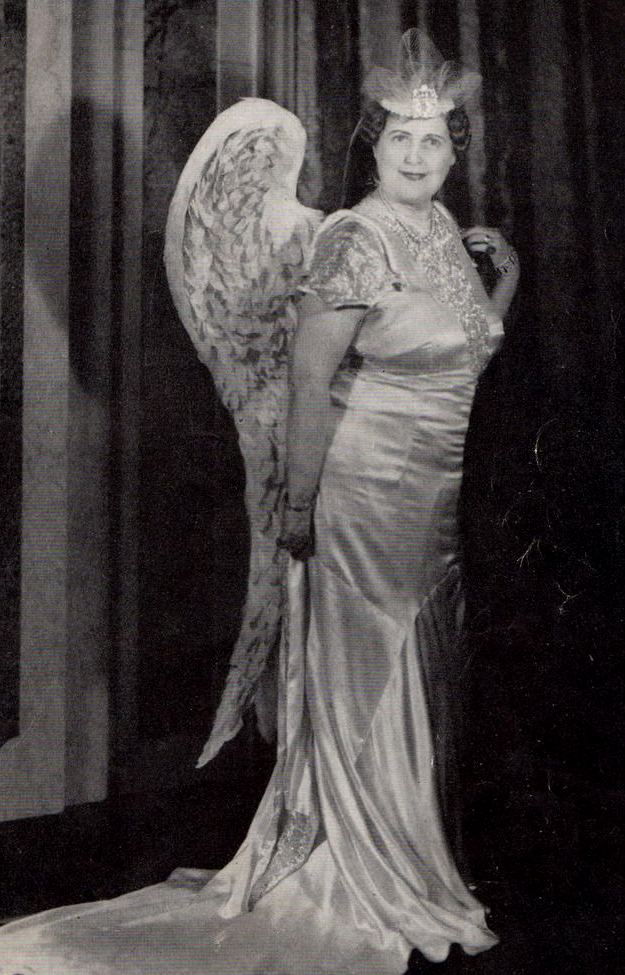
Florence was born
in Wilkes-Barre, PA, on July 19th of 1868. She often stated having developed
a passion for performing around seven years old, and was actually a pretty talented
pianist, going by the stage name of "Little Miss Foster" (even playing
at the White House for President Rutherford B. Hayes). Sadly, after breaking
her arm sometime in her thirties, she had to give up the piano. In 1909, her
father died, leaving her a hefty sum, which helped her move to New York, where
she took up singing lessons. Soon after, she joined a number of social clubs,
took on the role of music chairman for many of them, and began producing lavish
musical shows, which she -of course- cast herself as the main character. All
the while, Florence would also hold private vocal recitals for friends. In 1917,
she establish her own society, The Verdi Club, giving herself the title "President
Soprano Hostess". It actually became quite popular, with a membership of
over 400, including Enrico Caruso, Cole Porter, Lily Pons, and Geraldine Farrar.
In 1930, her mother died, leaving her more money, which she spent on huge galas,
each having a live concert where she would perform. All of this sounds great,
except for the fact that she was thought to stink up the joint, as critics said
she had problems with as pitch, rhythm, and sustaining notes. While friendly
to her face, she was often mocked behind her back. Her vocal instructor once
wrote to a friend, "There's no way to even pedagogically discuss it. It's
amazing that she's even attempting to sing that music." In a piece after
her death, Opera News magazine quoted impresario Ira Siff as saying,
"Jenkins was exquisitely bad, so bad that it added up to quite a good evening
of theater. She would stray from the original music, and do insightful and instinctual
things with her voice, but in a terribly distorted way. There was no end to
the horribleness. They say Cole Porter had to bang his cane into his foot in
order not to laugh out loud when she sang. She was that bad."
In early 1944, she produced a five-record set of 78 rpms (containing eleven
tracks), which she sold to friends for $2.50 - about $40 today. FJ thought people
loved her so much, she -at 74 years old- finally booked a general admission
concert at Carnegie Hall for October 25, 1944. The event sold out the 2800 seats,
with an estimated 2000 turned away. During her set, the audience lost it, and
it was said a few had to be carried out from laughing so hard. The next morning,
she read the terrible reviews in the papers. The New York Post wrote
"Lady Florence indulged last night in one of the weirdest mass jokes New
York has ever seen." She was heartbroken, swore to never sing again, and
suffered a heart attack five days later. Bedridden for almost a month, she refused
to leave her room, and died there on November 26th.
Now, she might have taken it better if she knew Meryl Streep was going to play
he in a movie (Florence Foster Jenkins, 2016), as well as the other number
of plays and movies based on her life, but not sure how she would have felt
about the RCA Victor 1954 10", and 1962 12" re-release of a few of
her tracks under the title The Glory???? of the Human Voice.
Well, if you're at all curious about this matter, then have a listen...
Now, don't let
this be a cautionary tale in the sense where it may keep you from doing something
you might enjoy - especially a form of art. If anything, take away from it that
you should never listen to the critics.
Fuck the naysayers, and just have fun!
-- November 13, 2020 --
This Is A Junk Post
They say, "One
man's trash is another man's treasure." In this entry, it's another man's
castle.
Howard Solomon grew up in Rochester, NY, as the son of Russian immigrants. Tired
of the cold, he moved down to the Bahamas, and began work as a cabinet maker.
Then, in 1972, he bought 40 acres in the swamps of Ona, FL, and asked his neighbors
to dump their large unwanted junk items in his yard. Being skilled in a number
of trades, including welding, carpentry, electrical, and plumbing, he used everything
they gave him to make art. After some time, he began to build a freaking castle,
which he covered in discarded aluminum printing plates, and added over 80 stained
glass windows he made himself. Then, he constructed a full-sized 16th century
Spanish galleon within one of the ponds (complete with masts, and cannons),
followed by a half-sized replica of the Alamo, and finally a lighthouse - all
the while still working on his art.
Solomon’s
Castle now sits on 93 acres, and even has a restaurant on the premises (inside
the ship), as there isn't a place to eat for miles. It's an amazing place to
visit for tourists and locals alike, so I dropped by last month.
I’m sad they don’t allow photography during the indoor tours, because
his 200+ pieces of art are out of this world. Their website showcases his ironwork
(see that here),
but his replicas of famous paintings made using only wood were pretty astounding.
Speaking of the tour: before Solomon's death in 2016, he wrote a script each
guide sticks to. It is packed with puns, and made the whole experience as corny,
as it is surreal.
Howard was
a true outsider artist that needs to be known by more people, and I hope this
post helps spread his name a bit.
For more of my pictures of the castle grounds, click
here.
-- October 31, 2020 --
Let's Talk About Me, Yet Again
Two wonderful videos
have recently popped up on YouTube, which cover my work.
First we have Feral Publication's vlog, Zine Hustle, which covers a lot
of zine-related topics, including reviews. For Episode #49, Rich takes a look
at three of my fanzines.
Then, my newest photo book, Ad Removal As Modern Art, received a great review in Episode 7 of Dr. Vanessa Sinclair, and Carl Abrahamsson's 23rd Mind TV.
These two YouTube
channels talk about a lot of cool projects, some of which you may not be familiar
with, so subscribe, and stay in the know.
Lastly, Steve Cammack over at MuhMur Radio in the UK played a bunch of 156 tracks
on his newest show (Oct 29th), so check that out.
Take it all in, folks, and enjoy!
-- October 23, 2020 --
Rock On, Star Child
Imagine a band
that only existed for one summer, almost forty years ago, was only seen by a
few hundred kids, in only one city, and never put out any material; yet has
a huge fanbase, and sells more memorabilia today than ever before. I don't know
of any acts which can brag about that, but one, and after I tell you all about
them, you might want to check them out yourself.
In 1979, Disney Records executive Gary Krisel was tired of putting together
kid's flip-book records, and got the bright idea to form a glam rock band around
the newly developing Star Wars craze. He recruited the Grammy and Emmy
award winning composer of tv theme songs Mike Post, to write some music, and
started to audition musicians. He hired a husband and wife duo (Thom Miller
and Lora Mumford) to handle the synths, and vocals, respectively. Seeing Lora
had, as Krisel put it, the looks of "a punk-rock Snow White", he dressed
her up in leather, while Thom was dress up in what looked like an Imperial Stormtrooper,
inside a rolling spacecraft that held his keyboards. Up next was the bassist
Roger Freeland, who was draped in a huge white suit resembling a Wookie. Tony
Coppola was brought on as a percussionist, and he was donned up as an acrobatic
amphibian. They added Bruce Gowdy on guitars, and Brian Lucas on drums, who
they let keep their human personas, but gave them uniform-like costumes. Hence
was born... HALYX!

In the summer of
1981, the band was given the stage at Disneyland's Tomorrowland Space Stage,
just under Space Mountain. Twice a day, for 30 minutes, five days a week, park
attendees would be treated to what everyone called "the Star Wars Cantina
Band meets KISS". After some time, the band noticed that adults would ignore
them, but the kids went nuts. A handful of them returned to the park on a regular
basis, just to catch their shows. Some of them even made their own band merchandise.
Disney, on the other had, didn't care for them. They complained that the band
was too loud, and too raunchy for the family affair that was Disney Parks. To
think, Disney didn't even allow male patrons to enter the park if they had long
hair, and here was this guitarist getting snide looks from security every time
he had to go to work. After the summer was over, Disney snubbed the band, and
didn't even let them record material. Elektra / Warner Brothers was showing
interest, but just before the demos were to be cut, they were bought out, and
the rep that was going to sign them was let go. Sadly, they weren't invited
to return the following year, and the whole concept was scrapped, only one month
after Mtv first aired. With costumes returned, and the little footage Disney
had of the band thrown out, not much remained, but memories.
Those who remembered would not let it die, and in the age of internet bidding
wars, and rare videos popping up all over the web, people started trading, selling,
and hunting down everything Halyx. It reached a boiling point to where the story
had to be told in full, and producer Kevin Perjurer (creator of Defunctland,
a YouTube channel I highly recommend) hooked up with director Matthew Serrano
to crowd-fund a documentary on the act. Recently released, Live From the
Space Stage: A Halyx Story is a great, in-depth look at a band that should
have been more famous. You can watch the whole thing below, for free...
It's wild to think this group of costumed misfits were the black sheep of a corporation that now puts out material which owes a debt to it, and the pop culture of the past affects the popular tastes of the future in stranger ways than we know. It's far out!
-- October 13, 2020 --
I Wanna Give You the Creeps
The newest 156 release is a ten-track CD LP, titled An Accidental Exorcism, which has been released on Seattle's No Part Of It.

Of course, I made a music video to go along with one of the tracks, titled "Red Rooms".
All the music on
this newest release is based around my love of minimalist horror movie soundtracks,
and was recorded in the Florida Everglades from June to September of 2020.
Released on professionally printed CDs, with awesome collage artwork by Bradley
Kokay on the cover, and within, they are only $7 (along with accompanying download),
or $5 for just the digital version.
To order, please visit the No
Part Of It Bandcamp.
-- October 08, 2020 --
Chop Chop
Since the Korean
War (June, 1950 to July, 1953), North Korea, South Korea and the United States
have had a few spats along the border, but none so violent, yet strangely as
unknown, as 1976's Korean Axe Murder Incident, which was all over a poplar tree.
Located in the Korean Demilitarized Zone is the Joint Security Area (often referred
to as "Panmunjom", or "Truce Village"), and it's the only
portion of the DMZ where North and South Korean forces stand facing each other.
Near the infamous "Bridge of No Return", that crosses the Military
Demarcation Line between the two Koreas, grows a poplar tree, said to be planted
by the founder of North Korea, Kim Il-sung. While bare throughout autumn and
winter, it blocked the view of, both, the United Nations Command checkpoint
(CP No. 3), and an observation post (OP No. 5) in the spring and summer. The
U.N. was tired of losing this vantage point, so on August 18, 1976, they sent
out a group to trim the tree. The U.N. sent out a group to shear it, consisting
of five South Korean Service Corps personnel, and escorted by U.S. Captain Arthur
Bonifas, First Lieutenant Mark Barrett, a South Korean ROK Captain, and eleven
enlisted personnel from South Korea, and the U.S. As they began to prune the
poplar, a troop of five North Korean soldiers appeared, led by North Korean
Senior Lieutenant Pak Chul, who -due to a history of being confrontational-
was nicknamed "Lt. Bulldog". At first, the Northerners just watched,
but after about fifteen minutes, Pak insisted to Bonifas they cease their activity.
Bonifas turned his back on him, and commanded his men to continue. After a few
minutes, a North Korean guard truck crossed the bridge, with another twenty
North Korean soldiers, all carrying crowbars and clubs, and joined the previous
group. Again, Pak told Bonifas to stop, and the Captain turned his back to him
once more. Pak calmly removed his watch, wrapped it in a handkerchief, and after
placing it in his pocket, yelled "Kill the bastards!" The North Koreans
set upon the U.S. and South Korean soldiers, quickly picking up the axes dropped
by the South Korean Service Corps workers. Bonifas was knocked to the ground,
and bludgeoned to death by surrounding North Koreans. Barrett jumped over a
wall, and fell injured on the other side, where several North Korean soldiers
took turns walking down to beat him with an axe they shared, killing him. The
United Nations sent in more soldiers to break it up, and the entire schism lasted
less than a minute. A guard at CP No. 3 recorded the incident with a movie camera,
and this is the only evidence of the skirmish left today.
Kim Jong-il soon
addressed the Conference of Non-Aligned Nations (in Colombo, Sri Lanka), presenting
the case as an unprovoked attack on North Korea, led by American officers. The
C.I.A. claimed it was a premeditated assault from North Korea, with the Pentagon
planning to launch missiles in retaliation.
On August 21st, a United Nations group, led by Americans, launched Operation
Paul Bunyan. In a huge show of force, they sent -unannounced- a convoy of twenty-three
U.S. and South Korean vehicles, carrying two eight-man teams of military engineers,
two thirty-man security platoons from the Joint Security Force, and a sixty-four-man
task force from South Korea's Special Forces Brigade, while a U.S. infantry
company circled twenty utility helicopters, and seven Cobra attack helicopters,
as U.S. F-4 Phantom IIs, South Korean F-5 and F-86 fighters flew across the
sky. The military engineers, armed with chainsaws, jumped out of their vehicles,
and sawed that tree to smithereens.
Tensions were high afterward, but -luckily- a full-scale war did not break out
again. One of the axes is said to reside in North Korea's Peace Museum. From
1984 to 1987, General William J. Livsey (who was the commanding general of the
Eighth United States Army in South Korea during that time), carried a stick
carved from wood of the tree, and ceremoniously passed it to General Louis C.
Menetrey after retirement. Today, though relations are still strained between
all three countries, no one talks about "the incident".
I recently posted about stupid wars, and the dumb shit that started them, and
this story is no different. In those first few days, both sides refused to see
it for what it really was: a bunch of angry soldiers disrespecting one another,
until all hell broke loose. If you read my previous post, you know wars have
started over a lot less.
-- September 23, 2020 --
Some Real Spacey Art
Back in August
of 2015, I posted about how astronaut David Scott placed a statuette by Belgian
artist Paul Van Hoeydonck on the moon, without NASA's knowledge, during the
Apollo 15 lunar mission of 1971. That piece isn't the only object of art up
there. Our satellite actually boasts six more works by 60s artists, all in one
tiny museum, also placed there without permission from NASA.
The project was thought up by sculptor Forrest W. Myers in early 1969, who contacted
five other artists; Andy Warhol, Robert Rauschenberg, John Chamberlain, Claes
Oldenburg, and David Novros. All five submitted works, with Myers including
one of his own. He then reached out to the Experiments in Art and Technology
group, which is a nonprofit linking artists with engineers, and was then introduced
to scientists from Bell Laboratories, including Fred Waldhauer. Together, they
created small ceramic plaques that would withstand radiation, and intense temperature
fluctuations, where the work of all six artists were etched onto.

He titled it Moon
Museum, had about 20 made, and gave one to everyone involved. Saving one
extra, he called NASA to see if they were interested in adding the project to
the upcoming Apollo 12 mission, but they gave him the run around. Not wanting
it all to go to waste, Waldhauer came up with another plan. He knew a Grumman
Aircraft engineer working on the Lunar Module Intrepid, so he asked him
to sneak it onto a section of the lander that would remain on the moon. The
worker agreed, and two days before takeoff, Fred received a telegram saying
"ALL SYSTEMS GO". On November 14, 1969, the Apollo 12 mission launched
from Florida's Kennedy Space Center, successfully landing on the 19th. Earth's
moon now had its first art museum.
Going clockwise from top left, we have Andy Warhol with a drawing of a penis
(Myers would later comment in an interview, "He was being the terrible
bad boy."), a single line by Robert Rauschenberg, a black and white square
by David Novros (made to resemble circuitry), John Chamberlain's contribution
(also made to represent circuitry), Claes Oldenburg's playful variation on Mickey
Mouse, with the last being a computer-generated symbol called "Interconnection"
by Myers.
With all this, Hoeydonck's previously mentioned piece on the moon, as well as
the Golden Records on both Voyager spacecrafts, it's neat to know there's a
handful of human artworks in space. Not that something so beautiful needed sprucing
up.
-- September 09, 2020 --
A Real No Man's Finland
I've been sharing
weird stories about Finland with friends on social media lately. Stuff like
the study they did at the University of Kuopio, which found that peeing on plants
yielded 4.2x more fruit, and tomatoes had more beta-carotene and protein than
ones from plants no one pissed on, or that Finlanders (before refrigeration)
used to keep a live Russian Brown Frog in their stored milk, because secretions
from the animal prevented dairy from spoiling.
Well, none of that matters, because I've only just discovered that Finland does
not exist. At least, according to some conspiracy theories anyway.

So, the story goes
that, during the Cold War, Russia discovered an area of the Baltic Sea -between
the Soviet Union, and Sweden- was ultra-rich in fish. Not having the time to
devote resources into building a fishing enterprise, they shared the information
with Japan. Together, they concocted a scheme to keep it a secret by making
up a land mass, called Finland. This way no other trawlers would enter the zone,
thinking there was land in that direction. Japan was to fish the space, and
give a percentage of their catch to Russia for the help. The booty was to be
sent back to Japan via the newly built Trans-Siberian railway, under the guise
of shipping hardware from a shell company they called Nokia, explaining why
Japan is the largest importer of the brand, and it having a seemingly Japanese-sounding
name. The theorists propose the name "Finland" even derives from the
"fin" of a fish, not realizing the country's English name stems from
the Old English word finna, a term used to describe people from Scandinavia
- to Finlanders its actual name is Suomi. They also claim the nearly-six million
Finnish people believe themselves to be living there, are actually in towns
and cities peppered about parts of what's called Eastern Sweden, as well as
the Baltic Sea shores of Estonia, and Russia. Never mind the centuries of Finnish
history, and art, not to mention the millennia of the developing of the Finno-Ugric
language. There's also that pesky film footage, and photography from space,
but like the hiding of flat Earth evidence, it's all doctored for sure.
It just goes to show you there's a conspiracy theory for everything, and no
matter how much proof you have for something, there will always be a handful
that will even deny scientific data. Ugh. I need a vacation from people. Maybe
I'll just visit "Finland", and hang out with the fish.
-- August 25, 2020 --
The Dumb Dumb Wars
In an 1864 retort
to a woman holding Confederate sympathies berating him for the destruction of
Mississippi, Union General William Sherman, responded "War is cruelty,"
and later in a speech to the graduating class of the Michigan Military Academy
in 1879, he said, "War is hell," but he never acknowledged that war
can also be pretty stupid. Never mind that the United States military-industrial
complex had us engaged in the 2nd Gulf War over flimsy evidence, or flat out
lied about an incident in the Gulf of Tonkin to pull us into Vietnam. Those
are wars over stupid reasons, but now I'm about to list off wars that were just
plain stupid (and which you may never have heard of).
In 1896, Great Britain and the Zanzibar Sultanate had a conflict that lasted
all, but 45 minutes (thought to be exactly 38). After the death of Sultan Hamad
bin Thuwaini, Sultan Khalid bin Barghash took the throne, but the Brits preferred
Hamud bin Muhammed, so they sent in troops. After a little over a half-hour
of fighting, Barghash fled, and the Sultanate as a sovereign state was terminated,
starting a period of British rule.
El Salvador and Honduras had a short war, known as the Football War, or 100
Hour War. In July of 1969, El Salvador sent bombers on an air raid mission over
Honduras, because the two countries were battling it out in a two-leg qualifier
of the FIFA World Cup. Yep, all over a soccer game. The Salvadorian Army then
invaded using tanks and all, forcing Nicaragua to step in on the Honduran side.
Honduras soon bombed targets in El Salvador. Fighting continued until August,
when El Salvador backed off due to world pressure, leaving close to 5000 troop
and civilian casualties.
In 1838, the French went to war with Mexico, because some Mexican officers looted
a French pastry shop in Tacubaya. The chef, only known as Monsieur Remontel,
demanded 60,000 pesos as reparations for the damage. Mexican citizens were pissed,
as many believed the shop was only worth 1000. This lead to the destruction
of French-owned stores by angry mobs, so French forces invaded. Known as the
Pastry War, peace was not achieved until the following year, when the Mexican
government agreed to pay 600,000 pesos for damages to French citizen's property.
The rival Italian states of Bologna and Modena went to war in 1325 because a
Modena local stole a bucket from a Bolognese well, causing 300 years of tensions
to finally boil over in the War of the Bucket, while the U.S. and the U.K. had
a skirmish in 1859, due to an American farmer (Lyman Cutlar) shooting a pig
(owned by Irishman, Charles Griffin), which he found rooting in his garden.
In 1835, the U.S. state of Michigan went to war against the state of Ohio over
varying border interpretations near Toledo, due to poor geographical understanding
of the Great Lakes.
Greece invaded Bulgaria in 1925, thanks to the shooting of a Greek captain,
and his sentry, when they ran into the Bulgarian town of Petrich, after a stray
dog.
Western Australians were sick of the emu population by 1932, as many felt the
giant flightless birds to be a pest on farmlands. They sent out military troops
in two campaigns to exterminate as many as possible. Known as the Great Emu
War, it didn't work, and it's hilariously sited that the emus won, as farmers
didn't notice a drop in flocks, and requested the military return in 1934, 1943,
and 1948.
Lastly, there's the Battle of Karánsebes, during the Austro-Turkish War
of 1787-1791. That took place in 1788, and was the cause of 1200 wounded, and
150 deaths, all of which came from one side. It all started when the Austrian
drunkenly fought themselves over bottles of schnapps, and when reinforcements
arrived they thought they were fighting Turks, and joined in the killing of
their own men.
Damn it, if war wasn't already stupid enough, this is just plain imbecile. Sadly,
with human evolutionary history already rolling up to the 2,000,000 year mark,
and modern humans at 35,000 years, it makes me wonder if we'll ever really cast
off the hides of being nothing more than simple beasts. Many people can't even
stop themselves from committing violence against someone over mere words, yet
we're expected to be civil to one another over more important matters such as
race, gender, and religion. I can only hope we will one day shed our animal
skins, and ascend towards something greater, treating all humans as equals.
Until then, what can I say, except: don't be dumb?
-- August 13, 2020 --
O, Holy Moon
When the Catholic
Church solidified itself as one entity (thought to be around 110 CE, when Saint
Ignatius of Antioch used the term "katholikos" [Greek for "universal"]
to distinguish itself from other churches), they were spread out far and wide
throughout Europe and Asia Minor. To wrangle up the commoners living in those
regions under Catholic command, the church established what became known as
dioceses (or eparchies in eastern areas), and each one is divided
up into parishes. Those diocese are governed by a bishop, of which the Catholic
Church has about 2900 of them today, and they supervise the priests and deacons
that administer each parish.
Now, each Catholic diocese has ecclesiastical jurisdiction over a major city,
and its surrounding area, but one covers a little more than normal. Thanks to
the Code of Canon Law, the Diocese of Orlando, officiates over 400,000
Catholic residents of hundreds of towns within nine counties in and around the
city of Orlando, Florida, as well as -drum roll please- the moon, too. That
1917 church edict states any newly discovered territory falls under bishopric
rule of the diocese where the expedition came from. In 1968, William Donald
Borders became the first bishop of Orlando, and when the astronauts of Apollo
11 stepped on the moon the following year in July of 1969, his spiritual rule
extended there as well.

It seems no one
really thought about it, until Borders himself met Il Papa in the early 70s,
as bishops have to all perform an obligatory visit to Rome every five years,
known as an ad limina visit, where they pray at the tombs of St. Peter
and St. Paul, and meet up with Vatican officials. It was during his first visit,
that Bishop Borders brought up to Pope Paul VI the fact that he was also the
Bishop of the Moon. It was said the Supreme Pontiff thought William was a kook,
until that section of the Code of Canon Law was explained, and everyone
has a good laugh.
Chancellor for Canonical Affairs for the Diocese of Orlando, Father John Giel,
says the whole affair just showcases "Border’s good and humorous nature
that allowed him to be such a good first bishop for central Florida," because
it "means nothing if there is no one to have jurisdiction over." In
other words: If no little boys up there, we don't care.
-- July 30, 2020 --
Use Your Illusion (To Cash In)
Pareidolia is a cognitive process where one's judgment and evaluation tend to perceive an object with a pattern, or meaning, already known to the observer. There are many examples of this, which include seeing faces in abstract patterns, or hearing messages in music. The oldest known example of this is also the world's oldest known manuport. Known as the Makapansgat Pebble, this beauty was found lying among the bones of an Australopithecus africanus skeleton. It seems, three million years ago, an ancient hominin found the rock, and possibly thinking it looked like a face, carried it back three miles from where it was quarried to their group's living site.

A famous case of
pareidolia happened in 1877, when Percival Lowell viewed the surface of Mars
through a telescope, and saw what appeared to be a number of straight lines,
which were interpreted as canals, and it was then theorized they may have been
created by intelligent life. A few years later, the canal theory was scrapped
as the lines seemed to fade away with clearer views from stronger telescopes.
There are other less interesting, but much weirder instances of pareidolia,
such as when 52-year-old Diana Duyser, of Hollywood, FL, made a grilled cheese
sandwich, and saw the face of the Virgin Mary staring back at her from her lunch.
She then sold the meal to the internet casino Golden Palace for $28,000 on eBay.
To me, the strangest of all is one I recently came across, when scouring said
online auction site: odd-shaped Cheetos. Yeah, that Frito-Lay corn snack that
turns your fingers orange is deemed a highly marketable item, so long as it
looks like something else to someone. Sure, there may be few buyers, but there
are certainly a lot of sellers. Hundreds of pages on eBay, show chip after chip
of a pareidolia-induced selling frenzy. One Michael Jackson look-alike Cheeto
= $700. A Mario Bros. Cheeto is going for $500. Several Donald Trump-looking
pieces - around $2000 each. One Harambe the Gorilla-shaped Cheeto, which started
at $12, sold for -drum roll, please- $99,000! It's believed these became a hot
commodity after body builder Andy Huot started the Instagram account @CheeseCurlsofInstagram,
when -in 2013- he found a Cheeto that formed a perfect number seven. It didn't
help matters when Frito-Lay decided to launch a search for entries into a "Cheetos
Museum", in 2016, and contestants could win $10,000 to $50,000 prizes for
unique shapes. Artist Jack Koloskus even got in on the action by making small
statues out of Cheetos.

Don't feel bad if you think you have a bad case of pareidolia, because it turns out that computers get it, too. New York University researcher Greg Borenstein found that the facial recognition system FaceTracker does the same thing, enough to where he started a project called "Hello Little Fella", where photos are posted of faces the computer saw in everyday objects. So, you don't need to get your eyes (or brain) checked, because -to paraphrase philosopher Robert Anton Wilson- seeing isn't necessarily believing.
-- July 23, 2020 --
Free Stuff!
My new photography art book - Ad Removal As Modern Art - is out now, and I'm celebrating by giving one away. Limited to only 200 copies, this full-color beauty holds over 180 of my photographs on glossy 9" x 7" pages, and is regularly $50 (postage paid), but one lucky punk will get one at no cost.

All you have to
do is email me your mailing address,
and I will pick one winner on August 13th to receive a free copy.
Everyone
else gets FREE STICKERS, so there are no losers! You can email
me from now until August 12th to be entered. Good luck to each of you!
UPDATE: The winner is Lorrie K of Dayton, OH, but thanks for everyone who sent
in entries.
-- July 13, 2020 --
This Music Is The Cat's Meow
Cat lovers: have
you ever left your home, and turned on the radio, or some music, so your pet
doesn't feel alone? Not sure if you're aware, but music doesn't really register
in the feline mind. To them, it's just another noise out in the world. Well,
that is until now. Let me introduce to you, and your kitty, to cat music.
David Teie, a cellist with the U.S.'s National Symphony Orchestra, and music
professor at the University of Maryland, teamed up with professor of psychology
at the University of Wisconsin-Madison, Charles Snowdon, as well as other researchers
to produce music for meowin'. In 2015, DT launched a Kickstarter campaign in
hopes to get the project off the ground. His goal was to reach $20,000, but
when pussy freaks heard about this interesting project, donations reached a
whopping $241,000. Released by Teyus Music, Music For Cats (2016), and
Music For Cats: Album Two (2018) contain tracks ranging from four to
ten minutes long. Each tune has symphonic elements, such as David's cello, but
also contain the sounds of a cat's purr, kittens suckling, and bird chirps.
When asked why those sounds were included, Teie explained, "The brain structures
responsible for our emotions are almost completely formed at birth, so the sounds
of the womb are the bases for human music," and believing brain development
for cats occurs outside the womb, for instance "the sound of suckling is
a reward-related sound that all cats will have heard during that crucial period."
So far, reaction to the effects of "cat music" has been overwhelmingly
positive, with many who tried it (including several reporters at Today,
and The New York Times) claiming their cats loved it. Both Teie, and
Snowdon, point out that the greatest reactions come from fur balls adopted from
shelters, as the music seems therapeutic for animals that had been previously
neglected.
When you get back to your lair, put this ditty on, and check out your mouser's
impression.
David Teie's two
albums have been successful enough to the point where he's now trying his hand
at music for other pets, such as dogs, though he fears theirs is a more difficult
code to crack because so many different pooch breeds have different vocalization
patterns, and composing a soundtrack geared to all of them may be a tough assignment.
Either way, this give me hope that maybe, someday, someone will write music
that will calm those prone to violence. We could pipe it into police stations,
or sneak it into Fox News segments.
-- June 29, 2020 --
It's In Our Genes
DNA (Deoxyribonucleic
acid), which was first isolated by Friedrich Miescher in 1869, is an amazingly
complex molecule of two strands, which carries the genetic instructions for
the development of all known organisms. Those two strands (commonly called "the
double helix") are polynucleotides composed of simpler monomeric nucleotides,
and each of those are composed of a deoxyribose sugar, an organophosphate, and
one of four nitrogen-containing nucleobases: cytosine (aka C), guanine (aka
G), adenine (aka A), or thymine (aka T). An incredible 98.5% of DNA sequenced
is found to be "junk", meaning it has no coding purpose, and though
some of it may be useful for future medicines, Dan Graur, an evolutionary biologist
at the University of Houston, believes 75% of it has no function whatsoever.
So, why not play around with that three-quarters of all life?
Well, that's what some scientists are currently doing. Mixing digital technology
and genetic science, researchers are converting the computational language of
ones and zeros into the language of the DNA nucleotides, where the Ts and Gs
stand in for 1s, and the As and Cs take the place of 0s.
In 1988, the Harvard Medical School, and Hatch Echol's laboratory at University
of California Berkeley, stored a 35 bit image, titled Microvenus, into
the plasmid of E. coli, and the same group then encoded the Bible's
Genesis 1:28 in 1998. In 2003, Washington state's Pacific Northwest National
Laboratory encoded lyrics from "It's A Small World", but -six years
later- the same researchers found they could fit 1688 bits of text, music and
imagery into the bacteria's genetic code. Then, in 2010, Craig Venter and colleagues
actually encoded a watermark onto synthetic mycoplasma genome. Later, PhD George
Church, and his Harvard Medical School team, encoded an HTML version of a book,
in 2012. In an interesting act of self-promotion, the book, Regenesis: How
Synthetic Biology Will Reinvent Nature and Ourselves, was -of course - written
by Church. Anyhow, in 2013, the European Bioinformatics Institute copied 739
kilobytes of sound, including a 26-second clip of Martin Luther King, Jr.’s
"I Have a Dream" speech, while, the following year, Harvard Medical
School, and Technicolor Research Group, stored, and retrieved, 22 megabytes
of the French silent film A Trip to the Moon. In 2016, Microsoft, researchers
at the University of Washington’s computer science and engineering departments,
and Twist Bioscience, jammed a music video for the song "This Too Shall
Pass" by the band OK Go. When asked why they would pick such a god-awful
tune, principal Microsoft researcher Karin Strauss said, "They’re
very innovative, and are bringing different things from different areas into
their field, and we feel we are doing something very similar." Maybe to
make up for that idiotic decision, they also crammed in the Top 100 books from
Project Gutenberg, the full list of seeds in the Crop Trust Seed Database, and
copies of the Universal Declaration of Human Rights in different languages.
All of this sounds pretty amazing, but one thing I haven't covered much is that
most of this was done within synthetic strands of DNA, but, in 2017, Jeff Nivala
and other Harvard researchers, used the CRISPR System to edit the genes of living
E. Coli bacteria. And what did they install? A moving gif image of the
galloping horse from Eadweard Muybridge’s 1877 photographic study, Human
and Animal Locomotion.

On the left is the
original source file, on the right are frames pulled from the E. Coli
bacteria after multiple generations.
Now, you're probably asking, "Why?" The answers are pretty easy to understand, and quite reasonable, too. Data is currently stored onto magnetic strips on substrate platters of aluminum, ceramic or glass - all of which degrades (or breaks) over time, and DNA can be recovered over a thousand years. Secondly, it's a dense storage system, where one can now fit a zettabyte of information (one trillion gigabytes) per gram / milliliter. Plus, if science can ever work it out, we might be able to walk around with all the world's knowledge within us, rather than on a computer we carry around in our pockets. Just think of it! There may never be another stupid human being on this planet, and -with the current state of affairs- that's a time that can't come soon enough.
-- June 16, 2020 --
A Vision of Beauty
Available now:
limited edition retro photo viewer in two editions! Two sets of seven photos
each; one set of color photos, and another in black/white.


Color set comes
with a blue plastic viewer in pink box, along with color photo wheel. Black/white
set comes with black plastic viewer in white box, along with black/white photo
wheel.
Limited to 33 copies of each set, all signed and numbered. $50 each (or $80
for both), with postage paid, anywhere in the world. If you'd like to order
one please contact me.
UPDATE: Both sets are now sold out!
-- June 09, 2020 --
Rip It Up, Tear It Down
Coming soon! Ad Removal As Modern Art, with over 180 photos of the inadvertent art created by trashing NYC subway advertising.

This collection
of my photographs will be released in a full-color, 9" x 7" book,
with glossy pages, and will be limited to only 200 hand-numbered copies!
The book will be $50 in the U.S. / $60 outside the country (postage paid), and
you can preorder by contacting me.
Check out some of the pics!




click on images
for larger view
-- June 02, 2020 --
Not-So-Breaking News
Conspiracies concerning
secret societies have probably been around since the formation of the first
Freemasonic lodge. Your typical account of creepy cabals infiltrating the government
to control the populace often have them worming into the media, so as to blind
the citizenry to their nefarious schemes. While I don't think this is true anymore,
seeing as private organizations - such as the Bilderberg Group and Trilateral
Commission - are actually pretty open about their plans, I do know of one shadowy
bunch who quietly plant a veiled code into their news stories. They are known
as the Order of the Occult Hand.
The club began in the fall of 1965, when a journalist for North Carolina's The
Charlotte Times, Joseph Flanders, reported on a man who came home late one
night, and was mistakenly shot by a family member. In the story, Flanders wrote
the sentence, "It was as if an occult hand had reached down from above,
and moved the players like pawns upon some giant chessboard."
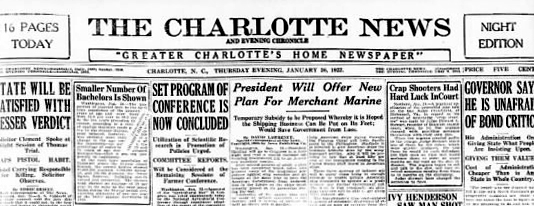
Joseph's colleagues
at the paper were so taken by this flowery line of what's known as "purple
prose" that they held a meeting at a local bar. The gang presented JF with
a banner depicting a bloody hand emerging from a purple cloud, and crowned him
as their high priest. Thus the Order of the Occult Hand was formed with the
objective to sneak that line (or some form of it) in whatever news story they
could. Some of the original members include editorial writer Stewart Spencer,
city editor John Gin, and associate editor R.C. Smith, who would also squeeze
the line into some pieces he wrote for jazz magazine Down Beat. Soon,
the association spread to other papers in the area, and later the entire United
States. The Charlotte News only exposed the group, and their shenanigans,
after it ceased publication in 1985, but the story didn't gain much traction.
It wasn't until 2004, that the clan gained notoriety when journalist James Janega
published an investigation about them in the Chicago Tribune. Two years
later, Pulitzer prize-winning editor of the Arkansas Democrat-Gazette,
Paul Greenberg, announced the cartel had chosen a new secret phrase at an annual
editorial writers' convention to resume their work clandestinely. To this day,
there are sixty-four known and acknowledged members of the Order.
With so many stories about press manipulation, it's nice to know that there's
one secret organization that's not out to bamboozle you. Even so, trust no one,
and treat every story as if an occult hand has reached down from above, and
moves players like pawns upon some giant chessboard.
-- May 24, 2020 --
¡Cuba Libre Para Los Punks!
Ladies and gentlemen, I present to you Razorcake Podcast #688, hosted by yours truly, where I play Cuban punk, hardcore and metal.
That's right! An
hour's worth of music pulled straight from illegally traded tapes, smuggled
out of a repressive island regime.
Enjoy your listening, and please share with the rest of the world!
-- May 18, 2020 --
Such Haunting Music
I believe most people who claim to be mediums are some of the lowest forms of human life. They're not murderer (or rapist) low, but they're down there. Many of them prey on the weak minded, and those seeking hope in emotionally difficult times. That said, there are some interesting types of mediums; the ones who don't necessarily vulture people, so much as claim to possess the ability to speak to the dead so as to gain notoriety. While they still do it for money, they at least don't target grieving families. I've already written about a few in the word of literature, such as Emily Grant Hutchings, who swore she could contact Mark Twain from beyond the grave. In this post, I'll be covering a musical medium: Rosemary Brown.

Mrs. Brown was
born Rosemary Isabel Dickeson, in London, on July 27, 1916. She lived her early
life without any musical knowledge, until 1948, when she bought a secondhand
piano, and took three years of lessons. In 1952, she married Charles Brown,
and had two children with him. He died in 1961, and - three years later - Rosemary
must have been pretty bored, because she began telling some fanciful tales to
anyone who would listen. She insisted a spirit first revealed itself to her
at seven years old, saying she would be a world renowned musician, before disappearing.
Supposedly, it wasn't until she was seventeen that she realized it was the ghost
of composer Franz Liszt (1811 - 1886). She professed that he had finally returned,
to dictate to her some new tunes he had been writing since his passing. Within
a year, she was also "contacted" by, and publishing "new"
pieces from: Bach, Brahms, Debussy, Schubert, Beethoven, Chopin, Mozart, and
many others. In 1970, Philips (which was bought out by PolyGram in 1972) released
a seventeen track LP, A Musical Seance, where she and pianist Peter Katin,
perform many of these arrangements.
It goes without saying that the critics were skeptical. Many thought they were
nice works, but some wrote they contained "no striking themes, complex
structures, depths of feelings, or harmonic, tonal, or rhythmic innovations."
In their 1989 book, Anomalistic Psychology: A Study of Magical Thinking,
Warren Jones and Leonard Zusne wrote that Brown's compositions were "passable
works, entirely in the style of these composers, but appeared to be simply reworkings
of existing pieces."
Want to judge for yourself? Here's a "communication" she received
from Frédéric Chopin in 1966, titled "Nocturne in A flat"
(played by pianist Phillip Sear in 2010).
If you are interested in playing some for yourself, all the sheet music is available in her three books, Unfinished Symphonies: Voices from the Beyond (William Morrow, 1971), Immortals at My Elbow (Bachman & Turner, 1974), and Look Beyond Today (Bantam Press, 1986). Though not taken very seriously, a handful of concert pianists, such as Howard Gordon Shelley, Cristina Ortiz and Philip Gammon, have performed her work. Her life story has been the subject of the 1974 BBC documentary Music from the Beyond: The Mediumship of Rosemary Brown, as well as a BBC Radio 4 drama, The Lambeth Waltz by Daniel Thurman, in 2017. By the time she passed away in 2001, she hadn't become the world renowned musician that liar Franz Liszt told her she would be, but maybe she'll get that fame after she spooks a new medium to dictate the works she's penned from beyond the grave.
-- May 05, 2020 --
Doom Jazz
Politics has found
its way into music as far back as musical history reaches. Beethoven's third
symphony was originally called "Bonaparte", until the commander crowned
himself emperor, and the dedication was rescinded. The Hebrew slave chorus in
the Verdi opera Nabucco was a call for his country to rise up, and end
Austrian and French dominion over Italy. In the 1700s, African-Americans transformed
psalms sung by Presbyterians of the Scottish Hebrides into early gospel music
as a way to transmit messages of hope to those who otherwise could not read.
The Industrial
Workers of the World used folk music to spread the message of labor movements
throughout the early 20th Century. Of course, there's the protest rock of the
late 1960s, as well as almost the entire catalog of punk. While much of this
means nothing to the average listener, some of it has been quite fruitful in
the realms of resistance, so it should be no surprise that music can sometimes
bring about actual revolution. Hell, in Africa, one band alone lead two military
coups.
The aptly named Tout-à-Coup Jazz, which means "jazz from out of
the blue" or "sudden jazz", was a band formed in 1976 by guitarist
Captain Thomas Sankara, and lead singer Captain Blaise Compaoré, when
they met in Morocco, as both were serving in the Republic of Upper Volta's military.
Though it was said that the band rehearsed more than they played out, those
who witnessed their gigs claim they were "magical". In 1982, the act
reached the peak of their popularity, when it was suddenly halted by both band
leader's political aspirations. Compaoré headed an armed coup against
the country's President, Major Jean-Baptiste Ouédraogo. Blaise placed
his bandmate Sankara as President of the country, changing the name to Burkina
Faso the following year.

During his rule,
Thomas promoted the politics of Marx and Lenin, plus the idea of pan-Africanism;
denying foreign aid, as he pushed to nationalize the land and all mineral wealth.
For four years, TS was heralded as "Africa's Che Guevara". Using his
musical prowess, he even wrote the new national anthem for his country, "Une
Seule Nuit".
Sadly, being the typical lead singer, Compaoré couldn't stand not being
in the spotlight. In 1987, with backing from the CIA and French intelligence
services, he had Sankara killed, placing himself as the new ruler of the west
African nation. The band was truly no more. Even sadder, if you're hoping for
some instant karma, BC held power for twenty-seven years, and wasn't booted
until the 2014 Burkinabé uprising, which was heavily inspired by the
Sankara legacy.
So, if you're thinking of inciting revolution, at least start a band. Who knows
where it might lead. Just keep an eye on your vocalist.
-- April 29, 2020 --
Let's Talk About Me
My musical, poetic
and photographic work got a really nice mention in the third episode of Dr.
Vanessa Sinclair, and Carl Abrahamsson's 23rd Mind TV.
They talk about a lot of cool people, and projects, you may not be familiar with, so tune in, and check this out, as well as past episodes.
-- April 21, 2020 --
Sacred Secretions
Some people become
so constipated, they pray the Good Lord will help give them a bowel movement.
In some religions, people don't just pray in hopes they'll crap, but every time
they go.
In the Hebrew Talmud, as well as the Mishnah, there are tractates
called berakhot (translated as "blessing"), and they discuss
rules of prayers for a number of circumstances. One such is the asher yatzar,
which translates to "who has formed man". It is a prayer recited whenever
someone has finished excreting or urinating - though observant Jews also recite
it during the Shacharit service. This blessing is supposed to thank The
Almighty for their health, and for being able to poop, because they believe
existence would be impossible without a good dump.

Only after washing,
and drying your hands, outside of the bathroom, one is to recite the following:
"Blessed are You, Adonai, our God, King of the universe, who formed man
with wisdom and created within him many openings, and many hollow spaces. It
is obvious, and known before Your Seat of Honor, that if even one of them would
be opened, or if even one of them would be sealed, it would be impossible to
survive, and to stand before You even for one hour. Blessed are You, Adonai,
who heals all flesh and acts wondrously."
This prayer is believed
to have influenced the code of Islamic hygienic jurisprudence, known as Qadaa'
al-Haajah (meaning "relieving oneself"), which is found in the
Hadith. When a Muslim steps into a bathroom, they are supposed to enter
with the left foot. While on the toilet they are to remain quiet. Once finished
they are to wash their anus - or genitals - with water, using the left hand;
a process known as istinja. When leaving, one is to step away with the
right foot, and then utter, "Praise be to Allah who relieved me of the
filth, and gave me relief."
The Buddhist religion doesn't have any prayers or blessings for the act itself,
but the Vinaya Pitaka (the Buddhist guide to conduct, whose title translates
to "basket of discipline") does mention that monks are to line up
to use the john in order arrived, not by seniority, and should not have anything
in their mouths, or audibly grunt during. The Hindu's also don't do hoodoo when
they visit the loo, but in chapter four of the Manusmriti (an ancient
legal text of the Hindu Dharmasastras tradition), it covers a huge list of where
not to pee or poo. Places you should not go are listed as the road, a cow-pen,
plowed fields, holes inhabited by living creatures, the bank of a river, a temple,
the top of a mountain, when facing the wind, or looking towards a Brahmana,
the sun, water, or cows - all while facing north during day, but south at night.
Well, with the rash of toilet paper shortages that hit the western world the
past few weeks, I'd thought it was a perfect time to show you that all religions
are full of shit.
-- April 06, 2020 --
Dial 1-800-Musique
There are currently
quite a number of music streaming services. We have the choice of over thirty
to choose from, including Spotify, Apple Music, Pandora, iHeartRadio, and Tidal.
It's gotten to the point where Google, Amazon and YouTube have gotten in on
the game. I find it odd to know that, even with this boom in online listening,
there are close to thirty that went belly up, like Radical FM, Groove Music,
and MixRadio. You'd think that all these services would kill off radio, but
it was radio that actually killed off the first music streaming service. No,
I'm not referring to Rhapsody; they just bought out Napster, and started using
that name instead. The streaming service I'm about to touch on goes back even
before the 20th Century.
In 1896, Thaddeus Cahill, a New York City lawyer who studied the physics of
music at Oberlin Conservatory in Ohio, had the bright idea to create a dail-in
service where you could call up, and listen to some music. He called it The
Dynamophone, and had it patented the following year. By 1900, he changed the
name to Telharmonium, and opened up a small warehouse on 39th and Broadway,
where he set up shop. Packing the place with over 200 tons of gadgets and wires,
he christened the building Telharmonic Hall. The service cost callers twenty
cents an hour, and music played all day, and all night. By 1906, the Telharmonium
was being channeled into restaurants and hotels. The next year, it was available
to be piped directly to your home.
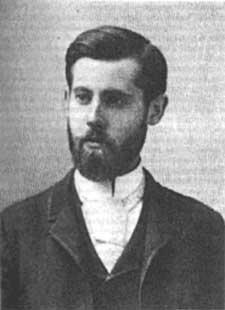
While the business
model was pretty fascinating for its time, the musical aspect was just as amazing,
as Cahill didn't use an orchestra, or a band, to play the tunes. He hired, and
trained, two musicians to play one specially constructed keyboard. Predating
synthesizers, the console, which was set up a floor above all the machinery,
played eerie tones using electricity. Every cog in the machine represented a
note, and - when levers were pushed- cogs spun near magnetic receivers, making
the teeth of the cogs act as sine waves.
Mark Twain read a piece on the Telharmonium in The New York Times, and
- after hearing a performance of it - said, "Every time I see or hear a
new wonder like this, I have to postpone my death right off. I couldn't possibly
leave the world until I have heard this again and again."
By 1915, two major issues had been slowing the expansion of Telharmonium (which
costs about six million dollars today). First, was the aforementioned preeminence
of music radio broadcasting. Secondly, was that with the growth of the company,
more electricity was needed to generate sound, and the more it used, the more
it interfered with telephone service. Sadly, these two factors hurt Cahill's
company, and it closed operation in 1917. Thaddeus passed away in 1934, without
further developing anything of note, though his invention was the inspiration
for the Hammond organ, which functions on very similar technology. From there
came analog systems like the Moog, so if you're a fan of electronic music, you
can thank Mr. Cahill, and his invention.
Now, unsubscribe from that music streaming service, and go make some music yourself.
-- March 23, 2020 --
Just A Little Get Together
I love the idea
of a micronation - whether it's a group, or just a single person, getting their
feathers ruffled, and saying, "Fuck this! I'm establishing my own country."
There are a number of reasons to start your own country, and many of them were
covered by comedian Danny Wallace as part of his 2005, six-part, BBC series,
How
to Start Your Own Country. In it, Wallace investigated several other
micronations, set up his own country called Lovely (in his flat in Bow, London),
developed a system of currency (the Interdependent Occupational Unit), applied
for international aid (failed), tried to enter his country into the United Nations
(also failed), and attempted to enter the 2006 Eurovision Song Contest 2006,
with a little ditty called "Stop the Muggin', Start the Huggin'".
Admittedly most micronations aren't taken very seriously, and some are admitted
jokes, but there are a few that gain -at a minimum- respect from the actual
country they're established in. For instance, there's Freetown Christiania,
which is a 19 acre commune in old military barracks in Copenhagen, Denmark.
Established in 1971, it's currently made up of about a thousand squatters. Their
lax drug laws caused relations with the local Danish authorities to become strained
in 2004, but a sense of normalcy has since returned.
A border section of Sudan and Egypt, called Bir Tawil, is so inhospitable, that
neither nation lays claim to it. Along comes father, Jeremiah Heaton, who flew
from his U.S. state of Virginia to plant a flag, naming the area the Kingdom
of North Sudan - all just so his daughter, Emily, could be a princess. While
no one really takes him seriously, neither country has denied that little girl's
dream, either.
My hometown of Miami has a micronation nearby; the Conch Republic. It's basically
the city of Key West, and was founded in 1982, after the U.S. Border Patrol
set up a roadblock inspection point on US 1, just north of the island chain,
on mainland Florida City. When attempts to file an injunction against the roadblock
failed, Key West Mayor Dennis Wardlow and the city council declared their independence
on April 23, as a protest. On September 20, 1995, the 478th Civil Affairs Battalion
of the U.S. Army Reserve conducted a training exercise simulating an invasion
of a foreign island. They landed on Key West, conducting military exercises,
without notifying city officials. The Conch Republic mobilized local citizens
for a defensive battle strike, sending the schooner Western Union out
to attack incoming soldiers with water balloons, conch fritters, and stale Cuban
bread. Since then, the Republic has expanded to all of the Florida Keys within
the defined boundaries of Monroe County.
Some micronations are art projects, such as Elgaland-Vargaland, which was conceived
by Swedish artists Carl Michael von Hausswolff, and Leif Elggren, in 1992, and
consists of the borders of all nations, or Celestia, founded on January 1st
of 1949 by James T. Mangan, and comprising the entirety of the Universe (except
Earth) to stop other countries from claiming land in outer space.
Of all the micronations, and even as a huge fan of Conch Republic, I'd have
to admit my favorite is Other World Kingdom.


Set up as a commercial BDSM resort, and femdom facility, this country was founded on June 1, 1996, by Queen Patricia I, whose coronation took place in May of 1997. The boundaries circle the grounds of a 16th Century chateau, located in the district of Cerná in Ždár nad Sázavou in the Czech Republic, and the matriarchy has its own currency, passports, police force, courts, flag, coat of arms, and national anthem. To become a citizen, any woman can apply, so long as they are the age of consent, spend a minimum of five nights in the Area of Queen's Palace, and own at least one male sex slave. Men can also become citizens with "freedom to travel, own property, and deal with such property, have children, change employment, and state his opinion," but have to pay taxes, and cannot own sex slaves. Apparently, the Queen must have grown tired of ruling, as the property has been on sale since 2008. It's still up for purchase, so if any of you ladies want to have a bunch of men under your boot, the price is only eight million euros. Any takers?
-- March 13, 2020 --
Suck It!
A certain streaming service got themselves in some hot water recently after carrying a movie by the Brazilian YouTube comedy group Porta dos Fundos, titled The First Temptation of Christ. The flick portrayed Jesus as homosexual, and sent Christians into a fury. Two million people signed a petition demanding that the service remove the film, and the production company even had Molotov cocktails lobbed at their HQ on Xmas Eve. A Rio de Janeiro judge, Benedicto Abicair, ordered that it be removed from the service for that country (admittedly only as a temporary decision to appease religious fanatics), but a high court later ruled in the feature's favor. In reality, the movie is rather tame, as it only depicts Christ bringing home Orlando, his new boyfriend, to meet Mary and Joseph, while they plan him a surprise party for his 30th birthday. This movie has nothing on Him.
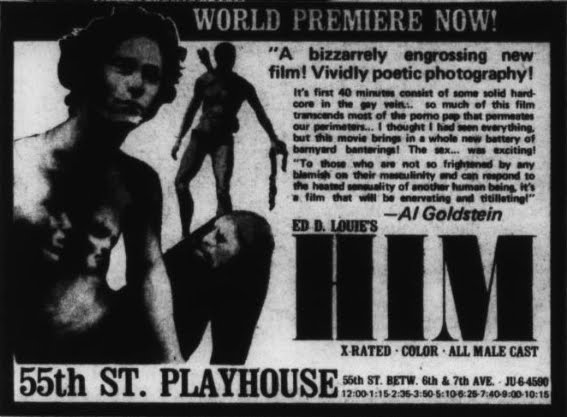
Released in 1974,
Him is a feature-length gay porno film. The movie centers on a young
man who develops a sexual fixation with the life of Jesus Christ. It was directed
by Ed D. Louie (which is thought to be an alias), and stars Gustav von Will,
under his porn name Tava. It premiered in New York City's 55th Street Playhouse
(later known as the Europa Theatre), on March 24th. This run lasted until late
May, but the movie was re-run for -of course- Christmas season throughout December
of that year. In 1976, it was picked up by a distributor, and played NYC again,
as well as Chicago, San Francisco, Philadelphia, Pittsburgh, Detroit, and Atlanta.
The movie didn't garner protests, or even infamy, and was largely forgotten
until 1979, when the book The Golden Turkey Awards listed it as the "Most
Unerotic Concept in Pornography". Yet, Al Goldstein, in his magazine Screw,
reviewed it, saying, "The sex is exciting!" Here, I'd normally say
that you should judge for yourself, but you can't. The movie has been forever
lost to time, and not even brief scenes have popped up anywhere. The flick was
one of the most sought-after lost films by the magazine Film Threat.
Many thought Him didn't even exist, and was a hoax by The Golden Turkey
Awards' authors Harry and Michael Medved, because they admitted in the very
same book that one of the films listed was made up. The real fake was Dog
of Norway, which was featured with a pic of the Medved's own dog.
Anyhow, though no one has succeeded in digging up a print, this shouldn't stop
any of you perverts from trying to hunt it down. When you think that Francis
Ford's 1913 lost film When Lincoln Paid was discovered in 2006 in a barn
that was to be demolished, or that the 1928 Carl Theodor Dreyer masterpiece
The Passion of Joan of Arc was found in 1981 in a freakin' closet of a Norwegian
psychiatric hospital, you know this film has to be out there somewhere.
-- February 29, 2020 --
Big, Big Monkey Man
Many people think
war is a product of modern man, dating back only a few thousand years. A lot
of these same people believe in what is called the "noble savage",
the idea that an uncivilized man has yet to be corrupted by civilization. One
of the earliest attributes of this falsehood comes from 1672 in the play The
Conquest of Granada by John Dryden, and later backed by Anthony Ashley Cooper,
and his 1699 book Inquiry Concerning Virtue, where he believed a moral
sense was natural. In 1964, the earliest known evidence for warfare dates to
a Mesolithic cemetery site in Sudan (Africa), called Jebel Sahaba, which is
about 14,000 years old, and holds the skeletal remains of forty-five people
who met a violent end. Even after this find, there were those that believed
war didn't date much further back than this, but as we now know, the horror
of war recedes into our evolutionary timeline as far as earliest primates. Now
known as the "killer ape theory", Raymond Dart first proposed that
war was one of the driving forces behind human evolution, in his 1953 article
article "The Predatory Transition from Ape to Man". This hypothesis
was further developed in African Genesis (1961) by Robert Ardrey. Quite
a few scoffed, but Jane Goodall helped prove it in the late 70s.
Though she had no degree at the time, Goodall began studying ape behavior at
Gombe Stream National Park (Tanzania) in 1960, thanks to grants from archaeologist
and palaeontologist Louis Leakey. By 1962, she attended the University of Cambridge,
and even though her thesis was completed in 1965, she continued researching
primates. From 1974 to 1978, she witnessed what is now referred to as The Gombe
Chimpanzee War.

It began in 1973,
when two groups, who were once unified as the Kasakela community, began to splinter
over a span of eight months. A group of chimpanzees (six adult males, three
adult females and their young), renamed the Kahama community, separated themselves,
and set up camp in the south portion of Kasakela. The original Kasakela community
was now left with eight adult males, twelve adult females and their young. In
January of 1974, six of the Kasakela males ambushed a lone Kahama male, killing
him. It was not only the first time chimps were witnessed to have deliberately
killed another chimpanzee, but also first witness to a sort of celebration of
this murder, where the six males ran around screaming, and throwing branches.
By 1978, all the rebel males had been killed, and several females had been beaten,
and kidnapped - forced to join the Kasakela community (one female who refused
was killed). With the Kahama vanquished, the Kasakela expanded into their territory.
This caused trouble with a larger neighboring tribe of chimps, known as the
Kalande. After a few violent skirmishes with them, the Kasakela abandoned their
new lands. When they moved back north, the neighboring chimpanzee community
of Mitumba, raided their colony a few times, but there were no casualties. Eventually,
all hostilities settled, and order was restored by 1979. At the time, there
were a number of academics who did not believe these events, because scientific
models of human and animal behavior hardly superimposed, but further research
proved Goodall was describing the natural state of things.
As someone who believes we are basically animals, I also know that it is no
longer so simple, and we have become more than that. I hope we can one day surpass
our primal instincts, and lead ourselves to a future where war becomes not only
unnecessary, but unheard of. Sucks we'll probably destroy ourselves before such
a thing happens.
-- February 13, 2020 --
When the Road Sings
It's an awesome
thing to be driving down the road, and finding an interesting spot along the
way - whether historic landmark, unusual tourist attraction, or amazing landscape
scenery. To really enjoy any of those, you'll have to exit your vehicle, but
there's one travel oddity that you have to stay in a moving vehicle to experience,
and it's known as a "musical road". Made up of bumps (such as Botts
dots) or grooves (like rumble strips) on the road's asphalt or pavement, driving
over them causes tactile vibration where the audible rumbling forms music. There
are a little over forty around the world, with thirty of them in Japan alone.
The first was created in Gylling, Denmark, by two artists, Steen Krarup Jensen
and Jakob Freud-Magnus, in 1995. It's an extremely short original tune composed
by the artists as an arpeggio in the key of F major, and lasts but two to three
seconds, depending on your speed.
South Korea has four of them, with their most famous being near the city of
Anyang, and it plays "Mary Had A Little Lamb".
The Ngawi–Kertosono section of the Solo–Kertosono Toll Road in Java,
Indonesia, has a segment that plays the first six notes of "Happy Birthday
To You", and it is credited with reducing the number of accidents in that
area.
The Japanese roads play many tunes, but unless you're a huge anime fan, most
may only be familiar to the locals, such as the opening track from My Neighbor
Totoro, the theme song from Spirited Away, the GeGeGe no Kitaro
theme, and the theme from Neon Genesis Evangelion, "A Cruel Angel’s
Thesis".
The Netherlands used to have a musical road near the village of Jelsum in Friesland,
but the residents complained they could hear it throughout the night, and it
was removed.
The one in Hungary is the first memorial musical road, on Road 67, and was created
after the death of the lead singer, Cipõ,
of popular Hungarian band Republic - that strip plays the first few notes of
the band's song, "67-es út".
There are three in the Unites States. The musical road in Tijeras, New Mexico,
installed on a stretch of Route 66, plays "America the Beautiful".
In Alabama, as one approaches the Auburn University stadium on South Donahue
Drive, you can hear the first seven notes of the Auburn Tigers' fight song "War
Eagle". Saving the best for last, Lancaster, California's musical road
is a whopping mess. Originally built on a quarter-mile stretch of Avenue K,
between 60th and 70th Streets, in 2008, it was supposed to replicate the finale
of "William Tell Overture", but was paved over within a mere two weeks
after noise complaints. The following month, it was recreated two miles away
on Avenue G, between 30th and 40th Streets, and called The Civic Musical Road,
because many Honda Civic commercials were filmed there. Sadly, the designers
made a miscalculation by not including the width of the groove in relevance
to the spacing - both times! - so it sounds nothing like what it's supposed
to. If you'd like to hear this audio disaster, here's a quick little documentary
on it.
Next time you travel about, and the road starts to sing to you, hopefully you're not falling asleep at the wheel, but are instead driving over a groovy tune.
-- January 28, 2020 --
Don't Bother With the Border
There are a number of places on Earth with border disputes. Japan and Russia have never signed a WWII peace treaty over who owns the Kuril Islands. There is no officially recognized border on Lake Constance, which sits in the Alps between Switzerland, Austria and Germany, because a number of treaty agreements have set up differing rules for different activities on the waters. Navassa Island is a landmass in the Caribbean, claimed by, both, Haiti and the U.S., though there's no real argument over it as it's uninhabited due to lack of water. Still, none have more issues with borders than Spain.

The island
of Gibraltar is off the coast of southern Spain, but it's under British control.
While Spain has disputed British sovereignty over Gibraltar, the residents reject
Spanish rule, and have had several referendums voting to keep their autonomy.
The island is
technically connected to mainland Spain by a half-mile-long isthmus, which is
in more of
a gray area, as Spain claims that it never officially ceded the strip of land
to the British. Gibraltar's airport, stadium, and a few housing developments
are located on the isthmus, but England claims that Spain never rejected its
use, and it controls the land by the law of prescription.
Another interesting border dispute is between a town, and the country of Spain.
Llívia is a small Spanish town, that's actually located within France.
In 1659, the Treaty of the Pyrenees ceded the area to the French Crown, but
the wording made it that only villages were to change hands, and Llívia
was considered a town (as it was the ancient capital of Cerdanya), hence it
kept its Spanish status. The citizens feel quite differently, and want to become
French nationals, because they believe Spain does nothing for them, except collect
their taxes.
The city of Ceuta is quite similar, in that it's actually outside of Spain,
except it wants to stay Spanish. The enclave can be found within Morocco, and
many Moroccan nationalists want its return, but Spain argues it had controlled
the area since the 15th Century, well before Morocco's independence from France.
Even so, the United Nations sides with Spain, probably because it's a duty-free
shopping destination for Europeans (and even local Moroccans), who may favor
retaining it for economic reasons.
My last example is a small island which also fell victim to the Treaty of the
Pyrenees of 1659. The French call it Île des Faisans, the Spanish:
Isla de los Faisanes, and Basques know it as Konpantzia - in English
this all translates to Pheasant Island. This landmass changes administration
every six months. From February 1st until the end of July, the island is under
the governance of the naval commanders of San Sebastián, Spain, and from
the first day of August
through January 31st, it is run by the naval commanders of Bayonne,
France.
This is all pretty interesting,
and it brings up a lot of questions about national borders, sovereignty, and
even identity, yet I'll admit it isn't all that bizarre. The only case of a
disputed border I'm aware of, which falls into real kooky territory is that
of Dahala Khagrabari - the world's only third-order enclave. Dahala
Khagrabari
is a small piece of India, which sits within Upanchowki Bhajni, Bangladesh,
itself sitting in the village of Balapara Khagrabari, India, that is actually
inside of Debiganj, in the Rangpur Division of Bangladesh. In short, it's a
piece of India, inside Bangladesh, inside India, inside Bangladesh. It is The
Twilight Zone of border disputes.
-- January 15, 2020 --
Art For Prank's Sake
When it comes to
abstract art, so many have uttered the words, "My 5-year-old could do that,"
without realizing that it really does take some schooling, a bit of practice,
and touch of talent to produce modern art. In 2011, Angelina Hawley-Dolan of
Boston College, and Ellen Winner from Harvard, performed a study where they
showed groups of people paired images of works by abstract expressionists against
those of a child or animal. In one grouping, the paintings were not labeled,
and in another they were credited, but the labeling was purposefully reversed
as to mislead who had created the work. Overwhelmingly, the participants chose
the work of the actual artists, over those of children or animals, proving that
people find a work more pleasing when there is artistic intent behind it.
Of course, that's not to say that there aren't those who cannot be fooled. Seeing
as there are always people willing to dish out a lot of dough, so as to be able
to have a work by the next big thing hang in their living rooms, you're likely
get a bunch of idiots, trampling one another, for the most basic of artworks.
Now, this isn't exactly a shot at Italian artist Maurizio Cattelan's "Comedian",
which was no more than a banana, duct-taped to a wall, selling for $120,000
at Art Basel Miami Beach a few months ago, but it's close. There are tales after
tale of the art world being fooled into legitimizing (and art patrons throwing
money at) the work of pranksters.
The first Salon des Indépendants was organized by Paul Cézanne,
Camille Pissarro, and Paul Gauguin in 1884, and showcased the works of many
fine artists, but in 1910 it included a painting, titled "The Sun Fell
Asleep Over Adriatic", by Joachim-Raphaël Boronali. Writer Roland
Dorgelès, and a few accomplices, tied a brush onto a donkey's tail, dipped
it in paint, and moved a canvas near it, whenever the animal wagged his tail.
To parody of the manifestos of other art schools, they also produced The
Manifest of Excessivism, to go along with it.
Paul Jordan-Smith once wrote that, "the modern critic in literature and
art was a coward, so afraid of being out of step with his generation that he
hesitated at giving honest opinion concerning art values, especially where those
values were not perceptible," in 1924. To prove he was right, he created
the fake Russian artist Pavel Jerdanowitch, and a school of art called Disumbrationist.
Creating an elaborate back story, he entered a child-like painting, titled "Exaltation",
into an exhibition at the Waldorf Astoria Gallery in New York.
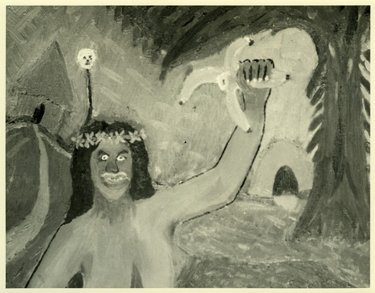
The French art
magazine Revue du Vrai et du Beau loved it, and after their review of
it ran, "Jerdanowitch" was invited to submit more work to the No Jury
Show in Chicago. That piece, titled "Aspiration" was exhibited at
Marshall Field's Gallery in 1926, reproduced in the Chicago Evening Post,
the French journal La Revue Moderne, and a full-page reproduction appeared
in The Golden Book of Modern Art. He confessed to his hoax to Los
Angeles Times in 1927.
Swedish journalist Åke Axelsson, and artist Yngve Funkegård, helped
premier the work of French painter Pierre Brassau in 1964. The paintings were
hailed by art critic Rolf Anderberg, who wrote in Posten, "Pierre
Brassau paints with powerful strokes, but also with clean determination. His
brush strokes twist with a furious fastidiousness on the canvas. Pierre is an
artist who performs with the delicacy of a ballet dancer." It was later
revealed that the artist was actually a chimpanzee, named Peter, from the Borås
Zoo.

More recently (2007),
Estelle Lovatt, a lecturer at Hampstead School of Art, posted her son's work
to collector Charles Saatchi's online gallery, claiming Fred was a well established
art critic, who studied American abstract expressionism. His pieces sold under
the name Freddie W. R. Linsky, and he was soon invited to have his own show
in Berlin. That is, until it was discovered he was only two years old.
Many of these pranks take advantage of the fact that when you buy a work of
modern art, you are not really paying for the piece, but for the name. At the
rate those names come-and-go nowadays, not all the art sold at insane prices
will stay respected, nor appreciate in value. Let's be real here, someday, Maurizio
Cattelan will probably just be known as "that banana guy", and the
fool that dished out $120,000 for his piece will have a hard time at the auction
house. Maybe
rightfully so, too.
-- January 04, 2020 --
!.?!?!.,.,!?!.,!?!?,.
I love kooky characters,
like Emperor Norton of San Francisco, or even Waco's David Koresh, but I also
love weirdoes who put out weird lit, such as Ernest Vincent Wright (releasing
an entire book without using the letter E), or William Boyd (who put out a biography
on a nonexistent artist, Nathwell Tate). Of course, this post is about the latter,
and that guy is Massachusetts' business man Timothy Dexter.
Dexter was born in 1747, to folks so poor he was sent to work as a laborer by
the age of eight. He was seen as a dunce by many of his neighbors, and was somewhat
disliked, often to the point of open ridicule. On numerous occasions, Timothy
was purposefully given bad advice so as to scorn him. One such instruction was
to buy large amounts of depreciated Continental currency, which was worthless
after the Revolutionary War. It actually turned out to be a blessing, when the
U.S. government made good on them, and he amassed a small fortune. He used that
money to build two ships, and began an import/export company. Even though he
banked, people still messed with him. Pranksters joked that he should send coal
to England. He did so, just as a miner's strike happened, and became richer.
Another joked he needed to sell gloves in China. His ships arrived right alongside
boatloads of Portuguese workers in need of handwear. Yet another yuckster told
him to send stray cats to the Caribbean. Lo and behold, the islands were suddenly
infested with rats, and people paid a premium for his felines. Sadly, as he
got richer, his contemporaries snubbed him more and more. He built a mansion
in New Hampshire, held parties, and tried to socialize, but the elite had none
of it. After some time, he realized he was his own best friend, and kept to
his garden, which he decorated with forty wooden statues of famous men - including
George Washington, Thomas Jefferson, and Napoleon Bonaparte. The largest statue
was of himself, with an inscription reading: "I am the first in the East,
the first in the West, and the greatest philosopher in the Western World".
Soon, his wife began to dislike him, too. He had enough, and wanted to know
exactly how everyone felt about him, so he faked his death. He was thrilled
when 3000 people attended his wake, but was furious seeing that his wife didn't
shed a tear. He stormed out of his hiding place, and beat his wife with a cane
for not properly grieving. Timothy really died in 1806, at the age of 59. While
his mansion became a hotel, his statues rotted away with time. Actually, most
of his legacy would have been forgotten, if it wasn't for his book.

When T.D. was 50,
he decided to release a 40-page booklet, titled A Pickle for the Knowing
Ones or Plain Truth in a Homespun Dress. In it, he ranted - without pause
or punctuation - about politicians, priests, and his unemotional partner. It
was a huge success, though people complained about the random capitalizations,
as well as lack of punctuation. In the book's second pressing, he included an
extra page with thirteen lines of punctuation, and instructions to the reader
that they should put them wherever they feel it's needed. The damn thing went
through eight editions in his lifetime. Hell, reprints are still available today.
Edith Sitwell once said, "The man of genius and the aristocrat are frequently
regarded as eccentrics because genius and aristocrat are entirely unafraid of
and uninfluenced by the opinions and vagaries of the crowd." It wasn't
until Timothy Dexter lost his care for the opinions of the crowd that his eccentricities
made him the aristocrat he longed to be in the first place, which might help
prove that we usually find what we're searching for, when we stop looking.
-- December 23, 2019 --
Merry Coltmas To All
There's quite
a few weird Christmas traditions. The last I wrote of covered Sweden's Gävle
Goat (a giant straw goat effigy that is constantly destroyed by unknown assailants),
and previous to that was the Caganer from Spain (a shitting elf placed in nativity
scenes). Ones I haven't covered, but deserve mention, are the web decorations
Ukrainians put up for Xmas (similar to Americans during Halloween), how the
Japanese flood KFC every Dec 25th (popularizing the phrase "Kurisumasu
ni wa kentakkii!", which means "Kentucky for Christmas!"), Venezuelan
citizens going to Christmas mass on roller skates, and the hiding of a pickle
on the Yule tree in Germany (a tradition that dates back to the 1600s, where
a special gift is given to the child that finds it). While I don't really celebrate
the holiday, I do like some of the oddities surrounding it, and one of the kookier
ones - called Mari Lwyd - revolves around a horse's skull.
Though
it was first recorded in 1800 by a writer only known as J. Evans, in his A
Tour through Part of North Wales, in the year 1798, and at Other Times,
it is thought by folklorist Iorwerth C. Peate to "no doubt [be] a survival
of a pre-Christian tradition". This Welsh folk custom is thought to have
once been part of the Feast of the Ass, a January 14th commemoration of the
Virgin Mary and husband Joseph's flight into Egypt on a donkey. Many believe
the name Mari Lwyd translates to "Holy Mary", but there is
evidence that it means "Grey Mare", seeing as an older horse tradition
in Ireland is the Láir Bhán, which translates to "White
Mare".
No matter how or why it began, what it entails is the crazy part. Basically,
a horse's skull is placed on a stick. Usually glass beads are placed in the
eye sockets, and a spring with a pull chord is attached to the jaw, so it can
mimic speech. The head-on-a-stick is carried by a celebrant, who is draped by
a white sackcloth. Then, he (and a party consisting of four to seven men decorated
in ribbons and colorful clothing) visits houses singing
holiday carols on Christmas morning, or sometimes on New Year's Day.

click on image for
larger view
So, yeah,
if you live in Wales, you could wake up from a nightmare, only to get more nightmare
fuel, thanks to this bizarre scene just outside your front doorstep.
Happy holidays, you weirdoes!
-- December 09, 2019 --
The Island of Misfit Toys
There have been
quite a number of children's playthings that were seen as pretty dangerous,
and had the public asking, "Who thought this was a good idea!?"
One such case was lawn darts. As a kid, I had a set, and actually enjoyed it
as was intended. It was only years later when I realized their danger, after
using them in twisted games of children's Russian roulette with the neighborhood
kids, by launching them sky-high to see who would lose their spot running from
certain death from above.
Another, which I wasn't familiar with, was Aqua Dots Design Studio (also known
as Bindeez, Pixos, or Beados). A creative game that simply consisted of beads,
which had a coating that became sticky when wet, and glued themselves to one
another, so you could create little three-dimensional figures. Problem was that
the bonding chemical was partly made from a date-rape drug, and some kids who
swallowed them went into comas.
There is one game though that really makes you wonder, and when a lot of people
hear about it, their first impression could only be described as: WTF. That
game is A. C. Gilbert Company's U-238 Atomic Energy Laboratory.

Developed by American
athlete, and inventor, Alfred Carlton Gilbert (1884 - 1961), who had released
a number of toys with educational significance, one of which was the famous
Erector Set. Gilbert was also known as "the man who saved Christmas",
after convincing the US Council of National Defense not to ban toy purchases
during the holidays throughout the First World War.
Released in 1950, the Atomic Energy Laboratory was similar to your average chemistry
set, and was an educational kit made to help teach kids about science. Only,
this thing contained four glass jars of radioactive uranium-bearing ore samples,
including autunite, torbernite, uraninite, and carnotite. The "game"
also came with a battery powered Geiger counter, an electroscope (a device that
detects the presence of electric charges), a cloud chamber (which allowed a
child to watch alpha particles travel), and a spinthariscope (a mechanism used
to observe nuclear disintegration caused by ionized radiation). Of course, the
set also came with booklets of activities, with one suggesting to play "hide
and seek with the gamma ray source", where a kid is supposed to use the
Geiger counter in helping to locate a hidden radioactive sample.
Believe it or not, while it's currently labeled "the world's most dangerous
toy" by many, the AEL wasn't taken off the market due to any of this insanity,
but as a result of its unpopularity. Costing $49.50 (about $520 today), it was
priced out of many a family's spending range, and only 5000 or so kits sold
in its two years of production. In his 1954 autobiography, The Man Who Lives
in Paradise, A. C. wrote that the Atomic Energy Laboratory was "the
most spectacular of new educational toys", and that the government backed
the set's development, as they believed it would promote a public understanding
of atomic energy. Gilbert believed the lab was unsuccessful, not due to cost,
but because it was for made for folks with an educational background, instead
of the younger crowd his company usually sold to. While it was definitely due
to the price tag, this may be true in small part, seeing as Columbia University
bought five sets for their physics department back in the day.
If you're interested in collecting this atomic oddity, on the rare occasions
they do pop up, sets now sell for about $2000 on auction sites. If you get lucky,
and snatch one up... Hell, play away! Just far enough away from me, please.
-- November 27, 2019 --
Rise
Write From the Grave
It's silly that
so many claim a, basically, board game can help someone contact the dead. Though
versions have been around since 1100 CE in China, the first publically-available
"talking board" is the Ouija, which was patented by businessman Elijah
Bond, in 1890. Around the same time, the Spiritualist Movement grew in the United
States, and people all over began talking to the deceased via a toy put out
by Parker Brothers (and later, Hasbro). While that's weird enough, it gets even
kookier knowing the Ouija board helped some reach beyond the spirit world, and
into the world of literature.
The first case of the departed dictating was in 1910, when Pearl Lenore Curran,
and friend Emily Grant Hutchings, contacted one Patience Worth, while playing
with the Ouija. Curran claimed Worth was born in Europe in 1649 (or 1694), and
was killed by a Native American after coming to the States. Pearl typed what
Patience told her, and produced two books, The Sorry Tale (1915) and
Hope Trueblood (1915). Even though the Atlantic Monthly's Agnes
Repplier reviewed the books as "silly as they are dull," PLC's best
friend (the aforementioned Hutchings) wanted in on the action, but pushed the
stakes further, by supposedly contacting Mark Twain. In 1917, she released the
tome, Jap Herron: A Novel Written From The Ouija Board.

In hopes of stopping
Emily from making money off Twain's name, his daughter Clara Clemens filed suit
against Hutchings, and publisher Mitchell Kennerley, the following year. The
lawsuit asked Hutchings to admit the book was fake, or surrender all profits
to the Mark Twain estate, and Harper & Brothers. Hutchings did not retract,
but the lawsuit was dropped when it was agreed to cease publication, and that
all existing copies would be destroyed.
Exactly fifty years later, Mildred Swanson of Independence, Missouri, told the
world Twain was now in contact with her, and published her conversations with
him, titled God Bless U, Daughter. Unlike Hutchings, Swanson had to release
the writing independently, as publishers got wise to the lawsuits putting Twain's
name on a book might bring them. One might think they'd also be against such
idiocy, but seeing how the name of American poet and author Jane Roberts is
still used to peddle the currently-in-print Jane Roberts' A View from the
Other Side (which is supposedly channeled writings about death to bullshit
artist Mary Marecek), one gets the picture it's profit over principle.
Anyhow, if you'd like to read Twain's supposed words from the afterlife, one
can check out the full text of Jap Herron at the National
Archives' website. Just don't blame me if you piss off his ghost, and he
gets all Tom Sawyer on your ass.
-- November 13, 2019 --
A Musical No-Man's Land
I posted about
a handful of musical mysteries a few months back, but there is probably no greater
musical mystery than this. There are songs that people have dug through crates
of material to find, only to come up empty handed, such as the riddle surrounding
DA's "Ready
'N' Steady". That case was finally solved in 2016 - a year after my
article on it appeared. Even though no one knew the song in question, or
had even heard the music, it was still tracked down. Yet, this mystery contains
the full ditty, but no information on the artist, or even a song title, has
yet to surface.
From 1982 to 1984, a music fan (who prefers to remain anonymous) would often
tape songs off radio shows while living in town of Wilhelmshaven, in Germany.
His favorite show was Musik für junge Leute (Music for Young People)
on their public-radio station, NDR 1. One of those tapes from his last year
of doing so, now infamously dubbed "Cassette No.4", contained tracks
from bands like The Cure, XTC, as well as twenty-three other bands. Most groups
on that tape are pretty familiar to lovers of alternative and underground music
- except for one. He held on to the cassettes for twenty years, and then passed
them on to his sister (who also wants to remain anonymous). Not knowing who
that act was drove her nuts, so she digitized the track, and, in 2007, uploaded
it to a forum for obscure 80s new wave. No one there could help, and she then
tried a Canadian website. No go there either. Nicolás Zúñiga,
of Spain's Dead Wax Records and Tres Calaveras Producciones (two labels that
specialize in synthpop and postpunk), was intrigued, and uploaded the song to
YouTube in 2011. Still no luck. Dark music nerd Gabriel da Silva Vieira of São
Paulo, Brazil, got in on it, and posted about it on the one place where almost
every mystery in the world gets solved: Reddit. Getting nowhere, even though
it was shared on several different subs, the YouTube series Tales from the
Internet tackled this enigma. 400,000 views later, and everyone's still
empty handed. Rolling Stone Magazine posted an article about the song
recently, and not a single comment proved to be helpful. People went as far
as to contact the DJ that aired the piece, and he was stumped. Here we are,
35 years after the tune was first aired, and in an age where phone apps and
website algorithms can detect a song in seconds, we are no closer to finding
out who wrote this catchy chorale.
If you're interested in giving it a shot -by all means- have a listen...
If this leaves you, like so many others, banging your head against a wall in frustration: don't say I didn't warn you.
-- November 02, 2019 --
Computer God
I'm sure you're all happy with your Windows, Mac, or Linux operating systems, but they all fail in processing one pretty significant function: linking up with the Big Guy upstairs. That's right, your computer can't communicate with God, so -if you're looking for that sort of resource task- might I suggest TempleOS?

click on image for
larger view
Created by Terry
A. Davis in 2013, and released through his own website, when it announced "God's
temple is finished. Now, God kills CIA until it spreads." Terry was considered
by many a true programming genius, and was thought to be the next Steve Jobs
by a number of computer engineers, but after being diagnosed as a manic depressive
(and later schizophrenic) he had spiraled downward since. Davis began work on
TempleOS in 2003, under its original name: J Operating System. In 2008, he changed
the name to LoseThos, and then SparrowOS. Around the time of the second name
change, Terry claimed to have received instructions from the Universal Lord
to reprogram the system to be more biblically-themed. He claimed the OS would
be the prophesied "Third Temple", which would usher in the age of
the coming Messiah. The system he finally developed has 640 x 480 resolution,
16-color display, and single audio voice, as per God's instructions, and functions
as a 64-bit, non-preemptive multitasking, multi-cored, public domain, open source,
ring-0-only, single address space, non-networked, PC operating system for recreational
programming. The system came with an original flight simulator, compiler (which
translates computer code from one programming language to another), and a few
games - one such was After Egypt, where a player visits a burning bush,
and (using a stopwatch) a Ouija-like oracle generates text, meant to be some
sort of fortune-telling. With over 100,000 lines of code, TempleOS was written
by Davis in his own programming language, based off C and C++, which he titled
HolyC. That alone blew the minds of many a tech nerd.
The last update for the operating system was in 2017, because Terry met a sad
end the following year (after a few bouts of homelessness and incarceration)
when he walked in front of a Union Pacific train, on August 11th of 2018. It
is not known if he committed suicide, or if it was an accident, though most
believe it was the former.
If you are curious to run TempleOS, you can visit the website dedicated to the
system, and its creator (here),
then let me know if you actually get in touch with The Almighty. I have some
hard questions for that sumbitch.
-- October 21, 2019 --
Ready Player One
There's been a
lot of unfounded speculation the last few years about how video game violence
leads to real world violence, even though a number of articles in research journals
state otherwise, such as Human Communication Research (2001), Journal
of Adolescent Health (2001), Journal of Pediatrics (2009), and most
recently in Psychology of Popular Media Culture (2015). Even so, this
post isn't about violent games causing real world violence, but about real world
violence causing a video game.
I'm sure most readers of this blog already know about the Aum Shinrikyo doomsday
cult. Starting in 1984, in a cramped one-bedroom apartment in Tokyo by Chizuo
Matsumoto, the cult mixed ideas from yogic studies, Tibetan Buddhism, Hinduism,
the Christian Book of Revelation, and the writings of Nostradamus.

While the sect
had several books out already, Matsumoto, in 1992, under his new name of Shoko
Asahara, released Declaring Myself the Christ: Disclosing the True Meanings
of Jesus Christ's Gospel. Around this time, the group began to really stress
their belief we were entering the end times of a Biblical apocalypse. Seeing
nothing special happening, they decided to try to hurry Armageddon along. In
1993, members stood on the roof of the cult's headquarters, and sprayed into
the air large quantities of liquid containing Bacillus anthracis spores
(aka: anthrax). Besides a few complains of a bad odor, no one got sick. The
following year, the gang upped the ante, and drove around in a converted refrigerator
truck, releasing clouds of sarin gas. Again, no one was injured. The clique
backed off for a bit, and used their homemade chemical weapons to kill a few
individuals, who they felt slighted them. In March of 1995, a number of members
coordinated a chemical attack on five Tokyo subway trains, killing 13, seriously
injuring 54, and affecting the health of close to another 1,000 people. Japanese
authorities arrested Matsumoto/Asahara, along with another 11 cult associates.
In July of 2018, Shoko and five more members were executed by hanging on the
6th, and the other six were hanged on the 26th.
During their
heyday, Aum Shinrikyo published hundreds of books, tens of instructional videos,
even music videos and cartoons, but they also released a video game. Titled
Kamikuishiki-mura Monogatari, it was released during the 2003 trial by
the sect's computer graphics arm, Aum Soft. The game is a poor quality life-management
simulator, where a player attempts to successfully deploy chemical agents in
targeted trains. As one plays, images of Matsumoto/Asahara in, both, real life,
and cartoon form, pop up throughout. Random videos of cult members singing and
dancing, cut in and out, here and there. If you make it to the end, you get
to watch an Om symbol, and hear the Aum Shinrikyo’s official theme song
for three whole minutes. Hell, if you're curious about it, why not watch someone
play it in its entirety here...
In the year 2000,
Shoko's sons took over the small religion, changing its name to Aleph (the first
letter off the Hebrew alphabet), and claimed close to 1,600 members. In 2007,
the Russian faction branched off, and changed its name to Hikari no Wa (aka
The Circle of Rainbow Light). Both churches are branded as terrorist groups,
and are heavily monitored by Japanese, European Union, Russian, Canadian, and
even U.S. authorities. Even so, this didn't stop Aum Shinrikyo sympathizer Kazuhiro
Kusakabe from ramming a car into a crowd of people on New Year's Day of this
year, injuring nine.
Video may have killed the radio star, but a cult following helped a video game
memorialize their leader.
-- October 09, 2019 --
Freakishly Flashy Fish
During the
mid-1800s, French physicist Edmond Becquerel (1820 - 1891) became an early experimenter
in photography, and discovered a number of treatments and techniques, which
propelled the science behind taking pictures.
In 1895, Wilhelm Röntgen (1845-1923), a German mechanical engineer and
physicist, ran a high voltage of positive and negative electrodes through a
glass vacuum bulb. He noticed the tube would give off a fluorescent glow when
he did this. Röntgen
then shielded the glass with black paper, and noticed only one specific spectrum
of light would pass through it. When
he waved his hands near it, Wilhelm could see his bones. He
then had his wife,
Bertha, place her hand on a sheet of photographic film, and shined the greenish
rays upon it, taking the world's first X-ray photograph.
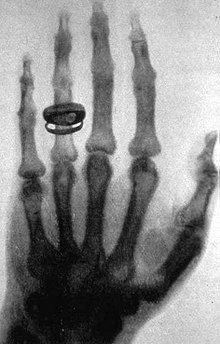
Later, in
1896, Edmond's son, Henri Becquerel (1852 - 1908), through his love of his father's
work, and an interest in Röntgen's
then-recent discovery of X-rays, helped discover radiation. Originally, Henri
set up wrapped photographic plates out in the sun, with phosphorescent uranium
salt crystals atop of objects, such as keys and coins. When he developed the
plates, the objects shined. The younger Becquerel, believing the crystals absorbed
radiation from the sun, he attended the French Academy of Science to show his
findings. The skies were overcast on that February 24th, so he placed the plates
in a drawer, with some of the uranium crystals, overnight. Curious, he developed
the plates anyway, and discovered - completely by accident - that even though
left in the dark, the uranium cast bright spots on the plates. On March 2, Henri
reported to the Academy that the uranium salts emitted radiation themselves,
with no help from sunlight. Though photographer Abel Niepce de Saint Victor,
actually made the same mistake forty years earlier, in 1857, and even reported
his findings to the French Academy of Science, no one followed up on it, so
Henri Becquerel, along with Wilhelm Röntgen, are now known as the fathers
of radiographic photography.
Fast forward to 1946, and the United States blasts two fission bombs, named
"Able" and "Baker", over the Pacific islands of Bikini Atoll.
The following year, biologists from the University of Washington (working for
the Bikini Scientific Resurvey, who, in turn, were funded by the U.S. Atomic
Energy Commission) set out to see how the bombs affected the local wildlife,
capturing and collecting biota, including wrasse, flounder and clams. The scientists
then took the animals, and placed them on photographic plates, in an attempt
to measure if they not only absorbed, but also retained, radiation. Those performing
the experiments expected to see little, if any, thinking the ocean would disperse
and dilute the radioactive material. No one liked what they found.

In fact, the photos showed there was a lot of radiation still in the area, and most of it in the animals were centered around the digestive system, due to them eating other radioactive animals.

This brings us
to today, and what's happening to our oceans after the Fukushima Daiichi nuclear
disaster, which happened on March 11th of 2011, in Okuma, Japan.
From that very day, when waters after a tsunami flooded back-up generators of
the Fukushima Nuclear Power Plant, large amounts of radioactive isotopes had
spilled into the Pacific Ocean, nonstop, until 2013. Though reports from the
United Nations Scientific Committee on the Effects of Atomic Radiation, and
World Health Organization, say the fish pulled from the surrounding area contain
levels lower than standards say is unsafe, millions of people are calling it
quits on a seafood diet for now.
After seeing these pictures from the past, I'm positive I'm not quitting my
vegetarian diet anytime in the near future.
-- October 01, 2019 --
Ready For (A Local) War
In case you missed the news on my updates page, Ready For War: The Florida Edition, is now available.

My new fanzine
has never-before published photos, collecting 48 punk and metal battle jackets
from my current home state of Florida. Beautifully done, with thick cover, and
glossy full color interior pages.
Limited to only 100 (signed and numbered) copies, half the stock is already
gone! The zine is $8 postage paid in the U.S., while adding another $6 outside
the country.
UPDATE: All copies are now sold out.
-- September 26, 2019 --
False Flags From Flying Objects
Though in use for decades, the term "false flag operation" gained in popularity this decade. It's commonly used today to claim school shootings are the work of the government (so as to give reason in confiscating our guns), but the truth is that they do exist, big and small. I'm not an Alex-Jones-type of conspiracy theorist, but I do believe - scratch that - KNOW there are conspiracies, especially of this kind. The USS Maine, half of the Gulf of Tonkin incident, and even the fact that someone in the U.S. government had the balls to propose Operation Northwoods, says a lot about what is going on in Western politics to begin with. There are even false flag operations against single citizens, such as the one perpetrated against UFO researcher Paul Bennewitz, Jr. (1927 - 2003).

Paul was a just
your average businessman operating a small electronics company, until 1979,
when he kept seeing mysterious lights above Kirtland Air Force Base, the Monzano
Storage Area (then the U.S.’s largest nuclear storage facility), and the
Coyote Canyon Test Site, all of which are around Albuquerque, NM. He began investigations,
leading him to contact the Air Force, as well as the local government, to ask
if anyone had noticed, or know of anything they could let him in on. Sadly,
this put him on U.S. security services' shit list. He was visited a few times
by agents of the Air Force, including their Office of Special Investigations.
Then, it all took a turn towards insanity - literally. Soon after his queries,
Bennewitz received a secret message on his computer. He claims he picked up
a transmission, where a weird voice spoke about secret alien experiments 150
miles north of him, at Dulce Air Base. The message mentioned the aliens were
going to enslave mankind in an upcoming war. He tried to distribute the information
he had gathered, through pamphlets and professionally produced documents. Some
of these reached Arizona's Aerial Phenomenon Research Organization, and they
sent one of their investigators, William Moore, to befriend Paul, as well as
look into all the data collected. Moore was well-known in the field of UFOology,
as he had written, both, The Philadelphia Experiment, and The Roswell
Incident. By 1981, William had not only convinced Paul he was on the right
track, he began to share other documents with him, such as those on "Project
Aquarius" (a supposed exchange between MJ12 and aliens from Zeta Reticuli).
Bennewitz would then dispense this information throughout the UFO community.
The only problem was that many laughed at him, calling his findings preposterous.
Paul, not understanding why people weren't taking him seriously, quickly became
paranoid. Within a year, he was hospitalized three times for exhaustion, and
was once institutionalized in a psychiatric ward. To the UFO research community,
this forever solidified Bennewitz as someone not to be believed, discrediting
all of his previous work.
Here, many tend to ask, "What's the big deal about a crazy person going
crazier?" Well, Paul Bennewitz wasn't mad, so much as he was driven there.
Years later, William Moore was exposed as being an agent provocateur of sorts.
It turns out Bill was being paid by the Air Force, as well as the Central Intelligence
Agency, to distribute disinformation; admitting so himself, in 1989. Poor Paul
had stumbled upon the testing of secret military helicopters, and - wanting
what he already knew to be dismissed - made his earlier claims invalid, by making
his newer claims seem insane.
This is just one of many confoundingly real conspiracies, that are hidden within
a fake conspiracy, which only helps drive home the Socratic paradox of discovering
that the more we learn, the more we learn we know nothing. So educate yourself
as much as possible, because you can try not to be a victim of the system, but
you still might get hurt somehow.
-- September 10, 2019 --
Accruing Massive Overdue Fees
There is a long-running
internet joke known as "Rule 34", which states, "If it exists,
there is porn of it." Though much less-perverse, there's another lesser-known
rule, and that is: Anything you can think of, there is a "world's largest"
version of it. In the U.S. alone, there's the world's largest chess piece (St.
Louis, MO), wind chime (Casey, IL), cowboy hat (Seattle, WA), rollerskate (Beatleton,
VA), and cuckoo clock (Sugarcreek, OH). Speaking of Ohio, Cleveland once had
the world's largest of something, but lost it.
In the summer of 1936, the state of Ohio had a Worlds-Fair-like event, called
The Great Lakes Exposition. It had a midway, with carnival rides, a freak show,
and a multitude of exhibits (including the multiethnic "Streets of the
World"). At the entrance to it all was The Golden Book of Cleveland, a
6,000-page, 5,000 lb (2,270 kg) book, where visitors could sign their name.
It was 7 ft long, 5 ft wide and 3 ft thick (2 x 1.5 x 1 m), basically the size
of a queen mattress, and, by the end of the exposition in October, it had collected
a half-million signatures. The tome's cover was, of course, gold, and displayed
the year, a portrait bust of a Native American, and an image of Cleveland's
landmark Terminal Tower. But, strangely, though
it was heralded as "the largest book in the world", it disappeared
not long after.
While there are no surviving photos of the book itself, there are quite a few
copies left of its 5 x 3.5" (13 x 9 cm) replicas, which were sold at the
event.

Though no one knows
what really happened to the book, one person claims to kind of know. After Cleveland
Magazine ran an article about the missing tome in 2006, a 70-year-old artist
for children's animation, named Al Budnick Jr., contacted the magazine to fill
them in on what he knew. According to the illustrator, his parents bought a
home in 1945 in the Cleveland suburb of Bratenahl, and inside the garage was
The Golden Book of Cleveland. The family kept the book for some time, attempting
to contact the mayors of, both, Bratenahl, and Cleveland. With neither responding,
he placed a sign for its sale in 1953, after needing the garage space for a
relative's living quarters. A doctor, whose name he can't recall, was moving
from the area to Arizona, and wanted the book. Budnick Sr. said he could have
it for free, but the man insisted on paying $200 for it. Al Jr. especially recalled
this, because he said he had never seen a $100 bill before then. Sadly, the
trail ends there.
For the few that might wonder how/why the book wound up in someone's garage:
it turns out the house previously belonged to the late president of the W.M.
Pattison Supply Co., William H. Smith Jr. The factory happened to be only a
block away from the main gate of the Great Lakes Expo. It's thought that Smith
was offered to store the book at his nearby company. After some time of local
politics changing faces (and forgetting about the book), he saw its historic
value, and decided to keep it, instead of throwing it out.
Many a sleuth (internet, professional, and otherwise) has tried to find this
mysterious doctor who moved to Arizona, but none have had any luck. Therefore,
the world's biggest book may still be out there, somewhere, so you should go
check your garage now.
-- September 01, 2019 --
The Sounds of A Swarm
156 has a new release out, and it's a record on a postcard!
It's one song (from
the Memento Mori sessions, where all sounds were produced using human
bones) on a 5" x 7" postcard, with three track download.
$2 will get you two copies, $3 equals five of them, and for $5 I'll send you
ten postcards.
These are limited to only 500 copies, with only a little over 150 left, and
are available from the 156
Bandcamp page.
-- August 26, 2019 --
To Be Or Not To Beatles
I love a good mystery,
but a musical one is tops in my book - solved or not. What happened to Q Lazzarus?
Was the theft of Green Day's Cigarettes & Valentines album of demos
a publicity stunt? Where is Manic Street Preachers' Richey Edwards? Did Pink
Floyd write 1973's Dark Side of the Moon LP with The Wizard of Oz
in mind? Who was Klaatu? Hadn't heard that last one? Well, lets get into that.
In September of
1976, Capitol Records released an album without any advertising for it, nor
giving the disc a record release party, or other fanfare.

Besides the band
name of Klaatu on the front sleeve, there was absolutely nothing else on the
record to let you know anything about the act. No group pic, or band members
were listed. No liner notes, recording information, or "thank you"
list was found anywhere inside. Copies of the LP were sent to newspapers and
magazines throughout the world with no onesheet or bio, yet many gave the disc
a great review. Some compared the vocals and harmonies to The Beach Boys, but
most thought it sounded just like The Beatles. This is where things took an
even weirder turn.
Because of The Beatles' long hiatus from recording (their last being Let
It Be in 1970), many began to believe this was a secret Beatles' album -
starting with Steve Smith, who - writing for Rhode Island's The Providence
Journal - ended his review with: "Klaatu could very well be an anonymous
reunion album by The Beatles." Journalists and music fans began to search
for clues, including watching 1951's The Day The Earth Stood Still, because
Klaatu was the name of the robot in the movie, and the Canadian version of the
record was titled 3:47 EST (the time in the movie the spaceship lands).
When reached for comment, Capitol Records kept quiet, neither confirming nor
denying. By the start of 1977, they began to advertise for the disc, with full
page ads in Billboard, yet dropping no new hints. Other bands got in
on the hype, and The Carpenters even did a cover of one of the album's tracks
on their Passage LP (1977).
Sadly, it all ended just as quickly as it took off. Later that year, a program
director at Washington DC's WWDC Radio, Dwight Douglas, decided to petition
the U.S. Copyright Office for the record's paperwork. There, he found the names
of the band members: Terry Draper, John Woloschuk, and Dee Long. Turned out
Klaatu was actually a trio from Canada, who had never meet any of The Beatles.
Once this was discovered, the record stopped spinning at radio stations, and
sales plummeted. The band's follow up, Hope (1977), reached No. 83 in
the U.S., but the next three records (Sir Army Suit [1978], Endangered
Species [1980], and Magentalane [1981]) failed to chart outside of
Canada. Members of the band claim that, while they enjoyed the comparison, they
never had anything to do with referencing The Beatles. Even so, people stopped
caring, and no one thought there was anything left in Klaatu.
If you'd like to check out what the band's debut album sounded like, here you
go...
If there's any magic in this collection of songs, or at least enough to cause such as rumor, hype, and publicity, feel free to judge for yourself.
-- August 13, 2019 --
Rock Around the Block
A marathon is already a pretty long distance to run; 26.2 miles (41.1 km). Though I'd never run anywhere near that far, I get that they are a challenge many want to attempt to overcome. Even so, there are a few who see a simple marathon as a joke, and have joined races that go much, much farther, such as South Africa's Comrades Marathon, which measures at 54 miles (87 km). Still, that's not even close to the world's longest race. That record is held by Sri Chinmoy Self-Transcendence 3,100 Mile Race. You read that right: 3,100 miles (4989 km).

The world's longest
certified footrace started in 1996, when Indian spiritual leader Chinmoy Kumar
Ghose (1931 - 2007), better known as Sri Chinmoy, created a 2,700-mile (4,345
km) race. The following year, he extended it to its current distance. Chinmoy
founded the race for runners to "transcend their own previous capacity
... gain spiritual insights ... overcome the entire world's preconceived notions
of possibility".
Taking place every year for 52 days, from June to August, in the Queens borough
of New York City, runners circle just one city block in the neighborhood of
Jamaica. The whole race runs only along the sidewalk of 84th Avenue, Grand Central
Parkway, 168 Street, and back up to 84th - a total of 5,649 times around and
around. From 6am to midnight, racers can spend their time however they want;
whether running, walking, skipping or crawling. With the "track" closed
for a measly six hours, that's all many get to eat, sleep, and tend to their
foot wounds.
Since it began, less than 50 people have finished this race. Ashprihanal Aalto,
a postman from Finland has completed it 14 times (setting a record of only 40
days in 2015 = 77 miles per day), and the woman's record is held by Slovakian
Kaneenika Janakova at 48 days. American Yolanda Holder was the first to walk
the entire distance of the race in 2017. Plenty have given up mid-race, and
some have even been sent to the hospital during. Participants are known to lose
over 20 - 30 lbs (9 - 13.5 kg) in the race, as it burns up to 10,000 calories
per day. While many think Sri just had a great sense of humor, most runners
say they fully understand everything he said the race was for, as quite a few
have reached altered states of mind while running it.
If you feel you need to run and run, by all means join in, as the race is open
to all. Now, if you're running from inner demons, it might be best to just see
a shrink, because this race will, literally, get you nowhere.
-- July 30, 2019 --
Another Log for the Fires of Love
Lots of people are looking for love. A few still go to bars, hoping to meet someone, but many others use the most modern of technology, like the internet, and all of its matchmaking websites. Still, there are those who rely on the use of more old-fashioned methods, such as the power of nymphs or wood sprites to hook them up with that one partner who is just right. Strangely, this method has a pretty good success rate, too. The most efficacious is a 500-year-old oak tree, in Germany, just outside the town of Eutin (about 100km northeast of Hamburg), deep in the Dodauer Forest, called Der Bräutigamseiche (or "The Bridegroom’s Oak").

In 1890, two love-struck
locals, Minna and Wilhelm, were forbidden to see each other. They began to use
the ancient oak as a secret spot to hide notes to one another. In June of the
very next year, the couple was wed under its branches. Within no time, rumor
had it that the tree was to thank, and other natives started leaving notes of
their own, asking the tree for help in their love lives. By 1927, the tree received
so much mail, Deutsche Post (the German postal service) gave the mighty oak
its own postal code, and dedicated postman. They installed a ladder, leading
up to a small post box, where folks could walk up, and, either place their own
love letter, or grab, read, and respond to another's. While it's the only place
known where you are allowed to open mail that isn't directly written to you,
there is one rule: you have to put back the letters that didn't interest you.
There are other magical legends surrounding the tree; the most well-known is
that if, under a full moon, a girl were to walk around the tree three times,
thinking of her lover (without speaking or laughing), she will be married within
the year. Although many of these myths are quite pagan in origin, Christian
church services are held at the tree yearly, every Whit Monday, as a part of
the Pentecost celebrations.
Today, Der
Bräutigamseiche gets about a thousand pieces of mail a year, mostly
during summer. The Bridegroom's Oak is said to be responsible for over one-hundred
marriages, and even Karl-Heinz Martens, who was the tree's longest running postman
at 20 years, once found a letter, and wound up marrying the writer.
If you are interested in trying to get the oak's blessing in all things amor
and eros, write to:
Bräutigamseiche
Dodauer Forst
23701 Eutin
Germany
May the spirits of the forest look upon you with grace. I'm sure it'll work better than eHarmony, anyway.
-- July 18, 2019 --
Ship Ahoy
I'm sure many of
you are aware of the laws of unintended consequence, popularized by sociologist
Robert K. Merton. The three groups of such being: unexpected benefit, unexpected
drawback, and perverse result. In this post, I'll be writing of the third type,
and a story that many of you may not be aware of, which is how the RMS Titanic
sunk another ship, years later.
The SS Eastland was already a troubled ship even before it sank in 1915.

Commissioned by
the Michigan Steamship Company in 1902, and finished the following year by Jenks
Ship Building Company, the vessel wasn't named until just before its inaugural
voyage. Once in operation, a design flaw of being top-heavy proved to be problematic,
and caused the Eastland to list (a nautical term for "tipping to
one side") several times. It probably didn't help that the ark's stern
was damaged when the tugboat George W. Gardner mistakenly backed into
it. Hell, the Eastland even suffered a mutiny, where firemen (who claimed
to not have received promised meals) stopped feeding coal to the boiler, and
were later charged, and jailed.
Now, about the Titanic. One of the reasons so many died in that tragic
1912 disaster was that there were too few lifeboats. This, in turn, caused the
U.S. Senate to pass the Seamen's Act (also known as the Act to Promote the Welfare
of American Seamen in the Merchant Marine of the United States, or Longshore
and Harbor Workers' Compensation Act) in 1915, which stated a number of provisions,
one being that the number of lifeboats would be proportional to fit the amount
of passengers carried by a ship. Can you see where this is going?
On July 24, 1915, the Eastland, along with four other vessels, was chartered
to take employees of Illinois' Western Electric Company across Lake Michigan,
to a picnic in Michigan City, IN. That morning, 2,572 passengers jammed aboard.
With the number of added lifeboats, combined with the previous issue of listing,
the Eastland, while still docked in the Chicago River, tipped over. Though
the ark was only 20ft (6m) from the wharf, and despite a quick response from
the nearby boat Kenosha, 848 people died.

By adding supplementary lifeboats, I'm sure the Seamen's Act of 1915 saved a number of lives, but it may have taken about as many - just like passenger-side airbags in cars actually led to an increase in child fatalities. Sadly, the fact that these consequences are unforeseen means we can expect many more similar circumstances in the future (from social to environmental). It also shows that when we make decisions, we have to take into account as much as possible. I hope this helps many understand other issues we're facing such as the opioid crisis or climate change, but I'm afraid many will just be overwhelmed by the growing number of factors that affect a situation, and just quit. Well, the truth is that quitting may be the best road for mankind to take anyway. Quit expanding, quit accumulating, quit the bullshit.
-- July 03, 2019 --
Pet Peeves
Before the last
election, and a bit after, a lot of people were talking about Trump University
(aka Trump Wealth Institute), and the inquiry opened by the New York Attorney
General's office for illegal business practices. The case stemmed mostly from
allegations that Trump U defrauded students. I'm no fan of Orange Asshole, but
I don't see the big deal, especially when - in the U.S. and abroad - there are
more than a hundred fake universities. As a matter of fact, there are so many,
people often prank them by getting diplomas for their pets - including seven
colleges/universities, three "high schools", and several other associations
that hand out certificates of membership/completion of some type.

Albany, NY, tv
reporter, Peter Brancato, applied to and received an associate degree for his
dog Wally, from Almeda University in 2004.
In 2007,
Australian comedy host Chas Licciardello, of the tv show The Chaser's War
on Everything, got a medical degree for his dog Sonny from Ashwood University.
The Ledger, a Lakeland, FL newspaper, obtained a high school diploma,
in 1973, from Washington High Academy for a cat named Spanky, under the pseudonym
Kitty O'Malley.
In 2004, the British physician and science journalist, Ben Goldacre, wrote an
article for The Guardian about how he received a diploma in nutrition
from the American Association of Nutritional Consultants
for his cat Henrietta.
The American University of London offered a four-year-old male pupper, named
Pete, an MBA for £4,500 in 2013 (without asking for any course work to
be done).
In 2004, Pennsylvania's attorney general, Jerry Pappert, sent Dallas, TX's Trinity
Southern University $299, and got his cat, Colby Nolan, a bachelor's degree
in business administration.
Time Magazine reported in 1984 that Sassafras, a female poodle belonging
to a NYC physician, obtained a diploma from the American Association of Nutrition
and Dietary Consultants, for only $50.
While these are some of the better known cases, there are many more. A tuxedo
cat, Oreo C. Collins gained a high school diploma from Jefferson High School
Online in 2009. In 2010, attorney Mark Howard received a degree for his dog,
Lulu, from the US Virgin Island's Concordia College. A cat owned by Chris Jackson
(of the BBC show Inside Out North East & Cumbria), had him registered
in three professional organizations: the British Board of Neuro Linguistic Programming,
the United Fellowship of Hypnotherapists, and the Professional Hypnotherapy
Practitioner Association.
Now, those are just diploma mills that gave credentials to animals, but there
are hundreds that didn't, and some still operate today. There is/was Saint Regis
University (and its later incarnation James Monroe International University),
Tri-Valley University, University of Northern Virginia, Herguan University,
Oikos University, Silicon Valley University, and so many more that Wikipedia
has a whole page listing "unaccredited
institutions of higher education".
I get that - with the current cost of college - many look for ways to cheat
the system, but if you pay for this type of education, and you're not out to
run a scam yourself, you're no smarter than cats and dogs.
-- June 18, 2019 --
Attack of the Airwaves
Most everyone is
familiar with the panic created by the 1938 airing of the War of the Worlds
radio drama, broadcast on October 30th by CBS. Though the amount of fear and
confusion the show actually caused has been disputed, the publicity of the event
helped to launch the career of Orson Welles, who was the show's narrator.

What very few people
know is that this event happened again, but the outcome was very, very different.
On February 12th of 1949, Ecuador's most popular radio station, Radio Quito,
decided to air a Spanish version of the H.G. Wells classic. Unlike the U.S.
airing, the station made a, literally, fatal mistake. The broadcast company
didn't air warnings that it was all fiction. The transmission began with a folk
duo singing a traditional popular song, when they were suddenly interrupted
by a "news bulletin" saying Martians had landed in Latacunga, Ecuador,
and the city was being destroyed by powerful beams of light. The announcer claimed
the aliens were now headed towards Ecuador's capital city of Quito, with another
stating he was atop the tallest building there (La Previsora bank), and could
see monsters coming, destroying everything in their path. Throughout the performance,
actors playing government agents would give instructions as to what the citizens
needed to do. By the middle of the show, the city's police and fire crews were
setting up sites to tackle injuries, and fight the invaders. The military took
positions of defense. Men and women ran into the streets with bags packed, and
headed for the hills, as hundreds of others stormed churches thinking them to
be safe havens.
Just before the end of the program, the producers realized what was happening
outside, and issued a disclaimer, admitting it was a dramatization. This angered
thousands, and crowds gathered surrounding the station. As most threw rocks
at windows, a few poured gasoline about the building, which also housed the
city's newspaper, El Comercio. Fires were lit, and the place went up
in a blaze. Hundreds of innocent people inside the building trampled one another
to escape the flames. Police and firemen were late to arrive, as they were busy
waiting elsewhere to fight the nonexistent threat from space. Up to twenty people
lost their lives that night, with many of them being employees of the radio
station and newspaper.
The next day, many didn't even know what happened, as there was no radio broadcast,
nor morning paper (the other daily in the city, El Dia, only printed
evening editions). After some time, the producers were indicted on charges,
with Eduardo Alcaraz fleeing to Mexico, and Leonardo Paéz, hiding out
in Venezuela. Both, Radio Quito, and El Comercio were rebuilt, but established
their headquarters in another town, where they remain to this day.
Since this tragedy (and another similar event in Chile), a number of conspiracy
theorists, such as Daniel Hopsicker, claim they are psychological experiments
funded by The Rockefeller Foundation, to observe the effects of mass hysteria.
You don't have to be crazy to believe any of this, but it certainly might help.
-- June 06, 2019 --
No Man's Land
I like weird facts
about small towns. I dig that there's a whole town for sale (Story, IN, for
$3.5 million), and knowing there are ghost towns throughout the world (such
as the infamous Pripyat, Russia, where the Chernobyl accident happened in 1986,
and Centralia, PA, where a raging coal fire has forced people to leave town
since 1962). I've written a bit about some, like Agloe, NY (a fake town that
became real, then faded away), and more recently Crush, TX (which was built
for a publicity stunt). Many of these strange little towns were built with a
purpose, but when that purpose is gone, so goes the population. There are a
handful that remain because their objective still carries direction and function,
but that doesn't stop them from being quite odd.
One great example is the tiny town of Hogan's Alley in Virginia, which was established
in 1987. Like many small towns throughout the United States, the primary road
veins right through the middle of it, with a number of side roads connecting.
On the main strip there's the Biograph Theater, a drug store, a bank, your typical
post office, a laundromat, barber shop, pool hall, and The Dogwood Inn, which
is the local motel. There are cars parked here and there, and a few homes scattered
about, but not many, because not a lot of people actually live here.

I mean, there are
residents, but they don't stay very long. It could be because of the constant
bank robberies, movie theater shootings, terrorist activities, bar room drug
deals, or any number of the major crimes that happen here every day. It may
also be because those who live in the town are paid to stay only a little while,
as all the citizens are merely actors. Crisis role players in fact, pretending
to be either criminals, or innocent bystanders. If you haven't guessed it already,
Hogan's Alley is a town built for F.B.I., D.E.A., U.S. Marine, and other law
enforcement tactical training. The town sits on 10 acres (40,000 sq meters),
in the city limits of Quantico. Owned by the Federal Bureau of Investigation
Training Academy, the on ground scenarios involve investigations, evidence processing,
arrests, searches, and full on shoot outs. The intelligence service hired Hollywood
set designers to construct every facet of the town, including the furniture
inside every working shop along the main street. The mailboxes were so real,
they had to be legally sealed shut, in case anyone wanted to put mail in them.
Though Hogan's Alley is off limits to civilians, there are those rare times
when the Academy holds tours, so if you find yourself in the area, see if they're
holding one, because I'm sure it would be cool to tell people you got to walk
around a little town no one is normally allowed to go in.
-- May 23, 2019 --
Write About That Funky Music, White Boy
For those that
missed out on my well-reviewed, sold out fanzine, Musica Obscura, I have
performed a massive labor of love, and uploaded every article in the zine, plus
over 10 others to one page. Some works have even been expanded with extra tracks!
29 articles on
bizarre and rare music from around the world, photo journals of odd music events,
and written pieces on porn stars, murderers, and cults who released music.
Click here
to check that out. Enjoy!
-- May 09, 2019 --
What's A Man Worth These Days?
Quite a number of people live unfocused lives to the point where they'll hire a life coach to help steer them in some direction, or other. There are plenty who might imagine life as a nightmare being under the control of someone else. Well, one person definitely didn't think it was all that bad, but he didn't give up his autonomy to just one. Mike Merrill has got to answer to a whole board of directors.

Mike was born and
raised in the ultra-tiny town of Coldfoot, Alaska. Wanting to get out, and see
more of the world, he joined the military, but found that wasn't his bag. A
friend suggested he come with him on his move to Portland, Oregon, and Mike
thought it a good idea. While living in the City of Roses, Merrill floated from
job to job in the non-technical sectors of the tech sector, but found them all
to be somewhat of a dead end. As 2007 was coming to a close, and tired of his
life going nowhere, he landed on a plan. First, he tallied up the worth of his
free time (nights and weekends), and came up with a figure of $100,000. Then,
on January 26, 2008, he announced an Initial Public Offering for those interested
in buying stock in... Mike Merrill. He would be dividing himself into 100,000
shares at only $1 a share. Though retaining a majority himself, he set his as
nonvoting, and granted 100% of decision-making power to investors. He set up
a website (see here), and
they were allowed to vote "yes" or "no" on life decisions.
In the first ten days, twelve of his friends purchased 929 shares. After an
article in Hacker News about Mike's stock, San Francisco software engineering
director Gordon Shephard bought over $6000 worth of his life, driving the share
price up to $11.75. Once stories appeared in The Atlantic, Wired,
and airing on The Today Show, Merrill's stock rose to $18 a share, though
it's currently around $4. Mike has let his investors vote on whether he grew
a mustache (resounding no), and become a vegetarian (okayed), to deciding if
he would get a vasectomy (a close no), and switch to a polyphasic sleep schedule
(big thumbs up). They even voted on his love life, and which political party
he should register with.
Mike Merrill says he has no regrets, and has enjoyed the past eleven-year experiment;
probably because the vasectomy vote didn't pass. Still, it's odd to lose control
of your life choices , but many of us give it freely to people who haven't even
paid for the privilege.
-- April 25, 2019 --
But... Priests Don't Lie
You know there are weird and interesting things in the vaults of the Vatican. Some are rare books, a few records of deeds and misdeeds, tons of religious and historical relics, the bones and body parts of saints, and, surely, an invention or two - one of which is, most certainly, the Chronovisor; a television-like instrument which can see into the past (and maybe the future).

Supposedly, it
is the invention of a handful of priests, and scientists, but I'm getting ahead
of myself. Let's go back in time to the beginning of the story.
While traveling across the Grand Canal of Venice, sometime in the 1960s, French
priest François Charles Antoine Brune met Italian physicist-turned-priest
Father Pellegrino Maria Ernetti. The two discussed Biblical miracles, and when
Brune said it would be wonderful to actually see these events, Ernetti let him
in on a secret he had been keeping since the mid-50s: it was totally possible
to do so. Ernetti told him about an invention he worked on, called the Chronovisor,
built by a team of top scientists (including Nobel honoree Enrico Fermi, and
rocket scientist Wernher von Braun) led by Ernetti himself. The contraption
consisted of a cathode-ray tube, hooked up to several antennas made of precious
metals, and dials for selecting the time / location to be viewed. He claimed
it worked by decoding electromagnetic radiation left behind from past events.
Through the Chronovisor, Pellegrino told François he had witnessed Christ's
crucifixion, the destruction of Sodom and Gomorrah, the founding of Rome in
753 BCE, and even got to read the original text of the the two stone tablets
given to Moses by I Am That I Am. Then, the story goes that FCAB convinced PME
to go public with this information, and he agreed to do so.
Though it took some time to get the word out, the first known article on the
subject was printed on May 2, 1972 in the Italian weekly news magazine, La
Domenica del Corriere. In the article Ernetti provides proof by giving the
journal a photo he took of Jesus. Skeptics pointed out that the photo looked
quite similar to a wood carving by the sculptor Lorenzo Coullaut Valera, so
the priest produced a transcript of Euripides' lost play, Thyestes, claiming
to have seen an entire performance in 169 BCE by the father of Latin poetry,
Quintus Ennius. Dr. Katherine Eldred of Princeton University believes that Pellegrino
actually wrote the play himself, as it has many Latin words that didn't exist
at the time of the original.
Now, Father Ernetti went to his grave in 1994 claiming the Chronovisor was real,
adding that "Pope Pius XII forbade us to do disclose any details about
this device because the machine was very dangerous. It can restrain the freedom
of man." Father Brune stands behind these claims, and even wrote a book
on the Chronovisor in 2002, Le nouveau mystère du Vatican (The
Vatican’s New Mystery), though he has yet to see it himself.
On an interesting side note, the Vatican issued a decree in 1988, warning "anyone
using, an instrument of such characteristics would be excommunicated,"
which is odd for an invention they claim does not exist. Then again, they may
just want to hold the monopoly on looking into the past. Still, what do I know?
It's not like I have a crystal ball, or anything.
-- April 09, 2019 --
A Crash Course in Trains Purposefully Crashing
When William George
Crush got word that some folks at the Columbus and Hocking Valley Railroad staged
a well-attended collision between two old trains (at Buckeye Park, near Lancaster,
Ohio, on May 30, 1896), he got the bright idea to do it again, but make it a
spectacular spectacle. A few months later, his vision had gotten some traction.
As general passenger agent of the Missouri-Kansas-Texas Railroad, he had his
bosses' ears, and was able to convince them to try out the publicity stunt.
First, they set up a temporary town in his honor, Crush, Texas, where the event
would be held. The train company charged no admission, and reduced the price
of travel to the celebration to just $2 from anywhere in the state. The locomotives
used were two 35-ton decommissioned Baldwin engines, No. 999 (painted bright
green with red trim) and No. 1001 (painted bright red with green trim), which
were set on a 4-mile stretch of tracks, newly laid just for this occasion. In
advance, the trains toured the state for two months to advertise the affair.
An estimated 40,000 people showed up on September 15th, and were greeted by
barkers, food stands and carnival games.
At about 5pm, the trains descended on one another at a speed of 45 mph (72 km/h).
Upon impact, both boilers exploded, and sent debris into the crowd - killing
three, and injuring six others. While there is no film of the crash, Waco photographer,
Jarvis Deane, caught this image before losing an eye to a flying bolt.

click on image for
larger view
William was immediately
fired from M-K-T Railroad, but seeing there was little negative publicity, he
was rehired the next day (where he continued to work until his retirement).
Since they actually made a profit, the railroad company settled a few lawsuits
with cash, and lifetime rail passes (photographer Deane alone received about
$10,000). The following month, ragtime musician Scott Joplin composed a piano
piece titled the "Great
Crush Collision March".
Even though the M-K-T incident was a disaster, other railroads continued to
stage collisions. Two locomotives traveling at 90 mph (144 km/h) were intentionally
crashed for the 1913 California State Fair (see
footage here), and again in 1932 for the Minnesota State Fair (see
here). In 1984, to calm public fears about the transport of nuclear waste,
British Rail launched a train at 100 mph (160 km/h) into a nuclear waste container
at Clapham Junction in Glastonbury, dubbed Operation Smash Hit it was not the
end of the line for staged train crashes, as others have been held in the U.S.
and abroad, since.
Anyhow, if you happen to find yourself in Texas, the town of Crush is no longer
there, but in 1976 the Texas Historical Commission posted a sign at the crash
site commemorating the event, but good luck tracking down that exact spot.
-- March 25, 2019 --
Mere Ghosts of the Men They Once Were
In October of 2016,
thanks to a lawsuit by attorneys Kel McClanahan and Emma Best of National Security
Counselors, the Central Intelligence Agency said it would release all twelve-million
pages of its declassified CREST (CIA Records Search Tool) files onto its own
website for public availability. The complete library has been available since
2000, but only through computer terminals at the National Archives in College
Park, Maryland, which made it difficult for some researchers to peruse.
Since then, investigators have pointed out a number of bizarre documents within
those files. Some of them include a list of jokes about the Soviet Union for
the Deputy Director of Central Intelligence (here),
a 1973 document recording two men, Ingo Swann and Harold Sherman, attempting
a psychic probe of Jupiter (here),
a German recipe for disappearing ink (here),
a 1954 internal memo about a shortage of Coca-Cola bottles (here),
the 1995 book, Bloodlines of Illuminati, by Fritz Springmeier (here),
and a 1974 flier from the National Caucus of Labor Committees claiming to have
uncovered CIA schemes against them (here).
While those are definitely odd, there is one that is a bit creepier than the
rest.
Titled "Picture of A Man" (here),
the file from November 1971 contains two bizarre images, labeled 1569 and 1572,
without much more info.

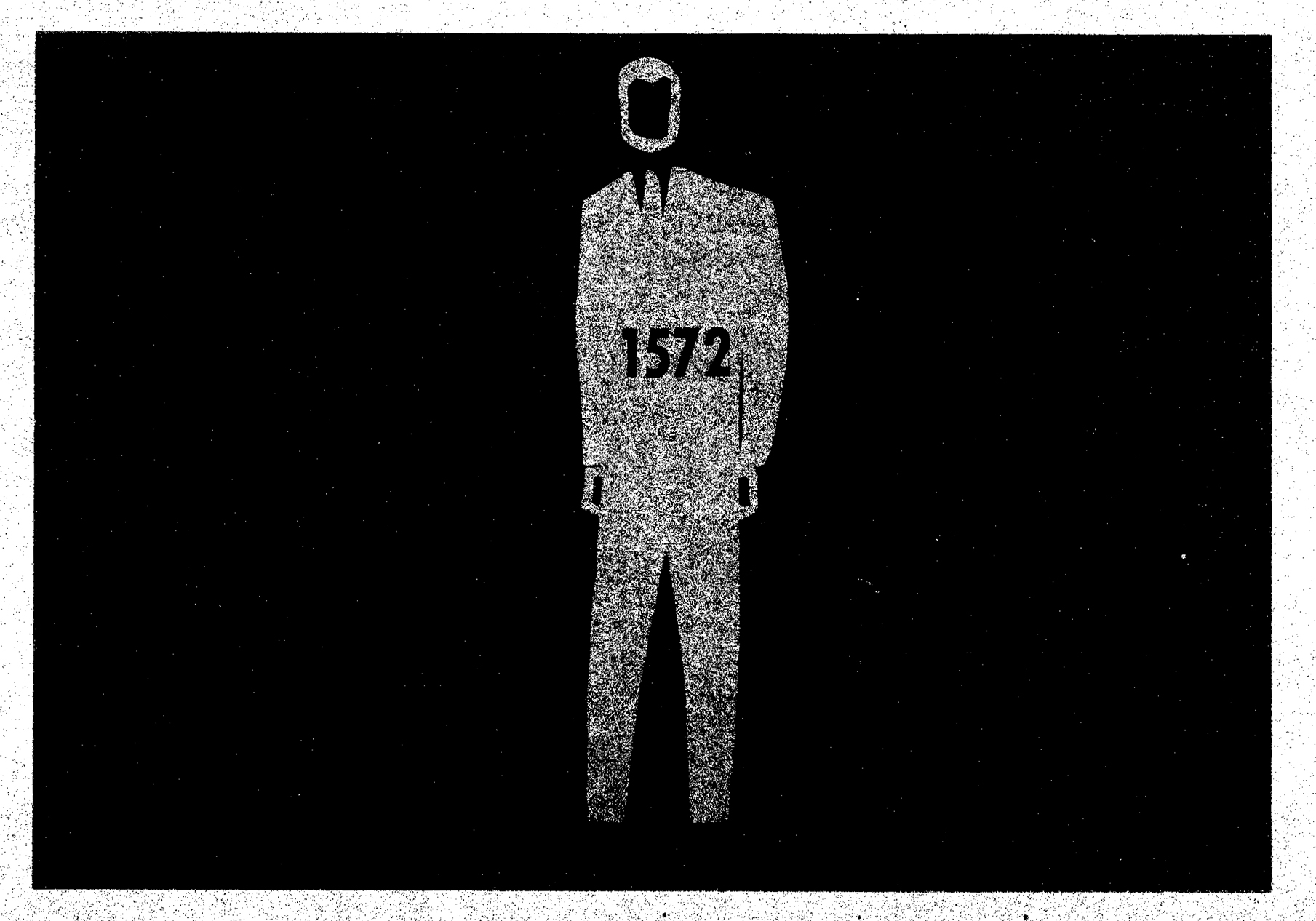
click on images
for larger view
The only thing
that is really known about these "pictures" is that they stem from
the collection related to the National Geospatial-Intelligence Agency (and what
was once the National Imagery and Mapping Agency).
If anyone can help solve this mystery, there are many who are interested in
an answer, and I - for one - will thank you for ending a handful of nightmares.
-- March 13, 2019 --
The Wars of Goats and Men
First, I'd like
to thank Razorcake Magazine
(especially columnist Donna Ramone) for tipping me off to this story. It's always
nice when someone hips me to an item that I'd like to cover here.
So, it turns out there's a war going on in Gävle, Sweden. Many think it's
between the Establishment, and Anarcho-Pranksters. Others think it's between
Pagans, and Christians. A few simply think it's just a twisted tradition. All
of it, over a goat. Well, a huge goat effigy to be exact.

The Gävle
Goat is an annual Christmas display, placed in the castle square of Slottstorget,
which began in the 1960s. The goat is often a large straw version of the Scandinavian
Yule Goat, which is believed to be connected to the pagan worship of the Norse
god Thor, whose chariot was pulled by the goats Tanngrisnir and Tanngnjóstr.
In 1966, Swedish advertising agent, Stig Gavlén, got the idea to erect
a giant replica of a Yule Goat to celebrate the Christian tradition of Advent
(a four-Sunday celebration around Christmas having to do with Jesus' Second
Coming). Since the very first year it was built, the Gävle Goat is almost
immediately destroyed. In fact, of the fifty-two years it has been constructed,
only fourteen have lasted throughout the entire season. Actually, fifteen, if
you count 1997, when half of it burned down due to having fireworks too close.
Anyhow, though thirty-one of the goat's demolitions were by arson, a handful
were done in other ways: once by crashing a car into it, and three times where
a crowd tore it to pieces. Most years, the culprits were never captured, but
there was one time when an American was caught, and he explained that his local
friends told him it was a tradition to do so. By 1986, some locals had enough,
and the Natural Science Club of the School of Vasa began to build a second goat,
but it also began to get the same treatment. In 1996, the Gävle municipal
government (since they were spending money on the goat's construction) was tired
of it all, and set up cameras, as well as guards, but there were a few times
even these didn't help, and the destruction raged on.
This past year, the Gävle Goat got lucky, but I'm sure a lot of us will
tune in next year, because - as interest grows - I'm sure plenty of firebugs
will get itchy fingers reaching for packs of matches.
-- February 28, 2019 --
A Dog's Tale
There are many
amazing stories of lost dogs going across an entire country to find their owners,
but one mutt has got them all beat.
Lampo, which
means "flash of lightning" in Italian, was an American mixed breed
doggo brought to Italy in 1953 by visiting U.S. soldiers. Not being able to
take him back, the assistant-master of the Campiglia Marittima train station,
Elvio Barlettani, took him in. As Barlettani worked, Lampo would use his free
time to hop a train out of the city, and somehow find a return train home, before
his owner's shift ended. The pooch knew the train schedules so well, he could
distinguish between a local tram (that was normally slower) from an express
train. Platform workers soon became familiar with the hound, and would often
place tags on him reading: FREE PASS FOR LAMPO. Workers
began applying tickets to the pup to let Elvio know where he had visited that
day. Though he didn't travel terribly far from his home base, it is known that
he visited every station in the northwest of Italy, and it's estimated that
Lampo took over 3000 trips (missing only one train home). This one of man's
best friend became so famous in the area, he had many local tv stations run
segments on him.

Sadly, this beautiful dog died doing what he loved. On July 22, 1961, Lampo was hit by a freight train that he could not move out of its path fast enough, due to a previous illness. Two years later, Barlettani published the book, Lampo: Il Cane Viaggiatore, in his honor, and it was quickly translated for American and British readers, as Lampo, The Traveling Dog. Today, a statue stands at the Campiglia Marittima station in memorial, which faces the rails he rode.

Though Lampo now runs the Elysian Fields, I hope he can hop a train there, too. Ride on, ride fast, you magnificent mongrel!
-- February 14, 2019 --
Not Your Typical Valentine's Day Post
Pearl Lusk was a girl from Quakertown, PA, who moved New York City, hoping to make a name for herself in the world of acting. On New Year's Eve of 1946, she'd play a role many would never forget.

On Thanksgiving
Day, she was approached by a man identifying himself as Allen La Rue, but -
thinking he was only wanted sex - told him she wasn't interested in an affair.
He approached her again the day after Christmas Day telling her that he had
a special job for her. Detective La Rue was working on a case of stolen jewels,
and he knew the culprit; a saucy dame by the name of Olga. He had a special
type of X-ray camera that, if he could get a photo of her, would let him know
she had the goods. His main problem was that the bird knew who he was, as well
as most of the force, so they needed an unknown to walk up, and snap the pic.
Whether it was the fact that she thought he was the most handsome, and best
dressed, man she'd ever seen, or her sense of duty, she decided to help. The
best part was they'd pay her (with an extra bonus if they confiscated the jewels),
as Lusk lost her job on Christmas Eve, so she needed the money, too. La Rue
gave her a package with a pull string. She was to approach the guilty party,
and pull the string when she was at a distance no greater than five feet (a
third of a meter).
The next day, she met Allen at a bar in Times Square, and he gave her a shoebox,
telling her it was the camera. She was to take the picture, and return to give
him back the box. Later that evening, Pearl saw her target hop a subway train
in Manhattan, headed towards Brooklyn. On the F, she sat near this Olga character,
and exited when she did. She then walked up behind her, and pulled the string.
Rushing back to Times Square, she returned the box to the detective. He told
her to meet him at an apartment in the city the next day to let her in on the
case's progress, as well as payment. When she showed up the next morning, La
Rue said the camera was faulty, and she'd have to try again, with payment being
doubled.
On December 31st, Ms. Lusk tried again. She followed the criminal, and did exactly
the same as before. Only, this time, when she pulled the string, the box erupted
with a huge bang. Olga's leg was nearly ripped off. Pearl thought someone had
shot the thief, as she took the picture. When police arrived, they ripped open
the box to find a sawed-off shotgun inside. The coppers hauled her into the
police station, and after she told her side of the story, they showed he a few
photos. She pointed out Allen La Rue, and they let her know this supposed flatfoot
was actually Brooklyn gangster Alphonse Rocco. Olga was his wife, and she was
divorcing him, taking a large chunk of his earnings, as well as a laundry list
of secrets. Pearl Lusk had been duped by a smalltime mafioso to do his dirty
work.
Rocco died six days later in a shoot-out with the fuzz when they tried to arrest
him. Though she lost her leg, Olga and Pearl became friends. In April of 1952,
Olga Rocco sued the city's police department for $200,000 in failing to protect
her from her ex-husband, but lost.
Not sure why Alphonse broke the first rule of Cosa Nostra: leave no witnesses,
but - if he had - I'd have one less thing to post about.
-- February 02, 2019 --
When It's Hard To Just Be Yourself
There have been countless cases of impostors. Many do it for monetary gain, like Christophe Rocancourt, who pretended to be a Rockefeller. Some do it for prestige, such as Rachel Dolezal, who - born of white parents - pretended to be an African-American, and became head of the Spokane chapter of the NAACP. There are a few who do it because they are simply sick and twisted compulsive liars, which brings to mind Alicia Esteve Head, who claimed to be a 9/11 survivor, though she lived in Barcelona, Spain at the time. Though it's rare, some of them actually do some good. One such phony was Archibald Belaney.

Archie was born
in Sussex, England on September 18, 1888. At only 14, he left grammar school
to work for a timber company, until fired for mistakenly blowing up the company's
office. In 1906, Belaney emigrated to Canada to study agriculture, but was soon
bored, and became a fur trapper. The following year Archibald married Angele
Egwuna, and later enlisted (1915) in the Canadian military where he served as
a sniper for some time during the First World War. Upon his return to Canada,
he met a 19-year-old, Mohawk Iroquois, Gertrude Bernard (aka Anahareo), which
he ran off with to live in the woods. Now calling himself Grey Owl, he started
to pass himself off as an Ojibwa native. With encouragement from Anahareo, A.
B. began writing, and his pieces on animal lore were picked up by Forest
& Outdoors, a Canadian Forestry Association publication. Between 1930
and 1935, the magazine put out 25 of his articles, and he was asked to film
a segment for the U.S. National Park Service. In 1931, he released his first
book, The Men of the Last Frontier, where he stresses environmentalism,
and animal conservation. This book was followed by three others, Pilgrims
of the Wild, The Adventures of Sajo and her Beaver People, and Tales
of an Empty Cabin, all of which became big sellers, promoting a naturalist
view. By 1935, he began touring Canada, the U.S. and England, giving speeches,
where he would appear in full Ojibwa traditional garb. Around this time, maybe
due to having to hide his true identity, Archie began to drink heavily, and
was arrested several times for public drunkenness. Fatigued by his tours, and
alcoholism, he collapsed in early April of 1938, and died on the 13th from pneumonia.
Immediately after his death, the Ontario newspaper North Bay Nugget,
and the British daily The Times, discovered the truth behind Grey Owl.
His publisher, and friend, Lovat Dickson worked to prove Grey Owl's identity,
but came to the same conclusions as the exposés, and admitted that he
had been lied to all those years. At first, his books were pulled off shelves,
and many conservation causes were affected, resulting in decreased donations.
After some time, many looked past the impostor, pointing out that his concerns
over the environment were rather important. Even The Ottawa Citizen wrote,
"Of course, the value of his work is not jeopardized. His attainments as
a writer and naturalist will survive."
Today, Archibald is practically forgiven for his trespasses. In 1972, the Canadian
Broadcasting Corporation produced a documentary on the Grey Owl story, and a
movie, titled Grey Owl, was made in 1999, starring Pierce Brosnan. A
commemorative plaque to Grey Owl now hangs on the old Belaney house in Hastings,
East Sussex (32 St. James Road), as well as the ranger station in the U.K.'s
Hastings Country Park, and one can still visit his log cabin (built in 1930)
in Canada's Prince Albert National Park.
This may prove that, sometimes, pretending to be someone else can have some
positive effect, but I doubt it will, so it's best to just be your own person.
-- January 23, 2019 --
Short and Not-So-Sweet
Many empires lasted
lifetimes, such as the Roman Empire (503 years), the Zhou Empire (790 years),
and the Empire of Japan (1743 years so far). Quite a few countries have been
around as long, like Scotland (844 years), Korea (1242 years), and Ethiopia
(2916 years). Still, there are some that come and go in the blink of an eye,
and examples are Markovo in Russia (8 months), Azawad in northwest Africa (3
months), and Connacht in Ireland (12 days). Even so, a handful hardly lasted
over a weekend. Two of those would be the Republic of Benin, and Carpatho.
The first was established in September of 1967, during the Nigerian Civil War,
when a neutral, and ethnically diverse, group of several million residents (backed
by the country of Biafra, which itself lasted all but three years) set up a
separate state. Biafran forces placed American-educated Dr. Albert Okonkwo as
the head of government, giving him the title of Governor, on the 19th of the
month. The state pledged support for the Commonwealth of Nations, plus the Organization
of African Unity. Benin won some recognition from a few other countries, and
they even decided on its new flag.

The very next day,
Nigerian federal troops marched into the capital city, Benin City, dismantling
the government, and reabsorbed the state. The Republic of Benin lasted just
one day.
The second I mentioned above, Carpatho, formed in the southwestern tip of Czechoslovakia.
On March 15th of 1938, the indigenous population of Subcarpathia, placed the
Reverend President Avgustyn Ivanovych Voloshyn as their head of state. By that
afternoon, the government had set up an eight-point "First Constitutional
Law of Carpatho-Ukraine", as well as created the new country's coat of
arms.

The following day,
Hungarian forces invaded (backed by the Nazis), and most of the ruling party
fled. The area stayed under Hungarian control, until it was ceded by the Soviet
Union in 1945, and it is now part of Ukraine.
Well, no matter the length of time, remember that all politicians are full of
shit, and, like diapers, should be changed regularly, but don't let any of this
stop you from setting up an autonomous state within your own bounds. Long live
liberty, long live revolution!
-- January 08, 2019 --
Dirty Boy
In John Waters' infamous black comedy classic, Pink Flamingos, Divine becomes "the filthiest person alive". Without spoiling much, it ends with Divine scooping up real dog shit as a chewy snack. While eating it once is pretty freaking filthy, try lighting some up every time you wanted a smoke. That's only one of the things Amou Haji, known as "the world's dirtiest man", does on the daily.

Amou, an 80-year-old
homeless hermit, lives in the Fars province of Iran, just outside the village
of Dejgah. He has not showered in 60 years, and when he does lay his head, it's
usually in a hole dug by animals. Haji cuts his hair by burning it, and "grooms"
himself with the help of one of his few possessions: a car's side mirror. Believing
cleanliness will make one sick, he once ran away from a crowd trying to give
him a bath. He spends his days looking for food, which consists strictly of
roadkill; his favorite being porcupine. Besides his car mirror, and shabby clothing,
his only other possession is a 3" piece of bent-metal, plumber's piping
that he uses to smoke animal feces.
Though many say Amou is a sick man, Haji claims to be very happy living like
this, so let's not cast aspersions on someone living quite differently from
us. If the world ever goes to tatters, he's actually one step ahead of all of
us who'll be fighting over the scraps of the life we once knew. Here's to Haji,
who - though I love Divine - is truly the filthiest person alive.
-- December 26, 2018 --
Worship the Glitch
Steampunk is nothing
new. It's been around since the era it's based around, the 19th Century. While
we have better known literary cases such as Jules Verne's Twenty Thousand
Leagues Under the Seas (1869), and The Steam Man of the Prairies
by Edward S. Ellis (1868), I'd like to bring up the lesser-known, mechanical
work of John Murray Spear.
Spear was born in Boston, MA in 1805, and baptized by his namesake John Murray
(who founded the Universalist Church of America). By the age of 25, JMS became
the minister of a Universalist congregation in the nearby village of Barnstable.
By 1840, he was deep into political activism, such as the abolition of the death
penalty, equal rights for women, and was a huge part of New England's antislavery
movement - managing the local division of the Underground Railroad (known as
the Boston Vigilance Committee).
In 1852, he lost interest in the Universalist Church, and, after leaving, began
to delve into Spiritualism, publishing the book Messages From the Superior
State, where he claimed to be in contact with a group of higher intelligence
called with "The Association of Electrizers" (a philanthropic ghost
frat devoted to helping mankind through technology), which included the spirits
of Thomas Jefferson, Benjamin Franklin, Emanuel Swedenborg and John Quincy Adams.
The very next year, he proclaimed to have received a message containing his
life's purpose. He was to gather a group of his followers, and move to a small
log cabin on High Rock Hill in Lynn, MA. There, they were to not just contact
God, but build him. Naming his automated Robot Lord "New Motive Power",
it was to be a machine-driven Messiah, who was to usher in a new Utopia. Working
from the Electrizers' blueprints, the flock constructed their prototype; made
of copper and zinc atop a common dinner table, costing them about $2000 (around
$60,000 today).

interpretation by
unknown artist
John then held
a ritual, where the machine was given a mock birth by a member dubbed the "New
Mary", so it could have life. Carefully-selected devotees of both sexes
were then presented to The Great Gadget, one at a time, for their "vibrations"
to raise its level of consciousness. The appliance made a few noises, and some
parts moved a bit, but didn't do much else. They thought to build a bigger model,
costing ten times the original amount, but Spear said he received a directive
from The Association telling him to move to a place with cleaner air. The clan
packed up, hauling the dismantled contraption to Randolph, NY. While no one
knows what truly happened to their Mechanical God, it is said that a group of
nonbelievers ransacked where the mechanism was kept, tore it to pieces, and
threw the parts about the surrounding area.
Brokenhearted, JMS (without his flock, as many left thinking he had gone insane)
moved to the UK for the next six years. Finding that the British spiritual community
didn't care for his radical politics, he left to California, where John worked
to help establish Socialism. In 1872, Spear said the Electrizers told him to
retire, and upon moving to Philadelphia, PA, he did as they instructed. Spear
joined his spirit communicators in October of 1887, and was buried in Mount
Moriah Cemetery.
I find it sad that the original New Motive Power (or even a replica) no longer
exists, as it would have made a wonderful piece of folk art. Oh well, rust in
peace.
-- December 13, 2018 --
One Scary Village
Thanks to shows
like Jonathan Ross' Japanorama, Japan is somewhat known for their odd
customs, but some of them can make parts of that country seem downright creepy.
One such place that gives me the willies is the village of Nagoro. Located in
a remote mountain area on the island of Shikoku, in Japan's Tokushima Prefecture,
Nagoro used to be the home to about 300 locals, but the population has fallen
to a mere thirty people since the building of the Nagoro Dam in 1961.
In 2002, native Tsukimi Ayano moved back from Osaka to care for her father,
and seeing how small the community had become, created a kakashi ("scarecrow")
in her dad's likeness, which she placed in a field. Since then, she has made
over 400 more in the image of other past and present residents. The town's citizens
loved them so much, they began to create many of their own. The scarecrows now
outnumber the humans 100 to 1, as there are about 3000 of them peppered about
the landscape. While many are scattered about in fields, there are some depicted
as fishing by the river, hanging out in front of the general store, leaning
on phone poles, waiting at bus stops, and there are even classrooms full of
"students" in the vacant elementary school that closed in 2012.




This slice of weirdness has made the hamlet a bit of a tourist attraction, and a few Americans visit just to punch their scarecrow version of U.S. President Donald Trump. To drum up a bigger influx of visitors to the region, the provincial government has begun to promote the Scarecrow Festival each October. Even so, I don't think I'll ever visit this little borough - especially alone.
-- December 01, 2018 --
Ending It All
I'm not going anywhere just yet, and as usual I'm staying busy with new projects. A new one I've begun is called END HUMANITY NOW!, which I have new bumper stickers for.
Two styles, one
is 8.5x3" (21.5x7.5cm) and the other is 4x5" (10x12.5cm). They are
$2 for two of each (4 stickers in total), with postage paid for anywhere on
Earth. Contact me to order.
The climax of this project will be - drum roll please - when I run for mayor
of Miami! More info on that to come soon.
-- November 22, 2018 --
Reaching Skyward
The Newby-McMahon Building, in Wichita Falls, Texas, pissed off a lot of folks in 1919. While it upset local residents, it infuriated investors to the point of lawsuit.
Thanks to the discovery
of a huge petroleum reservoir near the neighboring city of Burkburnett in 1912,
the area received a huge economic, as well as population, boom. Because of this,
mineral rights, and stock deals, were being conducted out on the street, or
in tents, due to the lack of office space. In steps structural engineer, and
oil man, J.D. McMahon, who announced he would build a high rise office building
on the corner of 7th Street and La Salle. McMahon collected $200,000 in investment
money, which today amounts close to $3,000,000. He then distributed blueprints
to his benefactors that read it was to be 480". Believing it to be 480',
investors okayed the construction, and work began. Upon finishing it, the structure
was a mere four floors. When lenders learned of the swindle, they took J.D.
to court, but he won, as he never said how tall the building would be, and shareholders
had all read the drafts stating the actual size of 480 inches. Not long after,
Ripley's Believe It or Not! dubbed it "the world's littlest skyscraper",
and the title stuck.
By the Great Depression of 1929, the building was abandoned as the oil boom
went bust, and a fire gutted the place in 1931. By the 1970s, it was scheduled
to be demolished several times, but a number of locals came to its defense,
in part due to its kooky past, and nickname. Though still empty at that time,
the city donated the Newby-McMahon Building to the Wichita County Heritage Society
(WCHS) in 1986, hoping it to become part of the Depot Square Historic District.
In 2000, the city council hired the architectural firm of Bundy, Young, Sims
& Potter to stabilize it, and the building was entered in the National Register
of Historic Places as a Texas Historical Landmark, with most of it currently
holding a furniture company, though some floors are often leased to local artists.
While the building never met the criteria to be classified as a skyscraper,
or even a high rise, "the world's smallest building" still has a big
history.
-- November 09, 2018 --
A Rock-N-Roll Day Dream
Rod Serling (1924 - 1975) was a sci-fi genius, who is best known for his tv show, The Twilight Zone, which he produced, as well as wrote much of the story lines for.
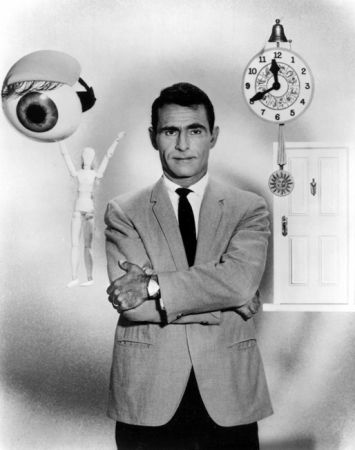
A decorated WWII
veteran, Serling began working in radio on New York's WNYC, acting, and doing
odd jobs. His first three radio scripts aired in 1949, two on the Grand Central
Station romance program, and the other on the drama series Dr. Christian.
Believing radio show broadcasting was a dying art, he moved on to television,
working for WKRC in Cincinnati, writing comedy. He soon gained fame after one
script (titled "Patterns") for the tv show Kraft Television Theatre
earned him high praise as a writer by critics in 1955. While working for CBS,
his 1958 episode "The Time Element" for Desi Arnaz and Lucille Ball's
The Westinghouse Desilu Playhouse was so well loved, he was offered his
own show, and he set The Twilight Zone into production, which ran from
1959 to 1964, airing 156 episodes.
Though he created another great show, Night Gallery (1969 - 1973), he
never forgot about radio, and originated a drama series called The Zero Hour
in 1973, but his wildest radio show was his very last. A few weeks before his
death, Rod Serling played what was, basically, a prank on listeners. Titled
Fantasy Park, the stunt was aired on close to 200 stations throughout
the Labor Day weekend of 1975. The 48-hour program was a fake concert, where
dozens of rock bands of the time "played", as well as having a Beatles
"reunion", using crowd noise, sound effects, and mixing in prerecorded
live gigs. Even though disclaimers were run every hour (such as "Hello,
this is Rod Serling, and welcome back to Fantasy Park. The crowds here
today are unreal," and "This is Fantasy Park, the greatest
live concert never held."), every station that broadcast the show was swamped
with phone calls asking where the concert was held, and how they could get in.
Well, as the famous intro to The Twilight Zone goes, "You are traveling
through another dimension, a dimension not only of sight, and sound, but of
mind. A journey into a wondrous land of imagination. Next stop..." a total
crock of rock.
-- October 29, 2018 --
Smoke Break
While I definitely don't promote it, I don't hide the fact I'm a casual smoker. I write "casual" because I only pick up the habit a few months out of the year. In all honesty, I return to smoking because of cravings, and then quit due to health concerns, but if there was a safer cigarette, I'd smoke all the time.

The weird thing
about wishing there was a healthier alternative is that there's been several
for over 50 years, but the cigarette companies suppressed them.
In 1964, an American subsidiary of London's British-American Tobacco PLC, Brown
& Williamson Tobacco Corporation, applied for a patent to a test cigarette
they named Project Ariel (after the spirit in Shakespeare's Tempest).
Awarded the patent in 1966, this new brand held tobacco that was heated, instead
of burned, creating a cig that conatined less harmful agents than regular smokes.
According to documents stolen by a former employee of a lawfirm working for
Brown & Williamson, the company reported two models of the safer cigarette
were created, "one free of tobacco smoke, and one having a small amount
of tobacco smoke." But, finding they both delivered smaller amounts of
nicotine, researchers emphasized that B-AT Co was "in the nicotine, rather
than the tobacco industry." To make matters worse, new studies were coming
out showcasing the harmful effects of smoking, and British-American Tobacco
felt they might open themselves up to lawsuits, as by releasing a safer cigarette
might imply they already knew they were selling a dangerous product. Therefore,
the project was shelved.
Even before Ariel, there was the lesser known Project X.A., which was run by
Liggett & Myers, a tobacco company out of North Carolina. Also known as
the "palladium cigarette", this product used palladium, as well as
magnesium nitrate, to destroy cancer-causing agents in smoke. Testing ran from
1955, until 1974, with an estimated budget of $10 million, but, even though
L&M knew the product would sell well, they shelved it after pressure from
Phillip Morris and Brown & Williamson. According to Civil Action No. 99-2496
(aka The United States Proposed Findings of Fact in the case of United States
v. Philip Morris), which was filed in 1999, Brown & Williamson threatened
the "very existence" of Liggett & Myers if it marketed the cigarette,
and further warned L&M they would be left out of joint defense agreements,
as well as expelled from the Tobacco Institute if they continued.
These very threats are why R.J. Reynolds (who, strangely enough, bought B&W
in 2004) did not market their Premier brand "smokeless" cigarette
as a safer alternative to regular smokes, in 1987. They saw promoting one brand
as "safe" would go against the tobacco industry's position that your
standard cigarettes weren't unsafe. Claiming the Premier brand was released
too soon, RJR removed it from the market the following year.
So, put all
that in your pipe, and smoke it. Hell, it's probably less harmful.
-- October 15, 2018 --
One School You Should Drop Out Of
Imagine a school where the alumni are some of the scariest political figures you can dream up. Nevermind. There's no need to, because it actually already exists, and - of course - it was a product of the United States.

Founded in 1946,
the U.S. Army School of the Americas was located at Fort Gulick in the United
States' Panama Canal Zone. The school was established to train Latin American
armed forces in the military practices of the U.S. Though it has trained more
than 60,000 soldiers (from 21 countries) in the 54 years it had existed, a small
number of those graduates went on to become some of the most despotic dictators,
deadliest soldiers, and dangerous drug dealers, in the Western hemisphere. That
list includes:
Colonel Alberto Quijano of the Colombian Special Forces, who provided security
for Diego León Montoya Sánchez (aka "Don Diego"), the
leader of the Norte del Valle Cartel.
Colonel Domingo Monterrosa of El Salvador, who is responsible for the El Mozote
massacre of over 800 Salvadoran citizens.
General Luis Alonso Discua, who commanded Battalion 3-16, a Honduran military
death squad.
Army Minister of Defense Vladimir Padrino Lopez, and SEBIN director Gustavo
Gonzalez Lopez, who were both charged with drug trafficking, and human rights
violations against Venezuelan protesters.
Naval officer Emilio Eduardo Massera, a leading participant in the Argentine
coup of 1976, and masterminded behind The Dirty War, which resulted in over
10,000 deaths and disappearances.
General Raúl Iturriaga, former deputy director of Dirección de
Inteligencia Nacional (the Chilean secret police) under the Pinochet dictatorship.
Head of Intelligence Manuel Noriega, who ran Panama as the de facto leader
from 1983 - 1989, as well as money laundering, and drug/weapons dealing from
1972 - 1989.
Heriberto "The Executioner" Lazcano, and Arturo "Zeta One"
Guzmán Decena, both founders of the Zetas Mexican Cartel.
While this is a brief listing, the nonprofit organization called School of the
Americas Watch has released another 25 names of serious human rights offenders.
In 2000, due to heavy scrutiny, the US Congress withdrew the Secretary of the
Army's authority to operate the school. Under the National Defense Authorization
Act, 10 USC Sec 2166, the name was changed to Western Hemisphere Institute for
Security Cooperation, and operations were moved to Fort Benning, Georgia in
2001. The "new" school has since trained 20,000 students from 36 countries.
Though it now claims to have established considerable transparency, U.S. Army
Major Joseph Blair, a former director of instruction at the school, was quoted
as saying in 2002, "There are no substantive changes besides the name.
They teach the identical courses that I taught; changed the course names, but
use the same manuals."
On an interesting side note, many have wondered how Hillary could have lost
to Trump by such a small electoral margin, but do know that one of the platforms
the Democrats ran on was closing the school altogether. Now there's something
for conspiracists to think about.
-- October 01, 2018 --
No Man Is An Island, But He Can Build One
When I lived in
New York City, one of my favorite things to do was take long walks to snap photos
for my many photography projects, one of which was visiting odd spots for my
This Hidden
City blog.
Though I covered Roosevelt Island in one post (see that here),
I didn't write about nearby Belmont Island, also known as U Thant Island, which
can best be seen from Roosevelt's south shore.

click on image for
larger view
Belmont Island
is an artificial isle, which developed out of Man-O-War Reef in the early 1900s
due to construction. At only 100 x 200 ft (30 x 60 m), it is the smallest island
in the Manhattan borough.
In 1891, William Steinway funded the planning of two tunnels for trolleys under
the East River (now called the Steinway Tunnels, which carry the number 7 subway
train line). Built to link Manhattan Island to Steinway's company town, Steinway
Village (in Astoria, Queens), where his Steinway & Sons Piano Company was
located. After William's death in 1896, the project was picked up by the founder
of the Interborough Rapid Transit Company (IRT), August Belmont Jr.
When construction reached the middle of the river around 1902, a shaft was excavated,
leading to a small outcropping of granite called Man-O-War Reef. Thinking it
was easier to shovel a tunnel to help remove excess landfill, rather than carry
it back to the Manhattan shore, much of the rocks were dumped around the reef,
fabricating the small island.
Though the islet has been managed by the New York City Department of Parks and
Recreation, which named it Belmont Island, it had stayed a barren pile of rocks
until 1977. That year, a group calling themselves Peace Meditation, who were
United Nations employees, and followers of guru Sri Chinmoy (then the interfaith
chaplain at U.N. Headquarters), got tired of looking out the building's windows
at the tiny bare enclave, and decided to do something. They leased the isle
from the city, and covered it in greenery, as well as constructing a metal arch,
and renamed the island after then-U.N. Secretary General, U Thant.
Today, some of the flora still remains, but the arch has toppled, and the only
other thing on the island is a 60ft (18m) metal Coast Guard beacon tower. The
island is also currently off-limits to people, as it is a sanctuary for migrating
double-crested cormorants. Still, that hasn't stopped quite a few explorers,
such as artist and filmmaker Duke Riley, who rowed a small boat over to the
islet under the cover of darkness in 2008. Riley proclaimed the pile of rocks
a sovereign nation, hoisting a pennant flag (depicting two electric eels) atop
the beacon, all the while videotaping it for a work titled Belmont Island
(SMEACC).
If you're looking to visit, I propose bringing a pair of binoculars, because
that's as close as you'll probably get.
-- September 21, 2018 --
Rhyme Time
This October, I release the 2nd edition of my poetry chapbook, Throne Out: An Attempt to Depose Prose, which collects some of my favorite "throwaways".
What better way to celebrate that on this blog, than to post about William "Topaz" McGonagall, who is often described as "the world's worst poet"?

Born of Irish parents,
little is known about William's early childhood, mostly because he would often
go back and forth on the particulars. Stating at one point to be born in 1825,
he later said it was 1830. Scholars place his birth as possibly being in Ireland,
though he claimed to have been born in Scotland, probably due to wanting to
receive relief under the Poor Law of 1845.
What is known is that he, following in his father's footsteps, began working
as a handloom weaver. In 1846, he married, and produced seven children (five
sons, and two daughters). At one time, he attempted to become an actor, but
would often fly off script, with the most infamous instance being when he played
general Macbeth in the Shakespeare play, and he refused to die in Act V, thinking
other actors were upstaging him.
Sometime in 1877, McGonagall wrote that a great feeling had washed over him,
leaving him with the desire to write poetry. He wrote a number of poems, and
- seeking funds to continue - penned a letter to Queen Victoria for her patronage.
After receiving a reply of refusal, he walked 60 miles over mountains, and in
thunderstorms, to her castle, announcing his arrival as "The Queen's Poet".
The guards told him to piss off, but the act gained him some recognition in
the local papers. For pennies, he often recited poems against the evils of alcohol
in pubs, which usually ended with him being pelted with food. Much of the time,
he would be found selling his poems in the street, but he was mainly supported
by donations from friends, and - possibly to get William out of town for a bit
- they paid for him to travel to New York City so as to peddle his poetry, but
returned unsuccessful. Garnering a bit of notoriety for his bad poetry, he was
hired by circuses to read his work, with the full knowledge that the crowd was
permitted to throw eggs at him. His friends, again, got together in 1890, and
paid for the publishing of his first book, Poetic Gems. The following
year, his hometown of Dundee forced him out, and he packed up his family, moving
to Perth. Later, he received a hoax letter, telling him King Thibaw Min of Burma
had knighted him as "Topaz McGonagall, Grand Knight of the Holy Order of
the White Elephant Burmah", of which he took seriously, and referred to
himself as "Sir William Topaz McGonagall, Knight of the White Elephant,
Burmah" for the remainder of his life. He died, without a dime to his name,
in 1902, and was buried in an unmarked grave in Greyfriars Kirkyard in Edinburgh,
Scotland, leaving behind over 200 poems.
Though forgotten for many years, he was rediscovered, and his legacy lived on
in popular media. Peter Sellers often read William's poetry from 1951 to 1960
on BBC Radio's The Good Show. An episode of Monty Python's Flying
Circus had a McGonagall-styled poet, called Ewan McTeagle, who wrote poems
that were actually requests to borrow money, and in the 2003 novel, The Wee
Free Men, by Terry Pratchett, he appeared as Nac Mac Feegle, whose terrible
poetry can defeat enemies. After gaining cult status, a gravestone was finally
placed on his burial spot in 1999, which labeled him "Poet and Tragedian",
and a broadsheet of 35 of his poems sold for £6,600 (US$8500) at an auction
held by Scottish auctioneers, Lyon & Turnbull, in May of 2008.
Hopefully, my poetry isn't anywhere near as bad, and if you're interested in
a copy of Throne Out ($10 postage paid in the U.S.), feel free to contact
me.
-- September 10, 2018 --
The Hills Are Alive With the Sound of Lawyers
A whole lot of
people, myself included, find it odd that a corporation can be deemed a person.
It's usually done so that a company can get a handful of the lawful rights a
physical human has. It's mostly used so they could sue someone, or donate large
sums of money to political parties, hence it's often seen as a nefarious legal
maneuver.
Still, there have been times where legal personhood has been used for positive
purposes. One such case is when a country gave a natural resource, a hilly area
known as Te Urewera, its own legal identity.

This section of
scantly-populated hills is located on the North Island of New Zealand's Hawkes
Bay Region. It is the historical home of the Maori tribe of Tuhoe, and - due
to the area's heavy isolation - stayed mostly untouched by British colonists,
leaving it pretty much under Maori control up until the 1880s. Throughout the
early 1900s, it became the home of a religious community run by self-proclaimed
prophet Rua Tapunui Kenana, who dubbed himself the Maori messiah. In 1954, to
help preserve Te Urewera (which means "burnt penis" in the Maori language),
the government sanctioned it as a national park. The status was removed in 2014,
but only to provide the location with stronger legal standing by becoming the
world's first natural area to obtain legitimate rights as a person.
This worked so well in protecting the land, New Zealand opted to make another
location the world's second natural resource to reach legal personhood, the
Whanganui River. In March of 2017, the country's third largest river was also
given the authority, commitments, and accountabilities of a proper person.
While this is a great way to protect land, it may leave some rather depressed
to find that real estate in some countries have more rights than actual humans
in other regions of the world.
-- September 02, 2018 --
You Can Finally Use This Blog As Toilet Paper
I have a new fanzine out next month, Know-It-All Asshole Jerk, based on this blog. It collects over 50 wild, wonderful and weird entries from around the world covering literature, hoaxes, art, religion and history.

It's only $5 -
postage paid within the U.S. - for TWO copies (with another $6 outside the country).
Contact me to order.
-- August 28, 2018 --
It's Just A Smudge
Recently, Venezuela
is a country with a really stained humanitarian record, but the stains I'm going
to be writing about now are something completely different.
In 1986, the country's capital of Caracas began to have a mysterious black ooze
appear on its roadways. Known as "La Mancha Negra" ("The Black
Stain"), it first showed up as a 150 foot-long (46 meter-long) spot on
the main road to the airport. By 1989, the slippery stuff was seeping through
8 miles (13 km) of highway. Nothing was known about what it was, beside the
color, texture, and that it expanded in the heat, and shrank in the cold.

In 1992, and estimated
1,800 deaths were said to have been due to car accidents caused by the greasy
goo. Fed up, the federal government stepped in, and threw millions of their
dollars at the problem. Pressure cleaning, and even detergents failed to clear
the mess; later re-paving the roads, only to have it surface again. The Venezuelan
Ministry of Transport and Communications tried to pinpoint where it came from,
with no results. Experts, using help from Europe, and North America, found out
what it was made of (showing it to be a mixture of oil, dust, plus various synthetic
and organic materials), but failed to get the why it was, and how it got there.
Weirdly enough, it still plagues the country to this day, and locals just live
with it as another burden they have to bear, but, sadly, it currently seems
the least of their worries.
-- August 13, 2018 --
A Fiery Sermon
Many people have heard of David Koresh, as well as what happened to his Branch Davidians, but what many don't know is that David probably just wanted to rock out.

David Koresh was
born Vernon Wayne Howell in Houston, TX in August of 1959. Vernon was pretty
much a bastard, as his parents were never wed, and his daddy ran off with another
gal when Vernon was just two. He dropped out of high school due to problems
with dyslexia, but he knew The New Testament well enough to quote long
tracts of scripture by heart. VW became a born-again in at a Baptist church,
but soon switched over to the Seventh-Day Adventists because of his mom's conversion
to that faith. Howell was soon kicked out for constantly chasing after the preacher's
daughter. In 1981 he moved to Waco, TX and joined the Branch Davidians (a group
that had splintered from the Shepherd's Rod cult in the 1950s, who themselves
broke off from the Seventh-Day Adventists in the 1930s). In 1983 Vernon started
banging the prophetess and leader of the Davidians, Lois Roden, and they believed
their son would be "the Chosen One". She quickly let him start preaching
from the Good Book, and give sermons to the cult members, which pissed off Roden's
son, George, who was promised the cult would be handed over to him. Soon enough,
George chased Vernon away with gun in hand, and he set up camp with a few cult
members in Palestine, TX. In 1987 VWH, and seven followers, armed and dressed
in camouflage attacked the Mount Carmel camp, and its leader. Roden's son was
shot, and all were arrested except for the injured George. Vernon's attempted
murder trial ended in mistrial, and all other members were acquitted. In a strange
turn of events George Roden was tried for murder the following year after axing
to death a member of his congregation (Dale Adair) who thought Howell may be
the coming messiah. Upon inspection of Mount Carmel a methamphetamine lab was
discovered, and the property was seized. Place on police auction the Branch
Davidians raised the dough to buy the place, and, in 1990, VW Howell changed
his name to David Koresh.
The rest is history. Well, okay, if you don't know that history here goes: Koresh
began to stock pile weapons, claiming the end of the world was nigh, and would
occur with a battle against the Great Beast - meaning the U.S. government. In
February of 1993 the government made good on his prophecy by staging a raid
on Mount Carmel. A gun battle broke out leaving Koresh shot, six members of
the cult dead (including Koresh's two year old daughter), and four agents of
the Bureau of Alcohol, Tobacco and Firearms were killed. This lead to a standoff
that lasted 51 days, until April 19, when federal agents using tanks set the
Carmel compound ablaze killing almost all inside (79 in total, of which 21 were
children). A later incarnation of the group, known as the Hidden Manna, think
Koresh, and all those killed, were to return from the dead in 2012 to give the
government their just desserts.
A few years before all hell broke loose in Waco, Koresh took his guitar, and
entered the studio to record some music he had written.
Much of his music was passed around in the underground tape-trading circuit by those who collected outsider music, or the few that knew he was a cult leader. After the tragedy, a few bootleggers cashed in by releasing much of Koresh's music, such as Florida's Malcolm Tent on his TPOS label (The Music and the Message cassette), and the Voice of Fire CD (on Junior's Motel Records).
-- August 03, 2018 --
Killer Jazz
You ever loved
a certain type of music so much, you'd kill for it? I'm sure you haven't, but
that doesn't mean others wouldn't. There was once a serial killer on the loose
in Louisiana who tried to promote jazz music. Kinda.
In 1918 and 1919, a still unidentified madman, dubbed the Axeman of New Orleans,
walked the streets late at night, killing entire families using an ax - usually
the families' own - leaving six dead, and twelve injured. Robbery was not a
motive, as he would eneter the home, murder, and not take a single thing. Due
to the fact that many victims were Italian-Americans, or Italian immigrants,
it was thought that the crimes were Mafia related, but that theory changed in
the spring of 1919.
On March 13, 1919, a letter - with Satanic overtones - was recieved by a local
newspaper, The Times-Picayune, claiming to be from the Axeman himself.
It read:
Hell, March 13,
1919
Esteemed Mortal of New Orleans:
They have never caught me and they never will. They have never seen me, for
I am invisible, even as the ether that surrounds your earth. I am not a human
being, but a spirit and a demon from the hottest hell. I am what you Orleanians
and your foolish police call the Axeman.
When I see fit, I shall come and claim other victims. I alone know whom they
shall be. I shall leave no clue except my bloody axe, besmeared with blood and
brains of he whom I have sent below to keep me company.
If you wish you may tell the police to be careful not to rile me. Of course,
I am a reasonable spirit. I take no offense at the way they have conducted their
investigations in the past. In fact, they have been so utterly stupid as to
not only amuse me, but His Satanic Majesty, Francis Josef, etc. But tell them
to beware. Let them not try to discover what I am, for it were better that they
were never born than to incur the wrath of the Axeman. I don't think there is
any need of such a warning, for I feel sure the police will always dodge me,
as they have in the past. They are wise and know how to keep away from all harm.
Undoubtedly, you Orleanians think of me as a most horrible murderer, which I
am, but I could be much worse if I wanted to. If I wished, I could pay a visit
to your city every night. At will I could slay thousands of your best citizens
(and the worst), for I am in close relationship with the Angel of Death.
Now, to be exact, at 12:15 (earthly time) on next Tuesday night, I am going
to pass over New Orleans. In my infinite mercy, I am going to make a little
proposition to you people. Here it is:
I am very fond of jazz music, and I swear by all the devils in the nether regions
that every person shall be spared in whose home a jazz band is in full swing
at the time I have just mentioned. If everyone has a jazz band going, well,
then, so much the better for you people. One thing is certain and that is that
some of your people who do not jazz it out on that specific Tuesday night (if
there be any) will get the axe.
Well, as I am cold and crave the warmth of my native Tartarus, and it is about
time I leave your earthly home, I will cease my discourse. Hoping that thou
wilt publish this, that it may go well with thee, I have been, am and will be
the worst spirit that ever existed either in fact or realm of fancy.
-The Axeman
That evening, music
halls and dance clubs were filled to capacity, and, while some homes blasted
their phonograph, others went as far as to hire their own band. No murders happened
that night, but they resumed a few months later, and stopped as mysteriously
as they began.
Later that year, a New Orleans songwriter Joseph John Davilla penned the tune,
"The Mysterious Axman's Jazz (Don't Scare Me Papa)", which was published
by World's Music Publishing Company, but never officially released on 78rpm.
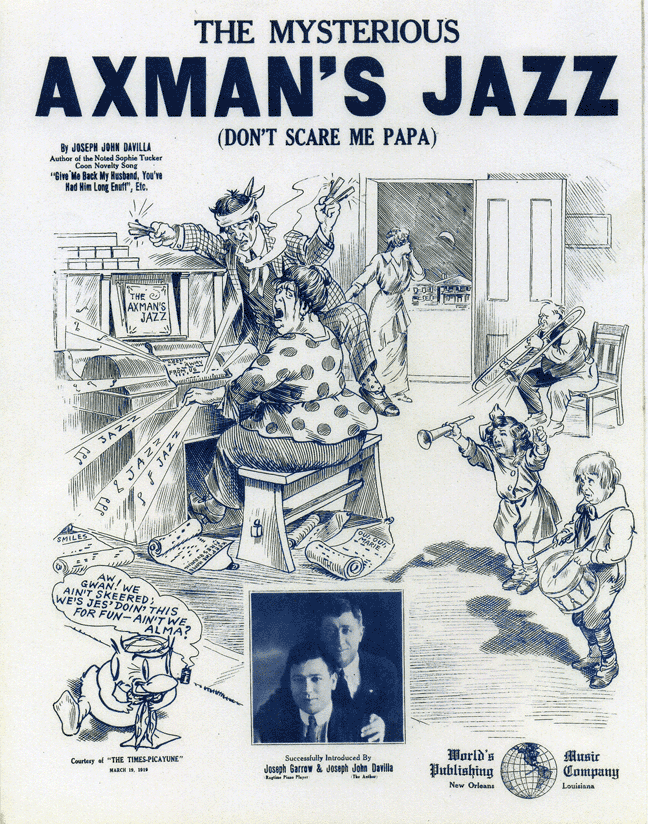
click on image for
larger view
Let's have a listen...
Since then, the song has been covered by Reddie Whilling & Abel, as well as Squirrel Nut Zippers, while the Axeman's tale has been woven into short stories by Poppy Z. Brite, and Chuck Palahniuk, sufaced in Christopher Farnsworth's 2012 novel Red, White, and Blood, and even made it onto television through an episode of American Horror Story: Coven ("The Axeman Cometh" - November, 2013).
-- July 16, 2018 --
Going Underground in NYC
In Neolithic times,
many of our ancestors lived in caves, and from then on some cultures have created
underground dwellings, such as the city of Derinkuyu in Turkey, which had housed
about 20,000 people, 200ft (60m) under the surface. So why not go back?
That's what designers Jay and Kenneth Swayze of Underground World Homes did
in the 60s. Scared of impending nuclear doom, the brothers built bomb shelters
that were full homes, complete with all the amenities needed for family living.
After having two constructed for himself, investor Jerry Henderson loved the
company so much, he bought half of it. Wanting to publicize the project, Jerry
had a home produced at the 1964-65 World's Fair in New York City. The Fair,
which was held in Queen's Flushing Meadows Corona Park, placed the exhibit between
the Hall of Science and Terrace on the Park.

Here's where the
story takes a turn for the weird(er).
After the fair ended, each exhibitor was supposed to take down their enterprise.
It is believed that the trio felt it would be cheaper to just take down the
exterior pavilion, and simply cover up the entrance to the underground lair.
Therefore, though no one knows for sure, there could be an entire home still
under the park.
Lori Walters, professor at the University of Central Florida, is interested
enough to try to find out, but feels she needs more evidence the home might
still be there before she petitions the New York City Parks Department, or drags
her ground-penetrating radar equipment that far up north. Others, such as investigator
John Piro, have slinked around the park with shovels and rods attempting to
find the old entrance with no luck.
Sadly, this mystery may never be solved, as the Park Department's Sam Biederman
believes the structure was not only demolished, but that excavations would disrupt
park activities and visitors, so we may never know.
Still, there's a lot of interesting stuff to check out in the area. For other
above-ground weirdness at Flushing Meadows Corona Park, visit my old blog post
at This
Hidden City to check out what I saw there.
-- July 02, 2018 --
Twinsies
Many people think twins are creepy, but some are way creepier than you could even think. Take the case of Jennifer and June Gibbons.

Born in April of
1963, the identical twins were the daughters of parents who moved to Wales (England),
from Barbados. They happened to be the only black children in their school,
and were picked on by the other kids. This caused them to stick to themselves,
developing a language of their own, much of which consisted of a high-speed
Bajan Creole. After a while, the sisters pledged that they would speak only
to one another (as well as their younger sister Rose). This frustrated their
parents, and angered the school they attended. In an attempt to correct this,
the pair was sent off to boarding school, but every time they were separated,
each would go into a catatonic state.
In 1979, the Jennifer and June received diaries as Christmas gifts. Instead
of filling them with their daily activities, they began to write novels, after
taking part in a mailorder creative writing course. Many of the stories took
place in Malibu, CA, and most of the teenagers in these stories behaved oddly,
as well as took part in crime.
Some of these stories are rather interesting, and - for the time - were pretty
far out. In The Pugilist, by Jennifer, a doctor wants to save the life
of his dying child. He kills the family dog, and uses its heart in a transplant
for his son. The dog's soul then takes over the child, and murders his father.
June wrote Pepsi-Cola Addict, where a high school boy is seduced by a
teacher. When the school finds out, they punish the boy instead, and send him
off to reformatory school. There a homosexual guard takes a liking to him, and
starts to put on plays for the boy.
In a bid to win favor with their girls, the Gibbon parents paid to release many
of their daughter's stories on self-publishing, vanity press New Horizons. Sadly,
the girls didn't care, and spiraled downward, falling into crime. The pair committed
break-ins, theft, and even arson. Once caught for their misdeeds, they were
sent to the infamous Broadmoor Hospital. There, under heavy medication, they
lost their will to write, but kept their silence.
Part of their pact was that one of them could only speak after the other died.
In March of 1993, June claims that Jennifer sacrificed herself, so as to end
their ordeal. Soon after being moved to Caswell Clinic, Jennifer fell into a
coma, and later died of a swollen heart. Once she passed, June exclaimed, "I'm
free at last, liberated, and at last Jennifer has given up her life for me."
June currently lives a - no pun intended - quiet life in the UK, though she
gives interviews every so often.
The duo had their life story told in a number of documentaries, and docu-dramas,
including the BBC's The Silent Twins (1986), and Silent Twin: Without
My Shadow (part of the tv series Inside Story in 1994).
-- June 21, 2018 --
When People Choose To Be Miserable
Ever wondered what's
the most pleasant song to listen to? How about the most unpleasant? Turns out,
there's a music act that just might help answer all this.
The duo Komar and Melamid, consisting of Russian-American artists Vitaly Komar
and Alexander Melamid, teamed up with neuroscientist David Sulzer (working under
his composer alter-ego Dave Soldier) in 1997 to write the most annoying, as
well as enjoyable, song.
In 1994,
the artists hired a polling company to ask people what were their most liked
and hated elements in artwork. The duo took the results, and turned them into
a series of "most wanted" and "least wanted" paintings.
These pieces were later published in the book Painting by Numbers: Komar
and Melamid's Scientific Guide to Art, in 1996.
That same year, the Dia Art Foundation decided to release a CD with a similar
concept by the two. Sulzer/Soldier was recruited, and he polled around 500 visitors
to Dia galleries, asking what instruments, themes, and genres people most/least
wanted to hear.
In the "most" category, the answers were rather obvious, such as organic
bass playing, piano, guitar, and drums, including lyrics about love. In the
"least" category, the answers were much more specific: including tubas,
cowboy music, advertising jingles, bagpipes, opera-rap hybrids, children's voices,
accordions, and drum machines. The former was released as "The Most Wanted
Song" (with guitar played by Vernon Reid of Living Colour), while the later
became "The Most Unwanted Song". Both tracks were released on the
CD, The People's Choice: Music, which was made available only at the
Dia Foundation bookstore, until 2001, when it was re-released on Soldier's record
label, Mulatta Records.

"The Most Wanted Song" is your typical pile of crap one might find on, say, a Celine Dion "best of" compilation, but "The Most Unwanted Song" is such a pile of crap, it needs a full 22 minutes of your attention. Enjoy!
-- June 09, 2018 --
Stop, Look, and Listen
The newest 156
EP, Good-Bye, Bed-Stuy, Ten Times is out now.
90 minutes of binaural field recordings of Brooklyn's Bed-Stuy neighborhood,
along with a 12-page booklet with 15 photos, and text recounting the Brooklyn
chapter of the 156 story. Limited to 50 hand-numbered copies.

Bandcamp
purchases will get you the tape and booklet, plus digital download with
three extra tracks. $8 postage paid in the U.S.
There are also new 156 screen-printed shirts with the DRI-meets-Neubauten "Dirty
Rotten Buildings" logo - L and XL only. Also $8 postage paid in the U.S.

click on image for
larger view
For those still interested, there are just a few copies left of the Memento Mori 10" EP, where all the music was made using human bones. Check that out here. Still $20, with postage paid in the U.S.
-- June 01, 2018 --
A Call To Arms
My newest booklet, Ready For War, is out today.

Limited, and hand-numbered,
to only 200 copies, it is a collection of 100 photos of my favorite battle jackets
I've collected from 2013 - 2018 (107 if you count the front and back covers),
on full-color glossy pages. The booklet comes with two 5x7" postcards,
each with 8 different battle jacket pics.
UPDATE: The booklet is now sold out!
-- May 28, 2018 --
Time Marches On
I'm a big fan of
conspiracy theories. I don't believe a whole lot of them, and even think most
of them take away from the seriousness of what actually goes on in the political
sphere, but I'm fascinated by them nonetheless.
One I find intriguing, though admittedly kooky, is Heribert Illig's Phantom
Time Hypothesis, which proposes that the years 614 - 911 CE did not happen.

Illig began his
quest into historical revisionism in the early 80s when joining the German group
Gesellschaft zur Rekonstruktion der Menschheits und Naturgeschichte (Society
for the Reconstruction of Human and Natural History). Later, he edited the journal
Vorzeit-Frühzeit-Gegenwart from 1989 to 1994, and , in 1995, he
left to start his own publishing company, Mantis-Verlag, which mainly promotes
his journal, Zeitensprünge.
Heribert believes Otto III of the Holy Roman Empire, Pope Sylvester II, and
Byzantine Emperor Constantine VII conspired to created the Anno Domini dating
system, so as to set their year date to 1000 AD (i.e.: CE, or Common Era), therefore
today's year would actually be 1721, and not 2018. According to Illig, Charlemagne
(or the entire Carolingian dynasty) never existed, and was completely fabricated
to give the Otto III legitimate claim to the Holy Roman Empire's crown.
While not as trippy as the Flat Earth Theory, and as easily debunked (using
astronomical history, as well as history from other parts of the world), H.I.
continues to push the idea. Illig even has a handful of followers, such as German
aeronautical engineer, Dr. Hans-Ulrich Niemitz, who published the paper "Did
the Early Middle Ages Really Exist?" in 1995. Niemitz might seem as just
another weirdo falling for some nutjob's wacky theories, but do know that immediately
after his article was released, he was given a chair as a Professor of the University
of Technology, Business and Culture in Leipzig, up until 2009 - excuse me, 1712.
This all proves that even the smartest people can have, what philosopher Quassim
Cassam calls, "intellectual vices" (a mixing of gullibility, cynicism,
dogmatism and carelessness). We are all broken in some way, large or small,
so next time someone hits you up with their conspiratorial thinking, don't argue.
Just pat them on the back, and say, "To me, this idea does not define you,"
and go about your merry way.
-- May 15, 2018 --
A Dreamy Trip
In 1958, artist and poet Brion Gysin was getting some shuteye, while riding shotgun, when he began to have wonderful visions. He explained to his friend, writer William Burroughs, that he believed he was affected by the sun flickering through roadside trees. Burroughs let him borrow the book, The Living Brain, by neurophysiologist and brain wave researcher Dr. William Grey Walter, which pretty much laid it out that Gysin was correct. In February of the following year, they asked electronics technician and computer programmer Ian Sommerville to help them create a machine that would produce the same effects. The three developed a stroboscopic device they dubbed the "Hallucination Engine", later changing it to "Dream Machine".

Basically, it's
a posterboard cylinder, with three different dimensional slits throughout. The
cylinder is placed onto a simple record player, and then a lightbulb is suspended
in the center, and viewed with the eyes closed. Gysin said it was "the
first art object to be seen with the eyes closed." Early models had the
player set to 78 rpm, but - with the fade out of that speed - many psychonauts
developed cylinders that can be used on a turntable set to only 45 rpm. Once
on, the light strobes at about 8 - 13 pulses per second, at a frequency of 20
Hz, which corresponds to electrical Alpha wave oscillations in the brain.
The first publicly known results of experiments with the "machine"
were published in the second issue of arts periodical Olympia (January,
1962), and Sommerville patented it later that year. Since then, the Dream Machine
has been heralded by Throbbing Gristle's Genesis P-Orridge, as well as covered
in the 2003 book, Chapel of Extreme Experience, by John Geiger, and,
in 2008, the National Film Board of Canada helped documentarian Nik Sheehan
produce his feature, FLicKeR, on its history.
A little over eight years ago, I made one to celebrate the 2010 Spring Equinox.
From personal experience,
I can say that the outcome is intense visions of color, shapes, and very mild
hallucinations - much of it in a full 3-D effect. Afterward, I felt a burst
of creative energy that lasted for weeks.
Feel free to experiment, and build
your own, but do know that those with photosensitive epilepsy (plus a few
other nervous disorders) should not try it, as it may produce negative reactions.
Enjoy navigating the dreamscape!
-- May 01, 2018 --
Student Body (or Lack Thereof)
Imagine a college student so well loved by his university, that he is mentioned in orientation as one of the finest pupils to graduate from the institution. The Georgia Institute of Technology (aka Georgia Tech) has one such graduate, and his name is George P. Burdell. Even though he finished his education with a Master's of Science degree in 1932, he continues to pop up around campus, and the school even named an area of their grounds after him, Burdell's Student Center. The only thing is: George doesn't exist.

In 1927, William
Edgar Smith was working for his BS in Ceramic Engineering, when he was given
two enrollment forms by mistake. He filled out one for himself, and another
for the fictitious Mr. Burdell. Both were accepted into the university, so Bill
signed "him" up for the same classes. When assignments were due, Smith
made an extra copy of his work to turn in, as well as turning in two copies
of tests - all with slight changes, so no one would catch on. When William finished
school in 1930 with his Bachelor's degree, George continued on with the help
of some fellow conspirators, until he received a Master's. It was only after
this, that the school was informed of the prank, and though a bit embarrassed,
they decided to make him a legend.
George P. Burdell contributed to the school's satirical magazine Yellow Jacket
in the early 50s, as well as wrote some letters to locals papers, and a few
articles for The Technique, in the 60s. He is listed as a staff member
of Georgia Tech's radio station WREK, was once named as an alternate delegate
for Georgia to the Democratic National Convention, and, in 2001, was in the
lead (with 57% of the votes) for Time's "Man of the Year" (until
the magazine realized it was a joke). In 1995, when Atlanta musicians performed,
and recorded, their version of Jesus Christ Superstar, Burdell was credited
with playing baritone on the LP, and was listed as a member of the choir on
the Exalt Media Group's 2006 album There Is A Place. To this day, he
is often paged at local sporting events, bars, hotels, the Atlanta airport,
and when President Obama made a speech at the school's McCamish Pavilion (March
10, 2015), he joked that he was supposed to have an introduction by George P.
Burdell, but no one could find him.
Normally, in school you are taught lessons, and then given a test. This school
was taught a lesson, and stepped up when they failed miserably.
-- April 20, 2018 --
Art Brute
As readers of this
blog know, I really enjoy posting about weird literary history, strange stories
of the art world, and hoaxes. Well, this tale has all three.
In June of 1998, Scottish writer William Boyd released a biography on artist
Nathwell "Nat" Tate, titled Nat Tate: An American Artist 1928 -
1960.

According to the
book, Nat Tate was a New Jersey abstract expressionist, who studied under Hans
Hofmann in Massachusetts from 1947 until 1950. He began to show his work in
New York galleries in 1952, but, due to his alcoholism, became rather erratic
by the end of the decade. In 1960, finally losing the battle against his inner
demons, Tate reacquired most of his paintings, and destroyed them (an estimated
99% of his life's work), and then committed suicide on January 12th by leaping
off the Staten Island ferry into the Hudson River's Upper Bay. It was said that
his body was never found.
The book, which had a glorious endorsement on the dust jacket by Gore Vidal,
and promoted by Picasso's biographer John Richardson, and editor of Modern
Painters magazine Karen Wright, was launched at a party put together by
none other than musician David Bowie on April 1st of 1998.
Throughout the evening well-known artists, critics, collectors, dealers, and
historians alike, claimed to know of Tate's work (though no one said they knew
him directly). This turned out to be great amusement for Boyd, Bowie, Vidal,
Richardson and Wright, as they were all in on the joke that Nat Tate never existed.
No one noticed the retrospective was being held on April Fools Day.
The joke was revealed a week later by journalist David Lister, reporting in
London's The Independent, after realizing he was the only one at the
party who never heard of Nat Tate. Upon later interviews, it turned out that
the photographs of Tate were revealed to actually be of old friends from the
personal photo collection of William Boyd, and the pictures of Tate's work were
of paintings done by Boyd himself.
On an interesting side note: A painting by "Nat Tate" / William Boyd
(titled "Bridge No. 114") was auctioned at Sotheby's in London in
2011. The winning bid (by British tv personality Anthony McPartlin) was well
above the expected selling price, and fetched £7,250 (about $10,300),
though the money was donated to the Artists' General Benevolent Institution.
-- March 26, 2018 --
Kiddie Corner
Helmut Kentler (1928 - 2008) was a German psychologist, who geared his work to help the young. Well, sort of.

In 1959, he released
his first book, Jugendarbeit in der Industriewelt (translation: "youth
work in the industrial world"), and from 1962 - '65 worked as a research
assistant in the Protestant youth work group, Josefstal, in the small Bavarian
towns of Neuhaus and Schliersee. In 1975, he earned his doctorate with his dissertation,
Eltern lernen Sexualerziehung (translation: "parents learn sex education").
As an advocate for early sex education, he became president of the German Society
for Social Scientific Sexual Research (1979 - 1982), and was later a member
of the German Society for Sex Research. His studies became well known, and were
well respected in the field of sexual education, that is, until hearings in
1981 exposed a bizarre experiment he ran.
In 1969, Helmut placed three 13- to 15-year-old orphan boys in the care of pedophiles
(one of which had a lengthy criminal record for child abuse), all on the state's
dime. The doctor believed that open sexual experiences might progressively impact
the development of the neglected boys. While records of the experiment are sealed,
Kentler wrote in his personal papers that it was all a "success",
with one of the boys beginning the program as a drug user and prostitute, but
afterwards was drug-free and set his life straight - though many news articles
write of one participant suffering "lasting effects" without any citations
where this fact came from.
In the 1999 book Täterinnen und Täter beim sexuellen Missbrauch
von Jungen, by Katharina Rutschky and Reinhardt Wolff, Helmut Kentler is
quoted as saying, "The vast majority of my experience with experience is
that pederastic relationships can have a very positive effect on the personality
development of a boy, especially if the pederast is a true mentor to the boy."
This is a rough subject, if you take an open-minded stance on it, but while
I do believe sex education in schools is the smart way to go, I don't think
kids taking those classes should be given homework.
-- March 16, 2018 --
Fake Reality TV
In 2001, with reality tv shows like Survivor and Big Brother gaining in popularity, a British man named Nikita Russian (born Keith Anthony Gillard) had gotten the idea to produce a show where contestants would live together, and - in groups - would try to amass £1 million through different business challenges, for what Russian called "Project MS-2".

Placing ads in
papers such as London Evening Standard, Russian had an open call for
"characterful, resourceful and energetic" people to apply for the
chance to win £100,000 on a show produced by his Nikita Russian Productions
(NRP). After receiving thousands of e-mails, he interviewed close to a hundred
people willing to take part. Once auditions were over, he selected 30 applicants
for his new show, which was to last one year. Those picked were given contracts
to sign, which stated they would be provided food, accommodation and a little
spending money. Many, seeing how long the filming would take, gave up their
jobs, and even left their homes.
Separated into three groups of ten, the contestants were only told of the show's
consequences and conclusion upon the first day of filming (June 10, 2002). Their
1st task for the show: find a place to live. After a few days of having trouble,
and even having to buy their own food, many participants asked to speak to Nikita.
Upon speaking to him, they learned that the tv show hadn't actually been picked
up by anyone, and even the cameramen were unpaid trainees. This caused Teams
1 and 3 to disband, and leave production. Team 2 stuck it out, and slept on
the floor of one of the cameraman's apartment.
By June, most of those still in had become disillusioned, and went off to find
new work, as well as move back home. Upon further investigation, one candidate,
Louise Miles, found that Russian's production company, NRP, wasn't even real,
and the person answering the phones was Russian's mother. This caused challenger
Debbie Leigh Driver to contact the production company Christmas TV & Film,
and told them how all entrants had been duped. Caz Gorham and Frances Dickenson
from CT&F proceeded to document the con, and it was aired on BBC Channel
4 in December of 2002.
Becoming known as the Great Reality TV Swindle, many felt the fault lay with
Nikita Russian, but just as many thought the contestants were to blame, as they
were gullible, and their desire for fame had blinded them.
It's quite ironic how a buffoon's appetite for stardom can put them on television,
but not always in the way they'd like to be.
-- February 28, 2018 --
The Little Town That Wasn't, Then Was, Then Was No More
How does a company
that makes maps know if other companies aren't just copying theirs, and passing
them off as their own?
That's were a little extra ink comes into play, and that company creates what
is known as a "paper town" (or "fictitious entry"), which
is itself one version of a "copyright trap". Said company places a
fake town somewhere on the map, and if that town is spotted on other maps, they
know theirs has been duplicated.
One such town is Agloe, NY.

In the 1930s, the
Convent Station, NJ, company General Drafting Corporation placed a town on their
maps called Agloe (an amalgam of founder Otto G. Lindberg, and assistant Ernest
Alpers' initials). Just north of Roscoe, NY, the faux town was placed on a dirt
road in the Catskill Mountains, where State Road 206, and Morton Hill Road intersected.
In 1950, a general store opened in that intersection, and - based on a map made
by General Drafting - they named it Agloe General Store, so the town became
somewhat of a real place. Soon enough, the town was listed as a hamlet by the
Delaware County administration, so Agloe then appeared on a Rand McNally map.
The original map makers tried to sue RM for copyright infringement, but it was
thrown out seeing as it had become a real place. By 1970, the store had closed
shop, yet the town still appeared on maps as late as 1990, but with no population
or established township it was ultimately deleted from newer maps.
Even so, Google Maps listed the town for a while, but removed it in 2014, which
proves you can't believe everything you find on the internet.
-- February 16, 2018 --
Let It Be Known
My new fanzine, titled Musica Obscura, is out in a limited edition of 100 signed, and numbered, copies.

It
collects over 15 different in depth articles on bizarre and rare music from
around the world. Topics include the hatred against the early punk scene, the
co-optation of underground ideas, postmodernist thought in contemporary music,
plus brief histories to the Luk Thung music of Thailand, Cambodia's 60s
scene, the transgendered in music, and sex records. It also comes with a free
disc of 130+ mp3s, so you can listen as you read.
$6 with postage paid. Make contact
for copies.
UPDATE: Sold out!
-- February 02, 2018 --
Bringing Down the Hammer
In 2005, a Boston, MA group claiming to be a branch of Fred Phelp's hateful Westboro Baptist Church opened a Yahoo Group "GodHatesGoths". Calling themselves The Church of the Hammer (after the 1480 anti-witchcraft treatise Malleus Maleficarum, which translates as "the Hammer of Witches"), they were led by a Reverend Green, and soon had a web presence with the URL godhatesgoths.com. Their message was simple, and laid out in their 16 point plan:
Kill people who
don't listen to priests.
Kill witches.
Kill homosexuals.
Kill fortune tellers.
Death for hitting dad.
Death for cursing parents.
Death for adultery.
Death for fornication.
Death to followers of other religions.
Kill nonbelievers.
Kill false prophets.
Kill the entire town if one person worships another god.
Kill women who are not virgins on their wedding night.
Death for blasphemy.
Infidels and gays should die.
Kill people for working on the Sabbath.
This list set off alarms in the FBI that year, and agents were sent to investigate.

Though their website
openly admitted many acts of terrorism (such as a night club arson, and poisoning
an entire group shelter in the group's original home state of Colorado), law
enforcement had trouble tracking down members. This shadowy group, who also
went under the names Parents Against Goth Movement, and God's Hammer Baptist
Church, was hard to trace. Even the nefarious Reverend Green was impossible
to find, as records for the assault charges he bragged of were nonexistent.
It almost seemed like the whole thing could have been one big joke.
Sometime in 2006, one of the agents decided to read the church's entire website,
and found a disclaimer in the "About Us" page, stating it was all
satire. The Bureau could take no chances, and kept working hard on the case,
but a full two years after opening files on The Church of the Hammer (July,
2007), they shut down the operation, admitting they'd been had.

I wonder how much of our tax dollars went into this embarrassing operation?
-- January 18, 2018 --
Some Call Him the Space Cowboy
When Norman Odam was growing up in Lubbock, TX, he used to look up at the stars, and dream. Later in life, knowing he may never make it off this planet, he pulled out Plan 2: reach for stardom. While in college, he got the idea to write "a wild song that would captivate everybody". In 1968, he entered a recording studio in Fort Worth, and went to work on two tracks that helped pioneer the sound of psychobilly. Releasing 500 copies of a single under his new moniker, The Legendary Stardust Cowboy, on his own label, Psycho-Suave Records, the A-side was titled "Paralyzed", and was thought to be pretty intense, which got him picked up by Mercury Records.

The Mercury Records'
push got him a spot onto the Billboard Top 200, as well as on NBC's Rowan
and Martin's Laugh-In (where he ran off in mid-song when he thought the
cast members were making fun of him).
Not long after, a copy of the original 7" wound up in the hands of NASA's
John Kevin Watson of Houston Mission Control. He thought "Paralyzed"
would be a great song to help the space crew get up and go. The ground crew
loved it, and set it up for the next morning's play. Once the tune began, the
astronauts jumped out of bed startled, and their performance was terrible throughout
the day. This led to NASA "banning" the song from their rotation,
and it is never to be played again for any mission. So check out the track that
is no longer allowed in space...
Today, he is remembered fondly as a great outsider artist, and David Bowie even covered LSC's "I Took a Trip on a Gemini Spaceship" on his 2002 Heathen LP. In 2011, "The Ledge" - as he is called by fans - release a retrospective double CD of his work, titled For Sarah, Raquel, and David: An Anthology, on Cherry Red Records, and if you're looking for a spaced-out wild time, he still plays out whenever he can.
-- January 04, 2018 --
Draining the Swamp
Sea
In 1920, German
architect Herman Sörgel (1885 -1952), had developed an idea to create huge
amounts of cheap electricity for the entire continent of Europe, as well as
create thousands of square miles of new land for development throughout the
whole Mediterranean region. The project was called Atlantropa (also Panropa),
and consisted of building five giant hydroelectric dams.
The first, and most important would be across the Strait of Gibraltar, separating
the Atlantic Ocean from the Mediterranean Sea. The following four were to be
placed across the Dardanelles Strait (holding back the Black Sea), between Sicily
and Tunisia (which would also provide a road through the Mediterranean Sea),
on the Congo River (providing irrigation to the Sahara Desert), and along the
Suez Canal (to maintain the Red Sea). All of this would have caused the Mediterranean
Sea to drop by 200 meters (660 ft), creating new land for development opportunities.

The Nazi Party
loved the idea, and it became one of many reasons to conquer new lands, especially
in Africa. It was to take close to 100 years for the completion of the project,
so it was also seen as a way to create a Pan-European and African cooperation
and (somehow) pacifism. After WWII, the Allies picked up the idea, thinking
it would help create stronger ties with Africa, and help fight Communism.
Though many believed the scheme would have caused havoc on the climate, along
with earthquakes, the propaganda produced by the architect's Atlantropa Institute
spun those disasters in a positive light (such as Britain would get warmer winters
due to a stronger Gulf Stream). Luckily for the planet, the idea died along
with Sörgel, in 1952, as no one else pushed the idea as strongly as he
did. Knowing what we do now, about how the rotation of the Earth was affected
by China's Three Gorges Dam on the Yangtze River, it is deemed that we're all
better off for not trying it out anyway.
-- December 21, 2017 --
Rave Your Way To Sleep
Stressed? Anxious?
Having trouble falling asleep? A Manchester, UK ambient music trio called Marconi
Union may be able to help.
In October of 2011, the band worked with the British Academy of Sound Therapy,
to produce an eight-minute single, titled "Weightless". The track
is set at 60 beats-per-minute, which is said to synchronize your heartbeat to
your brain's alpha waves. The song is eight minutes long, as it takes about
five minutes for this process to begin. The harmonic intervals were set in such
as way as to cause feelings of euphoria. Also, there are no repeating melodies,
and this will allow the brain to switch off, since it's not trying to predict
what's upcoming. High tones, which stimulate, went unused; while the music consists
of many low tones that help induce trance states.
Have a listen (but not while operating heavy machinery)...
Later that year,
Time Magazine included Marconi Union into their "Inventors of the
Year" list for producing the track, though the song didn't hit the Billboard
charts until 2017, when a few more articles where released about the music's
creation.
If you want more to listen to, Marconi Union released a thirty-minute version
of "Weightless", plus other tracks deemed as some of the world's most
relaxing music include: Enya's "Watermark", "Pure Shores"
by All Saints, "Strawberry Swing" from Coldpaly, and Mozart's "Canzonetta
Sull'aria"
Nite, nite.
-- December 11, 2017 --
Pissing Off the Pope
Rarely has a drug
ever been blessed by the head of the Catholic Church, but one in specific had
the pontiff's people working overtime.
In 1946, chemical engineer, Piero Donini, while working for the Italian pharmaceutical
company Serono Pharmacological Institute, was the first to purify and extract
two urinary gonadotropins which stimulated ovulation (the hormones FSH and LH),
speculating this could be used to treat infertility. Soon, he discovered that
the highest levels of the hormones were produced in post-menopausal women, as
the chemicals stimulate egg production, and women's bodies will produce much
more after the ovaries stop this process.
Donini Pergonal called his new drug Pergonal, after the Italian phrase "per
gonadi" (meaning: from the gonads), but didn't have the means to produce
a large enough quantity to run tests. The drug was shelved for a little over
ten years, until a Vienna medical student, Bruno Lunenfeld, was studying the
effect of human hormones in fertility, and stumbled upon Piero's work. After
contacting Serono executives, he convinced them to begin trials of the drug,
but came upon a huge stumbling block. Seeing as it took a dozen women a dozen
days to produce a little over one treatment, how would he get enough urine from
menopausal females to continue experiments?
In steps Italian aristocrat, and Serono executive, Giulio Pacelli, who happens
to have been the nephew of Pope Pius XII. Pacelli asked his uncle for help,
and the idea came to use nuns in Vatican-run retirement homes. In no time, the
golden showers rained down enough to fill tanker trucks. For years, the holy
pee flowed from homes across Italy, and into Serono's headquarters in Rome.

In 1962, the first
child (a girl) was born to a woman treated with Pergonal, by Lunenfeld, in Tel
Aviv, Israel. Another twenty children were born in the following two years,
but - by the 1980s - 8000 gallons (30,000 liters) a day was needed to keep up
production. Finally, the good nun's bladders could rest in 1995, as a synthesized
hormone, Gonal-F, was approved.
Though I'm sure this story has been a huge splash to my regular readers, it
might seem like a bit of yellow journalism to many outsiders. Even so, I'm glad
I leaked it here.
-- November 27, 2017 --
Donkey Goes Boom
I hate animal cruelty,
but some acts are bafflingly bizarre.
As reported in a September 1881 issue of Scientific American, General
Henry L. Abbot of the Engineer School of Application in Willet's Point, NY,
decided to use an old mule giving him trouble in a photographic experiment.
The exercise was to showcase the "remarkable sensitiveness" of the
era's photo-gelatin plates, as well as the fact that cameras could take instantaneous
photos (over setting them up to expose a scene for minutes at a time).
In June of that same year, Van Sothen, a photographer from the U.S. School of
Submarine Engineers, rigged an electric trigger to, both, a camera, and a packet
of dynamite attached to the donkey's head. Upon flipping the switch, this odd
image was forever cataloged into the world of early photography.
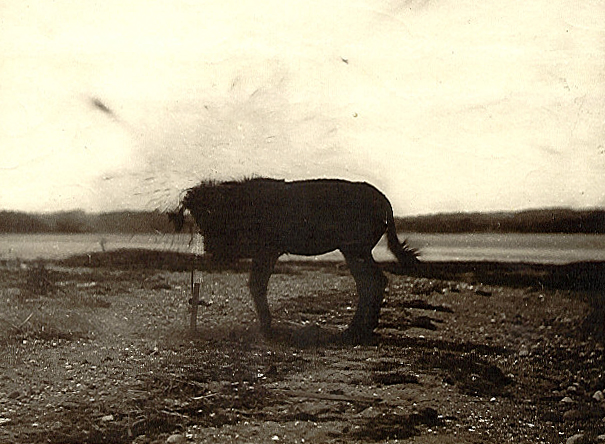
click on image for
larger view
-- November 15, 2017 --
Back To Hitting the Books
I love a good (read:
weird) literary story, and this is another one that deserves to be posted of.
In 1966, Newsday columnist Mike McGrady believed any book with enough
sex would hit the bestseller lists, and therefore the lists of his day were
populated with basic garbage. To prove it, he recruited fellow Newsday
writer Harvey Aronson, 1965 Pulitzer Prize winner Gene Goltz, journalist Marilyn
Berge, and Robert W. Greene (who would later win a Pulitzer in 1970), to write
the crappiest, most sex-filled novel they could.
Each author wrote a different chapter, filling it with the most inane dialog,
scenes that made no sense, and - of course - packed it with tons of sexually
explicit material. The book, titled Naked Came the Stranger, and credited
to the nonexistent Penelope Ashe, was about two hosts of a NYC morning radio
show, The Billy & Gilly Show, who thought themselves to be a perfect
couple. The wife then finds her husband having an affair, and decides to have
flings of her own, which include rabbis and mobsters.
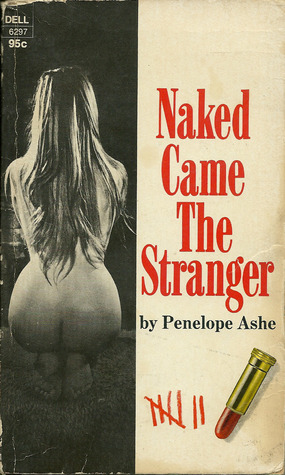
Published in 1969,
on Lyle Stuart, Inc. (who in the 90s became Barricade Books, infamous for reprinting
the racist The Turner Diaries), the book quickly sold 20,000 copies.
The authors soon appeared on TV's The David Frost Show, to expose the
hoax, which helped the sale of another 70,000 - placing the book on The New
York Times' Best-Seller List for 13 weeks. As expected, the book was made
into a porno film in 1975, and, as of today, the novel has sold half a million
units.
The following year, McGrady released Stranger Than Naked, or How to Write
Dirty Books for Fun and Profit, which told the story of the creation of
Naked Came the Stranger, which goes to show that even with the wool pulled
over some people's eyes, they can still smell out sex when they want it.
-- November 01, 2017 --
When Lightning Strikes
Recently, I've
passed some of the most interesting spots in the United States, yet rarely gotten
to stop, and visit. Sometimes, luck is on my side, and I've pulled over to enjoy
what I normally have been flying by.
One such case was when I stopped at Nevada's Thunder Mountain Monument.
In the late-1960s, WWII veteran Frank Van Zant took LSD one day, and suddenly
believed himself to be a Native American. In 1969, he changed his name to Rolling
Mountain Thunder, and began to construct bizarre monuments in the small town
of Imlay, which were to supposed to be shelters for American Indians in the
upcoming apocalypse, calling it Thunder Mountain. Off the side of I-80, be built
a number of buildings (using rocks, cement and discarded junk), as well as over
200 statues. The site became home to hundreds of hippies throughout the 70s.
In 1983, Nevada made Frank their "Artist of the Year", but soon someone
tried to burn down Thunder Mountain, and destroyed a bit of it.
Sadly, in 1989, he put a gun to his head, and ended his career as an outsider
artist. The buildings sat derelict, until the state made it a historic site
in 1992.
For more photos of my visit, click here.
-- October 20, 2017 --
The King In Yellow
I think there is
something terribly wrong with those who commit acts of art vandalism. Sure,
there are a few people who've fucked up works by mistake, like the kid who tripped,
and put his fist through Paolo Porpora's Flowers (a 17th Century painting,
priced at $1.5 million). There are also ones who have done it purposefully,
and without merit, such as the constant attacks on Leonardo da Vinci's Mona
Lisa (an acid splash in 1956, as well as a rock thrown a few months later,
plus red spray paint in 1974, and a souvenir mug thrown in 2009). A few executions
are supposedly legitimate, such as artist Ai Weiwei dropping a million dollar
Han Dynasty vase to protest China's human rights violations. There are so many
deeds of art vandalism, Wikipedia has an entire page listing most of them (see
here).
One of the odder ones would have to be the case of Russian-born art blogger
Wlodzimierz Umaniec, who walked into London's Tate Modern in October of 2012,
and vandalized Mark Rothko's 1958 piece, Black on Maroon. After stepping
over the roped barrier, Umaniec proceeded to write on the Rothko's work, with
a type of homemade black marker popular with graffiti artists, "A Potential
Piece of Yellowism," then signing it with his tag-name, "Vladimir
Umanets". It is believed Wlodzimierz performed the vandal operation to
further his art career, and gain press for his art movement known as "Yellowism".

On his blog, he
writes, "Yellowism is not art, and Yellowism isn't anti-art," explaining
in an interview, "The main difference between Yellowism, and art, is that
in art you have got freedom of interpretation, in Yellowism you don't have freedom
of interpretation, everything is about Yellowism." Confused? No matter,
because the action garnered the self-proclaimed artist two years in jail, not
to mention several more years of scorn from art lovers.
Well, it's good to know that for most of these works of iconoclastic destruction,
there is retribution. While this artist was put behind bars, in the case of
the previously mentioned vase-dropping, an angry citizen, Maximo Caminero, walked
into an Ai Weiwei retrospective in Miami, and smashed one of the artist's 16
vases on display. So, if you're looking for way to become famous, try creating
something instead.
-- October 05, 2017 --
False Narratives
Keeping up with
my posts on books, I'd thought to share this odd slice of literary history.
In 1955, Jean 'Shep' Shepherd, best known for his hilarious 1983 movie A
Christmas Story, was hosting an AM radio show on New York City's WOR. He
was peeved at how most books had gotten listed in many bestseller lists, which
consisted, not only on sales, but also on requests at book sellers. To help
change the process, he asked his listeners to go to book stores, and ask for
a nonexistent book and author, I, Libertine by Frederick R. Ewing, even
going so far as to set up a plot, and claiming it was banned in Boston. Fans
of the show did so, with a few actually referencing it in articles of smaller
newspapers. The fake book had gotten so much demand, it made in onto The
New York Times' Best Seller list.
Later, Shepherd, along with publisher Ian Ballantine, and novelist Theodore
Sturgeon, decided to actually write the novel. Sturgeon typed all day long,
and when he passed out from the day's work without finishing it, Ian's wife,
editor Betty Ballantine, finished the last chapter for him. The book, with a
cover by science fiction and fantasy artist Frank Kelly Freas, was released
by Ballantine Books in September of 1956, even though The Wall Street Journal
had exposed the hoax a few weeks before. Not wanting to fleece folks, the profits
from the sale of the book were donated to charity.
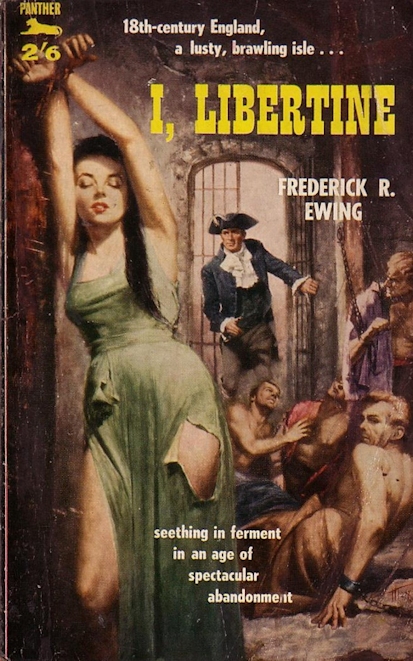
-- September 18, 2017 --
Lost In Translation, Literally
In 1855, Portuguese writer Pedro Carolino thought to help many of his countrymen learn the English language by translating an 1853 Portuguese–French phrase book, O novo guia da conversação em francês e português, written by José da Fonseca. The only problem was that Carolino didn't speak a word of English himself. He thought to fix that by using a French-English dictionary, and got to work translating the phrase book word by word.

The result, O
novo guia da conversação em portuguez e inglez, became one
of the earliest known examples of unintentional humor, as phrases such as "Quem
cala consente" (Silence is consent") became "That not says a
word, consent", and "Anda de gatinhas" ("He's crawling")
were turned into "He go to four feet".
In 1883, a Boston publishing house reprinted the book, under the title English
As She Is Spoke, and included an introduction by Mark Twain (Samuel Clemens),
who wrote, "Nobody can add to the absurdity of this book, nobody can imitate
it successfully, nobody can hope to produce its fellow; it is perfect."
The original helped spawn many other works of comedy, including L'Anglais
tel qu'on le parle (French Without a Master), by playwright Tristan
Bernard (Paul Bernard), and Eugène Ionesco's La Cantatrice Chauve
(The Bald Soprano), which both use lines from the book, as well as Ingglish
az she iz spelt in 1885, by Fritz Federheld (Frederick Atherton Fernald),
and Paul Jennings' 1976 British travel guide Britain as she is visit.
You can read an abridged version of this slice of hilarity here,
or - if you're lucky - check eBay for an original.
-- September 07, 2017 --
Can Milk Make Grapes Sour?
Sometimes, it's
better to just ignore a troublemaker. A lot of the time, if you take one on,
you're just making bigger trouble for yourself.
Though mothers had known this for ages, the issue of breast-milk substitutes
causing health risks for newborns was publicly brought to light by the International
Baby Food Action Network, who encouraged the practice of nutrition through natural
methods, and inspired a 1973 article in New Internationalist magazine.
In 1974, a British antipoverty charity, called War On Want, released a small
booklet, titled The Baby Killer. The pamphlet attacked the Swiss food
company Nestlé, and what WOW claimed was their "aggressive marketing"
of breast milk substitutes in third-word countries.
Instead of letting
a handful of malcontents talk shit about them, and having the headache go away
in time, Nestlé decided to sue the group for libel. The case was brought
before Judge Jürg Sollberger, who only sided with Nestlé because
the company couldn't be held responsible for the death of infants "in terms
of criminal law", and fined the fund a mere 300 Swiss Francs (about $400
US).
This caused a bit of a stir with the media, and the story began to gain traction.
The boycott was soon picked up by Minneapolis, MN's Infant Formula Action Coalition,
which helped spread the word in Canada, then Australia, and the rest of Europe.
By 1978, the US Senate held a public hearing looking into the promotion of breast-milk
substitutes, and wound up calling for a marketing code. The following year,
the World Health Organization and UNICEF pushed for a marketing code in an international
meeting, and the 34th World Health Assembly approved Resolution WHA34.22 which
includes the International Code of Marketing of Breast-Milk Substitutes in 1981.
In 1984, Nestlé finally gave in, and proved that there are times when
the bigger guy should just take getting picked on by smaller folk.
If you'd like to read the now-infamous tract, The Baby Killer, click
here.
-- August 21, 2017 --
Light Up the Sky
Since everyone
is on an astronomy kick because of the solar eclipse, I'd thought I'd tell you
about another great event that'll happen in our lifetime (supposing you don't
die in the next five years).
In 2022, a "new star" will not only be visible, but possibly be one
of the brightest stars in the night sky. Well, for at least six months, anyway.

Back in our 3rd
Century, 1800 years ago, two stars in the Cygnus constellation (a binary system
named KIC9832227) crashed into one another forming a Red Nova. The light from
the two stars joining will reach us soon, and has been dubbed the Boom Star.
First discovered in 2013 by Professor Larry Molnar of Calvin College, who, using
data dating back to 1999, noticed the orbital speed of the system decreasing
as time went on. Though these types of explosions occur once every ten years
in our galaxy, this one is close enough for us to see it with the naked eye.
According to the work presented at the 2016 American Astronomy Association meeting
in Texas, it should be one of the most visible stars for a minimum of six months.
The UK's Royal Astronomical Society's Dr. Robert Massey said, "Nobody has
ever managed to predict the birth of a star before, so this is really unprecedented,
and I think there will be a race among amateur astronomers, and members of the
public to spot it first."
SAD UPDATE: According to a paper published in in The Astrophysical Journal
Letters, a team of researchers led by Quentin Socia of San Diego State University,
took a look at Molnar's work, and found that this will not happen when specified.
Professor Molnar reexamined his work, and found the error Socia pointed out.
The event may still happen, but probably not in our lifetime.
-- August 11, 2017 --
When Bones Tell A Tale
Abel Folgar, over at Miami New Times, asked me a few questions concerning my recent 10" release for an online feature.
Click here to check it out, and enjoy the read!
-- July 28, 2017 --
Massacre of the Innocent
I'm a huge animal
lover, and this is one of those stories that really got to me.
I understand depression, and that many can't control their actions when they
suffer from it, but sometimes those actions boggle even my mind. Take the case
of Terry Thompson. Terry was a veteran of the Vietnam War, but - more importantly
- one of Ohio's best known exotic animal collectors. In 2008, he appeared on
The Rachael Ray Show, and also supplied animals for photo shoots, but,
in 2010, Thompson was arrested on federal gun charges, and was sent to prison.
Soon, he was in debt, and then his wife had left him. Afterward, he decided
to cut this mortal coil.

On October 18th of 2011, Terry decided to commit suicide by shooting himself in the head, but, before doing so, he set free all the animals at his Zanesville, OH private zoo, Muskingum County Animal Farm. He released 56 animals, including eighteen tigers, seventeen lions, eight bears, three cougars, two wolves, and a baboon. A neighbor, Sam Kopchak, noticed his horse freaking out, and then a lion creeping up to it. He ran for a phone, and called Terry to let him know one of his animals was loose. After no answer, he dialed 911, and the police visited Thompson's property, only to find all the cages empty. Springing into action, the cops put out warnings for the locals, and went on the hunt. 49 of those beautiful creatures were shot, and killed. Of those not gunned down by the pigs: one wolf was hit by a car, and six others (three leopards, a grizzly and two monkeys) made their way into Terry's home, where they were tranquilized, and later brought to the Columbus Zoo.

In the days after,
Ohio governor, John Kasich, signed a temporary moratorium on the sale of exotic
animals, and it is now illegal to own one in that state.
As I normally state after posts like these: if you ever find yourself in desperate
times, and are in need of someone to talk to, please call the National Suicide
Prevention Lifeline at 1-800-273-8255.
-- July 11, 2017 --
The World's Most Dangerous Book
In 1874, S. George & Company released a book by a doctor from Michigan, Robert Clark Kedzie, titled Shadows from the Walls of Death.

Upon returning
to Michigan from his service in the Civil War in 1863, he was offered a chair
in the Michigan Agricultural College's chemistry department. There he he experimented
with beet sugars, and is now remembered as the "Father of the Michigan
Beet Sugar Industry". During his tenure, he found high arsenic levels to
be a major issue in the local soil, and was later (1873) asked to head a Board
of Health committee on "Poisons, Special Sources of Danger to Life and
Health". The following year he released a paper titled, "Poisonous
Papers", and got the idea to release a book on the wallpaper industry's
use of arsenic.
His book, Shadows from the Walls of Death, contained 86 pages, but only
six of those - a preface - contained words. What followed Dr. Kedzie's introduction
were 22 x 30" (56 x 76 cm) wallpaper samples. The reason for the book,
which was released in a very limited quantity, was to showcase the ever-growing
use of wallpaper dyed using arsenic pigments, and it contained actual pieces
of the poisonous wallpapers.
Currently, there are only two known copies, both of which are housed at Michigan
State University's Special Collections Library. Strangely enough, contemporary
interest in the book spawned a 178-page reprint (minus the arsenic, of course),
in 2014.
-- July 07, 2017 --
Huge Apologies
I was struggling
for a bit to find the time to update this blog, and that kind of depressed me.
Well, I've settled in, and feel I can now devote some energy back here. You'll
start seeing new posts before next month.
On a side
note, I am no longer writing for No Echo, but you can still find an archive
of over 30 of my articles on the site (click
here).
Check back soon for new posts!
-- February 25, 2017 --
Gone Again!?
Yep. I'm hitting the road again for a bit: traveling up to Green Bay, WI, and Atlanta, GA, for about a month. Though I plan to keep up this blog when I return, I'll have no new projects out for some time (except the upcoming 156 Good-Bye, Bed-Stuy, Ten Times cassette / booklet, due out this summer). I'll also be working on, and wrapping up, my newest issue of Exscind, but that won't be out until almost next winter. Still, I wrote some great music pieces for No Echo, which they will post throughout the next two-three months, so check them out until I return to regular posting here. Cheers!
-- February 17, 2017 --
Well Heil Be Damned
Christian socialist and novelist Francis Julius Bellamy (1855 - 1931) is best known for penning the most recent version of the U.S. "Pledge of Allegiance" in 1892. Immediately after writing the Pledge, he recalled a salute created by James B. Upham, which Bellamy found in the children's magazine The Youth's Companion, and thought it would fit perfectly. He called it the "flag salute", and it was demonstrated for the first time on October 12, 1892 for the National School Celebration of Columbus Day. It originally had an open palm facing up, but many found it uncomfortable, and it was soon switched to holding the palm down.

The salute was picked up by Italian Fascists in the 1920s (calling it the Roman salute), and it was later adopted by the Germans (known as the Sieg Heil). Once the Unites States got involved in World War II, Congress amended the Flag Code in 1942, replacing what became known as the "Bellamy salute" with the simple gesture of holding one's hand over their heart for civilians performing the "Pledge of Allegiance".
-- February 06, 2017 --
No Such Thing As Bad Publicity
In 1874, author
Mark Twain (born Samuel Clemens, 1835 - 1910) got to watch a typewriter demonstration
in Boston, and immediately bought a Remington Typewriter. Even though the entire
globe was suffering from an economic depression, Twain spent $125 on his newfound
contraption - what would be about three grand today. A few days later, he typed
his first letter to his brother on December 9th, complaining that his daughter
was using it more than he was. By 1875, he had given it away twice, and it was
returned to him both times. The following year, after publishing The Adventures
of Tom Sawyer, he claimed it was the first novel to be written using a typewriter,
but this was not true, and Twain probably made the statement only to be first
at something.
The company who made his typewriter, Remington Typewriter Company, got wind
of this, and asked him to help promote the machine, to which he replied:
Gentlemen:
Please do not use my name in any way. Please do not even divulge the fact that
I own a machine. I have entirely stopped using the Type-Writer, for the reason
that I never could write a letter with it to anybody without receiving a request
by return mail that I would not only describe the machine but state what progress
I had made in the use of it, etc., etc. I don't like to write letters, and so
I don't want people to know that I own this curiosity-breeding little joker.
Yours truly,
Saml. L. Clemens
By the turn of
the century, Mark changed his tune, and wrote in his 1904 autobiography, the
"early machine was full of caprices, full of defects - devilish ones. It
had as many immoralities as the machine of today has virtues."
The Remington company got wind of those lines from then-unpublished autobiography
(from an article in The North American Review), and used the previous
letter, and a section of the book, in a full-page advertisement in Harper's
Magazine in 1905.
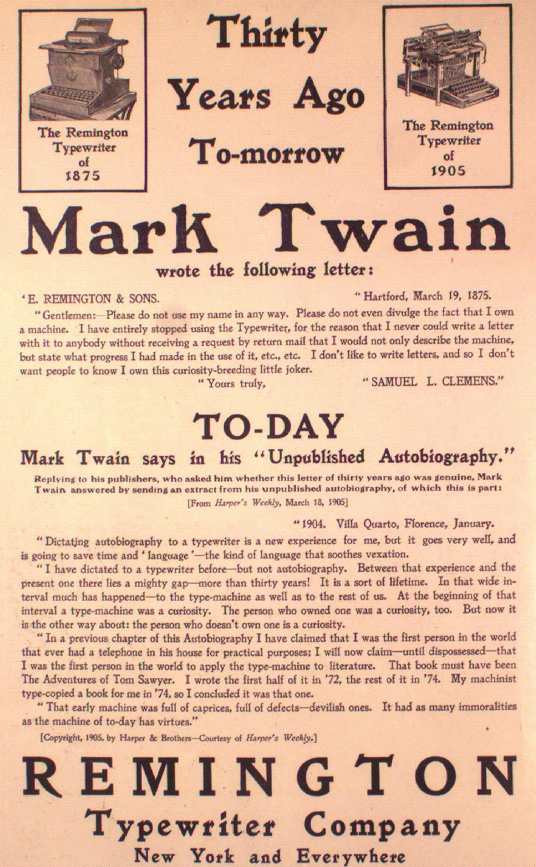
click on image for
larger view
All press is good press, I guess.
-- February 01, 2017 --
A Bone Shaking Good Time
Wednesday, February 8th, 156 will play a rare show at the 13th annual International Noise Conference in Miami, FL, @ Churchill's Pub (5501 NE 2nd Ave). The doors open at 9pm, but there are dozens of bands that night, so please turn up early to support all the artists. Others playing include Drowning the Virgin Silence, Erratix, Pain Appendix, Sloth, City Medicine, and Destructive Bodies.

click on image for
larger view
It's been three years since the last 156 show, and - yes - this set will be based off the Memento Mori sessions. I will be using only human bones, hooked up to electronics manipulated by Brett Slutski of Destructive Bodies / Acid Casualty.
-- January 23, 2017 --
Put On Your Aluminium Foil Hats
Did you know there
was a time when aluminium was more expensive than gold?
In fact, Napoleon III let most of his banquet guests use gold tableware, but
he saved the aluminium cutlery for his most cherished visitors. Pure aluminium
was so rare - even though it makes up 8% of Earth's crust - that whole bars
were on heavily guarded display in most houses of European royalty. It even
crowned the top of the Washington Monument in 1884 (a 6 lbs / 2.7 kg pyramid),
because it was then the most expensive metal around.

Aluminium, element
13 on the Periodic Table, is never found in its pure metallic form, and is normally
mixed with oxygen in rocks or clay. In the 1780s, many scientists thought alum
salts contained an unknown metal, but it wasn't extracted until 1825, when Danish
chemist Hans Christian Oersted developed a procedure to extract extremely small
amounts of it. By 1845, German Friedrich Wöhler (using his own method)
was able to produce larger samples. This still kept aluminium at around $1200
a kilo (current value would be at over $26,000). Wöhler's method was then
improved in 1854 by Frenchman Henri Sainte-Claire Deville, which made its value
drop to about $40 per kg ($900 today).
In 1886, American chemist Charles Martin Hall, and yet another French chemist,
Paul Héroult, independently invented new processes (using electric batteries)
to cheaply obtain aluminium oxide from bauxite ore. Karl Joseph Bayer, an Austrian
chemist, further developed the practice in 1888, which is still the method we
use today. Charles Hall established the Pittsburgh Reduction Company, producing
25 kilograms per day, but by 1909 the amount reached 41,000 per day, and this
caused the price to fall to 60 cents per kilogram (just $10 in our modern economy).
On an interesting side note: the reason we Americans say, and write, "aluminum"
is in part thanks to a small mistake. When Hall advertised his product, the
"i" was erroneously dropped, and he thought that made it sound very
similar to valuable platinum. While all his patents show the element as "aluminium",
his company was soon named Aluminum Company of America, and it stuck in the
States.
-- January 11, 2017 --
Active Again... Almost Radioactive
I'm back from my
vacation, and although I have yet to find a place to settle down, I do have
a story for you.
Remember a little over a year ago, a 14-year-old boy named Ahmed Mohamed was
charged with a hoax bomb when bringing a homemade clock project to school? That
scene has nothing on the case known as The Radioactive Boy Scout.

In 1994, 17-year-old
David Hahn was in love with chemistry so much, that he decided to build a breeder
reactor in his mom's backyard shed in Commerce Township, Michigan. Inspired
by 1960 book The Golden Book of Chemistry Experiments (by Kurt Saxon
and Robert Brent), David had soon outgrown simple exercises, and began attempting
dangerous procedures. For most chemists, these ventures were treacherous enough,
but Hahn - being a poor student in school - was rather inept in this field.
He once showed up to a Boy Scout meeting glowing orange, after creating a fake
tanner that exploded in his face. Another time, he almost blew off his hand
when he stupidly tried to stir a vat of pure potassium with a metal screwdriver.
One thing he was good at was subterfuge. In 1993, after receiving a merit badge
in Atomic Energy (yep, it's real), he began to write to government officials
as "Professor Hahn", saying he wanted to know of some atomic exercises
his students could perform in class. Even though the letters contained several
misspellings, and mistakes, many offered information that helped David begin
to building a nuclear reactor. Hahn collected radioactive material from household
products (radium from clocks, tritium from gunsights, and thorium from camping
lanterns), as well as purchasing $1000 worth of batteries, to extract the lithium
in helping to purify thorium ash using a Bunsen burner. If you're wondering
where a minor could get that type of cash, I guess the children of divorced
parents tend to get special treatment. So much in fact, that his mom and stepdad
were hardly suspicious of why, every time David exited the shed, he would throw
out his clothes and shoes.
It seems that Hahn was - even though wearing a dentist's lead apron - getting
a bit nauseous, and decided to scrap his atomic trials a little before his home
reactor reached critical mass. As he was dumping the goods, a passing officer
thought the trash was a possible discarded drug lab, and called for backup.
Once realizing they were out of their element, the fuzz called the FBI, who
in turn turned to the Nuclear Regulatory Commission, which found over 1000x
the normal level of background radiation. The Environmental Protection Agency
designated the Hahn home a hazardous materials cleanup site, and later buried
the shed in a Utah radioactive dump.
As you'd expect, things didn't go well for David after all this. Possibly due
to the stress of the scandal, his mother committed suicide the following year.
Hahn enrolled in community college, but soon dropped out. He followed it up
with a stint in the Navy, and later the Marines, but was then diagnosed as a
paranoid schizophrenic with bipolar disorder. In 2007, DH was arrested for larceny,
after being found with a large amount of smoke detectors from the apartment
building were he lived. Due to his face being covered in sores, it was believed
he was again exposed to a large dose of radiation from collecting the detector's
americium.

Hahn died one year and 13 days after the Ahmed Mohamed clock incident, at only 39 years of age. It is believed his life was shortened due to his wild experiments with radioactive materials.
-- December 05, 2016 --
On Vacation, Sorta
I've decided to
hit the road for a bit.
Packed up what little belongings I haven't got rid of yet, and am looking for
a new home base. Brooklyn has been kind to me, and my seven years here have
been filled with amazing days, and fun-filled nights, as well as nurturing one
of the most creative times in my music and art career. I may return to the area,
but may settle somewhere completely different, so I'm going to use this time
to figure that out.
Orders are being filled by a few friends; if there is anything of mine you'd
like to order, please feel free, and don't hesitate.
I hope to be back online a little after the New Year, so here's to posting again
in 2017!
Until then, Razorcake's
website should post the last collection of my "backpatch pics"
pretty soon, plus music website
No Echo has a few music articles of mine that should hold you over.
Otherwise, from here on down: read slowly.
-- November 23, 2016 --
Hijacked High Jinks
Allen Funt was once the host and producer of a tv prank show called Candid Camera. Predating Punk'd by half a century, the show actually began on the radio as The Candid Microphone in 1947 on ABC Radio. The show ran for three months, until Funt decided to film segments for theaters to screen before a movie, and their popularity led to a tv series on ABC Television. Still called The Candid Microphone, the prank show changed its name to Candid Camera when it was bought by NBC Studios in '49. After a three-year run, the show was canceled, but later became a segment on Jack Paar's The Tonight Show (NBC, 1958), and later on The Garry Moore Show (CBS, 1959). The idea for a tv show resurfaced, and new episodes began airing in 1960, and ran until 1967 on CBS. Even though off the air, the show's popularity supported Funt to produce a movie, What Do You Say to a Naked Lady?, in 1969.
During production
of the film (February 1969), Allen and his family scheduled a trip on Eastern
Airlines from Newark, NJ, to Miami, FL. In the middle of the flight, the captain
announced the plane would land in Havana, Cuba instead. It turned out they were
being hijacked by terrorists, but many on the plane didn't believe it, thinking
it was all part of some tv stunt. Four different passengers approached him throughout
the flight to commend him on this new work.
Writing of his experience the next day for an Associated Press article,
Funt said, "Looking back at the experience, the unbelievable thing is the
way everybody took it as one big joke. We saw the knife, but everybody was cool
and calm, just a little annoyed at the delay. It
is strange how you can be so close to danger, and not feel it. The biggest joke
for me was how much the whole thing looked like a bad movie. Nobody looked the
part. The hijackers were ridiculous in their business suits. The captain with
super calm announced that we were going to Havana because two gentlemen seemed
to want to go there."
In the end, no one was hurt, and all those aboard the plane were treated as
guests upon arrival. For their eleven-hour stay, everyone was fed, and even
given a guided bus tour of Havana. After racking up $5000 worth of expenses,
the passengers were returned to the plane, and the flight continued back to
Florida with no one laughing.
-- November 13, 2016 --
Ghost Island
There's an island out there, that exists in time, but not space, yet it's nowhere near the Bermuda Triangle. On maps, Null Island is located where the equator crosses the prime meridian, at coordinates 0°N, 0°E, in Africa's Gulf of Guinea. While described as a one square-meter island, on the physical plane, nothing is there, but a floating weather buoy (named Station 13010, also known as "Soul", an observatory for the Prediction and Research Moored Array in the Atlantic data system).

Null Island has
been used on maps for only the last half of the 20th Century, but didn't gain
wide acceptance until 2011, when it was entered into the Natural Earth public
domain map dataset (with support from the North American Cartographic Information
Society). The plot of "land" at those coordinates in the digital dataset
was intended to assist analysts in finding errors in geo-coding. If using a
coordinate / map projection besides the Global Positioning System (GPS) - being
different frameworks to convert spheres, ellipsoids, and planes for mapping
- the position of "0,0" could land you in one of thousands of places
around the world, so it's a necessary nonexistent land.
Sorry if I spooked you.
-- November 04, 2016 --
156 Record Release Party
On Saturday, November 12th in Manhattan's West Village, my experimental industrial outfit 156 will celebrate the release of our new 10" vinyl EP with a party at SoHo Psychoanalytic (30 Charlton Street, Suite #1), hosted by psychiatrist Vanessa Sinclair, PsyD. As well as a listening party, I will hold a talk on the recording of the EP, with special guest poet and publisher Katy Bohinc presenting a brief lecture on the anatomy of the universe in comparison to the human skeletal system.

Copies will be
available for purchase. Otherwise, feel free to drop by the 156
Bandcamp page for mailorder or digital.
A track off Memento Mori premiered on episode #225 ("Take the Information"
- October 29th) of the :zoviet*france: radio show, A Duck In A Tree.
Click here
to listen.
Lastly, a new music video was made for the first track off Memento Mori's
side two, "Me-Olam, Ad-Olam".
Hope to see you Saturday!
-- October 26, 2016 --
The Kooky World of Cult Music
I wrote a two-part piece for No Echo on music made, and released, by cult organizations such as the Nation of Yahweh, Church of Satan, Branch Davidians, Werewolf Order, and more.
Check out my earlier part one here, and part two was just posted here. Enjoy!
-- October 17, 2016 --
The Man, the Myth, the Monster
So you think
the Dylan nomination for a Nobel Prize is an odd one? Then let me tell you a
story.
Ever since reading a stack of Robert Anton Wilson books back in the early 90s,
I have been obsessed with the criminal mastermind Licio Gelli.

Gelli
was born in 1919, though little is known about his early personal or family
life. A Fascist through and through, and as a member of Mussolini's Blackshirts,
he went to Spain in support of the Falangists in the Spanish Civil War. It is
believed Licio became a spy for both Nazi Germany and the US's CIA, playing
each off the other. After WWII, he helped establish the Italian Social Republic
with Giorgio Almirante, and then became involved in business as a textile manufacturer.
Gelli
was also a member of a secret Masonic lodge called Propaganda Due (aka
Propaganda Two), which, under his Mastership, morphed into an ultraright think
tank. In 1970,
he was a key figure in the Golpe Borghese coup d'état, where he
was to arrest Italian President Giuseppe Saragat. After the failed coup, he
was exiled to Argentina for several years, even initiating dictator Juan Perón
into Freemasonry there. During this time, the Masonic Master set up oil and
arms deals between Libya, Italy and Argentina through the Agency for Economic
Development.
In 1981, banker Roberto Calvi was discovered hanged under a bridge, and was
found to have been laundering money for the Italian mob, and Propaganda Due,
through Banco Ambrosiano, then known as "the Vatican bank". Further
investigation led the Italian government to almost 1000 names of military and
civil servants on the P2 membership list, which was illegal under Article 18
of the Italian Constitution (future Italian prime minister Silvio Berlusconi
was on that list), as well as many of the Catholic Church's Italian hierarchy.
Arrested, Licio escaped, and fled to Switzerland. Gelli surrendered in 1987,
and was charged with the 1982 collapse of Banco Ambrosiano, and in connection
with the 1980 Bologna railway station bombing, that killed 85 people. He was
sentenced to 12 years in '88, but again fled. Captured in Cannes, France, he
sat under house arrest until an indictment was handed down, along with former
Mafia boss Giuseppe Calò, for the murder of Roberto Calvi, and politician
Aldo Moro. He was acquitted for lack of evidence.
I've only recently learned that, in 1996, in a move that defied any logic, the
Swedish Academy nominated Licio Gelli for a Nobel Prize in Literature, a choice
supported by both Mother Teresa and Naguib Mahfouz. In 2003, he claimed a "democratic
rebirth plan" was being implemented by Silvio Berlusconi, and that "...all
is becoming a reality little by little, piece by piece. To be truthful, I should
have had the copyright to it. Justice, TV, public order."
On December 15th of 2015, Licio died in Tuscany, at the age of 96, a calm and
happy man, caring little for the lives he played like pawns, while the shadows
of those he helped put in power cast darkness throughout the world.
-- October 09, 2016 --
Classic Cuts From Cults
I wrote a two-part piece for No Echo on music made, and released, by cult organizations such as Scientology, The Process Church, Nation of Islam, Jews for Jesus, and more.
Check out part one here. Part two will be posted soon, so check back often.
-- October 01, 2016 --
Rattle My Bones
The Memento
Mori EP is finally out! These sessions have been sporadically recording
since 2012, due to the scarcity of the instruments, which include skulls, femurs,
vertebrae, bone whistles, and Tibetan thighbone trumpets (kangling). While still
in the spirit of the early industrial of Einstürzende Neubauten, Test Dept,
and Z'EV, this release is 156's most primitive in sound. Nine tracks, playable
at two speeds, with all the music being made using only human bones, or breath
passing through human bones.
The new EP
by 156 was mastered by James
Plotkin for, both, the vinyl and digital release. The digital version is
available for download on 156's Bandcamp
page (for $8), otherwise contact me
to purchase the bone-colored 10" vinyl version, which is limited to 489
copies ($20 postage paid in North America, $30 for the rest of the world). Physical
copies come with a liner note placard, along with a postcard, and a free link
to the digital download.

A music video has been uploaded for the first track, "Kokoro", off the Memento Mori EP.
The record was
released to serve as - for those who cannot obtain one - the skull's replacement
in the ritual room where a scholar contemplates death in the rite of ars
moriendi ("The Art of Dying").
I have also made four artist editions, which include: one standard copy of the
10" EP, along with one test pressing (with hand-painted labels), and a
human rib bone, with hand-painted lettering of the EP title. There is only one
left (priced at $50), and is available by contacting
me.

click on image for
larger view
-- September 27, 2016 --
Not Lacking In Immortality
Henrietta Lacks
died in 1951, but she's still growing. Huge, actually!
Lacks was an African-American woman from Roanoke, VA. She lived most of her
life with her grandparents, as her father could not care for all the kids after
her mom died during their 10th child birthing. Henrietta worked in the area's
tobacco industry, until moving to Maryland. Not long after, she was diagnosed
with cancer (adenocarcinoma of the cervix), and quickly died.
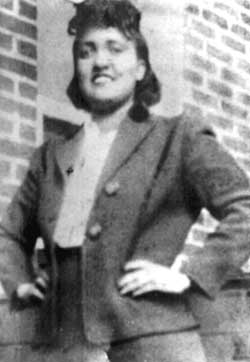
Doctor George Otto
Gey noticed her cells reproduced at a uniquely high rate, and collected them,
which helped scientists preserve, and work with, them for longer periods. Rather
than the cells normally dying after a few days, they could be divided, and new
cell groups formed almost infinitely, making Lacks the donor of the first Human
Immortal Cell Line, now known as the HeLa cell line.
In the 1970s, a large sample had been contaminated, and to help further study
it, researchers began to contact her family. Nervous of the many phone calls
asking for blood samples, the woman's family looked into the matter, and discovered
Henrietta's cells had been harvested without anyone's consent, though a court
later ruled a person's discarded tissue is no longer their property.
The HeLa cell line is still alive today, and has since grown over twenty tons
of cell life, along with collecting 11,000 medical patents.
-- September 16, 2016 --
Don't Get Tanked Around Trees
Readers of my New York blog, This Hidden City, know I'm a bit of a tree hugger - especially after my piece on visiting NYC's oldest living thing, the Alley Pond Giant (read it here).
I enjoy stories
of old trees (like California's 4800-year-old Methuselah), weird trees (such
as Somalian Dragon Blood, or Monkey Breads from Australia), flowering or poisonous
trees (Wisteria and Manchineel), but here I'll share two quick tales where alcohol
played a role in a tree's life.
First up is the Tree of Ténéré, thought to be an Acacia
raddiana. It was the only tree for 250 miles (400 Km) in Niger's northeastern
section of the Sahara Desert. For years it was the only tree located on maps,
simply due to help in positioning oneself in the far expanse of the area. On
November 8th of 1973, a Libyan trucker was driving drunk off his ass, when he
hit the only thing for miles around. The dead tree is now on display in the
capital city's Niger National Museum, and the spot is now marked by a metallic
structure which represents the tree.

From sad to silly, we'll now learn that, in 1898, a drunk British officer (James Squid) was walking about a tribal area in Pakistan known as the Khyber Agency, when a he felt as if a certain banyan tree was about to attack him. Perceiving himself to be under threat, Squid ordered the arrest of the tree. A sergeant obeyed the officer's orders, and chained up the offender. Though many then said it was a joke to teach the locals about not obeying the British, today it's seen as a hundred-year-old testament to drunken stupidity, as well as nifty tourist spot.

All that's left
to say is that if you are headed out to the woods any time soon, try to keep
your spirits locked in the bottle, or you might find yourself on the wrong side
of a plant's history.
-- September 05, 2016 --
Words To Battle Dreamless Sleep
I'm joining a handful
of poets on Monday, Sept 19th, for Rendering Unconscious, a reading featuring
automatic poetry inspired by chance, dreams, fantasies and other workings of
the unconscious.
I've been asked to read some of my throwaways,
as the project appropriately fits the evening's theme. I will be reading ten,
with half the batch written before a life-changing event, and the other half
after.

It starts at 8pm, and will be held at the Delancey's rooftop (168 Delancey St, Manhattan). Fellow speakers include Katy Bohinc, Katie Abbitt, Jason Haaf, Peter Milne Greiner, Vanessa Sinclair, and Jennifer Smith.
-- August 29, 2016 --
Reaching For the Sky
Mankind has always
been fascinated with the stars, and we've been constructing observatories to
watch them, track them, and worship them, since time immemorial.
The oldest known ground observatories are Goseck Circle in Germany (~5000 BCE),
and Stonehenge in UK (~3300 BCE), which were built along to astronomic alignments,
possibly for keeping track of dates to help with farming. Within a thousand
years, monolithic calendars were to be found throughout Europe (such as Kokino
in Macedonia), and Russia (Arkaim in the Urals steppe). By the general period
of classical antiquity, they had changed from simple almanacs to laboratories,
with record keeping, star catalogs, and instruments of astrometry, which soon
helped humans develop geography, meteorology, astronomy, and furthering mathematics.
Two notables worth mentioning are Hipparchus' observatory at Rhodes (Greece),
and Chankillo in the coastal desert of Peru.
Throughout the Dark Ages, Islam and the East took a bigger interest in our place
among those celestial bodies, and constructed some of the most beautiful observatories
before the invention of the mega-telescope (Maragheh, Iran; Mahodayapuram in
India; and Gaocheng, China). By 1600, Europe caught up, as they first appeared
in Denmark, then outward from there.
Of course, holding a strange technological and metallic majesty, we have some
beautiful ones today, too, such as ALMA in Chile, Arecibo in Puerto Rico, and
Roque de los Muchachos in the Canary Islands.
Still, none compare to India's Jantar Mantar - in size, grand style, and proportion.
This little-known location looks like a playground, yet everything looks like
art.

Located in the
city of Jaipur, in the Indian state of Rajasthan, the observatory was finished
in 1734, and commissioned by the Rajput king Sawai Jai Singh. The grounds hold
nineteen huge instruments, which operate in the three main classical celestial
coordinate systems: horizon-zenith local, equatorial, and ecliptic.

Sadly, while the
instruments are all made of brick, marble, stone, and brass, they are set with
Ptolemaic positions (which are not heliocentric), so some of the sights will
forever go slightly askew as time goes on.
Still, one of the most amazing tools there is the Vrihat Samrat Yantra (pictured
tallest below). It is the world's largest sundial, and is accurate within 5
seconds or less.

Another real beauty here is the Jai Prakash Yantra (seen near bottom center below), which contains two half-bowl sundials, holding marked marble slabs with inverted images of the sky, allowing observers to move within the instrument; measuring altitude, azimuth, hour angle, and declination.

The name stems
from the colloquial pronunciation of yantra (instrument) and mantar
(calculate), and theories behind the instruments are found in ancient Hindu
Sanskrit texts by Aryabhatta, Brahmagupta, Varahamihira, Lalla, Sripati, and
Bhaskara (400 - 1000 CE, listed chronologically).
Though rarely known outside of India (it last served as the maze in Tarsem Singh's
2006 fantasy film The Fall), besides being an image chosen for the cover
of electro-psych outfit Shpongle's 2008 DVD, Live at the Roundhouse,
the west is far from recognizing this wonder of a king wise enough to stare
at the stars, and dream big.
-- August 21, 2016 --
The Psychotropic Poetry of the Preternatural
My friend, and psychologist, Vanessa Rawlings Sinclair PsyD, has started a website (along with artist Katelan Foisy) for creative investigations into Dadaist cut-up methods, Surrealism, psychology, Burroughs/Gysin literature, and the occult, called Chaos of the Third Mind.
If her name sounds familiar to my readers, it may be because she wrote the foreword to my unique artpiece/article on the Dada poem (see here), which was reproduced in issue #3 of Abraxas: Journal of Esoteric Studies, as the article "Do Me Dada Style". Fulgur Press, who publish Abraxas, will also release a book by Sinclair this year, so drop by her website often to check up on that.
-- August 16, 2016 --
No Hasenpfeffer From This Hare
Many readers of this blog know I like to post of little-known works of macroscopic and microscopic art; such as Tom Van Sant's "Ryan's Eye", and the Marre Man geoglyph (artist unknown). Strangely, I've never written of my favorite art object of termendous proportions, but that's possibly because of the goofiness of the piece. Well, that was also part of its charm to me, so let me introduce you to Viennese art group Gelitin's 2005 design: Hase. It used to be found on a hilltop in the Piedmont region of Italy, called Colleto Fava. Hase - meaning "hare" in German - was a 200ft (60m) long, 20ft (6m) high, pink rabbit with its guts streaming out.

The work was completely
knitted, and then filled with straw. After leaving it there, the collective
stated the piece was meant to be as huge as it is so visitors feel as if they
were Lilliputians when Gulliver dropped by. The work was meant to be climbed,
and enjoyed as a rest spot or playground.
Now, I mention much in past tense because the design is hardly there anymore.
Though the collective said their mountain bibelot should fully disintegrate
by 2025, the objet d'art is already almost gone.

I had hoped to hop on by before it looked as it does now, but that's a true case of hare-and-tortoise I truly slept on.
-- August 08, 2016 --
Dig That Crazy Jazz
There is a quick
mention in John Szwed's Space Is the Place: The Lives and Times of Sun Ra,
on how much jazz musician, and Prince Hall Freemason, Sun Ra (born Herman Poole
Blount, 1914 - 1993) believed music could heal the mind.
One story Sun Ra would love to tell in example was of back when still playing
under the simple name of "Sonny" (late 50s), and Blount's manager
got him a gig inside a Chicago mental hospital. The ward brought out some of
their toughest cases of schizophrenia and catatonia, as he thrashed his keys,
and tickled the ivories throughout the evening. It was said that a woman - who
had not spoken in several years - got up in the middle of his set, and stood
next to him at the piano. After a few minutes, she leaned over, and spoke into
the composer's ear: "Do you call that music?"
In commemoration of the event, Sun Ra later penned "Advice to Medics"
on his 1956 LP Super-Sonic Jazz.
Sun Ra's interest in mental health grew, and he later released Cosmic Tones for Mental Therapy (recorded 1963, released in '67); an album he believe could bridge the gap between therapy and medication. Predating, and possibly inspiring psychedelia, Julian Cope said was as if "listening to a lost kraut/psych classic inspired by [Syd Barrett and Tangerine Dream]."
Well, what else could anyone expect from someone whose motto was "I use music as a medium to talk to people"? The man may have been from Saturn, but he certainly wasn't nuts.
-- July 28, 2016 --
Food Flop
I used to be part
of the VHS tape trading circuit for a while. It wasn't just having your hands
on something only a handful had seen, as I also loved watching the movies that
were so bad they were forgotten. Films like Blood Freak, Liquid Sky,
Skatetown USA, and Mondo Trasho are all great fun, but some movies
are so terrible it was best they should have been left unmade.
Hollywood has the infamous cases of Ishtar and Gigli, but others
out there are bad to the point of exhausting the viewer in a slow-mix blend
of perplexity, embarrassment, and boredom. One of the best examples of this
is Foodfight!, a 2012 computer animated feature, staring the voices of
Charlie Sheen, Wayne Brady and Hilary Duff.

Sometimes, stars
align, and the Universe tells you you're on the wrong path. Foodfight!'s
producer, Larry Kassanoff, had all the signs, and still forged ahead. The idea
came to him in 1999, and he talked backers into lending him a whopping 25 million
dollars. In 2003, the hard drives containing original copies of the film were
supposedly stolen. Years behind schedule, Kassanoff began round two in a haste.
In the middle of the second animation, Larry had the idea to switch graphic
and motion styles, then claimed the finish product was a result of mixed signals
between him and the animators. By the time it finally wrapped editing (2011),
he faulted on a loan, and the insurance company became the copyright owners
of the entire movie. In 2012, it was released in the UK, grossing only 20 grand
on opening weekend, until quietly being released on DVD soon after.
The film itself is amazingly terrible. The animation is awful, but the plot
is even worse. Centered in a supermarket after closing, the product's mascots
(ala Toy Story) come to life at night, most of whom are at war with a
villainous Brand X. Entertainment website The A.V. Club rightly said
that "the grotesque ugliness of the animation alone would be a deal-breaker
even if the film weren't also glaringly inappropriate in its sexuality, nightmare-inducing
in its animation, and filled with Nazi overtones and iconography even more egregiously
unfit for children than the script's wall-to-wall gauntlet of crude double entendres
and weird intimations of inter-species sex". When asked how Kasanoff could
think to get away with such an extreme episode of product placement, he would
always reply that no company paid him for the use of their logos.
Well, being the sadistic bastard I am, ladies and gents, grab some popcorn,
and enjoy an hour-and-a-half of suffering (and corporate brainwashing).
-- July 18, 2016 --
A Double Shot
I have two new
music articles over at No Echo.
The most recent, "They
Hate Us, We Hate Them", is a musical trip into the anger aimed at the
early punk movement, with a touch of politics, and some wild tv clips from the
80s.
Earlier, No Echo posted my brief history, "The Dio You Don't Know", on the 1960s musical work of heavy metal hero Ronnie James Dio.
-- July 10, 2016 --
Unidentified Fleecing Objects
As much as I love
a good UFO case, I find great joy in a good UFO hoax. One of my favorites was
the infamous UMMO affair in Spain.
In the early 1960s, the countryside surrounding Madrid had UFO sightings, with
many recalling a symbol on the bottom of the craft, like a capital H with an
I in the middle of it. In 1965, some physicists, artists and members of the
Society of Friends of Space, were mailed highly scientific documents, the covers
all carrying the same symbol as on the UFOs. The writer (or writers) claimed
to be an alien race from the planet UMMO, and the documents became known as
the UMMO Papers. The science in the reports showed to be pretty spot on, but
the work also carried a warning message about where we were headed as an Earthly
species. A number of UFO researchers felt this was something truly important.
Contact, mostly via mail, was kept up until the early 70s, but many studying
the case felt it was an elaborate prank by still unknown jokesters (though telecommunication
expert, and UFO researcher, José Luis Jordán Peña claims
responsibility). A handful in Spain still hold that the UMMO Papers, and the
alien contact, are real, and important, while the rest of the world laughs.
Canada has its own version of the UMMO case, and it's called the Carp-Guardian
case. In 1989, Canadian UFO Research Network member, Tom Theofanous, began receiving
anonymous packages from someone simply calling themselves "Guardian".
The first packages contained introduction letters, and documents, with the fourth,
and final (in 1991), holding a video tape. On that VHS cassette was a supposed
alien craft landing somewhere in Ottawa, from two different vantage points.
The documents were
labeled from the Canadian Department of National Defense, and outlined how the
Chinese were in league with an extraterrestrial lifeform known as The Greys,
and they, together, were to attack the rest of the world sometime in the '90s.
The video tape made the rounds on UFO material of the day, and even aired on
networks like Fox. It's thought by a majority of those in the UFO community
to be one of their best pieces of evidence. The papers, on the other hand, were
quickly found to be forgeries. Some pointed out the near-schizophrenic drawings
that were often sent along with the paperwork, not to mention the delivery with
the video cryptically contained three playing cards (a King, an Ace, and a Joker).

click on image for
larger view
It's thought to
be the work of UFO buff Bobby Charlesbois, who was hounded by UFO society members,
as well as the cops. Private investigators were sent to surreptitiously obtain
his fingerprints, to check against the mailings. Even the Royal Canadian Mounted
Police, and the Canadian Federal Investigations Unit, got in on it over the
forged documents. Government officials reported the video was a model constructed
for an AT&T ad campaign.
Odd cases indeed, but it's strange how, in both of these hoaxes, the accused
perpetrator is someone who is heavily involved in his passion, yet attempts
to defraud that passion's community.
-- June 27, 2016 --
Up, Up and Away
Father Adelir Antônio
de Carli was a Brazilian Catholic priest, who became politically active in 2006
after - thanks to his protests - seven Municipal Guard agents were arrested
in Paranaguá for human rights violations against beggars.
After a while he thought stunts were the best way to garner an issue attention.
In 2008, he attempted to break the 19-hour flight record in "cluster ballooning",
and claim a new world record.

On January 13th,
using 600 helium-filled balloons, de Carli reached an altitude of 17,000 ft
(5300 m), floating from Paraná, Brazil, to Misiones, Argentina. While
the stunt was well documented, no one currently remembers what controversy was
supposed to be exposed in the process.
He immediately set up his next adventure: 1000 balloons, with heights of 20,000
ft (6000 m), to help raise money for a Christian rest area for the truckers
in the local port. He received survival training beforehand, and packed a parachute,
waterproof clothing, a helmet, mobile and satellite phones, a flotation device,
plus five days of food and drinking water. On April 20th he launched to much
fanfare, but disappeared from radar within hours. By day two, there were thousands
of pieces of balloons washing up along the shore.
As the flight took off, Padre Baloeiro (as he was known to the locals) made
his last phone call, which asked ground control if they could relay instructions
on how to use his GPS equipment, as he had been given instruction on subjects
like mountain climbing, but not on how to operate the one item that could save
him fastest.
The Brazilian Navy called off their search on the 29th of April, but on July
4th an offshore oilrig vessel found the priest's lower half bobbing in the current.
It seems the Portuguese have a weird connection between a sad death, and an
obsession with air-filled flying contraptions. Bartolomeu Lourenço de
Gusmão was another Brazilian priest who asked kings and queens to fund
his flying airship in the early 1700s. He died ill, being hounded by the Inquisition
for his aeronautic investigations. Portugal-born, Cuban resident Matias Perez
tried to open a balloon riding business, but disappeared during a promotional
trip, and became the first person to go missing in flight. To this day, when
someone goes missing, people in Cuba use the expression: "Voló como
Matías Pérez" (meaning: "He flew away like Matias Perez").
-- June 17, 2016 --
I Got Your Back
I have a new project at Razorcake Magazine's website: The Backpatches of NYC.
While I've been
collecting pictures of battle jackets at Maryland Deathfest for the last several
years, I rarely took any in my current hometown of New York City. Well, that's
all changed now!
A new image, with nine photos of the art people carry on their backs, will be
posted every two weeks. Check back often.
-- June 13, 2016 --
Dead Horses Tell Many Tales
Using photographs,
I have been documenting Brooklyn's Dead Horse Bay since 2011, but only recently
had I decided to film the area, and put the footage together into a short documentary.
I hope this
video can help many understand what we are (often unwittingly) doing to our
oceans, and even our own neighborhoods.
Written, filmed and produced by me, with music by Ed Matus and I.
-- June 06, 2016 --
A Short Treatise On Contemporary Crappy Music
I wrote a joke philosophical piece on Postmodernism's influence on today's music, and decided to pick on a dozen tunes I love to hate.
It's posted over at No Echo, and will certainly make you scratch your head - even if you fully understand it.
-- May 30, 2016 --
The Strange Significance of A Virtual Rape
In 1991, Xerox's research and development company PARC created the online computer game and virtual community LambdaMOO, which is basically a cyberparty. Members met in a computer generated mansion, and could go from room to room, but could also travel outside, within a small surrounding neighborhood. In this text-based online reality system, "players" around the world (using anonymous avatars) could meet, and join in conversations, or go off on their own in search of starting new exchanges.

click on image for
larger view
In 1993,
a player going by the name Mr. Bungle developed a "voodoo doll" program,
allowing him to do things that were wrongly credited to others in the community.
For hours, he controlled the actions of players, mostly making one another perform
sexual acts on each other. This caused many players to be outraged, and one
claimed to suffer real life emotional trauma from what later became known as
a "cyberrape".
Three days later, many users met in the LambdaMOO universe to discuss
Mr. Bungle's actions. Under the username Dr. Bombay, writer Julian Dibbell was
among them, and later penned the article "A Rape In Cyberspace", which
was published in The Village Voice. While
no conclusion developed as to how to move forward, one
of the master programmers terminated Mr. Bungle's account, and creator, Pavel
Curtis, set up a petition system using ballots where users vote on subjects
requiring administrative powers. In one of the elections, LambdaMOO users
voted for a command that temporarily disconnects disruptive users.
Though no one was physically hurt, this nasty episode has
since helped raise questions concerning the line between virtual reality and
real life. Political activist and attorney, Lawrence Lessig, became interested
in the legal ramifications of online activity after reading Diddell's article,
and, to this day, college professors ask students to join and participate in
LambdaMOO to investigate the implications of online behavior.
-- May 17, 2016 --
All Hail Captain Midnight!
I was up, just past midnight, talking to my friend Franz (the only other kid in my high school - that year - who also liked punk music), on April 27th of 1986. I had the tv on in the background, which was set on HBO, as the movie The Falcon and the Snowman played with little notice. At 12:32am, I suddenly saw bars flash on the screen, and made mention that my system must have gone out. At least that's what I thought until I read the words on the screen.

I bolted upright,
and began shouting into the phone that there was some wild shit happening. It
lasted a full 4 minutes, but those few moments helped shape my life for years
to come. I had just witnessed a rare occurrence few ever get to see: a live
broadcast signal intrusion.
It seems one John R. MacDougall was upset at the price of cable television,
and interrupted the company's Hauppauge (Long Island, NY) satellite feed to
the entire east coast using a character generator, via a licensed transmitter
at his job as a master control operator, at the Central Florida Teleport in
Ocala, FL. He would have probably gotten away with it, if some tourist from
Wisconsin hadn't overheard him bragging in a Gainesville eatery. The tipster
called the FBI, MacDougall was arrested, fined $5000, and served one year of
probation.
After this affair, I not only studied up on the case, I began to research other
incidents of signal pirating. Some exploits of note include a similar barcode
intrusion by a Christian fundamentalist (Thomas Haynie of the Christian Broadcasting
Network) against the Playboy Channel in late 1987, and, a month later, the infamous
Max Headroom signal hijack against a Chicago independent tv station WGN-TV by
still-unidentified prank artists.
While there have been a few more comparable circumstances, before and since, these three events helped spawn my love of pirate radio, which, in the early 90s, led me to help create a short-lived illegal broadcast station, WACK Radio, that garnered me a fair share of harassment from the FCC/FBI.
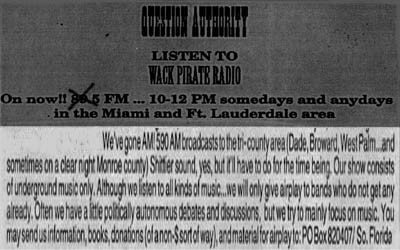
It was permanently shut down less than three months from start-up, after I was visited at work by two agents (thanks to my ceaseless pamphleteering), and I warned everyone else. For years, I had dreamed of continuing my raid on radio, as well as hoping to one day begin a full-time pirate tv station, but it was not to be, and I opted to stick to fanzines, then switched to the internet - and here we are.
-- May 06, 2016 --
Turning Their Backs On Me
With this year's Maryland Deathfest coming up in a few weeks, I dug through my collection of unused and unseen backpatch photos from the last three years, and No Echo posted my pick of pics.
I'm sad I won't
be attending this time around, especially with the killer line up for 2016,
but I'm certain there will be more chances in the future.
Enjoy gawking at 100 battle jackets here.
-- April 26, 2016 --
A Modern Day Nero
Many identify the
excesses of the Roman emperors to point out tyrannical rule, though there have
been plenty of contemporary rulers whose cruelty and megalomania would put anyone
in the past to shame. Hitler, Stalin, Mao, Pol Pot are the most named, but -
while they were absolute despots - there are some who were even more vile, and,
if left in power longer, could have scarred history for the worse.
One such is Francisco Macías Nguema.

Who? Well, here's
a quick history lesson.
Born in Equatorial Guinea in 1924, Francisco became an orphan - along with ten
of his brothers and sisters - at age nine, after his father (a witch doctor)
was beaten to death, and mother committed suicide. Under the Spanish colonial
government, he became mayor of Mongomo, even though he failed the civil service
exams three times. Later, he served as a member of parliament, and was named
Deputy Prime Minister for the transitional government, when Spain left the country
in 1964. In what was the country's first free election (1968), he ran for president
against Prime Minister Bonifacio Ondó Edu, and won.
In May of 1971, President Nguema issued "Decree 415", which abolished
most of the 1968 Constitution, granting him "all direct powers of Government
and Institutions". Five months later he made it a crime, punishable by
death, to threaten him, and a 30-year imprisonment for insulting him. By July
of ' 72, he proclaimed himself President for Life, and held a fake election
the next July that gave him absolute power, making his political party the only
legally permitted.
Around this time, he began to ingest a lot of marijuana, as well as a psychoactive
plant called iboga. This led him into paranoid states, declaring anyone who
wore glasses to be killed, and banned the word "intellectual". With
a third of his country fleeing for their lives, he banned boats, and even fishing.
Soon all Western medicine was made illegal, and the only road out of the country
was heavily rigged with explosives.
On Christmas Day of 1975 he rounded up almost 200 of his opponents in Malabo's
football stadium, having soldiers dressed in Santa costumes execute them, while
Mary Hopkin's "Those
Were the Days" played on loop. Also, after killing the nation's Central
Bank governor, he removed the entire national treasury, and had it brought to
his house. After changing his name to Masie Nguema Biyogo Ñegue Ndong,
in 1976, the remaining population was forced to change any Hispanic names to
something purely African.
By 1979, close to all of the country's educated were either executed or exiled,
and two-thirds of the legislature, plus ten of his original ministers, were
murdered. That year, Nguema had several members of his own family killed, including
his own brother. This made his nephew, Teodoro Obiang Nguema Mbasogo (Vice-Minister
of the Armed Forces), fear for his life, and lead a coup against his uncle.
In August of 1979 he was overthrown, but ran off with loyal forces to fight.
Many quickly abandoned him, and he was captured in a forest on the 18th of August.
Macías Nguema, along with six defendants, was sentenced to death on September
29, 1979, and executed the very same day at Black Beach Prison by a hired firing
squad from the Moroccan Army.
It is believed Nguema is responsible for the deaths of 80,000 to 400,000 of
his own countrymen, which is (according to Penn State professor Randall Fegley)
proportionately worse than what the Nazis did to Europe. Nguema is also the
cause of a severe human capital flight (aka "brain drain") that his
country has yet to recover from.
Sadly, Africa has quite a number of abhorrent rulers (Idi Amin, Robert Mugabe,
Jean-Bédel Bokassa, Robert Taylor, Sani Abacha, Sekou Toure, etc), but
not many know about them because... well, it's Africa, and - face it - many
just don't care about Africa.
-- April 18, 2016 --
Big Oops
In 1948, large trails of huge, three-toed bird tracks appeared all over Clearwater Beach, FL, as well as the banks of the Suwannee River. Within days, a couple claimed they were harassed by a giant creature that came out of the ocean. A little while later, some folks claimed to have spotted a 15 ft (4.5 m) tall penguin, at a distance, along the beach's shore, and Scottish zoologist Ivan T. Sanderson said he had spotted, from a plane, the same bird walking about the Suwannee River.

It wasn't until 1988 that the hoax was revealed in an article by Jan Kirby of St. Petersburg Times. Perpetrated by local pranksters, Tony Signorini and Al Williams, who found inspiration in photographs of fossilized dinosaur tracks. Though Al had passed away in 1969, Tony showed the reporter the iron feet used to make the imprints, but explained that only he and Williams were in on the prank, so the others making claims of sighting the animal were either mistaken, or just wanted to be a part of the growing story.
-- April 08, 2016 --
Babbling Bones
No Echo premiered the first track, "Kokoro", off the upcoming EP, Memento Mori, by my industrial-noise project, 156.
Read a short interview, about how I created music using only human bones, here.
-- April 01, 2016 --
A Fruitful Hoax
On April Fool's Day, 1957, the BBC tv show Panorama, aired a three-minute clip of a Ticino family yielding heaps of pasta from their crops of "spaghetti trees" in southern Switzerland.
While the segment
was meant as a joke, most of the UK was unfamiliar with how pasta was made,
and the station received a deluge of calls asking how they could import the
trees for their own farming.
The idea came from one of the show's cameramen, Charles de Jaeger, when he recalled
one of his teachers in Austria chastising another student as so dumb they would
believe spaghetti grew on trees. Editor Michael Peacock loved the concept, and
set up the cameraman with a budget of £100 to get it done. The cut seemed
credible thanks to a voiceover by Richard Dimbleby, who was a respected broadcaster
at the time.
In an April 2009 piece on pranks, CNN reporter Saeed Ahmed called the broadcast
"the biggest hoax that any reputable news establishment ever pulled".
Happy April Fool's Day folks! Remember to have fun, but don't be cruel.
-- March 28, 2016 --
All That Jazz
The Ovechkin family
were not the typical poor Russians from Irkutsk Oblast in eastern Siberia. Single
mother, Ninel Ovechkin, once vowed "to have as many children as God allowed",
and, with seven kids, one can say she tried well enough.
Though the government tried to ban jazz music at one time, all the kids in her
household formed a Dixieland band. They were the country's first children's
jazz band, becoming a huge success, with the state media even producing a documentary
about them. They did well, but when the band toured overseas of Russia in 1987,
the eldest brother, Dmitry, felt they could probably live better lives outside
the Soviet Union, and hatched a plan.
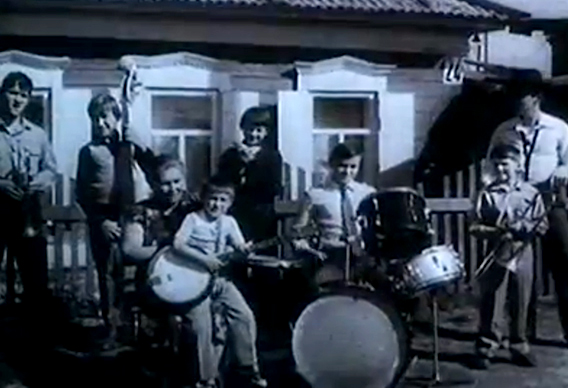
Though their mother usually saw them off at the airport, they scheduled her to come with them on their next concert date. On the orders of Dmitry, the older children packed an upright bass with handguns, sawed-off shotguns, and a homemade explosive, and boarded Aeroflot Flight 3739 on March 8th of 1988. During the flight between Irkutsk and Leningrad, Dmitry handed a note to the crew, announcing the plane was now theirs. It read:
"Proceed to England (London). Do not descend. Otherwise we will blow up the plane. You are under our control."
Once air traffic control in Vologda received word of the hijacking, they alerted a response team, which threw into effect Operacija Nabat (Russian for "Operation Distress Call"). Tricking the family to thinking the plane landed in Kotka, Finland, they actually had it land at a military base in Veshchevo, Russia. When discovering the ruse, Dmitry shot and killed flight attendant Tamara Zharkaya. After threats of killing passengers, the tactical team burst into the plane, and a firefight began between the family and the military group. Alexander Ovechkin detonated the bomb, lighting the plane on fire, and injuring himself before he took his own life with a self-inflicted gunshot. The matriarch asked Dmitry to shoot her, and after turning the shotgun on her, also killed himself, followed by other family members Vasily and Oleg. Three passengers were killed in the melee's crossfire, and while many (20+) were hurt when diving out of the plane, fourteen suffered severe gunshot wounds.

The two oldest band members who made it through the terrorist plot, Igor and Olga, were tried, and sentenced to prison. Igor died in prison, and was murder by a boyfriend not long after release. Mikhail, who was only twelve at the time of the conspiracy-gone-wrong, is the only surviving family member, and now resides in Spain.
-- March 21, 2016 --
Stairway to Heaven
In Jerusalem's Christian Quarter of the Old City, just under a window at the Church of the Holy Sepulcher, leans an old wooden ladder. In Hebrew, it is called "the status quo ladder", while, in English, it is known as "the Immovable Ladder".

It was mistakenly
left there by a worker, who was doing restoration to the facade of the church,
way back in the early 18th Century. The mason was thought to be hired by the
Armenian Apostolic Church, which constructed the ledge where the steps stand.
The first to publicly point the ladder out was an Ottoman Sultan, Abdul Hamid
I, in an edict of 1757, but the the oldest image of it is an engraving by a
monk from the Franciscan Custody of the Holy Land, and dates to 1728. Since
its abandonment, it has only been removed twice: in 1997, during a conflict
between leaders of the Armenian Apostolic Church and the Greek Orthodox Church,
and when moved under another window to fit scaffolding for the repair of the
bell tower in 2009, though, in 1981, there was an effort to move it due to the
assassination attempt on Pope John Paul II, but was stopped by local Israeli
police.
Seeing that the Church is under shared control by several Christian denominations
(including Roman Catholic, Greek Orthodox, Armenian Orthodox, and a number of
others), the wooden rail stands as a symbol of ecumenism. It is to stay where
it stands until all the kooky branches of Christianity are united.
-- March 15, 2016 --
Calling All Posers
I wrote a new artcile on how record labels tried to cash in on punk rock in the 1970s and 80s, and it's posted over at No Echo.
You can also see a list of other music-related pieces I've written for NE here.
-- March 01, 2016 --
Swing Heil
During the Second World War most U.S. soldiers were fans of the swinging sounds of jazz, and the big band sound from the likes of Glenn Miller, Dizzie Gillespie, Count Basie, Duke Ellington and Artie Shaw. The Nazis had a problem with this "schwarzer und juden" music, but they certainly didn't mind trying to warp our G.I.'s minds with it.
Formed in 1940,
Charlie and His Orchestra (also known as Bruno and His Swinging Tigers or Templin's
Band) was actually a German propaganda tool. Around 9pm, every Saturday and
Wednesday, these little ditties were broadcast towards the United States via
shortwave radio, but mostly beamed into Britain, France and other parts of Europe
by the National Socialist Ministry of Propaganda.
Conceived by Joseph Goebbels, and put together by lead gabber Karl Schwedler
(who was "Charlie"), and conducted by Lutz Templin, the band - who
broadcast their tunes from 1941 to 1943 - would take classic swing and modern
jazz of the era, play it as written, but changed the lyrics to suit the Nazi
mission, as well as German views on how they were winning the war. Each song
would proceed with its rewritten lyrics, until a long bridge where Chuck would
then monologue a bit of Hitler's views, or attempts to make the Allies sympathize
with their German enemy.
It has been said
that Winston Churchill thought the broadcasts to be rather funny, and enjoyed
them.
After the fall of Herr Hitler and his Cavorting Cavalcade many of the musicians
who played in Charlie's band actually went on to more popular acts throughout
Europe, with Karl "Charlie" Schwedler supposedly moving to the U.S.
-- February 22, 2016 --
Trans Music Express
I recently wrote a short history of the transgendered in contemporary music, and it's posted over at No Echo.
Check
it out, as you just might learn something. Who knows? Maybe some members
of Whirr will read it, and lighten up.
You can also see a list of other music-related pieces I've written for NE
here.